Qatar Foreign Aid Policy: Evolution, Framework, and Effectiveness
VerifiedAdded on 2023/06/08
|84
|28277
|343
AI Summary
This report provides an in-depth analysis of the evolution, framework, and effectiveness of Qatar's foreign aid policy. It discusses the Qatari foreign policy, diplomatic channels, and the role of the Qatari royal family. It also highlights the different processes and avenues through which the QFAP develops its practice.
Contribute Materials
Your contribution can guide someone’s learning journey. Share your
documents today.
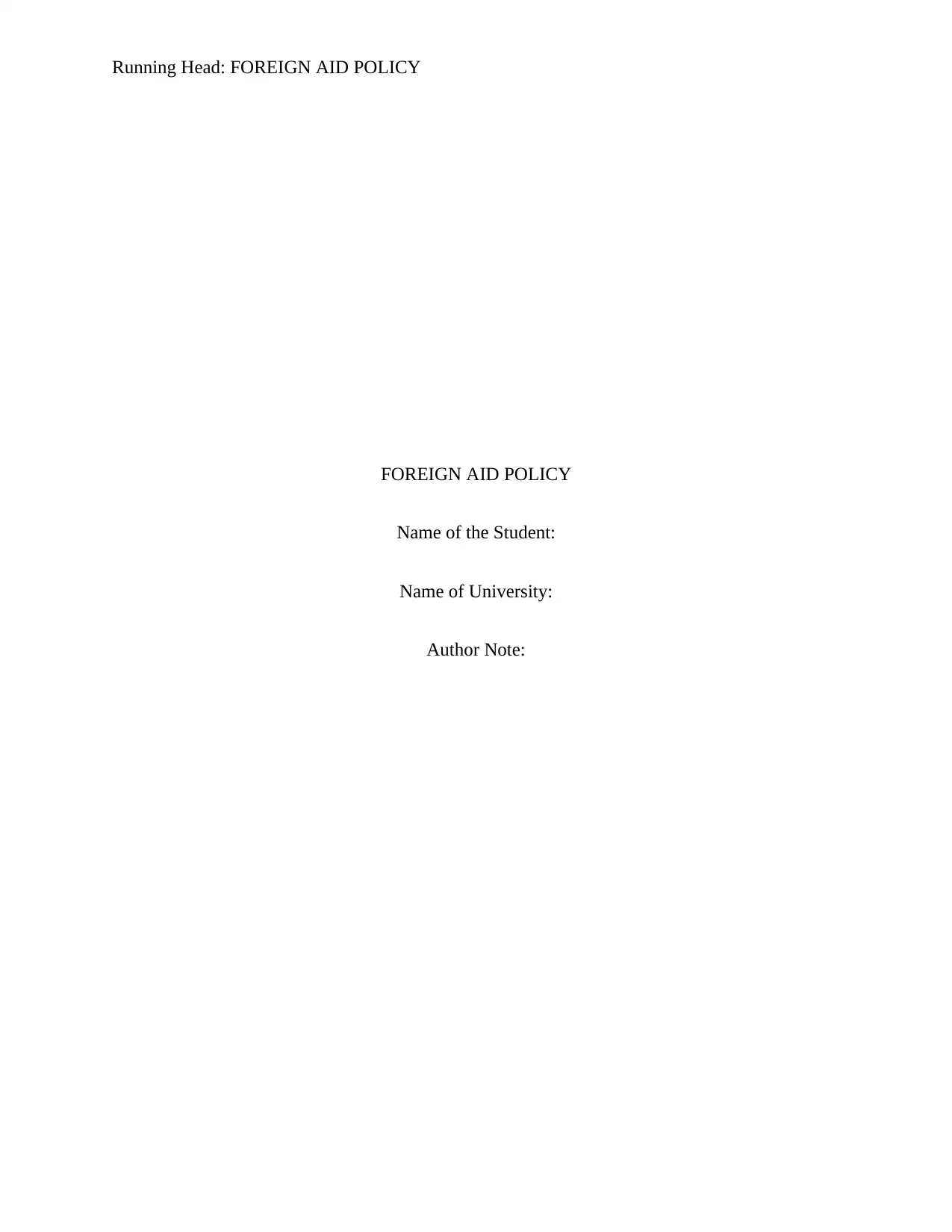
Running Head: FOREIGN AID POLICY
FOREIGN AID POLICY
Name of the Student:
Name of University:
Author Note:
FOREIGN AID POLICY
Name of the Student:
Name of University:
Author Note:
Secure Best Marks with AI Grader
Need help grading? Try our AI Grader for instant feedback on your assignments.
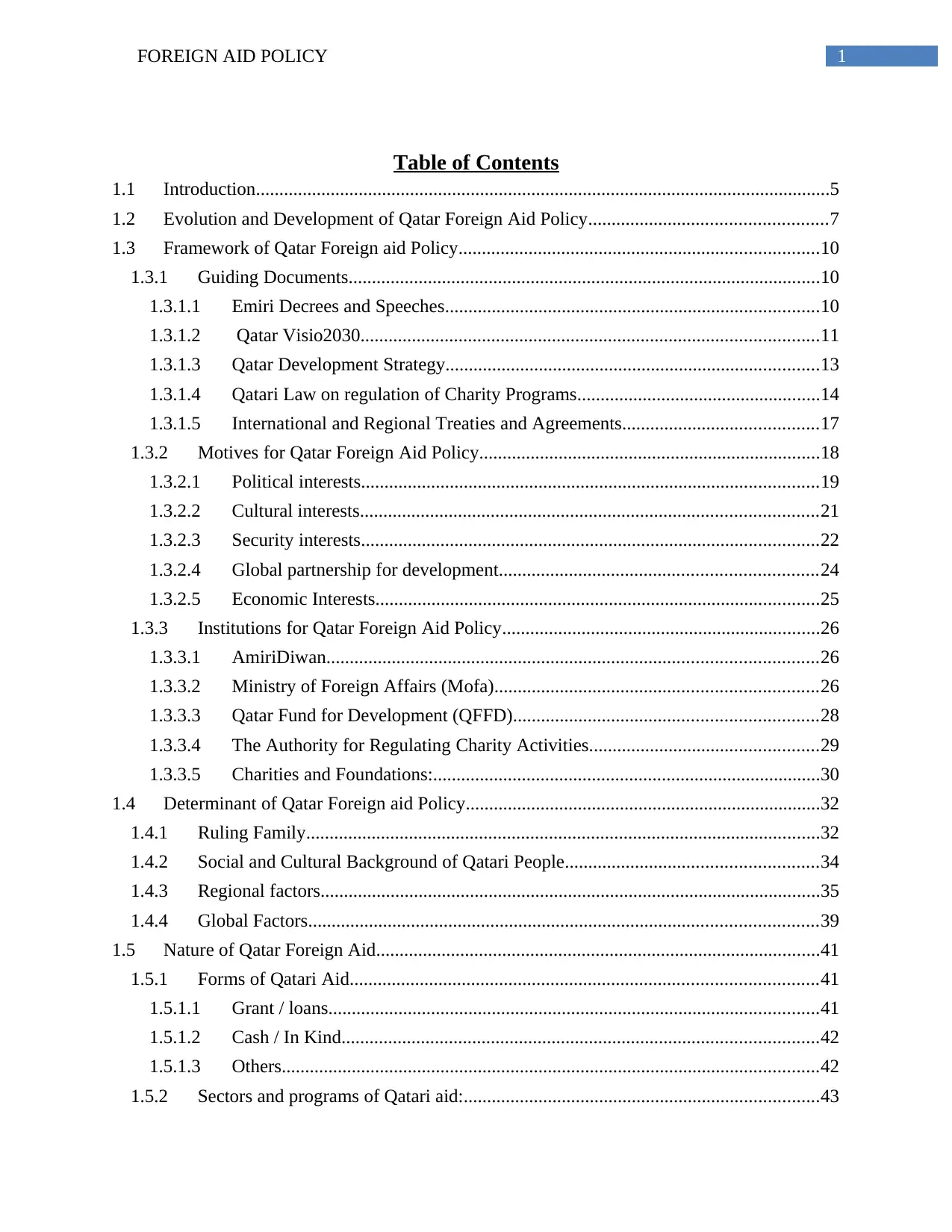
1FOREIGN AID POLICY
Table of Contents
1.1 Introduction...........................................................................................................................5
1.2 Evolution and Development of Qatar Foreign Aid Policy...................................................7
1.3 Framework of Qatar Foreign aid Policy.............................................................................10
1.3.1 Guiding Documents.....................................................................................................10
1.3.1.1 Emiri Decrees and Speeches................................................................................10
1.3.1.2 Qatar Visio2030..................................................................................................11
1.3.1.3 Qatar Development Strategy................................................................................13
1.3.1.4 Qatari Law on regulation of Charity Programs....................................................14
1.3.1.5 International and Regional Treaties and Agreements..........................................17
1.3.2 Motives for Qatar Foreign Aid Policy.........................................................................18
1.3.2.1 Political interests..................................................................................................19
1.3.2.2 Cultural interests..................................................................................................21
1.3.2.3 Security interests..................................................................................................22
1.3.2.4 Global partnership for development....................................................................24
1.3.2.5 Economic Interests...............................................................................................25
1.3.3 Institutions for Qatar Foreign Aid Policy....................................................................26
1.3.3.1 AmiriDiwan.........................................................................................................26
1.3.3.2 Ministry of Foreign Affairs (Mofa).....................................................................26
1.3.3.3 Qatar Fund for Development (QFFD).................................................................28
1.3.3.4 The Authority for Regulating Charity Activities.................................................29
1.3.3.5 Charities and Foundations:...................................................................................30
1.4 Determinant of Qatar Foreign aid Policy............................................................................32
1.4.1 Ruling Family..............................................................................................................32
1.4.2 Social and Cultural Background of Qatari People......................................................34
1.4.3 Regional factors...........................................................................................................35
1.4.4 Global Factors.............................................................................................................39
1.5 Nature of Qatar Foreign Aid...............................................................................................41
1.5.1 Forms of Qatari Aid....................................................................................................41
1.5.1.1 Grant / loans.........................................................................................................41
1.5.1.2 Cash / In Kind......................................................................................................42
1.5.1.3 Others...................................................................................................................42
1.5.2 Sectors and programs of Qatari aid:............................................................................43
Table of Contents
1.1 Introduction...........................................................................................................................5
1.2 Evolution and Development of Qatar Foreign Aid Policy...................................................7
1.3 Framework of Qatar Foreign aid Policy.............................................................................10
1.3.1 Guiding Documents.....................................................................................................10
1.3.1.1 Emiri Decrees and Speeches................................................................................10
1.3.1.2 Qatar Visio2030..................................................................................................11
1.3.1.3 Qatar Development Strategy................................................................................13
1.3.1.4 Qatari Law on regulation of Charity Programs....................................................14
1.3.1.5 International and Regional Treaties and Agreements..........................................17
1.3.2 Motives for Qatar Foreign Aid Policy.........................................................................18
1.3.2.1 Political interests..................................................................................................19
1.3.2.2 Cultural interests..................................................................................................21
1.3.2.3 Security interests..................................................................................................22
1.3.2.4 Global partnership for development....................................................................24
1.3.2.5 Economic Interests...............................................................................................25
1.3.3 Institutions for Qatar Foreign Aid Policy....................................................................26
1.3.3.1 AmiriDiwan.........................................................................................................26
1.3.3.2 Ministry of Foreign Affairs (Mofa).....................................................................26
1.3.3.3 Qatar Fund for Development (QFFD).................................................................28
1.3.3.4 The Authority for Regulating Charity Activities.................................................29
1.3.3.5 Charities and Foundations:...................................................................................30
1.4 Determinant of Qatar Foreign aid Policy............................................................................32
1.4.1 Ruling Family..............................................................................................................32
1.4.2 Social and Cultural Background of Qatari People......................................................34
1.4.3 Regional factors...........................................................................................................35
1.4.4 Global Factors.............................................................................................................39
1.5 Nature of Qatar Foreign Aid...............................................................................................41
1.5.1 Forms of Qatari Aid....................................................................................................41
1.5.1.1 Grant / loans.........................................................................................................41
1.5.1.2 Cash / In Kind......................................................................................................42
1.5.1.3 Others...................................................................................................................42
1.5.2 Sectors and programs of Qatari aid:............................................................................43
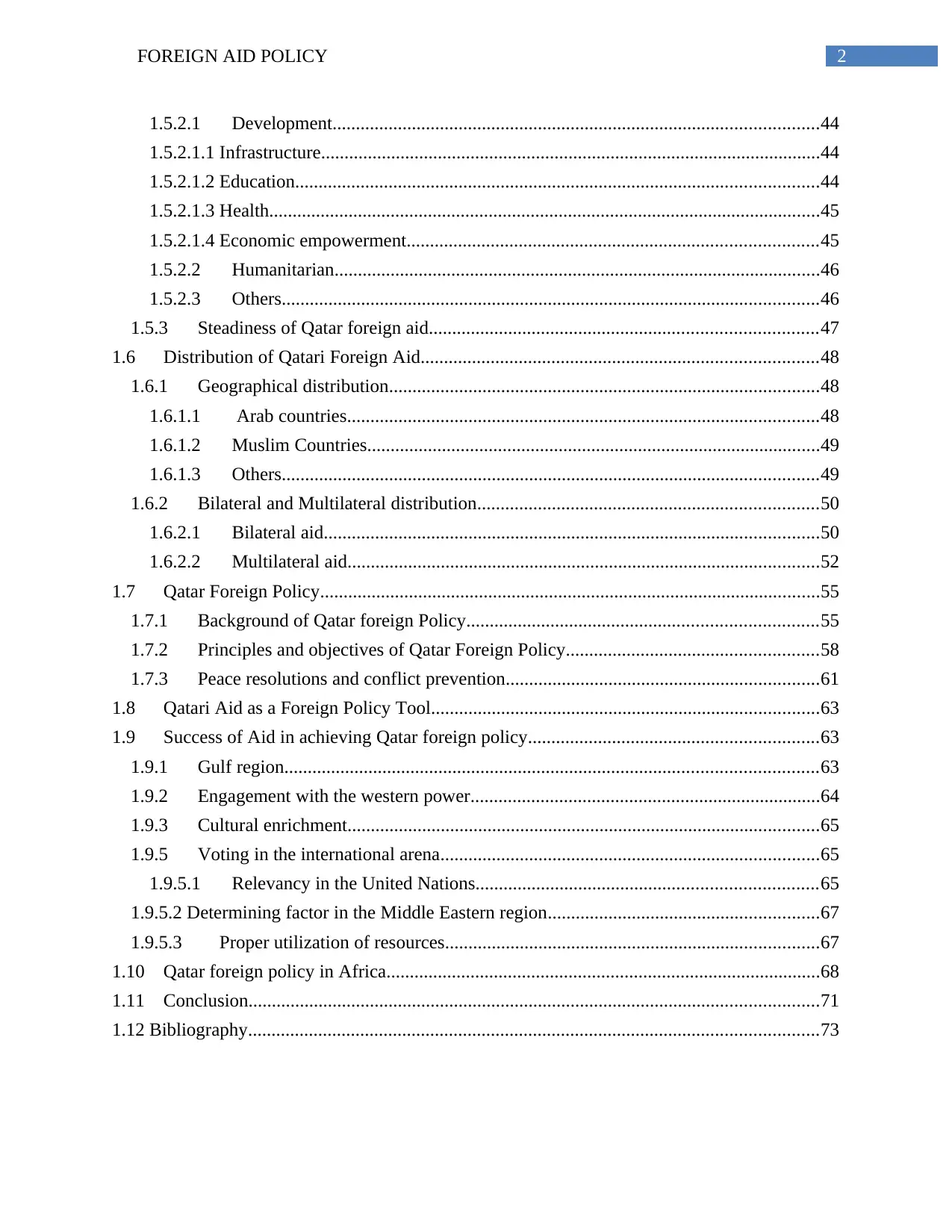
2FOREIGN AID POLICY
1.5.2.1 Development........................................................................................................44
1.5.2.1.1 Infrastructure...........................................................................................................44
1.5.2.1.2 Education................................................................................................................44
1.5.2.1.3 Health......................................................................................................................45
1.5.2.1.4 Economic empowerment........................................................................................45
1.5.2.2 Humanitarian........................................................................................................46
1.5.2.3 Others...................................................................................................................46
1.5.3 Steadiness of Qatar foreign aid...................................................................................47
1.6 Distribution of Qatari Foreign Aid.....................................................................................48
1.6.1 Geographical distribution............................................................................................48
1.6.1.1 Arab countries.....................................................................................................48
1.6.1.2 Muslim Countries.................................................................................................49
1.6.1.3 Others...................................................................................................................49
1.6.2 Bilateral and Multilateral distribution.........................................................................50
1.6.2.1 Bilateral aid..........................................................................................................50
1.6.2.2 Multilateral aid.....................................................................................................52
1.7 Qatar Foreign Policy...........................................................................................................55
1.7.1 Background of Qatar foreign Policy...........................................................................55
1.7.2 Principles and objectives of Qatar Foreign Policy......................................................58
1.7.3 Peace resolutions and conflict prevention...................................................................61
1.8 Qatari Aid as a Foreign Policy Tool...................................................................................63
1.9 Success of Aid in achieving Qatar foreign policy..............................................................63
1.9.1 Gulf region..................................................................................................................63
1.9.2 Engagement with the western power...........................................................................64
1.9.3 Cultural enrichment.....................................................................................................65
1.9.5 Voting in the international arena.................................................................................65
1.9.5.1 Relevancy in the United Nations.........................................................................65
1.9.5.2 Determining factor in the Middle Eastern region..........................................................67
1.9.5.3 Proper utilization of resources................................................................................67
1.10 Qatar foreign policy in Africa.............................................................................................68
1.11 Conclusion..........................................................................................................................71
1.12 Bibliography..........................................................................................................................73
1.5.2.1 Development........................................................................................................44
1.5.2.1.1 Infrastructure...........................................................................................................44
1.5.2.1.2 Education................................................................................................................44
1.5.2.1.3 Health......................................................................................................................45
1.5.2.1.4 Economic empowerment........................................................................................45
1.5.2.2 Humanitarian........................................................................................................46
1.5.2.3 Others...................................................................................................................46
1.5.3 Steadiness of Qatar foreign aid...................................................................................47
1.6 Distribution of Qatari Foreign Aid.....................................................................................48
1.6.1 Geographical distribution............................................................................................48
1.6.1.1 Arab countries.....................................................................................................48
1.6.1.2 Muslim Countries.................................................................................................49
1.6.1.3 Others...................................................................................................................49
1.6.2 Bilateral and Multilateral distribution.........................................................................50
1.6.2.1 Bilateral aid..........................................................................................................50
1.6.2.2 Multilateral aid.....................................................................................................52
1.7 Qatar Foreign Policy...........................................................................................................55
1.7.1 Background of Qatar foreign Policy...........................................................................55
1.7.2 Principles and objectives of Qatar Foreign Policy......................................................58
1.7.3 Peace resolutions and conflict prevention...................................................................61
1.8 Qatari Aid as a Foreign Policy Tool...................................................................................63
1.9 Success of Aid in achieving Qatar foreign policy..............................................................63
1.9.1 Gulf region..................................................................................................................63
1.9.2 Engagement with the western power...........................................................................64
1.9.3 Cultural enrichment.....................................................................................................65
1.9.5 Voting in the international arena.................................................................................65
1.9.5.1 Relevancy in the United Nations.........................................................................65
1.9.5.2 Determining factor in the Middle Eastern region..........................................................67
1.9.5.3 Proper utilization of resources................................................................................67
1.10 Qatar foreign policy in Africa.............................................................................................68
1.11 Conclusion..........................................................................................................................71
1.12 Bibliography..........................................................................................................................73
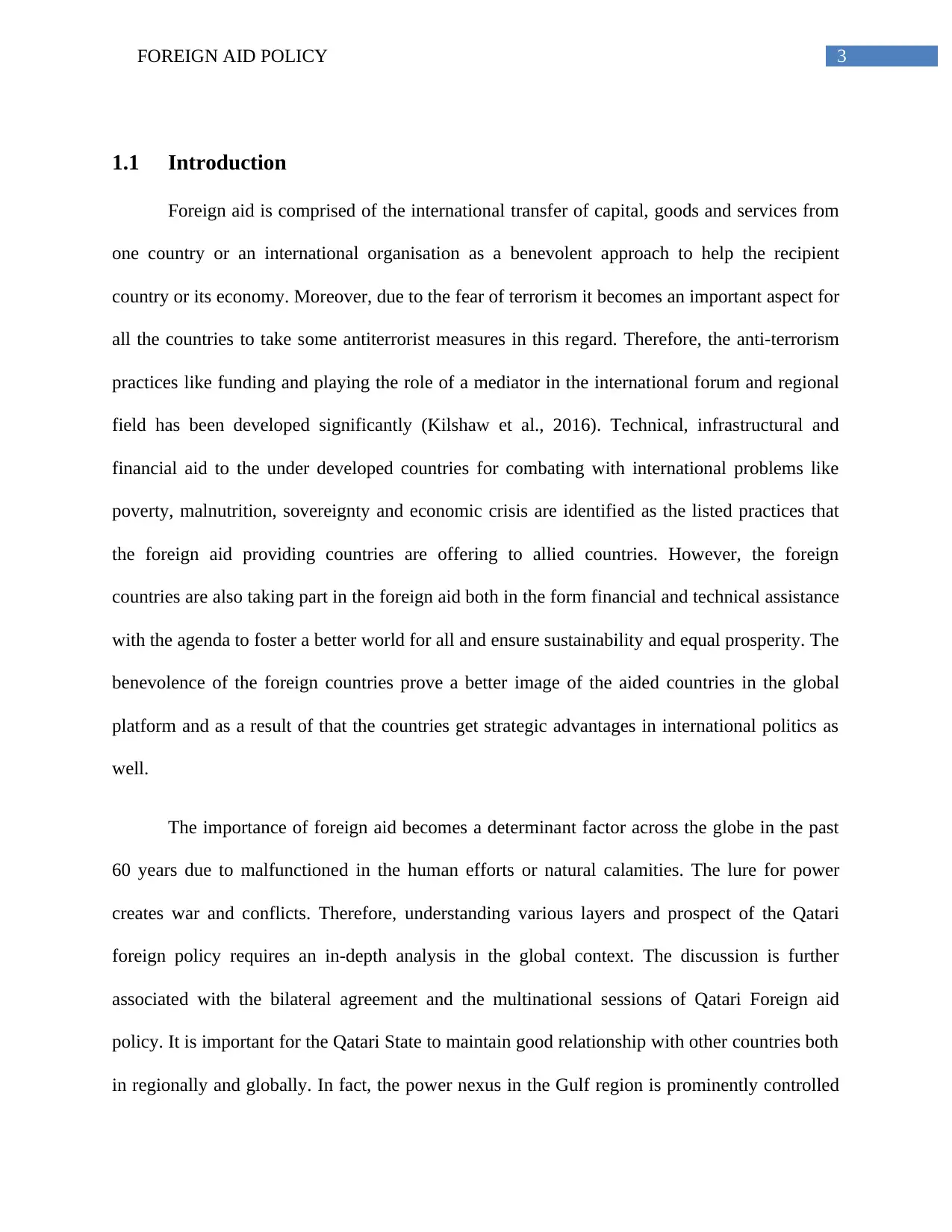
3FOREIGN AID POLICY
1.1 Introduction
Foreign aid is comprised of the international transfer of capital, goods and services from
one country or an international organisation as a benevolent approach to help the recipient
country or its economy. Moreover, due to the fear of terrorism it becomes an important aspect for
all the countries to take some antiterrorist measures in this regard. Therefore, the anti-terrorism
practices like funding and playing the role of a mediator in the international forum and regional
field has been developed significantly (Kilshaw et al., 2016). Technical, infrastructural and
financial aid to the under developed countries for combating with international problems like
poverty, malnutrition, sovereignty and economic crisis are identified as the listed practices that
the foreign aid providing countries are offering to allied countries. However, the foreign
countries are also taking part in the foreign aid both in the form financial and technical assistance
with the agenda to foster a better world for all and ensure sustainability and equal prosperity. The
benevolence of the foreign countries prove a better image of the aided countries in the global
platform and as a result of that the countries get strategic advantages in international politics as
well.
The importance of foreign aid becomes a determinant factor across the globe in the past
60 years due to malfunctioned in the human efforts or natural calamities. The lure for power
creates war and conflicts. Therefore, understanding various layers and prospect of the Qatari
foreign policy requires an in-depth analysis in the global context. The discussion is further
associated with the bilateral agreement and the multinational sessions of Qatari Foreign aid
policy. It is important for the Qatari State to maintain good relationship with other countries both
in regionally and globally. In fact, the power nexus in the Gulf region is prominently controlled
1.1 Introduction
Foreign aid is comprised of the international transfer of capital, goods and services from
one country or an international organisation as a benevolent approach to help the recipient
country or its economy. Moreover, due to the fear of terrorism it becomes an important aspect for
all the countries to take some antiterrorist measures in this regard. Therefore, the anti-terrorism
practices like funding and playing the role of a mediator in the international forum and regional
field has been developed significantly (Kilshaw et al., 2016). Technical, infrastructural and
financial aid to the under developed countries for combating with international problems like
poverty, malnutrition, sovereignty and economic crisis are identified as the listed practices that
the foreign aid providing countries are offering to allied countries. However, the foreign
countries are also taking part in the foreign aid both in the form financial and technical assistance
with the agenda to foster a better world for all and ensure sustainability and equal prosperity. The
benevolence of the foreign countries prove a better image of the aided countries in the global
platform and as a result of that the countries get strategic advantages in international politics as
well.
The importance of foreign aid becomes a determinant factor across the globe in the past
60 years due to malfunctioned in the human efforts or natural calamities. The lure for power
creates war and conflicts. Therefore, understanding various layers and prospect of the Qatari
foreign policy requires an in-depth analysis in the global context. The discussion is further
associated with the bilateral agreement and the multinational sessions of Qatari Foreign aid
policy. It is important for the Qatari State to maintain good relationship with other countries both
in regionally and globally. In fact, the power nexus in the Gulf region is prominently controlled
Secure Best Marks with AI Grader
Need help grading? Try our AI Grader for instant feedback on your assignments.
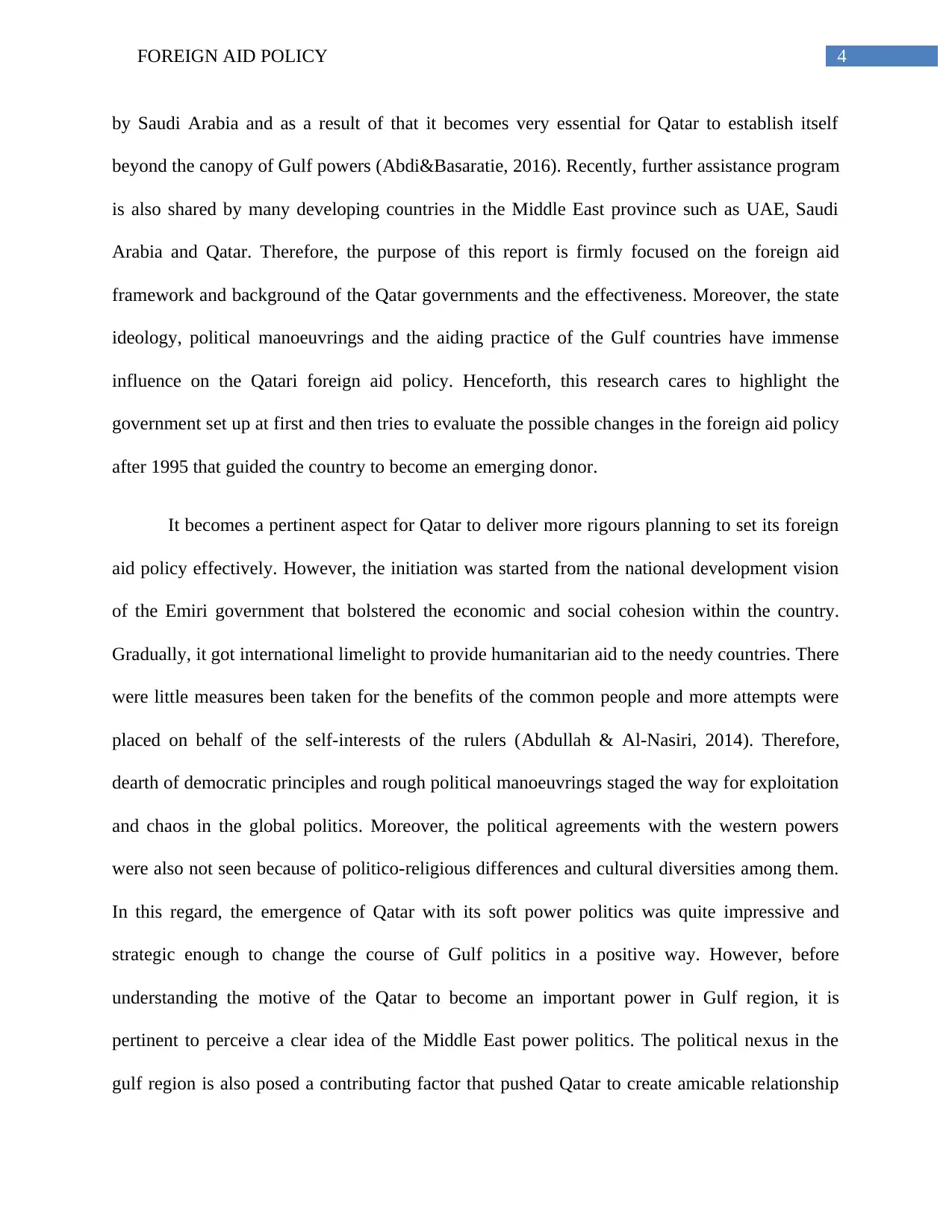
4FOREIGN AID POLICY
by Saudi Arabia and as a result of that it becomes very essential for Qatar to establish itself
beyond the canopy of Gulf powers (Abdi&Basaratie, 2016). Recently, further assistance program
is also shared by many developing countries in the Middle East province such as UAE, Saudi
Arabia and Qatar. Therefore, the purpose of this report is firmly focused on the foreign aid
framework and background of the Qatar governments and the effectiveness. Moreover, the state
ideology, political manoeuvrings and the aiding practice of the Gulf countries have immense
influence on the Qatari foreign aid policy. Henceforth, this research cares to highlight the
government set up at first and then tries to evaluate the possible changes in the foreign aid policy
after 1995 that guided the country to become an emerging donor.
It becomes a pertinent aspect for Qatar to deliver more rigours planning to set its foreign
aid policy effectively. However, the initiation was started from the national development vision
of the Emiri government that bolstered the economic and social cohesion within the country.
Gradually, it got international limelight to provide humanitarian aid to the needy countries. There
were little measures been taken for the benefits of the common people and more attempts were
placed on behalf of the self-interests of the rulers (Abdullah & Al-Nasiri, 2014). Therefore,
dearth of democratic principles and rough political manoeuvrings staged the way for exploitation
and chaos in the global politics. Moreover, the political agreements with the western powers
were also not seen because of politico-religious differences and cultural diversities among them.
In this regard, the emergence of Qatar with its soft power politics was quite impressive and
strategic enough to change the course of Gulf politics in a positive way. However, before
understanding the motive of the Qatar to become an important power in Gulf region, it is
pertinent to perceive a clear idea of the Middle East power politics. The political nexus in the
gulf region is also posed a contributing factor that pushed Qatar to create amicable relationship
by Saudi Arabia and as a result of that it becomes very essential for Qatar to establish itself
beyond the canopy of Gulf powers (Abdi&Basaratie, 2016). Recently, further assistance program
is also shared by many developing countries in the Middle East province such as UAE, Saudi
Arabia and Qatar. Therefore, the purpose of this report is firmly focused on the foreign aid
framework and background of the Qatar governments and the effectiveness. Moreover, the state
ideology, political manoeuvrings and the aiding practice of the Gulf countries have immense
influence on the Qatari foreign aid policy. Henceforth, this research cares to highlight the
government set up at first and then tries to evaluate the possible changes in the foreign aid policy
after 1995 that guided the country to become an emerging donor.
It becomes a pertinent aspect for Qatar to deliver more rigours planning to set its foreign
aid policy effectively. However, the initiation was started from the national development vision
of the Emiri government that bolstered the economic and social cohesion within the country.
Gradually, it got international limelight to provide humanitarian aid to the needy countries. There
were little measures been taken for the benefits of the common people and more attempts were
placed on behalf of the self-interests of the rulers (Abdullah & Al-Nasiri, 2014). Therefore,
dearth of democratic principles and rough political manoeuvrings staged the way for exploitation
and chaos in the global politics. Moreover, the political agreements with the western powers
were also not seen because of politico-religious differences and cultural diversities among them.
In this regard, the emergence of Qatar with its soft power politics was quite impressive and
strategic enough to change the course of Gulf politics in a positive way. However, before
understanding the motive of the Qatar to become an important power in Gulf region, it is
pertinent to perceive a clear idea of the Middle East power politics. The political nexus in the
gulf region is also posed a contributing factor that pushed Qatar to create amicable relationship
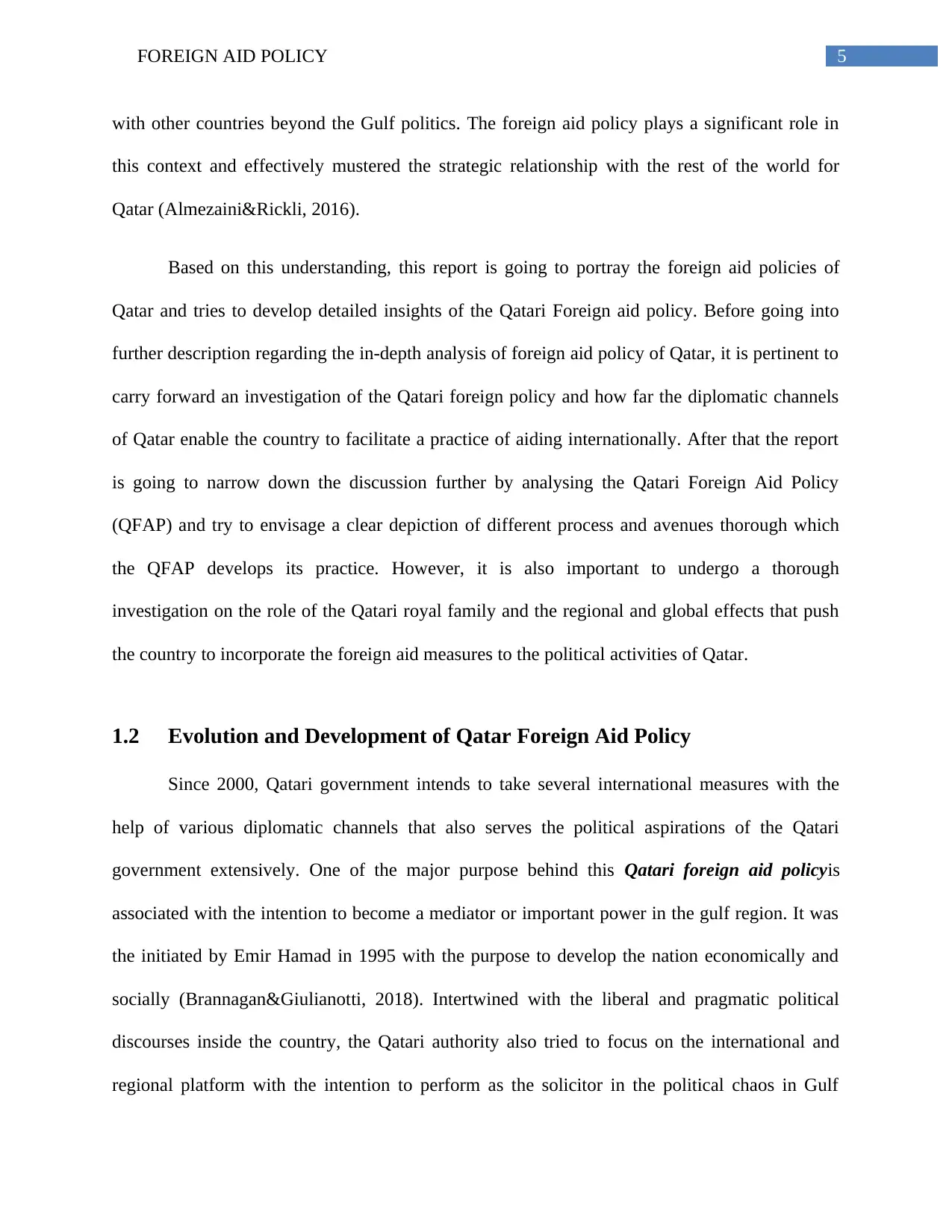
5FOREIGN AID POLICY
with other countries beyond the Gulf politics. The foreign aid policy plays a significant role in
this context and effectively mustered the strategic relationship with the rest of the world for
Qatar (Almezaini&Rickli, 2016).
Based on this understanding, this report is going to portray the foreign aid policies of
Qatar and tries to develop detailed insights of the Qatari Foreign aid policy. Before going into
further description regarding the in-depth analysis of foreign aid policy of Qatar, it is pertinent to
carry forward an investigation of the Qatari foreign policy and how far the diplomatic channels
of Qatar enable the country to facilitate a practice of aiding internationally. After that the report
is going to narrow down the discussion further by analysing the Qatari Foreign Aid Policy
(QFAP) and try to envisage a clear depiction of different process and avenues thorough which
the QFAP develops its practice. However, it is also important to undergo a thorough
investigation on the role of the Qatari royal family and the regional and global effects that push
the country to incorporate the foreign aid measures to the political activities of Qatar.
1.2 Evolution and Development of Qatar Foreign Aid Policy
Since 2000, Qatari government intends to take several international measures with the
help of various diplomatic channels that also serves the political aspirations of the Qatari
government extensively. One of the major purpose behind this Qatari foreign aid policyis
associated with the intention to become a mediator or important power in the gulf region. It was
the initiated by Emir Hamad in 1995 with the purpose to develop the nation economically and
socially (Brannagan&Giulianotti, 2018). Intertwined with the liberal and pragmatic political
discourses inside the country, the Qatari authority also tried to focus on the international and
regional platform with the intention to perform as the solicitor in the political chaos in Gulf
with other countries beyond the Gulf politics. The foreign aid policy plays a significant role in
this context and effectively mustered the strategic relationship with the rest of the world for
Qatar (Almezaini&Rickli, 2016).
Based on this understanding, this report is going to portray the foreign aid policies of
Qatar and tries to develop detailed insights of the Qatari Foreign aid policy. Before going into
further description regarding the in-depth analysis of foreign aid policy of Qatar, it is pertinent to
carry forward an investigation of the Qatari foreign policy and how far the diplomatic channels
of Qatar enable the country to facilitate a practice of aiding internationally. After that the report
is going to narrow down the discussion further by analysing the Qatari Foreign Aid Policy
(QFAP) and try to envisage a clear depiction of different process and avenues thorough which
the QFAP develops its practice. However, it is also important to undergo a thorough
investigation on the role of the Qatari royal family and the regional and global effects that push
the country to incorporate the foreign aid measures to the political activities of Qatar.
1.2 Evolution and Development of Qatar Foreign Aid Policy
Since 2000, Qatari government intends to take several international measures with the
help of various diplomatic channels that also serves the political aspirations of the Qatari
government extensively. One of the major purpose behind this Qatari foreign aid policyis
associated with the intention to become a mediator or important power in the gulf region. It was
the initiated by Emir Hamad in 1995 with the purpose to develop the nation economically and
socially (Brannagan&Giulianotti, 2018). Intertwined with the liberal and pragmatic political
discourses inside the country, the Qatari authority also tried to focus on the international and
regional platform with the intention to perform as the solicitor in the political chaos in Gulf
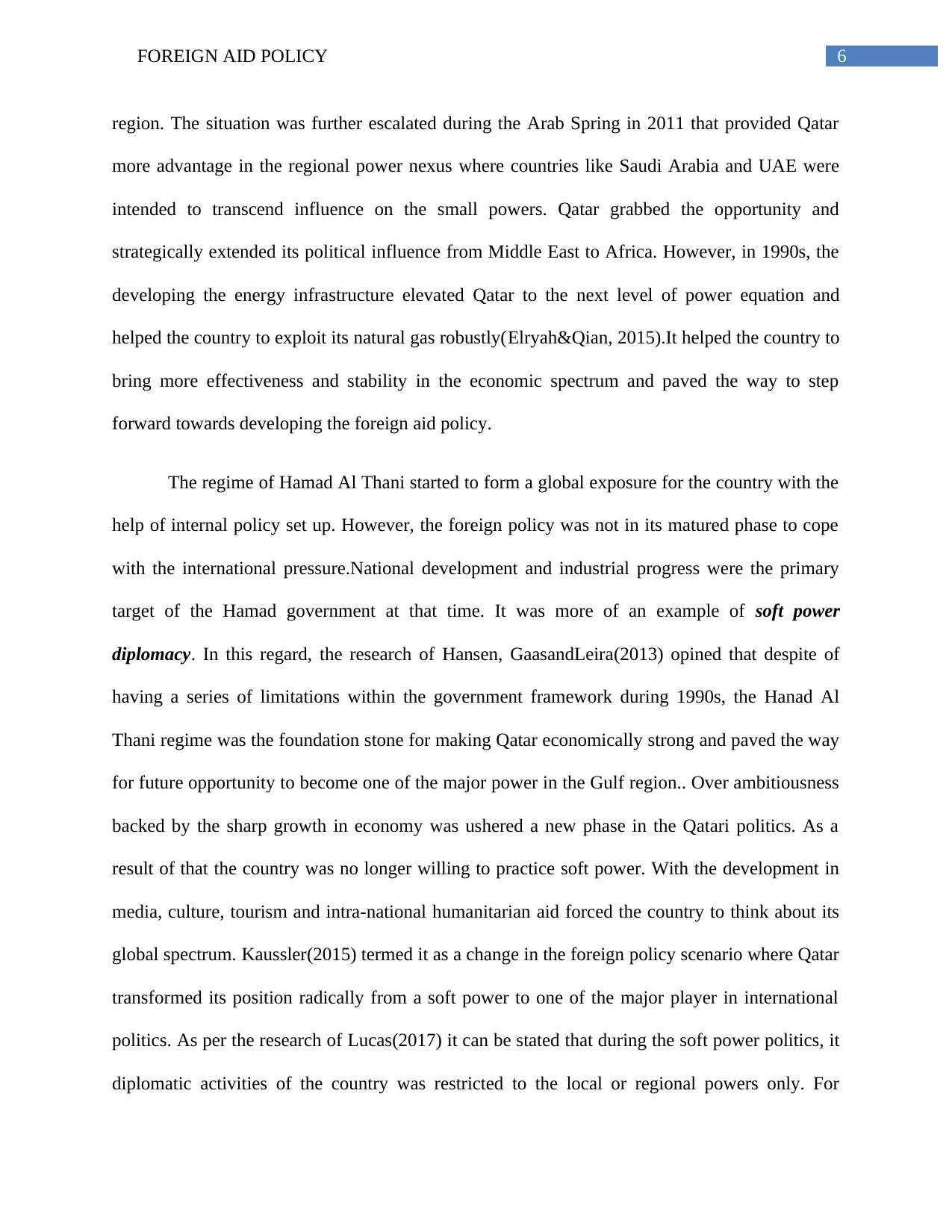
6FOREIGN AID POLICY
region. The situation was further escalated during the Arab Spring in 2011 that provided Qatar
more advantage in the regional power nexus where countries like Saudi Arabia and UAE were
intended to transcend influence on the small powers. Qatar grabbed the opportunity and
strategically extended its political influence from Middle East to Africa. However, in 1990s, the
developing the energy infrastructure elevated Qatar to the next level of power equation and
helped the country to exploit its natural gas robustly(Elryah&Qian, 2015).It helped the country to
bring more effectiveness and stability in the economic spectrum and paved the way to step
forward towards developing the foreign aid policy.
The regime of Hamad Al Thani started to form a global exposure for the country with the
help of internal policy set up. However, the foreign policy was not in its matured phase to cope
with the international pressure.National development and industrial progress were the primary
target of the Hamad government at that time. It was more of an example of soft power
diplomacy. In this regard, the research of Hansen, GaasandLeira(2013) opined that despite of
having a series of limitations within the government framework during 1990s, the Hanad Al
Thani regime was the foundation stone for making Qatar economically strong and paved the way
for future opportunity to become one of the major power in the Gulf region.. Over ambitiousness
backed by the sharp growth in economy was ushered a new phase in the Qatari politics. As a
result of that the country was no longer willing to practice soft power. With the development in
media, culture, tourism and intra-national humanitarian aid forced the country to think about its
global spectrum. Kaussler(2015) termed it as a change in the foreign policy scenario where Qatar
transformed its position radically from a soft power to one of the major player in international
politics. As per the research of Lucas(2017) it can be stated that during the soft power politics, it
diplomatic activities of the country was restricted to the local or regional powers only. For
region. The situation was further escalated during the Arab Spring in 2011 that provided Qatar
more advantage in the regional power nexus where countries like Saudi Arabia and UAE were
intended to transcend influence on the small powers. Qatar grabbed the opportunity and
strategically extended its political influence from Middle East to Africa. However, in 1990s, the
developing the energy infrastructure elevated Qatar to the next level of power equation and
helped the country to exploit its natural gas robustly(Elryah&Qian, 2015).It helped the country to
bring more effectiveness and stability in the economic spectrum and paved the way to step
forward towards developing the foreign aid policy.
The regime of Hamad Al Thani started to form a global exposure for the country with the
help of internal policy set up. However, the foreign policy was not in its matured phase to cope
with the international pressure.National development and industrial progress were the primary
target of the Hamad government at that time. It was more of an example of soft power
diplomacy. In this regard, the research of Hansen, GaasandLeira(2013) opined that despite of
having a series of limitations within the government framework during 1990s, the Hanad Al
Thani regime was the foundation stone for making Qatar economically strong and paved the way
for future opportunity to become one of the major power in the Gulf region.. Over ambitiousness
backed by the sharp growth in economy was ushered a new phase in the Qatari politics. As a
result of that the country was no longer willing to practice soft power. With the development in
media, culture, tourism and intra-national humanitarian aid forced the country to think about its
global spectrum. Kaussler(2015) termed it as a change in the foreign policy scenario where Qatar
transformed its position radically from a soft power to one of the major player in international
politics. As per the research of Lucas(2017) it can be stated that during the soft power politics, it
diplomatic activities of the country was restricted to the local or regional powers only. For
Paraphrase This Document
Need a fresh take? Get an instant paraphrase of this document with our AI Paraphraser
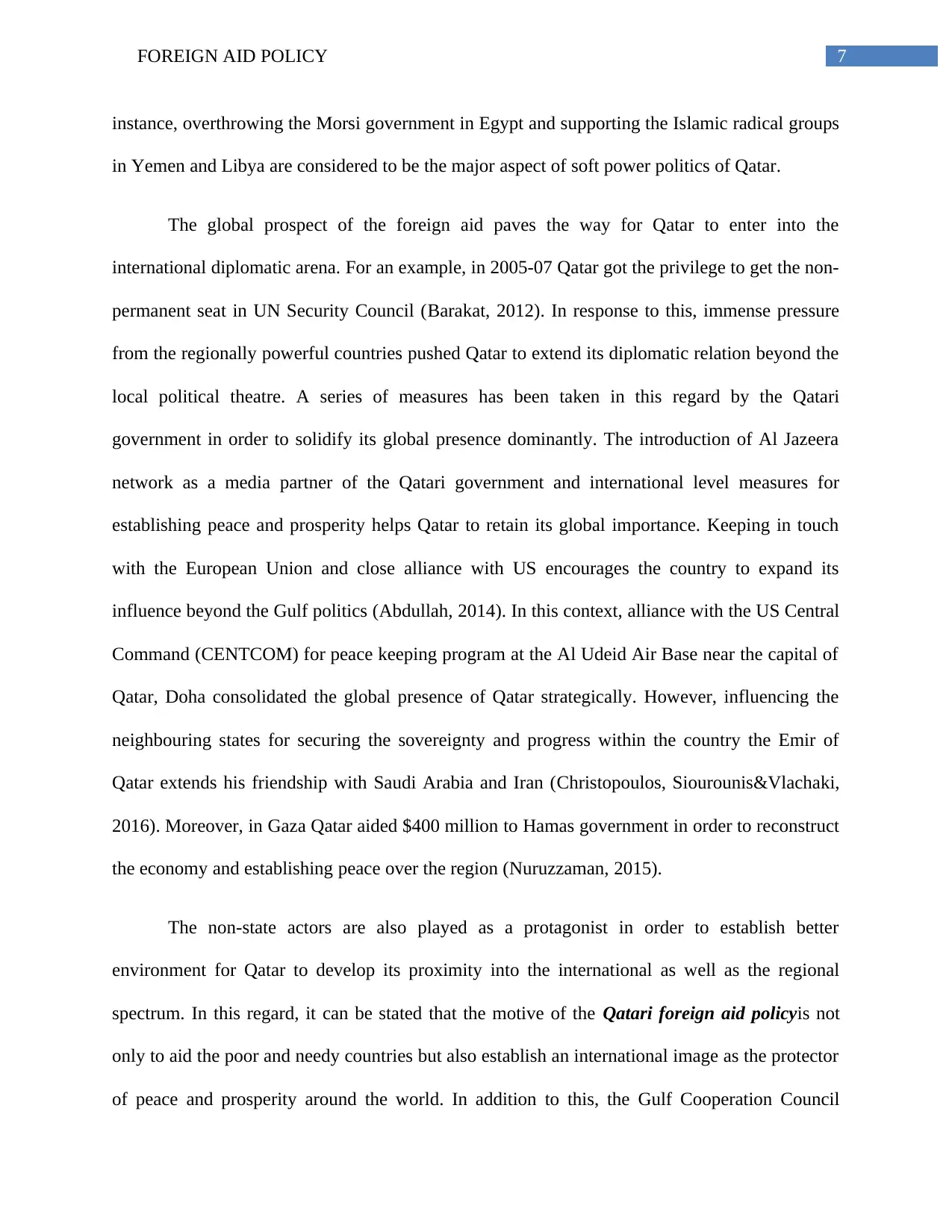
7FOREIGN AID POLICY
instance, overthrowing the Morsi government in Egypt and supporting the Islamic radical groups
in Yemen and Libya are considered to be the major aspect of soft power politics of Qatar.
The global prospect of the foreign aid paves the way for Qatar to enter into the
international diplomatic arena. For an example, in 2005-07 Qatar got the privilege to get the non-
permanent seat in UN Security Council (Barakat, 2012). In response to this, immense pressure
from the regionally powerful countries pushed Qatar to extend its diplomatic relation beyond the
local political theatre. A series of measures has been taken in this regard by the Qatari
government in order to solidify its global presence dominantly. The introduction of Al Jazeera
network as a media partner of the Qatari government and international level measures for
establishing peace and prosperity helps Qatar to retain its global importance. Keeping in touch
with the European Union and close alliance with US encourages the country to expand its
influence beyond the Gulf politics (Abdullah, 2014). In this context, alliance with the US Central
Command (CENTCOM) for peace keeping program at the Al Udeid Air Base near the capital of
Qatar, Doha consolidated the global presence of Qatar strategically. However, influencing the
neighbouring states for securing the sovereignty and progress within the country the Emir of
Qatar extends his friendship with Saudi Arabia and Iran (Christopoulos, Siourounis&Vlachaki,
2016). Moreover, in Gaza Qatar aided $400 million to Hamas government in order to reconstruct
the economy and establishing peace over the region (Nuruzzaman, 2015).
The non-state actors are also played as a protagonist in order to establish better
environment for Qatar to develop its proximity into the international as well as the regional
spectrum. In this regard, it can be stated that the motive of the Qatari foreign aid policyis not
only to aid the poor and needy countries but also establish an international image as the protector
of peace and prosperity around the world. In addition to this, the Gulf Cooperation Council
instance, overthrowing the Morsi government in Egypt and supporting the Islamic radical groups
in Yemen and Libya are considered to be the major aspect of soft power politics of Qatar.
The global prospect of the foreign aid paves the way for Qatar to enter into the
international diplomatic arena. For an example, in 2005-07 Qatar got the privilege to get the non-
permanent seat in UN Security Council (Barakat, 2012). In response to this, immense pressure
from the regionally powerful countries pushed Qatar to extend its diplomatic relation beyond the
local political theatre. A series of measures has been taken in this regard by the Qatari
government in order to solidify its global presence dominantly. The introduction of Al Jazeera
network as a media partner of the Qatari government and international level measures for
establishing peace and prosperity helps Qatar to retain its global importance. Keeping in touch
with the European Union and close alliance with US encourages the country to expand its
influence beyond the Gulf politics (Abdullah, 2014). In this context, alliance with the US Central
Command (CENTCOM) for peace keeping program at the Al Udeid Air Base near the capital of
Qatar, Doha consolidated the global presence of Qatar strategically. However, influencing the
neighbouring states for securing the sovereignty and progress within the country the Emir of
Qatar extends his friendship with Saudi Arabia and Iran (Christopoulos, Siourounis&Vlachaki,
2016). Moreover, in Gaza Qatar aided $400 million to Hamas government in order to reconstruct
the economy and establishing peace over the region (Nuruzzaman, 2015).
The non-state actors are also played as a protagonist in order to establish better
environment for Qatar to develop its proximity into the international as well as the regional
spectrum. In this regard, it can be stated that the motive of the Qatari foreign aid policyis not
only to aid the poor and needy countries but also establish an international image as the protector
of peace and prosperity around the world. In addition to this, the Gulf Cooperation Council
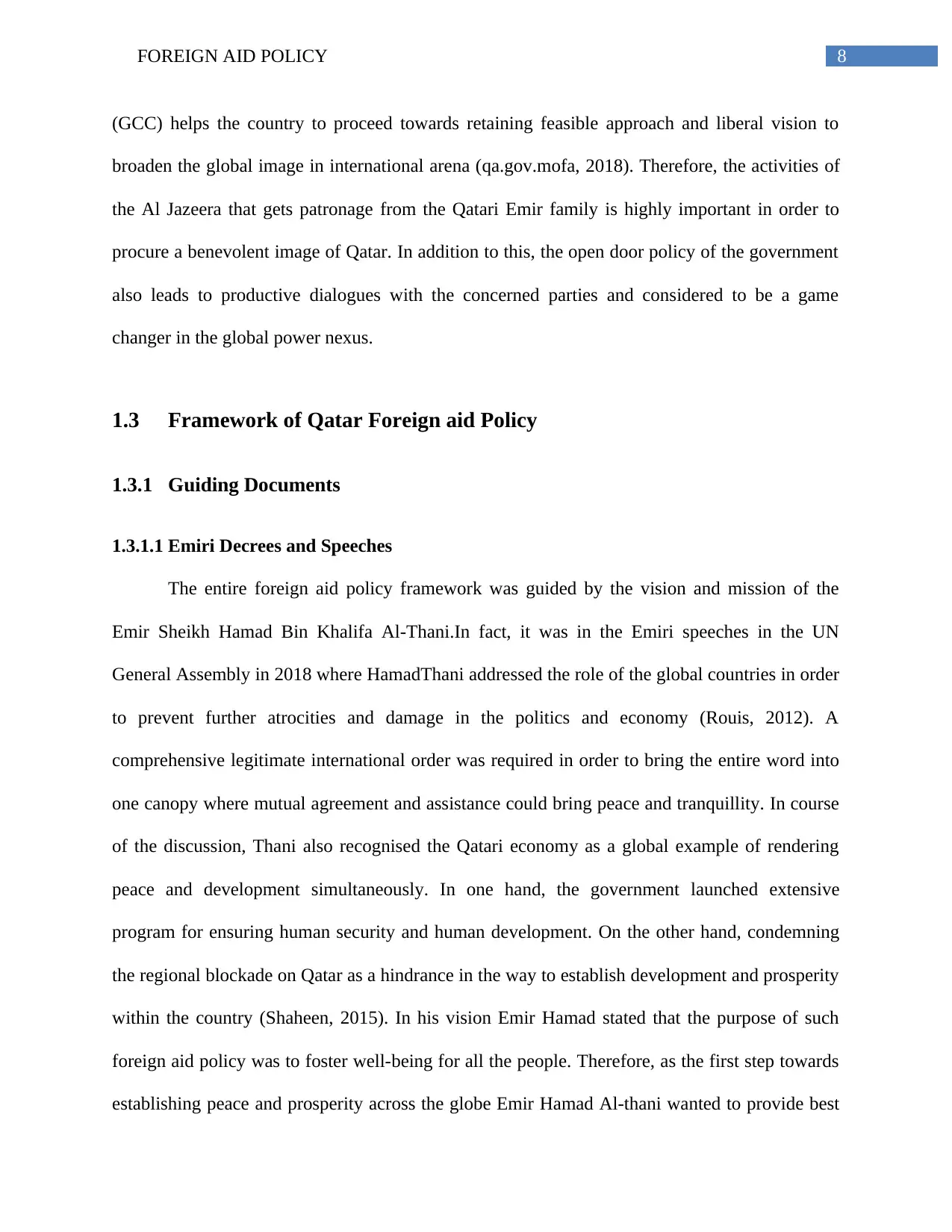
8FOREIGN AID POLICY
(GCC) helps the country to proceed towards retaining feasible approach and liberal vision to
broaden the global image in international arena (qa.gov.mofa, 2018). Therefore, the activities of
the Al Jazeera that gets patronage from the Qatari Emir family is highly important in order to
procure a benevolent image of Qatar. In addition to this, the open door policy of the government
also leads to productive dialogues with the concerned parties and considered to be a game
changer in the global power nexus.
1.3 Framework of Qatar Foreign aid Policy
1.3.1 Guiding Documents
1.3.1.1 Emiri Decrees and Speeches
The entire foreign aid policy framework was guided by the vision and mission of the
Emir Sheikh Hamad Bin Khalifa Al-Thani.In fact, it was in the Emiri speeches in the UN
General Assembly in 2018 where HamadThani addressed the role of the global countries in order
to prevent further atrocities and damage in the politics and economy (Rouis, 2012). A
comprehensive legitimate international order was required in order to bring the entire word into
one canopy where mutual agreement and assistance could bring peace and tranquillity. In course
of the discussion, Thani also recognised the Qatari economy as a global example of rendering
peace and development simultaneously. In one hand, the government launched extensive
program for ensuring human security and human development. On the other hand, condemning
the regional blockade on Qatar as a hindrance in the way to establish development and prosperity
within the country (Shaheen, 2015). In his vision Emir Hamad stated that the purpose of such
foreign aid policy was to foster well-being for all the people. Therefore, as the first step towards
establishing peace and prosperity across the globe Emir Hamad Al-thani wanted to provide best
(GCC) helps the country to proceed towards retaining feasible approach and liberal vision to
broaden the global image in international arena (qa.gov.mofa, 2018). Therefore, the activities of
the Al Jazeera that gets patronage from the Qatari Emir family is highly important in order to
procure a benevolent image of Qatar. In addition to this, the open door policy of the government
also leads to productive dialogues with the concerned parties and considered to be a game
changer in the global power nexus.
1.3 Framework of Qatar Foreign aid Policy
1.3.1 Guiding Documents
1.3.1.1 Emiri Decrees and Speeches
The entire foreign aid policy framework was guided by the vision and mission of the
Emir Sheikh Hamad Bin Khalifa Al-Thani.In fact, it was in the Emiri speeches in the UN
General Assembly in 2018 where HamadThani addressed the role of the global countries in order
to prevent further atrocities and damage in the politics and economy (Rouis, 2012). A
comprehensive legitimate international order was required in order to bring the entire word into
one canopy where mutual agreement and assistance could bring peace and tranquillity. In course
of the discussion, Thani also recognised the Qatari economy as a global example of rendering
peace and development simultaneously. In one hand, the government launched extensive
program for ensuring human security and human development. On the other hand, condemning
the regional blockade on Qatar as a hindrance in the way to establish development and prosperity
within the country (Shaheen, 2015). In his vision Emir Hamad stated that the purpose of such
foreign aid policy was to foster well-being for all the people. Therefore, as the first step towards
establishing peace and prosperity across the globe Emir Hamad Al-thani wanted to provide best
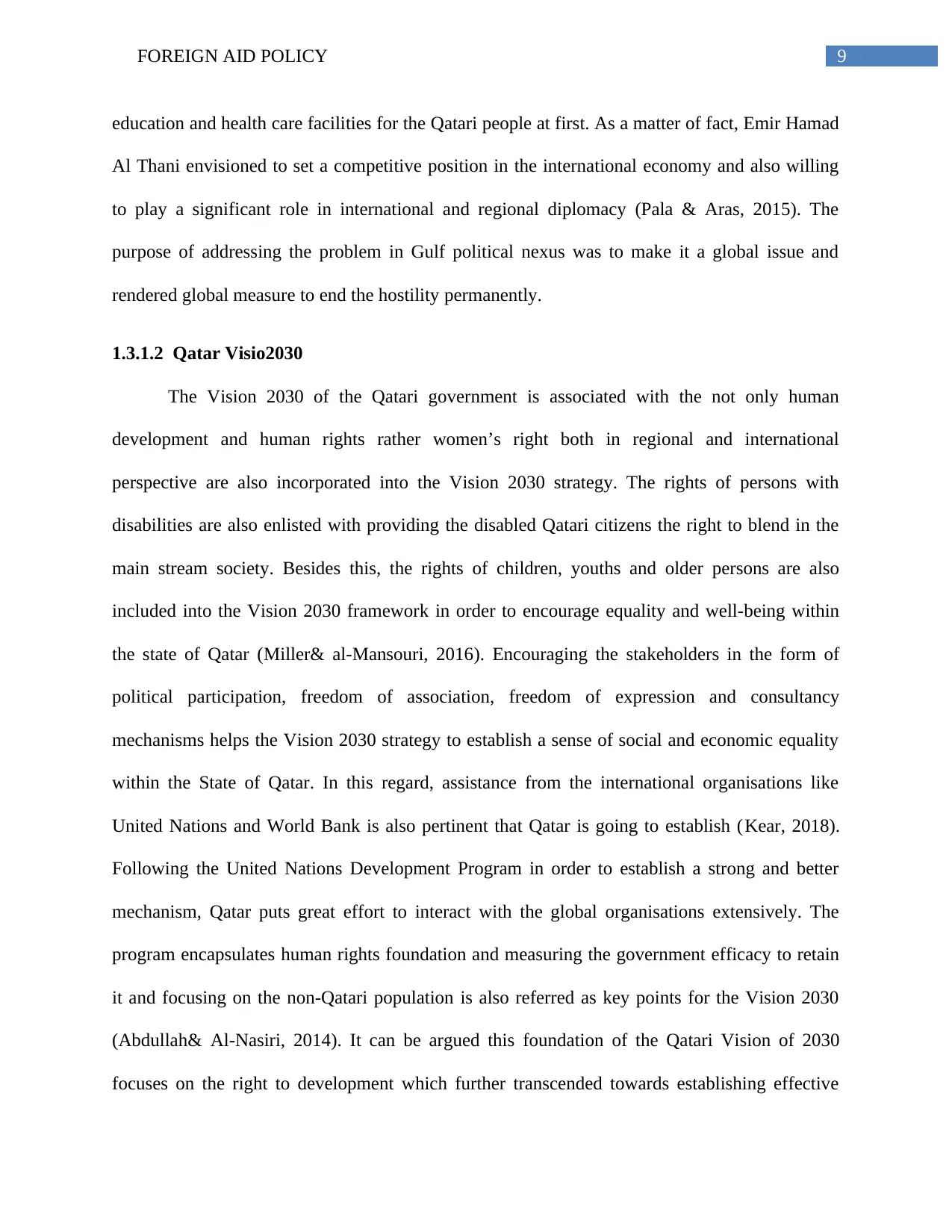
9FOREIGN AID POLICY
education and health care facilities for the Qatari people at first. As a matter of fact, Emir Hamad
Al Thani envisioned to set a competitive position in the international economy and also willing
to play a significant role in international and regional diplomacy (Pala & Aras, 2015). The
purpose of addressing the problem in Gulf political nexus was to make it a global issue and
rendered global measure to end the hostility permanently.
1.3.1.2 Qatar Visio2030
The Vision 2030 of the Qatari government is associated with the not only human
development and human rights rather women’s right both in regional and international
perspective are also incorporated into the Vision 2030 strategy. The rights of persons with
disabilities are also enlisted with providing the disabled Qatari citizens the right to blend in the
main stream society. Besides this, the rights of children, youths and older persons are also
included into the Vision 2030 framework in order to encourage equality and well-being within
the state of Qatar (Miller& al-Mansouri, 2016). Encouraging the stakeholders in the form of
political participation, freedom of association, freedom of expression and consultancy
mechanisms helps the Vision 2030 strategy to establish a sense of social and economic equality
within the State of Qatar. In this regard, assistance from the international organisations like
United Nations and World Bank is also pertinent that Qatar is going to establish (Kear, 2018).
Following the United Nations Development Program in order to establish a strong and better
mechanism, Qatar puts great effort to interact with the global organisations extensively. The
program encapsulates human rights foundation and measuring the government efficacy to retain
it and focusing on the non-Qatari population is also referred as key points for the Vision 2030
(Abdullah& Al-Nasiri, 2014). It can be argued this foundation of the Qatari Vision of 2030
focuses on the right to development which further transcended towards establishing effective
education and health care facilities for the Qatari people at first. As a matter of fact, Emir Hamad
Al Thani envisioned to set a competitive position in the international economy and also willing
to play a significant role in international and regional diplomacy (Pala & Aras, 2015). The
purpose of addressing the problem in Gulf political nexus was to make it a global issue and
rendered global measure to end the hostility permanently.
1.3.1.2 Qatar Visio2030
The Vision 2030 of the Qatari government is associated with the not only human
development and human rights rather women’s right both in regional and international
perspective are also incorporated into the Vision 2030 strategy. The rights of persons with
disabilities are also enlisted with providing the disabled Qatari citizens the right to blend in the
main stream society. Besides this, the rights of children, youths and older persons are also
included into the Vision 2030 framework in order to encourage equality and well-being within
the state of Qatar (Miller& al-Mansouri, 2016). Encouraging the stakeholders in the form of
political participation, freedom of association, freedom of expression and consultancy
mechanisms helps the Vision 2030 strategy to establish a sense of social and economic equality
within the State of Qatar. In this regard, assistance from the international organisations like
United Nations and World Bank is also pertinent that Qatar is going to establish (Kear, 2018).
Following the United Nations Development Program in order to establish a strong and better
mechanism, Qatar puts great effort to interact with the global organisations extensively. The
program encapsulates human rights foundation and measuring the government efficacy to retain
it and focusing on the non-Qatari population is also referred as key points for the Vision 2030
(Abdullah& Al-Nasiri, 2014). It can be argued this foundation of the Qatari Vision of 2030
focuses on the right to development which further transcended towards establishing effective
Secure Best Marks with AI Grader
Need help grading? Try our AI Grader for instant feedback on your assignments.
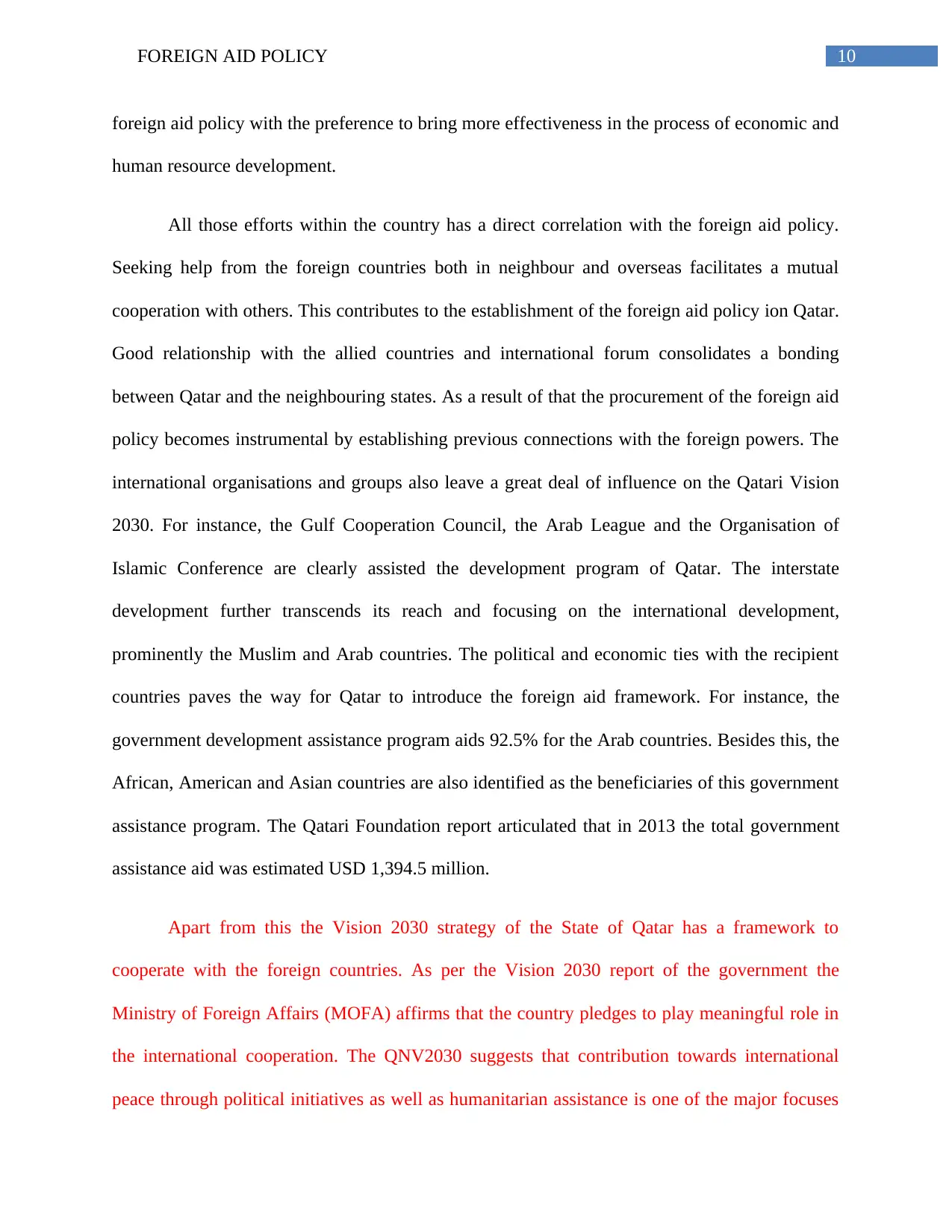
10FOREIGN AID POLICY
foreign aid policy with the preference to bring more effectiveness in the process of economic and
human resource development.
All those efforts within the country has a direct correlation with the foreign aid policy.
Seeking help from the foreign countries both in neighbour and overseas facilitates a mutual
cooperation with others. This contributes to the establishment of the foreign aid policy ion Qatar.
Good relationship with the allied countries and international forum consolidates a bonding
between Qatar and the neighbouring states. As a result of that the procurement of the foreign aid
policy becomes instrumental by establishing previous connections with the foreign powers. The
international organisations and groups also leave a great deal of influence on the Qatari Vision
2030. For instance, the Gulf Cooperation Council, the Arab League and the Organisation of
Islamic Conference are clearly assisted the development program of Qatar. The interstate
development further transcends its reach and focusing on the international development,
prominently the Muslim and Arab countries. The political and economic ties with the recipient
countries paves the way for Qatar to introduce the foreign aid framework. For instance, the
government development assistance program aids 92.5% for the Arab countries. Besides this, the
African, American and Asian countries are also identified as the beneficiaries of this government
assistance program. The Qatari Foundation report articulated that in 2013 the total government
assistance aid was estimated USD 1,394.5 million.
Apart from this the Vision 2030 strategy of the State of Qatar has a framework to
cooperate with the foreign countries. As per the Vision 2030 report of the government the
Ministry of Foreign Affairs (MOFA) affirms that the country pledges to play meaningful role in
the international cooperation. The QNV2030 suggests that contribution towards international
peace through political initiatives as well as humanitarian assistance is one of the major focuses
foreign aid policy with the preference to bring more effectiveness in the process of economic and
human resource development.
All those efforts within the country has a direct correlation with the foreign aid policy.
Seeking help from the foreign countries both in neighbour and overseas facilitates a mutual
cooperation with others. This contributes to the establishment of the foreign aid policy ion Qatar.
Good relationship with the allied countries and international forum consolidates a bonding
between Qatar and the neighbouring states. As a result of that the procurement of the foreign aid
policy becomes instrumental by establishing previous connections with the foreign powers. The
international organisations and groups also leave a great deal of influence on the Qatari Vision
2030. For instance, the Gulf Cooperation Council, the Arab League and the Organisation of
Islamic Conference are clearly assisted the development program of Qatar. The interstate
development further transcends its reach and focusing on the international development,
prominently the Muslim and Arab countries. The political and economic ties with the recipient
countries paves the way for Qatar to introduce the foreign aid framework. For instance, the
government development assistance program aids 92.5% for the Arab countries. Besides this, the
African, American and Asian countries are also identified as the beneficiaries of this government
assistance program. The Qatari Foundation report articulated that in 2013 the total government
assistance aid was estimated USD 1,394.5 million.
Apart from this the Vision 2030 strategy of the State of Qatar has a framework to
cooperate with the foreign countries. As per the Vision 2030 report of the government the
Ministry of Foreign Affairs (MOFA) affirms that the country pledges to play meaningful role in
the international cooperation. The QNV2030 suggests that contribution towards international
peace through political initiatives as well as humanitarian assistance is one of the major focuses
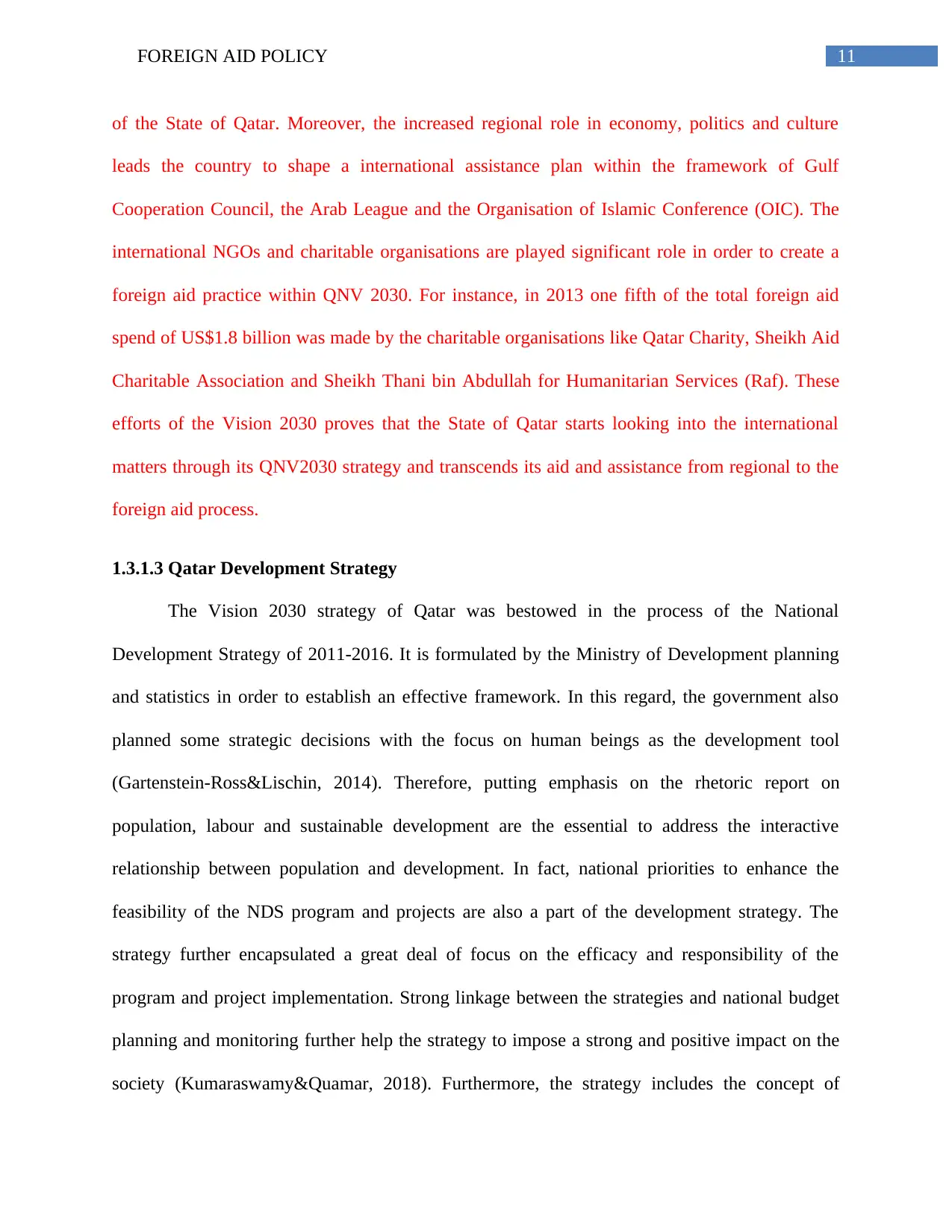
11FOREIGN AID POLICY
of the State of Qatar. Moreover, the increased regional role in economy, politics and culture
leads the country to shape a international assistance plan within the framework of Gulf
Cooperation Council, the Arab League and the Organisation of Islamic Conference (OIC). The
international NGOs and charitable organisations are played significant role in order to create a
foreign aid practice within QNV 2030. For instance, in 2013 one fifth of the total foreign aid
spend of US$1.8 billion was made by the charitable organisations like Qatar Charity, Sheikh Aid
Charitable Association and Sheikh Thani bin Abdullah for Humanitarian Services (Raf). These
efforts of the Vision 2030 proves that the State of Qatar starts looking into the international
matters through its QNV2030 strategy and transcends its aid and assistance from regional to the
foreign aid process.
1.3.1.3 Qatar Development Strategy
The Vision 2030 strategy of Qatar was bestowed in the process of the National
Development Strategy of 2011-2016. It is formulated by the Ministry of Development planning
and statistics in order to establish an effective framework. In this regard, the government also
planned some strategic decisions with the focus on human beings as the development tool
(Gartenstein-Ross&Lischin, 2014). Therefore, putting emphasis on the rhetoric report on
population, labour and sustainable development are the essential to address the interactive
relationship between population and development. In fact, national priorities to enhance the
feasibility of the NDS program and projects are also a part of the development strategy. The
strategy further encapsulated a great deal of focus on the efficacy and responsibility of the
program and project implementation. Strong linkage between the strategies and national budget
planning and monitoring further help the strategy to impose a strong and positive impact on the
society (Kumaraswamy&Quamar, 2018). Furthermore, the strategy includes the concept of
of the State of Qatar. Moreover, the increased regional role in economy, politics and culture
leads the country to shape a international assistance plan within the framework of Gulf
Cooperation Council, the Arab League and the Organisation of Islamic Conference (OIC). The
international NGOs and charitable organisations are played significant role in order to create a
foreign aid practice within QNV 2030. For instance, in 2013 one fifth of the total foreign aid
spend of US$1.8 billion was made by the charitable organisations like Qatar Charity, Sheikh Aid
Charitable Association and Sheikh Thani bin Abdullah for Humanitarian Services (Raf). These
efforts of the Vision 2030 proves that the State of Qatar starts looking into the international
matters through its QNV2030 strategy and transcends its aid and assistance from regional to the
foreign aid process.
1.3.1.3 Qatar Development Strategy
The Vision 2030 strategy of Qatar was bestowed in the process of the National
Development Strategy of 2011-2016. It is formulated by the Ministry of Development planning
and statistics in order to establish an effective framework. In this regard, the government also
planned some strategic decisions with the focus on human beings as the development tool
(Gartenstein-Ross&Lischin, 2014). Therefore, putting emphasis on the rhetoric report on
population, labour and sustainable development are the essential to address the interactive
relationship between population and development. In fact, national priorities to enhance the
feasibility of the NDS program and projects are also a part of the development strategy. The
strategy further encapsulated a great deal of focus on the efficacy and responsibility of the
program and project implementation. Strong linkage between the strategies and national budget
planning and monitoring further help the strategy to impose a strong and positive impact on the
society (Kumaraswamy&Quamar, 2018). Furthermore, the strategy includes the concept of
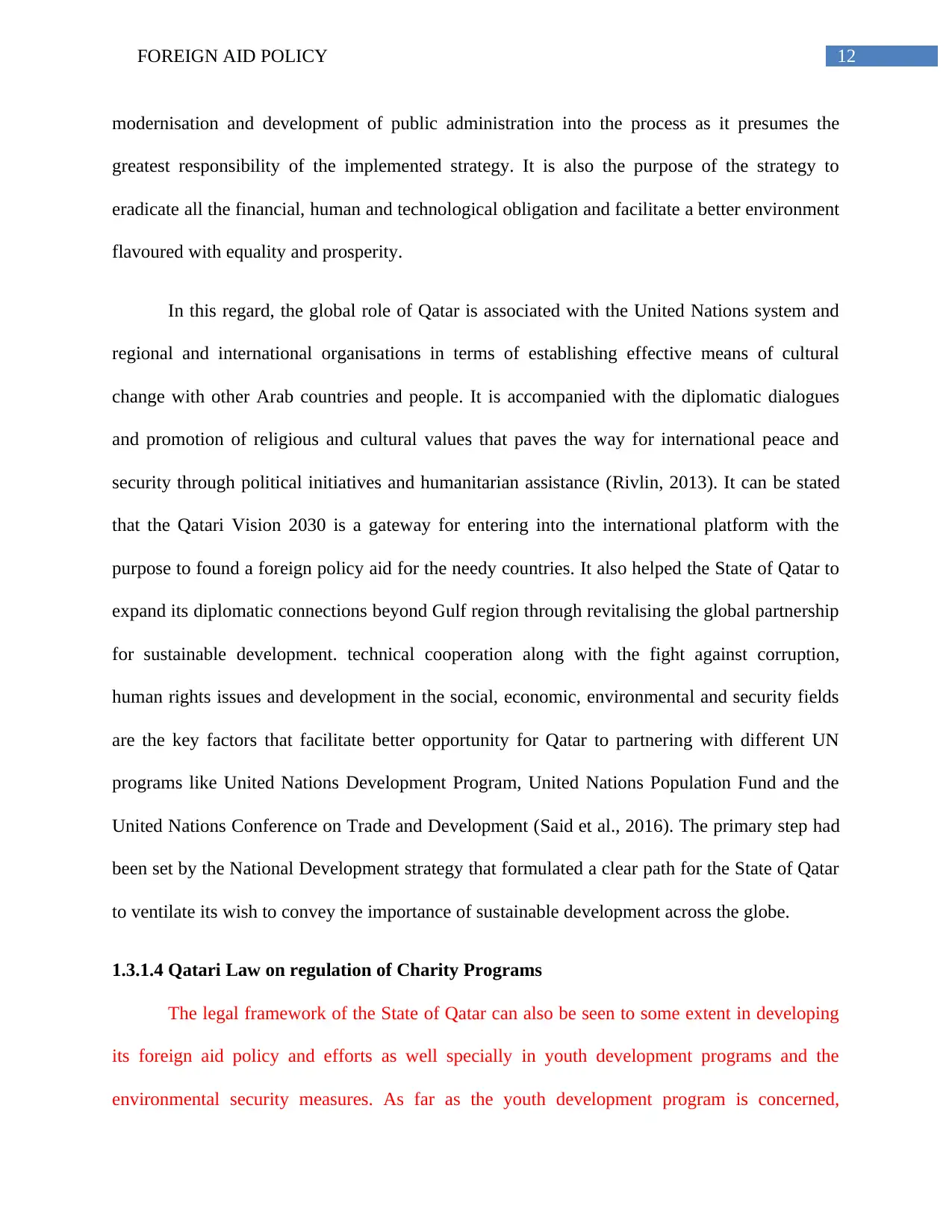
12FOREIGN AID POLICY
modernisation and development of public administration into the process as it presumes the
greatest responsibility of the implemented strategy. It is also the purpose of the strategy to
eradicate all the financial, human and technological obligation and facilitate a better environment
flavoured with equality and prosperity.
In this regard, the global role of Qatar is associated with the United Nations system and
regional and international organisations in terms of establishing effective means of cultural
change with other Arab countries and people. It is accompanied with the diplomatic dialogues
and promotion of religious and cultural values that paves the way for international peace and
security through political initiatives and humanitarian assistance (Rivlin, 2013). It can be stated
that the Qatari Vision 2030 is a gateway for entering into the international platform with the
purpose to found a foreign policy aid for the needy countries. It also helped the State of Qatar to
expand its diplomatic connections beyond Gulf region through revitalising the global partnership
for sustainable development. technical cooperation along with the fight against corruption,
human rights issues and development in the social, economic, environmental and security fields
are the key factors that facilitate better opportunity for Qatar to partnering with different UN
programs like United Nations Development Program, United Nations Population Fund and the
United Nations Conference on Trade and Development (Said et al., 2016). The primary step had
been set by the National Development strategy that formulated a clear path for the State of Qatar
to ventilate its wish to convey the importance of sustainable development across the globe.
1.3.1.4 Qatari Law on regulation of Charity Programs
The legal framework of the State of Qatar can also be seen to some extent in developing
its foreign aid policy and efforts as well specially in youth development programs and the
environmental security measures. As far as the youth development program is concerned,
modernisation and development of public administration into the process as it presumes the
greatest responsibility of the implemented strategy. It is also the purpose of the strategy to
eradicate all the financial, human and technological obligation and facilitate a better environment
flavoured with equality and prosperity.
In this regard, the global role of Qatar is associated with the United Nations system and
regional and international organisations in terms of establishing effective means of cultural
change with other Arab countries and people. It is accompanied with the diplomatic dialogues
and promotion of religious and cultural values that paves the way for international peace and
security through political initiatives and humanitarian assistance (Rivlin, 2013). It can be stated
that the Qatari Vision 2030 is a gateway for entering into the international platform with the
purpose to found a foreign policy aid for the needy countries. It also helped the State of Qatar to
expand its diplomatic connections beyond Gulf region through revitalising the global partnership
for sustainable development. technical cooperation along with the fight against corruption,
human rights issues and development in the social, economic, environmental and security fields
are the key factors that facilitate better opportunity for Qatar to partnering with different UN
programs like United Nations Development Program, United Nations Population Fund and the
United Nations Conference on Trade and Development (Said et al., 2016). The primary step had
been set by the National Development strategy that formulated a clear path for the State of Qatar
to ventilate its wish to convey the importance of sustainable development across the globe.
1.3.1.4 Qatari Law on regulation of Charity Programs
The legal framework of the State of Qatar can also be seen to some extent in developing
its foreign aid policy and efforts as well specially in youth development programs and the
environmental security measures. As far as the youth development program is concerned,
Paraphrase This Document
Need a fresh take? Get an instant paraphrase of this document with our AI Paraphraser
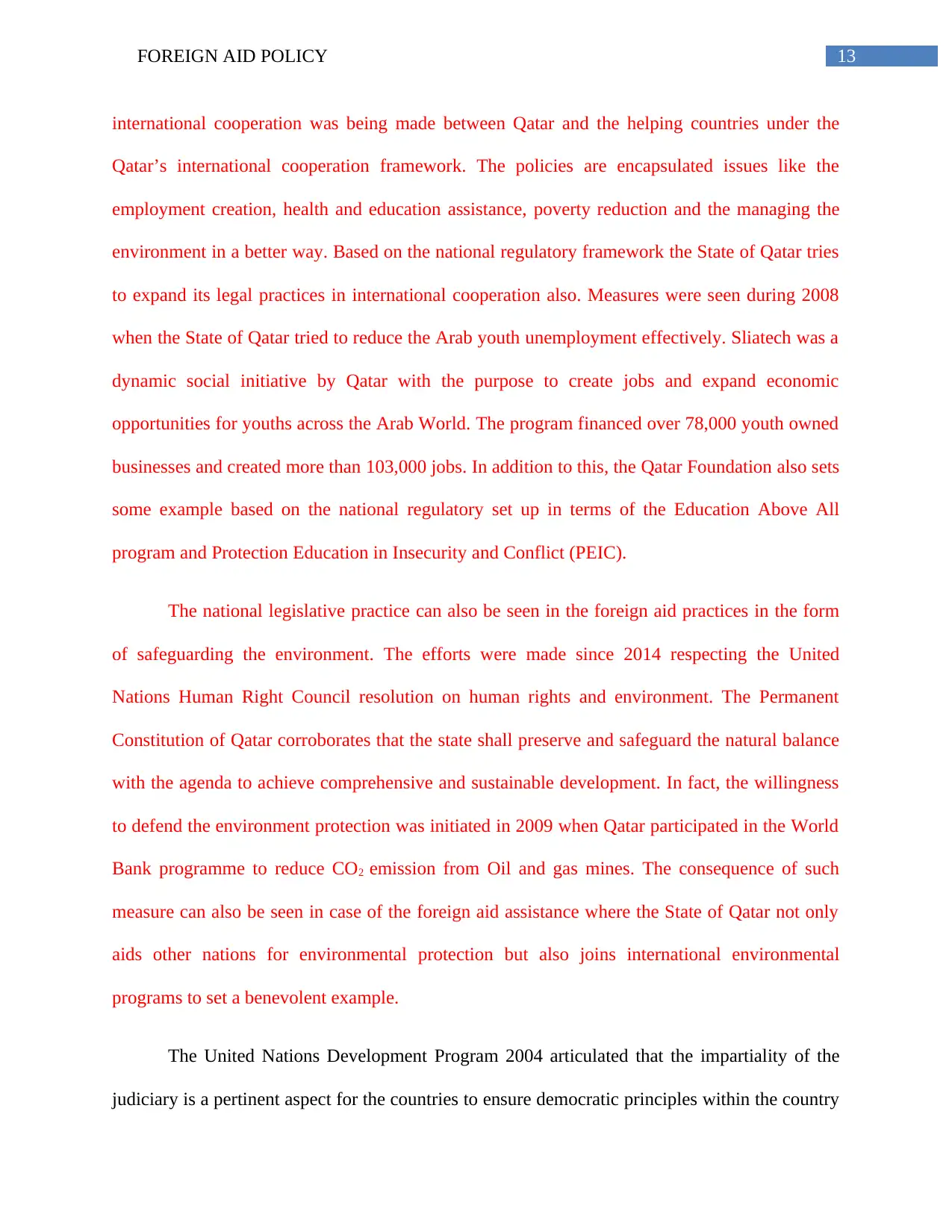
13FOREIGN AID POLICY
international cooperation was being made between Qatar and the helping countries under the
Qatar’s international cooperation framework. The policies are encapsulated issues like the
employment creation, health and education assistance, poverty reduction and the managing the
environment in a better way. Based on the national regulatory framework the State of Qatar tries
to expand its legal practices in international cooperation also. Measures were seen during 2008
when the State of Qatar tried to reduce the Arab youth unemployment effectively. Sliatech was a
dynamic social initiative by Qatar with the purpose to create jobs and expand economic
opportunities for youths across the Arab World. The program financed over 78,000 youth owned
businesses and created more than 103,000 jobs. In addition to this, the Qatar Foundation also sets
some example based on the national regulatory set up in terms of the Education Above All
program and Protection Education in Insecurity and Conflict (PEIC).
The national legislative practice can also be seen in the foreign aid practices in the form
of safeguarding the environment. The efforts were made since 2014 respecting the United
Nations Human Right Council resolution on human rights and environment. The Permanent
Constitution of Qatar corroborates that the state shall preserve and safeguard the natural balance
with the agenda to achieve comprehensive and sustainable development. In fact, the willingness
to defend the environment protection was initiated in 2009 when Qatar participated in the World
Bank programme to reduce CO2 emission from Oil and gas mines. The consequence of such
measure can also be seen in case of the foreign aid assistance where the State of Qatar not only
aids other nations for environmental protection but also joins international environmental
programs to set a benevolent example.
The United Nations Development Program 2004 articulated that the impartiality of the
judiciary is a pertinent aspect for the countries to ensure democratic principles within the country
international cooperation was being made between Qatar and the helping countries under the
Qatar’s international cooperation framework. The policies are encapsulated issues like the
employment creation, health and education assistance, poverty reduction and the managing the
environment in a better way. Based on the national regulatory framework the State of Qatar tries
to expand its legal practices in international cooperation also. Measures were seen during 2008
when the State of Qatar tried to reduce the Arab youth unemployment effectively. Sliatech was a
dynamic social initiative by Qatar with the purpose to create jobs and expand economic
opportunities for youths across the Arab World. The program financed over 78,000 youth owned
businesses and created more than 103,000 jobs. In addition to this, the Qatar Foundation also sets
some example based on the national regulatory set up in terms of the Education Above All
program and Protection Education in Insecurity and Conflict (PEIC).
The national legislative practice can also be seen in the foreign aid practices in the form
of safeguarding the environment. The efforts were made since 2014 respecting the United
Nations Human Right Council resolution on human rights and environment. The Permanent
Constitution of Qatar corroborates that the state shall preserve and safeguard the natural balance
with the agenda to achieve comprehensive and sustainable development. In fact, the willingness
to defend the environment protection was initiated in 2009 when Qatar participated in the World
Bank programme to reduce CO2 emission from Oil and gas mines. The consequence of such
measure can also be seen in case of the foreign aid assistance where the State of Qatar not only
aids other nations for environmental protection but also joins international environmental
programs to set a benevolent example.
The United Nations Development Program 2004 articulated that the impartiality of the
judiciary is a pertinent aspect for the countries to ensure democratic principles within the country
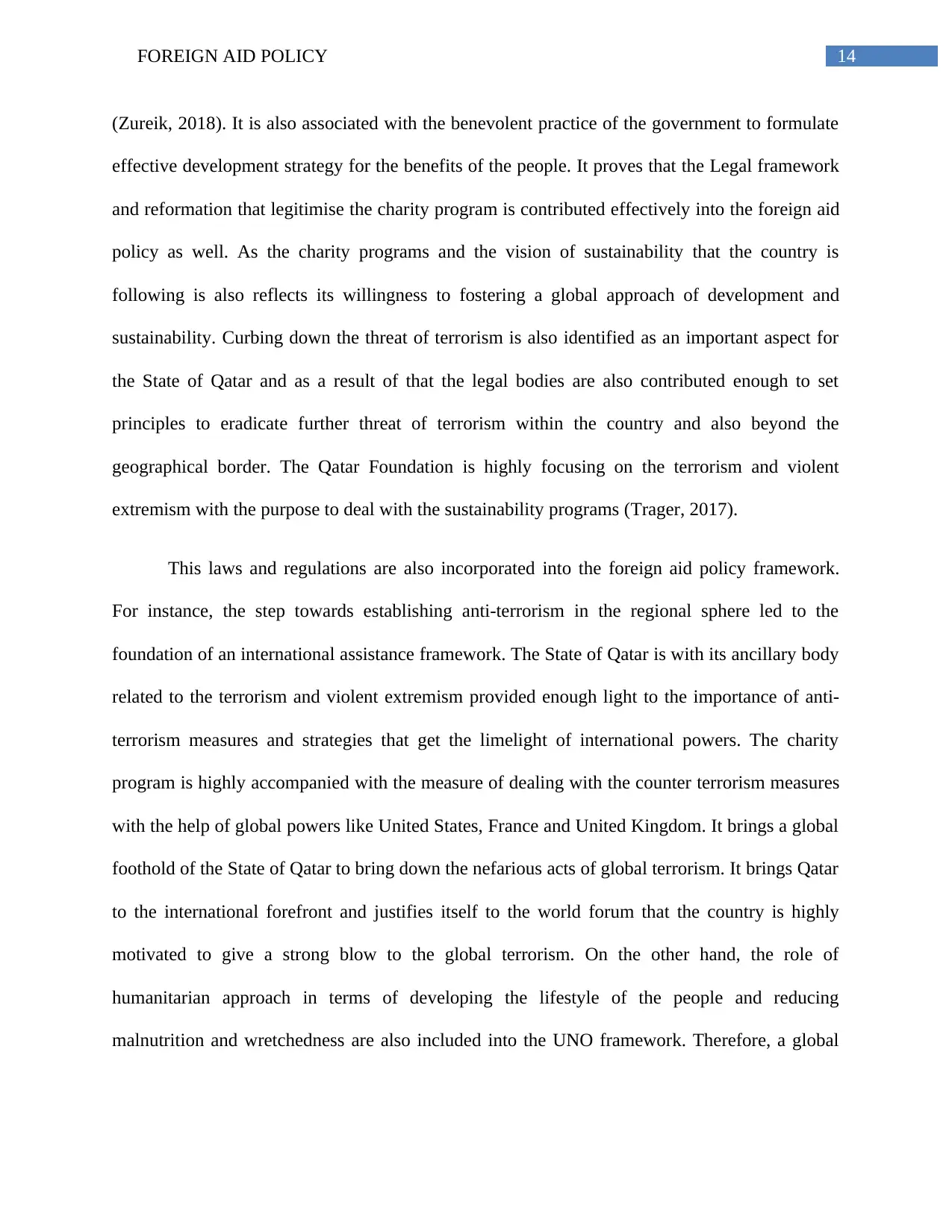
14FOREIGN AID POLICY
(Zureik, 2018). It is also associated with the benevolent practice of the government to formulate
effective development strategy for the benefits of the people. It proves that the Legal framework
and reformation that legitimise the charity program is contributed effectively into the foreign aid
policy as well. As the charity programs and the vision of sustainability that the country is
following is also reflects its willingness to fostering a global approach of development and
sustainability. Curbing down the threat of terrorism is also identified as an important aspect for
the State of Qatar and as a result of that the legal bodies are also contributed enough to set
principles to eradicate further threat of terrorism within the country and also beyond the
geographical border. The Qatar Foundation is highly focusing on the terrorism and violent
extremism with the purpose to deal with the sustainability programs (Trager, 2017).
This laws and regulations are also incorporated into the foreign aid policy framework.
For instance, the step towards establishing anti-terrorism in the regional sphere led to the
foundation of an international assistance framework. The State of Qatar is with its ancillary body
related to the terrorism and violent extremism provided enough light to the importance of anti-
terrorism measures and strategies that get the limelight of international powers. The charity
program is highly accompanied with the measure of dealing with the counter terrorism measures
with the help of global powers like United States, France and United Kingdom. It brings a global
foothold of the State of Qatar to bring down the nefarious acts of global terrorism. It brings Qatar
to the international forefront and justifies itself to the world forum that the country is highly
motivated to give a strong blow to the global terrorism. On the other hand, the role of
humanitarian approach in terms of developing the lifestyle of the people and reducing
malnutrition and wretchedness are also included into the UNO framework. Therefore, a global
(Zureik, 2018). It is also associated with the benevolent practice of the government to formulate
effective development strategy for the benefits of the people. It proves that the Legal framework
and reformation that legitimise the charity program is contributed effectively into the foreign aid
policy as well. As the charity programs and the vision of sustainability that the country is
following is also reflects its willingness to fostering a global approach of development and
sustainability. Curbing down the threat of terrorism is also identified as an important aspect for
the State of Qatar and as a result of that the legal bodies are also contributed enough to set
principles to eradicate further threat of terrorism within the country and also beyond the
geographical border. The Qatar Foundation is highly focusing on the terrorism and violent
extremism with the purpose to deal with the sustainability programs (Trager, 2017).
This laws and regulations are also incorporated into the foreign aid policy framework.
For instance, the step towards establishing anti-terrorism in the regional sphere led to the
foundation of an international assistance framework. The State of Qatar is with its ancillary body
related to the terrorism and violent extremism provided enough light to the importance of anti-
terrorism measures and strategies that get the limelight of international powers. The charity
program is highly accompanied with the measure of dealing with the counter terrorism measures
with the help of global powers like United States, France and United Kingdom. It brings a global
foothold of the State of Qatar to bring down the nefarious acts of global terrorism. It brings Qatar
to the international forefront and justifies itself to the world forum that the country is highly
motivated to give a strong blow to the global terrorism. On the other hand, the role of
humanitarian approach in terms of developing the lifestyle of the people and reducing
malnutrition and wretchedness are also included into the UNO framework. Therefore, a global
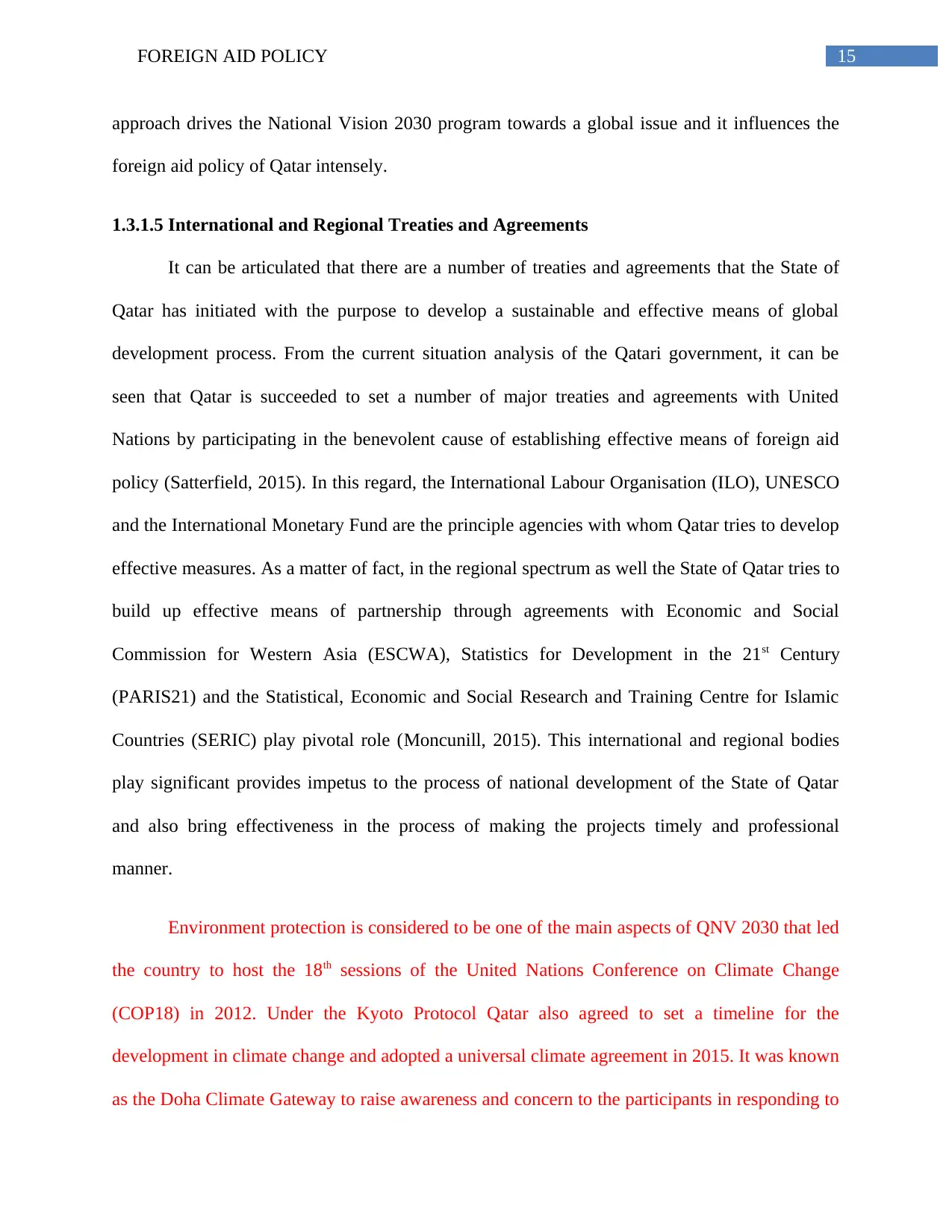
15FOREIGN AID POLICY
approach drives the National Vision 2030 program towards a global issue and it influences the
foreign aid policy of Qatar intensely.
1.3.1.5 International and Regional Treaties and Agreements
It can be articulated that there are a number of treaties and agreements that the State of
Qatar has initiated with the purpose to develop a sustainable and effective means of global
development process. From the current situation analysis of the Qatari government, it can be
seen that Qatar is succeeded to set a number of major treaties and agreements with United
Nations by participating in the benevolent cause of establishing effective means of foreign aid
policy (Satterfield, 2015). In this regard, the International Labour Organisation (ILO), UNESCO
and the International Monetary Fund are the principle agencies with whom Qatar tries to develop
effective measures. As a matter of fact, in the regional spectrum as well the State of Qatar tries to
build up effective means of partnership through agreements with Economic and Social
Commission for Western Asia (ESCWA), Statistics for Development in the 21st Century
(PARIS21) and the Statistical, Economic and Social Research and Training Centre for Islamic
Countries (SERIC) play pivotal role (Moncunill, 2015). This international and regional bodies
play significant provides impetus to the process of national development of the State of Qatar
and also bring effectiveness in the process of making the projects timely and professional
manner.
Environment protection is considered to be one of the main aspects of QNV 2030 that led
the country to host the 18th sessions of the United Nations Conference on Climate Change
(COP18) in 2012. Under the Kyoto Protocol Qatar also agreed to set a timeline for the
development in climate change and adopted a universal climate agreement in 2015. It was known
as the Doha Climate Gateway to raise awareness and concern to the participants in responding to
approach drives the National Vision 2030 program towards a global issue and it influences the
foreign aid policy of Qatar intensely.
1.3.1.5 International and Regional Treaties and Agreements
It can be articulated that there are a number of treaties and agreements that the State of
Qatar has initiated with the purpose to develop a sustainable and effective means of global
development process. From the current situation analysis of the Qatari government, it can be
seen that Qatar is succeeded to set a number of major treaties and agreements with United
Nations by participating in the benevolent cause of establishing effective means of foreign aid
policy (Satterfield, 2015). In this regard, the International Labour Organisation (ILO), UNESCO
and the International Monetary Fund are the principle agencies with whom Qatar tries to develop
effective measures. As a matter of fact, in the regional spectrum as well the State of Qatar tries to
build up effective means of partnership through agreements with Economic and Social
Commission for Western Asia (ESCWA), Statistics for Development in the 21st Century
(PARIS21) and the Statistical, Economic and Social Research and Training Centre for Islamic
Countries (SERIC) play pivotal role (Moncunill, 2015). This international and regional bodies
play significant provides impetus to the process of national development of the State of Qatar
and also bring effectiveness in the process of making the projects timely and professional
manner.
Environment protection is considered to be one of the main aspects of QNV 2030 that led
the country to host the 18th sessions of the United Nations Conference on Climate Change
(COP18) in 2012. Under the Kyoto Protocol Qatar also agreed to set a timeline for the
development in climate change and adopted a universal climate agreement in 2015. It was known
as the Doha Climate Gateway to raise awareness and concern to the participants in responding to
Secure Best Marks with AI Grader
Need help grading? Try our AI Grader for instant feedback on your assignments.
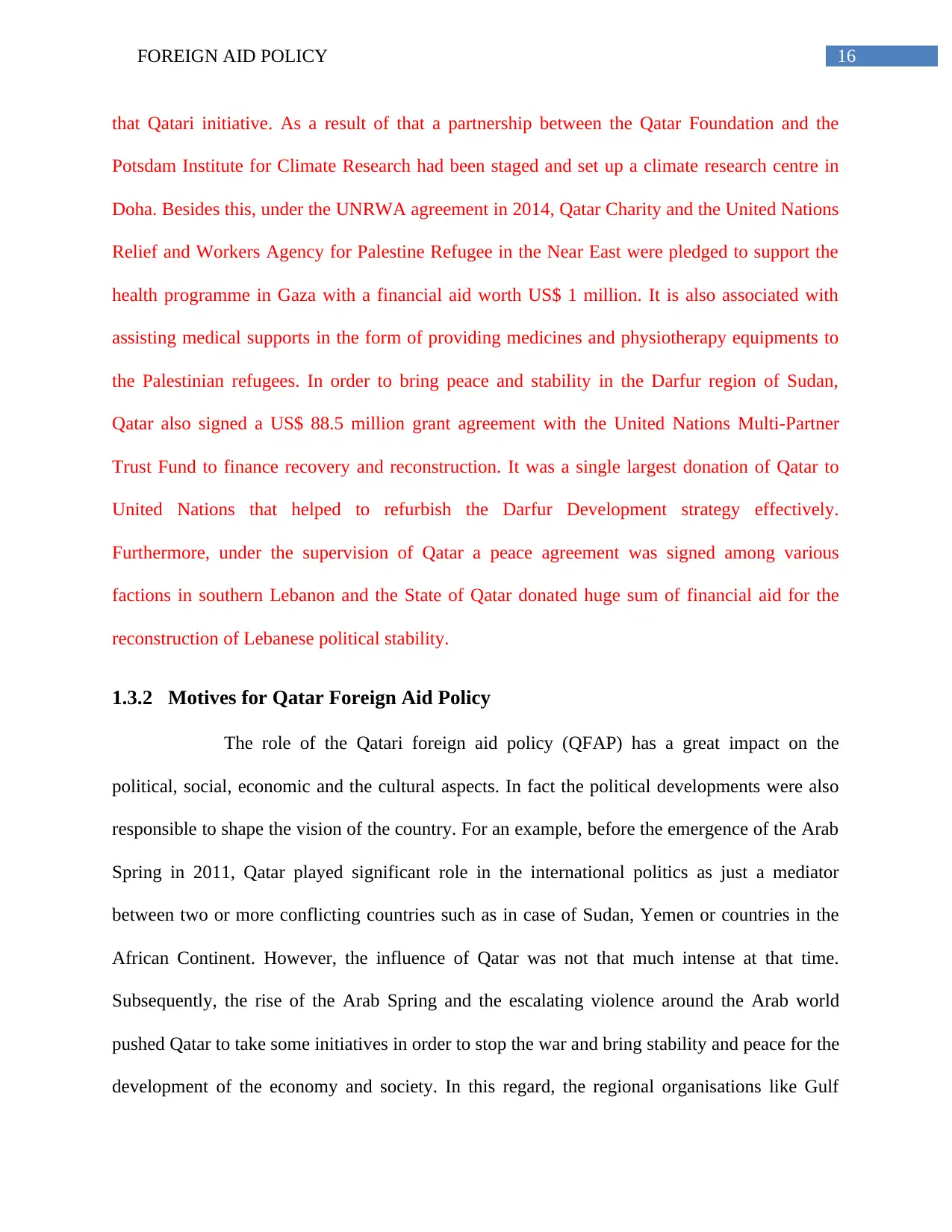
16FOREIGN AID POLICY
that Qatari initiative. As a result of that a partnership between the Qatar Foundation and the
Potsdam Institute for Climate Research had been staged and set up a climate research centre in
Doha. Besides this, under the UNRWA agreement in 2014, Qatar Charity and the United Nations
Relief and Workers Agency for Palestine Refugee in the Near East were pledged to support the
health programme in Gaza with a financial aid worth US$ 1 million. It is also associated with
assisting medical supports in the form of providing medicines and physiotherapy equipments to
the Palestinian refugees. In order to bring peace and stability in the Darfur region of Sudan,
Qatar also signed a US$ 88.5 million grant agreement with the United Nations Multi-Partner
Trust Fund to finance recovery and reconstruction. It was a single largest donation of Qatar to
United Nations that helped to refurbish the Darfur Development strategy effectively.
Furthermore, under the supervision of Qatar a peace agreement was signed among various
factions in southern Lebanon and the State of Qatar donated huge sum of financial aid for the
reconstruction of Lebanese political stability.
1.3.2 Motives for Qatar Foreign Aid Policy
The role of the Qatari foreign aid policy (QFAP) has a great impact on the
political, social, economic and the cultural aspects. In fact the political developments were also
responsible to shape the vision of the country. For an example, before the emergence of the Arab
Spring in 2011, Qatar played significant role in the international politics as just a mediator
between two or more conflicting countries such as in case of Sudan, Yemen or countries in the
African Continent. However, the influence of Qatar was not that much intense at that time.
Subsequently, the rise of the Arab Spring and the escalating violence around the Arab world
pushed Qatar to take some initiatives in order to stop the war and bring stability and peace for the
development of the economy and society. In this regard, the regional organisations like Gulf
that Qatari initiative. As a result of that a partnership between the Qatar Foundation and the
Potsdam Institute for Climate Research had been staged and set up a climate research centre in
Doha. Besides this, under the UNRWA agreement in 2014, Qatar Charity and the United Nations
Relief and Workers Agency for Palestine Refugee in the Near East were pledged to support the
health programme in Gaza with a financial aid worth US$ 1 million. It is also associated with
assisting medical supports in the form of providing medicines and physiotherapy equipments to
the Palestinian refugees. In order to bring peace and stability in the Darfur region of Sudan,
Qatar also signed a US$ 88.5 million grant agreement with the United Nations Multi-Partner
Trust Fund to finance recovery and reconstruction. It was a single largest donation of Qatar to
United Nations that helped to refurbish the Darfur Development strategy effectively.
Furthermore, under the supervision of Qatar a peace agreement was signed among various
factions in southern Lebanon and the State of Qatar donated huge sum of financial aid for the
reconstruction of Lebanese political stability.
1.3.2 Motives for Qatar Foreign Aid Policy
The role of the Qatari foreign aid policy (QFAP) has a great impact on the
political, social, economic and the cultural aspects. In fact the political developments were also
responsible to shape the vision of the country. For an example, before the emergence of the Arab
Spring in 2011, Qatar played significant role in the international politics as just a mediator
between two or more conflicting countries such as in case of Sudan, Yemen or countries in the
African Continent. However, the influence of Qatar was not that much intense at that time.
Subsequently, the rise of the Arab Spring and the escalating violence around the Arab world
pushed Qatar to take some initiatives in order to stop the war and bring stability and peace for the
development of the economy and society. In this regard, the regional organisations like Gulf
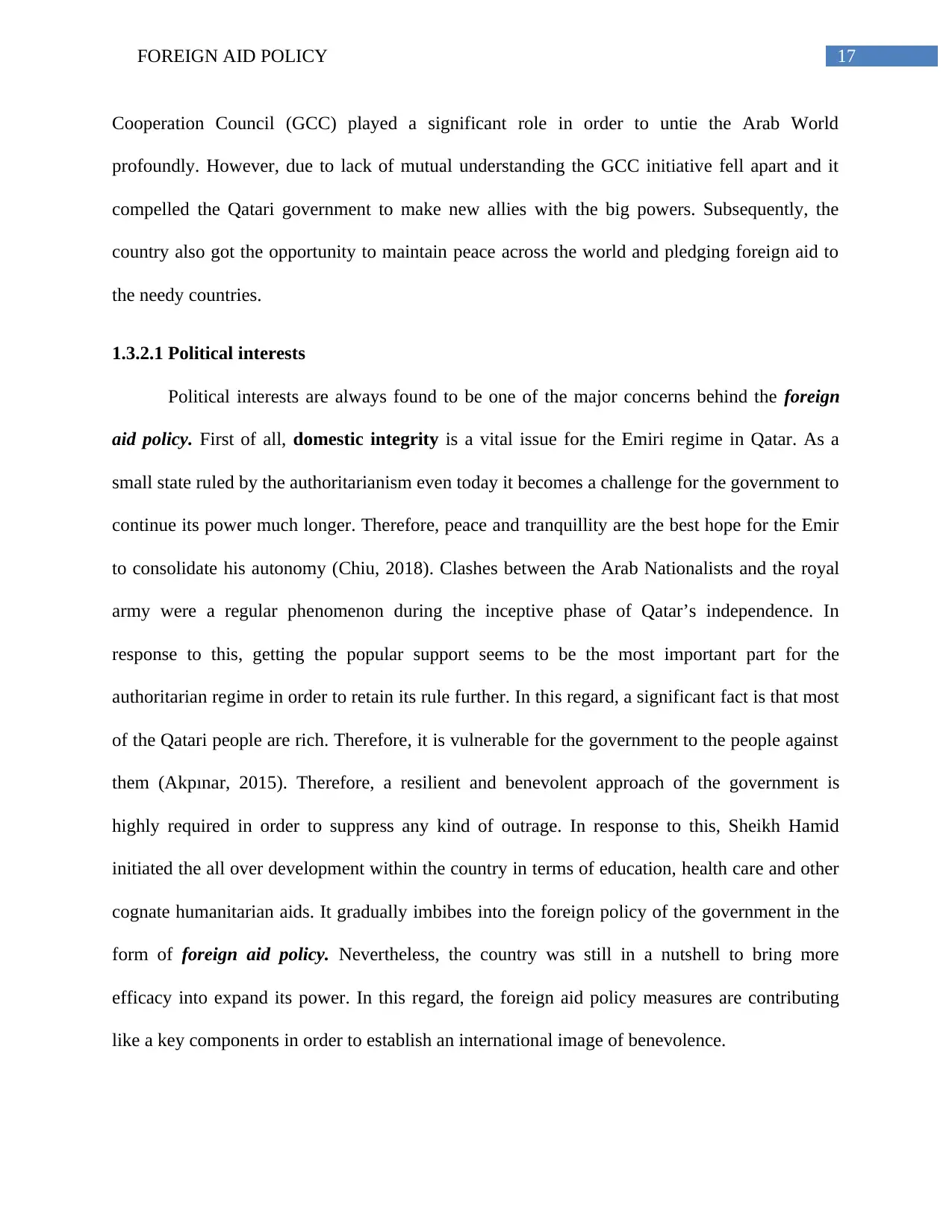
17FOREIGN AID POLICY
Cooperation Council (GCC) played a significant role in order to untie the Arab World
profoundly. However, due to lack of mutual understanding the GCC initiative fell apart and it
compelled the Qatari government to make new allies with the big powers. Subsequently, the
country also got the opportunity to maintain peace across the world and pledging foreign aid to
the needy countries.
1.3.2.1 Political interests
Political interests are always found to be one of the major concerns behind the foreign
aid policy. First of all, domestic integrity is a vital issue for the Emiri regime in Qatar. As a
small state ruled by the authoritarianism even today it becomes a challenge for the government to
continue its power much longer. Therefore, peace and tranquillity are the best hope for the Emir
to consolidate his autonomy (Chiu, 2018). Clashes between the Arab Nationalists and the royal
army were a regular phenomenon during the inceptive phase of Qatar’s independence. In
response to this, getting the popular support seems to be the most important part for the
authoritarian regime in order to retain its rule further. In this regard, a significant fact is that most
of the Qatari people are rich. Therefore, it is vulnerable for the government to the people against
them (Akpınar, 2015). Therefore, a resilient and benevolent approach of the government is
highly required in order to suppress any kind of outrage. In response to this, Sheikh Hamid
initiated the all over development within the country in terms of education, health care and other
cognate humanitarian aids. It gradually imbibes into the foreign policy of the government in the
form of foreign aid policy. Nevertheless, the country was still in a nutshell to bring more
efficacy into expand its power. In this regard, the foreign aid policy measures are contributing
like a key components in order to establish an international image of benevolence.
Cooperation Council (GCC) played a significant role in order to untie the Arab World
profoundly. However, due to lack of mutual understanding the GCC initiative fell apart and it
compelled the Qatari government to make new allies with the big powers. Subsequently, the
country also got the opportunity to maintain peace across the world and pledging foreign aid to
the needy countries.
1.3.2.1 Political interests
Political interests are always found to be one of the major concerns behind the foreign
aid policy. First of all, domestic integrity is a vital issue for the Emiri regime in Qatar. As a
small state ruled by the authoritarianism even today it becomes a challenge for the government to
continue its power much longer. Therefore, peace and tranquillity are the best hope for the Emir
to consolidate his autonomy (Chiu, 2018). Clashes between the Arab Nationalists and the royal
army were a regular phenomenon during the inceptive phase of Qatar’s independence. In
response to this, getting the popular support seems to be the most important part for the
authoritarian regime in order to retain its rule further. In this regard, a significant fact is that most
of the Qatari people are rich. Therefore, it is vulnerable for the government to the people against
them (Akpınar, 2015). Therefore, a resilient and benevolent approach of the government is
highly required in order to suppress any kind of outrage. In response to this, Sheikh Hamid
initiated the all over development within the country in terms of education, health care and other
cognate humanitarian aids. It gradually imbibes into the foreign policy of the government in the
form of foreign aid policy. Nevertheless, the country was still in a nutshell to bring more
efficacy into expand its power. In this regard, the foreign aid policy measures are contributing
like a key components in order to establish an international image of benevolence.
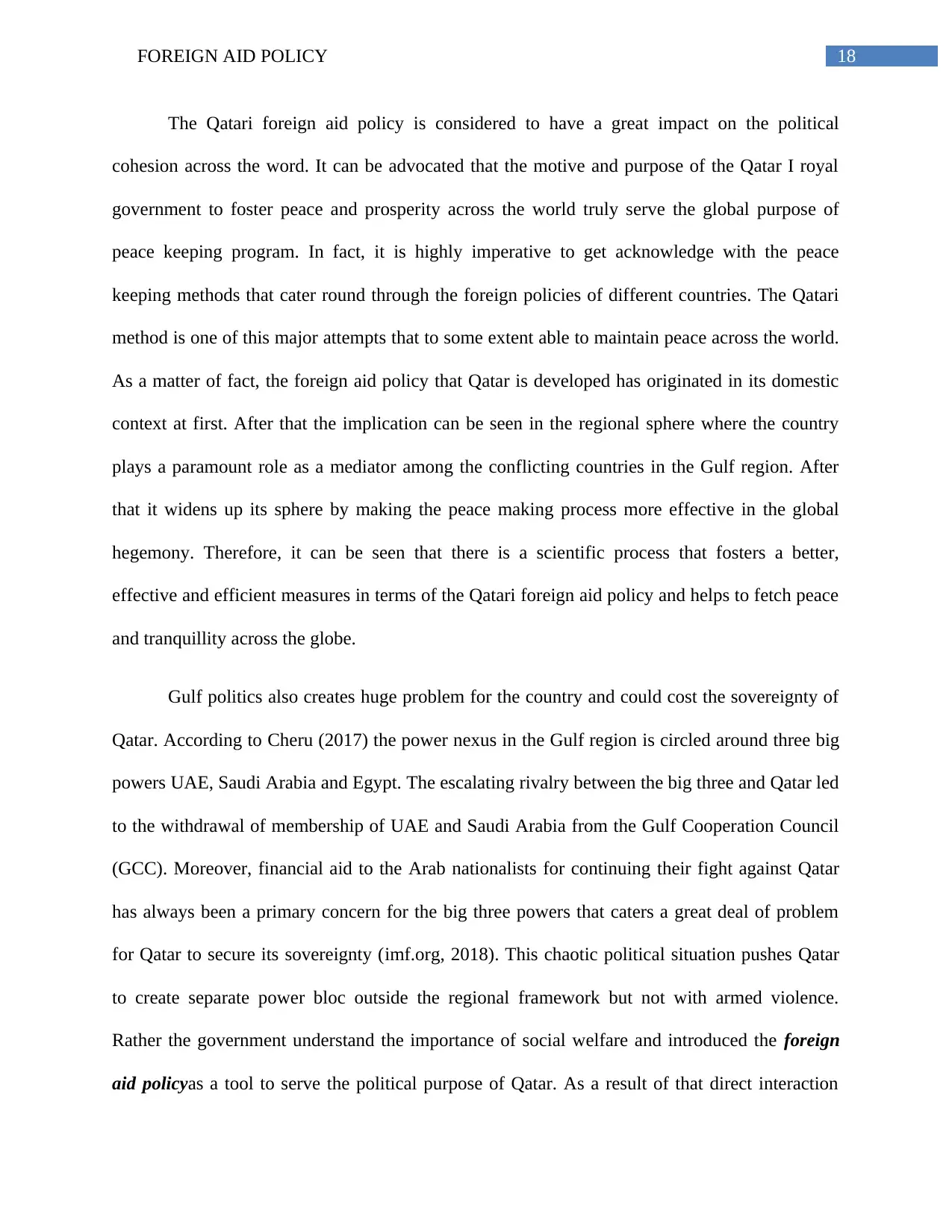
18FOREIGN AID POLICY
The Qatari foreign aid policy is considered to have a great impact on the political
cohesion across the word. It can be advocated that the motive and purpose of the Qatar I royal
government to foster peace and prosperity across the world truly serve the global purpose of
peace keeping program. In fact, it is highly imperative to get acknowledge with the peace
keeping methods that cater round through the foreign policies of different countries. The Qatari
method is one of this major attempts that to some extent able to maintain peace across the world.
As a matter of fact, the foreign aid policy that Qatar is developed has originated in its domestic
context at first. After that the implication can be seen in the regional sphere where the country
plays a paramount role as a mediator among the conflicting countries in the Gulf region. After
that it widens up its sphere by making the peace making process more effective in the global
hegemony. Therefore, it can be seen that there is a scientific process that fosters a better,
effective and efficient measures in terms of the Qatari foreign aid policy and helps to fetch peace
and tranquillity across the globe.
Gulf politics also creates huge problem for the country and could cost the sovereignty of
Qatar. According to Cheru (2017) the power nexus in the Gulf region is circled around three big
powers UAE, Saudi Arabia and Egypt. The escalating rivalry between the big three and Qatar led
to the withdrawal of membership of UAE and Saudi Arabia from the Gulf Cooperation Council
(GCC). Moreover, financial aid to the Arab nationalists for continuing their fight against Qatar
has always been a primary concern for the big three powers that caters a great deal of problem
for Qatar to secure its sovereignty (imf.org, 2018). This chaotic political situation pushes Qatar
to create separate power bloc outside the regional framework but not with armed violence.
Rather the government understand the importance of social welfare and introduced the foreign
aid policyas a tool to serve the political purpose of Qatar. As a result of that direct interaction
The Qatari foreign aid policy is considered to have a great impact on the political
cohesion across the word. It can be advocated that the motive and purpose of the Qatar I royal
government to foster peace and prosperity across the world truly serve the global purpose of
peace keeping program. In fact, it is highly imperative to get acknowledge with the peace
keeping methods that cater round through the foreign policies of different countries. The Qatari
method is one of this major attempts that to some extent able to maintain peace across the world.
As a matter of fact, the foreign aid policy that Qatar is developed has originated in its domestic
context at first. After that the implication can be seen in the regional sphere where the country
plays a paramount role as a mediator among the conflicting countries in the Gulf region. After
that it widens up its sphere by making the peace making process more effective in the global
hegemony. Therefore, it can be seen that there is a scientific process that fosters a better,
effective and efficient measures in terms of the Qatari foreign aid policy and helps to fetch peace
and tranquillity across the globe.
Gulf politics also creates huge problem for the country and could cost the sovereignty of
Qatar. According to Cheru (2017) the power nexus in the Gulf region is circled around three big
powers UAE, Saudi Arabia and Egypt. The escalating rivalry between the big three and Qatar led
to the withdrawal of membership of UAE and Saudi Arabia from the Gulf Cooperation Council
(GCC). Moreover, financial aid to the Arab nationalists for continuing their fight against Qatar
has always been a primary concern for the big three powers that caters a great deal of problem
for Qatar to secure its sovereignty (imf.org, 2018). This chaotic political situation pushes Qatar
to create separate power bloc outside the regional framework but not with armed violence.
Rather the government understand the importance of social welfare and introduced the foreign
aid policyas a tool to serve the political purpose of Qatar. As a result of that direct interaction
Paraphrase This Document
Need a fresh take? Get an instant paraphrase of this document with our AI Paraphraser
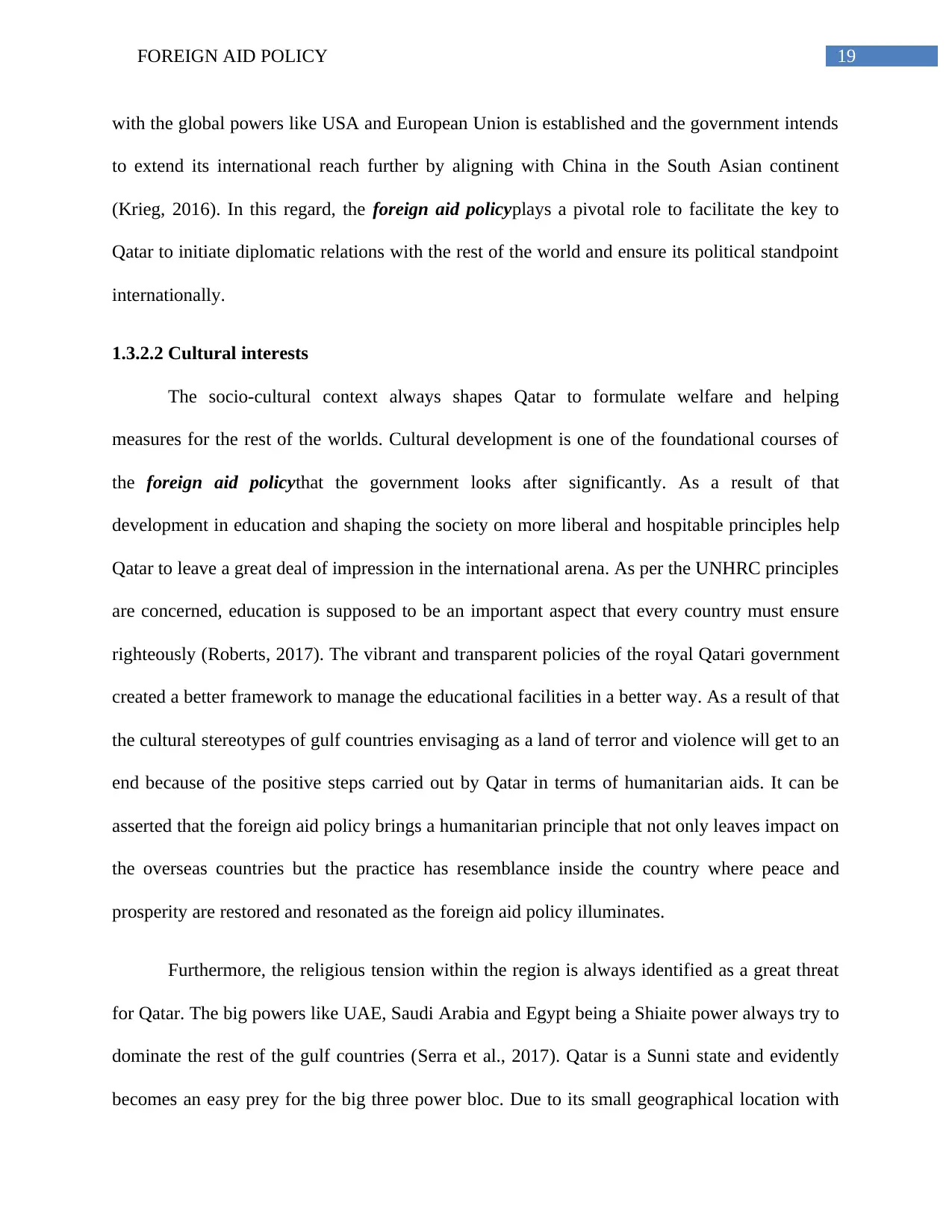
19FOREIGN AID POLICY
with the global powers like USA and European Union is established and the government intends
to extend its international reach further by aligning with China in the South Asian continent
(Krieg, 2016). In this regard, the foreign aid policyplays a pivotal role to facilitate the key to
Qatar to initiate diplomatic relations with the rest of the world and ensure its political standpoint
internationally.
1.3.2.2 Cultural interests
The socio-cultural context always shapes Qatar to formulate welfare and helping
measures for the rest of the worlds. Cultural development is one of the foundational courses of
the foreign aid policythat the government looks after significantly. As a result of that
development in education and shaping the society on more liberal and hospitable principles help
Qatar to leave a great deal of impression in the international arena. As per the UNHRC principles
are concerned, education is supposed to be an important aspect that every country must ensure
righteously (Roberts, 2017). The vibrant and transparent policies of the royal Qatari government
created a better framework to manage the educational facilities in a better way. As a result of that
the cultural stereotypes of gulf countries envisaging as a land of terror and violence will get to an
end because of the positive steps carried out by Qatar in terms of humanitarian aids. It can be
asserted that the foreign aid policy brings a humanitarian principle that not only leaves impact on
the overseas countries but the practice has resemblance inside the country where peace and
prosperity are restored and resonated as the foreign aid policy illuminates.
Furthermore, the religious tension within the region is always identified as a great threat
for Qatar. The big powers like UAE, Saudi Arabia and Egypt being a Shiaite power always try to
dominate the rest of the gulf countries (Serra et al., 2017). Qatar is a Sunni state and evidently
becomes an easy prey for the big three power bloc. Due to its small geographical location with
with the global powers like USA and European Union is established and the government intends
to extend its international reach further by aligning with China in the South Asian continent
(Krieg, 2016). In this regard, the foreign aid policyplays a pivotal role to facilitate the key to
Qatar to initiate diplomatic relations with the rest of the world and ensure its political standpoint
internationally.
1.3.2.2 Cultural interests
The socio-cultural context always shapes Qatar to formulate welfare and helping
measures for the rest of the worlds. Cultural development is one of the foundational courses of
the foreign aid policythat the government looks after significantly. As a result of that
development in education and shaping the society on more liberal and hospitable principles help
Qatar to leave a great deal of impression in the international arena. As per the UNHRC principles
are concerned, education is supposed to be an important aspect that every country must ensure
righteously (Roberts, 2017). The vibrant and transparent policies of the royal Qatari government
created a better framework to manage the educational facilities in a better way. As a result of that
the cultural stereotypes of gulf countries envisaging as a land of terror and violence will get to an
end because of the positive steps carried out by Qatar in terms of humanitarian aids. It can be
asserted that the foreign aid policy brings a humanitarian principle that not only leaves impact on
the overseas countries but the practice has resemblance inside the country where peace and
prosperity are restored and resonated as the foreign aid policy illuminates.
Furthermore, the religious tension within the region is always identified as a great threat
for Qatar. The big powers like UAE, Saudi Arabia and Egypt being a Shiaite power always try to
dominate the rest of the gulf countries (Serra et al., 2017). Qatar is a Sunni state and evidently
becomes an easy prey for the big three power bloc. Due to its small geographical location with
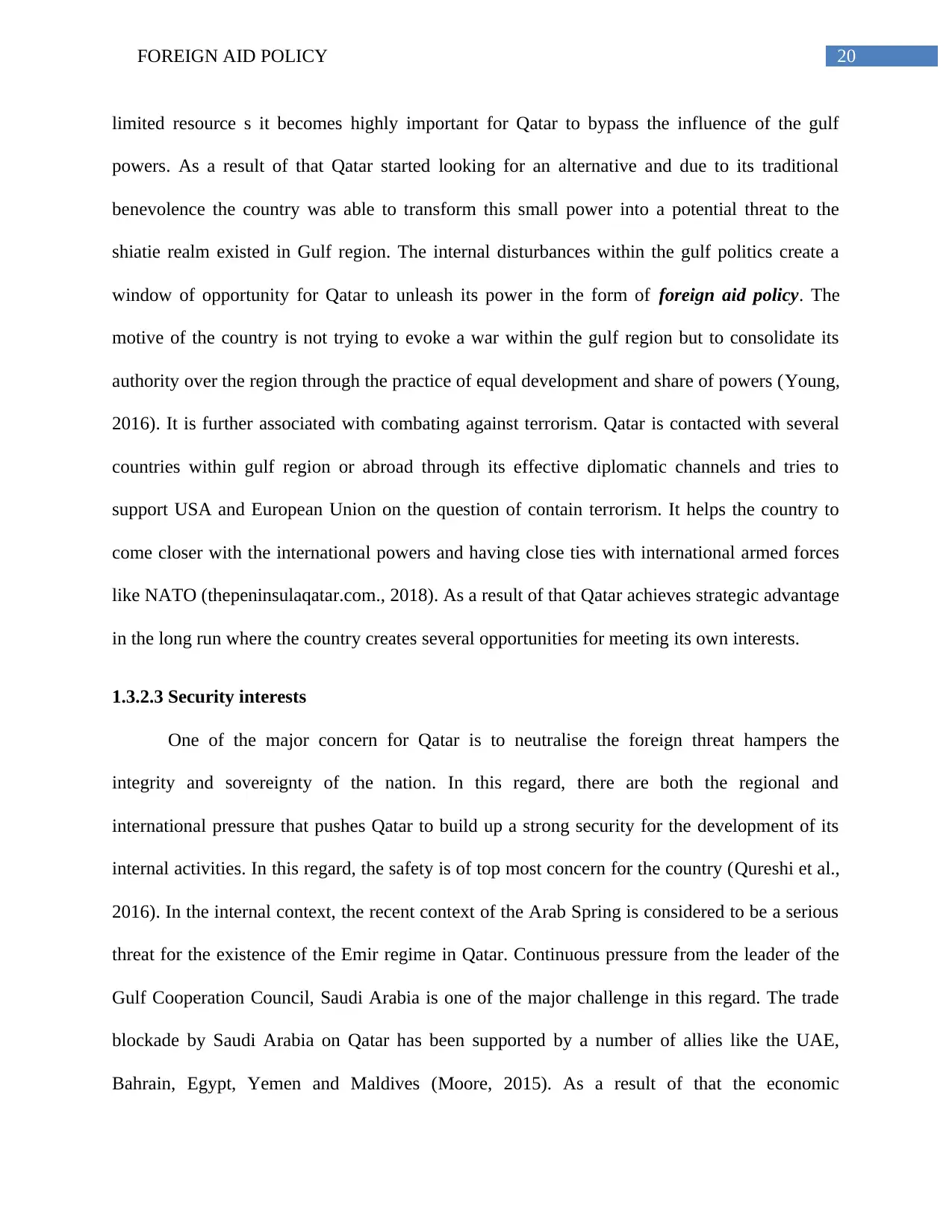
20FOREIGN AID POLICY
limited resource s it becomes highly important for Qatar to bypass the influence of the gulf
powers. As a result of that Qatar started looking for an alternative and due to its traditional
benevolence the country was able to transform this small power into a potential threat to the
shiatie realm existed in Gulf region. The internal disturbances within the gulf politics create a
window of opportunity for Qatar to unleash its power in the form of foreign aid policy. The
motive of the country is not trying to evoke a war within the gulf region but to consolidate its
authority over the region through the practice of equal development and share of powers (Young,
2016). It is further associated with combating against terrorism. Qatar is contacted with several
countries within gulf region or abroad through its effective diplomatic channels and tries to
support USA and European Union on the question of contain terrorism. It helps the country to
come closer with the international powers and having close ties with international armed forces
like NATO (thepeninsulaqatar.com., 2018). As a result of that Qatar achieves strategic advantage
in the long run where the country creates several opportunities for meeting its own interests.
1.3.2.3 Security interests
One of the major concern for Qatar is to neutralise the foreign threat hampers the
integrity and sovereignty of the nation. In this regard, there are both the regional and
international pressure that pushes Qatar to build up a strong security for the development of its
internal activities. In this regard, the safety is of top most concern for the country (Qureshi et al.,
2016). In the internal context, the recent context of the Arab Spring is considered to be a serious
threat for the existence of the Emir regime in Qatar. Continuous pressure from the leader of the
Gulf Cooperation Council, Saudi Arabia is one of the major challenge in this regard. The trade
blockade by Saudi Arabia on Qatar has been supported by a number of allies like the UAE,
Bahrain, Egypt, Yemen and Maldives (Moore, 2015). As a result of that the economic
limited resource s it becomes highly important for Qatar to bypass the influence of the gulf
powers. As a result of that Qatar started looking for an alternative and due to its traditional
benevolence the country was able to transform this small power into a potential threat to the
shiatie realm existed in Gulf region. The internal disturbances within the gulf politics create a
window of opportunity for Qatar to unleash its power in the form of foreign aid policy. The
motive of the country is not trying to evoke a war within the gulf region but to consolidate its
authority over the region through the practice of equal development and share of powers (Young,
2016). It is further associated with combating against terrorism. Qatar is contacted with several
countries within gulf region or abroad through its effective diplomatic channels and tries to
support USA and European Union on the question of contain terrorism. It helps the country to
come closer with the international powers and having close ties with international armed forces
like NATO (thepeninsulaqatar.com., 2018). As a result of that Qatar achieves strategic advantage
in the long run where the country creates several opportunities for meeting its own interests.
1.3.2.3 Security interests
One of the major concern for Qatar is to neutralise the foreign threat hampers the
integrity and sovereignty of the nation. In this regard, there are both the regional and
international pressure that pushes Qatar to build up a strong security for the development of its
internal activities. In this regard, the safety is of top most concern for the country (Qureshi et al.,
2016). In the internal context, the recent context of the Arab Spring is considered to be a serious
threat for the existence of the Emir regime in Qatar. Continuous pressure from the leader of the
Gulf Cooperation Council, Saudi Arabia is one of the major challenge in this regard. The trade
blockade by Saudi Arabia on Qatar has been supported by a number of allies like the UAE,
Bahrain, Egypt, Yemen and Maldives (Moore, 2015). As a result of that the economic
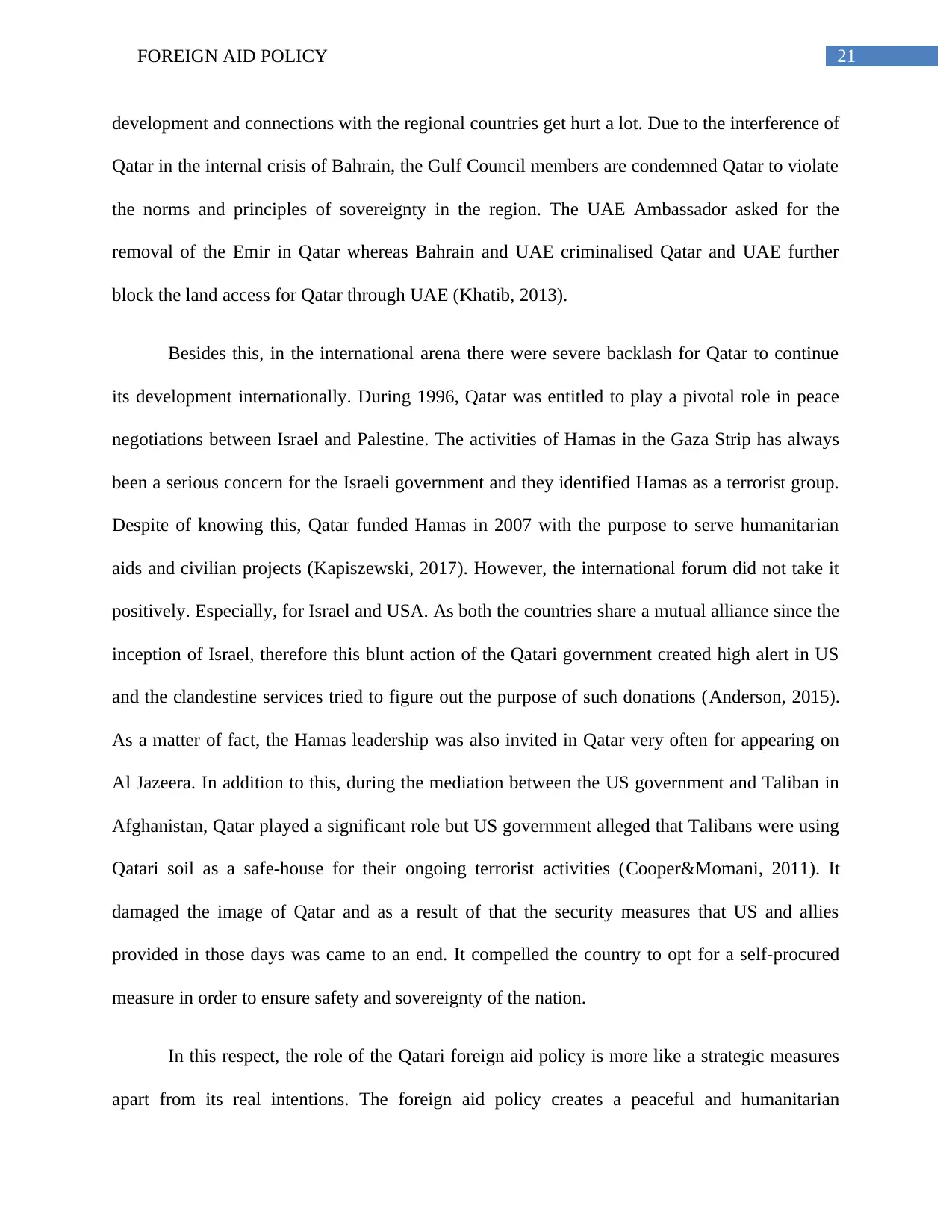
21FOREIGN AID POLICY
development and connections with the regional countries get hurt a lot. Due to the interference of
Qatar in the internal crisis of Bahrain, the Gulf Council members are condemned Qatar to violate
the norms and principles of sovereignty in the region. The UAE Ambassador asked for the
removal of the Emir in Qatar whereas Bahrain and UAE criminalised Qatar and UAE further
block the land access for Qatar through UAE (Khatib, 2013).
Besides this, in the international arena there were severe backlash for Qatar to continue
its development internationally. During 1996, Qatar was entitled to play a pivotal role in peace
negotiations between Israel and Palestine. The activities of Hamas in the Gaza Strip has always
been a serious concern for the Israeli government and they identified Hamas as a terrorist group.
Despite of knowing this, Qatar funded Hamas in 2007 with the purpose to serve humanitarian
aids and civilian projects (Kapiszewski, 2017). However, the international forum did not take it
positively. Especially, for Israel and USA. As both the countries share a mutual alliance since the
inception of Israel, therefore this blunt action of the Qatari government created high alert in US
and the clandestine services tried to figure out the purpose of such donations (Anderson, 2015).
As a matter of fact, the Hamas leadership was also invited in Qatar very often for appearing on
Al Jazeera. In addition to this, during the mediation between the US government and Taliban in
Afghanistan, Qatar played a significant role but US government alleged that Talibans were using
Qatari soil as a safe-house for their ongoing terrorist activities (Cooper&Momani, 2011). It
damaged the image of Qatar and as a result of that the security measures that US and allies
provided in those days was came to an end. It compelled the country to opt for a self-procured
measure in order to ensure safety and sovereignty of the nation.
In this respect, the role of the Qatari foreign aid policy is more like a strategic measures
apart from its real intentions. The foreign aid policy creates a peaceful and humanitarian
development and connections with the regional countries get hurt a lot. Due to the interference of
Qatar in the internal crisis of Bahrain, the Gulf Council members are condemned Qatar to violate
the norms and principles of sovereignty in the region. The UAE Ambassador asked for the
removal of the Emir in Qatar whereas Bahrain and UAE criminalised Qatar and UAE further
block the land access for Qatar through UAE (Khatib, 2013).
Besides this, in the international arena there were severe backlash for Qatar to continue
its development internationally. During 1996, Qatar was entitled to play a pivotal role in peace
negotiations between Israel and Palestine. The activities of Hamas in the Gaza Strip has always
been a serious concern for the Israeli government and they identified Hamas as a terrorist group.
Despite of knowing this, Qatar funded Hamas in 2007 with the purpose to serve humanitarian
aids and civilian projects (Kapiszewski, 2017). However, the international forum did not take it
positively. Especially, for Israel and USA. As both the countries share a mutual alliance since the
inception of Israel, therefore this blunt action of the Qatari government created high alert in US
and the clandestine services tried to figure out the purpose of such donations (Anderson, 2015).
As a matter of fact, the Hamas leadership was also invited in Qatar very often for appearing on
Al Jazeera. In addition to this, during the mediation between the US government and Taliban in
Afghanistan, Qatar played a significant role but US government alleged that Talibans were using
Qatari soil as a safe-house for their ongoing terrorist activities (Cooper&Momani, 2011). It
damaged the image of Qatar and as a result of that the security measures that US and allies
provided in those days was came to an end. It compelled the country to opt for a self-procured
measure in order to ensure safety and sovereignty of the nation.
In this respect, the role of the Qatari foreign aid policy is more like a strategic measures
apart from its real intentions. The foreign aid policy creates a peaceful and humanitarian
Secure Best Marks with AI Grader
Need help grading? Try our AI Grader for instant feedback on your assignments.
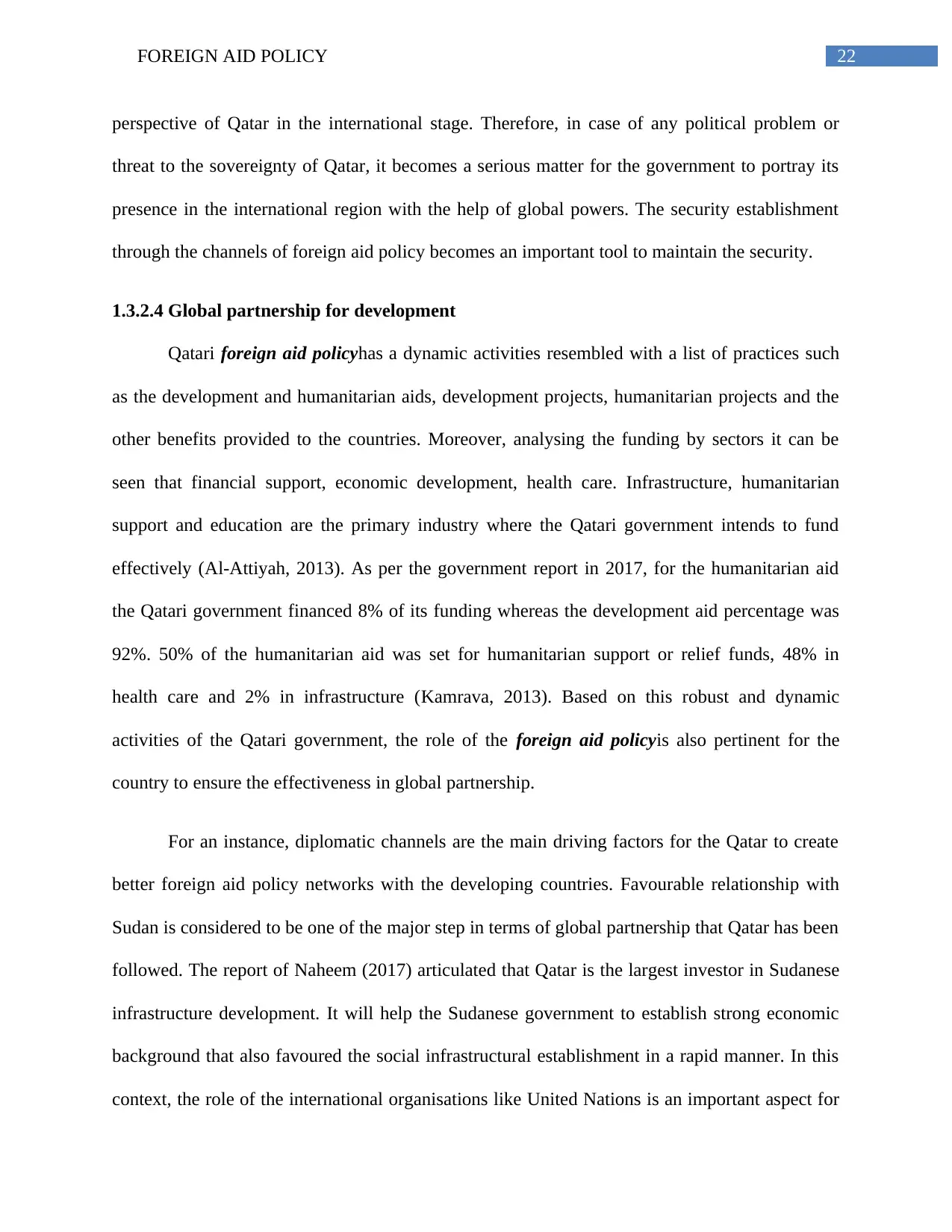
22FOREIGN AID POLICY
perspective of Qatar in the international stage. Therefore, in case of any political problem or
threat to the sovereignty of Qatar, it becomes a serious matter for the government to portray its
presence in the international region with the help of global powers. The security establishment
through the channels of foreign aid policy becomes an important tool to maintain the security.
1.3.2.4 Global partnership for development
Qatari foreign aid policyhas a dynamic activities resembled with a list of practices such
as the development and humanitarian aids, development projects, humanitarian projects and the
other benefits provided to the countries. Moreover, analysing the funding by sectors it can be
seen that financial support, economic development, health care. Infrastructure, humanitarian
support and education are the primary industry where the Qatari government intends to fund
effectively (Al-Attiyah, 2013). As per the government report in 2017, for the humanitarian aid
the Qatari government financed 8% of its funding whereas the development aid percentage was
92%. 50% of the humanitarian aid was set for humanitarian support or relief funds, 48% in
health care and 2% in infrastructure (Kamrava, 2013). Based on this robust and dynamic
activities of the Qatari government, the role of the foreign aid policyis also pertinent for the
country to ensure the effectiveness in global partnership.
For an instance, diplomatic channels are the main driving factors for the Qatar to create
better foreign aid policy networks with the developing countries. Favourable relationship with
Sudan is considered to be one of the major step in terms of global partnership that Qatar has been
followed. The report of Naheem (2017) articulated that Qatar is the largest investor in Sudanese
infrastructure development. It will help the Sudanese government to establish strong economic
background that also favoured the social infrastructural establishment in a rapid manner. In this
context, the role of the international organisations like United Nations is an important aspect for
perspective of Qatar in the international stage. Therefore, in case of any political problem or
threat to the sovereignty of Qatar, it becomes a serious matter for the government to portray its
presence in the international region with the help of global powers. The security establishment
through the channels of foreign aid policy becomes an important tool to maintain the security.
1.3.2.4 Global partnership for development
Qatari foreign aid policyhas a dynamic activities resembled with a list of practices such
as the development and humanitarian aids, development projects, humanitarian projects and the
other benefits provided to the countries. Moreover, analysing the funding by sectors it can be
seen that financial support, economic development, health care. Infrastructure, humanitarian
support and education are the primary industry where the Qatari government intends to fund
effectively (Al-Attiyah, 2013). As per the government report in 2017, for the humanitarian aid
the Qatari government financed 8% of its funding whereas the development aid percentage was
92%. 50% of the humanitarian aid was set for humanitarian support or relief funds, 48% in
health care and 2% in infrastructure (Kamrava, 2013). Based on this robust and dynamic
activities of the Qatari government, the role of the foreign aid policyis also pertinent for the
country to ensure the effectiveness in global partnership.
For an instance, diplomatic channels are the main driving factors for the Qatar to create
better foreign aid policy networks with the developing countries. Favourable relationship with
Sudan is considered to be one of the major step in terms of global partnership that Qatar has been
followed. The report of Naheem (2017) articulated that Qatar is the largest investor in Sudanese
infrastructure development. It will help the Sudanese government to establish strong economic
background that also favoured the social infrastructural establishment in a rapid manner. In this
context, the role of the international organisations like United Nations is an important aspect for
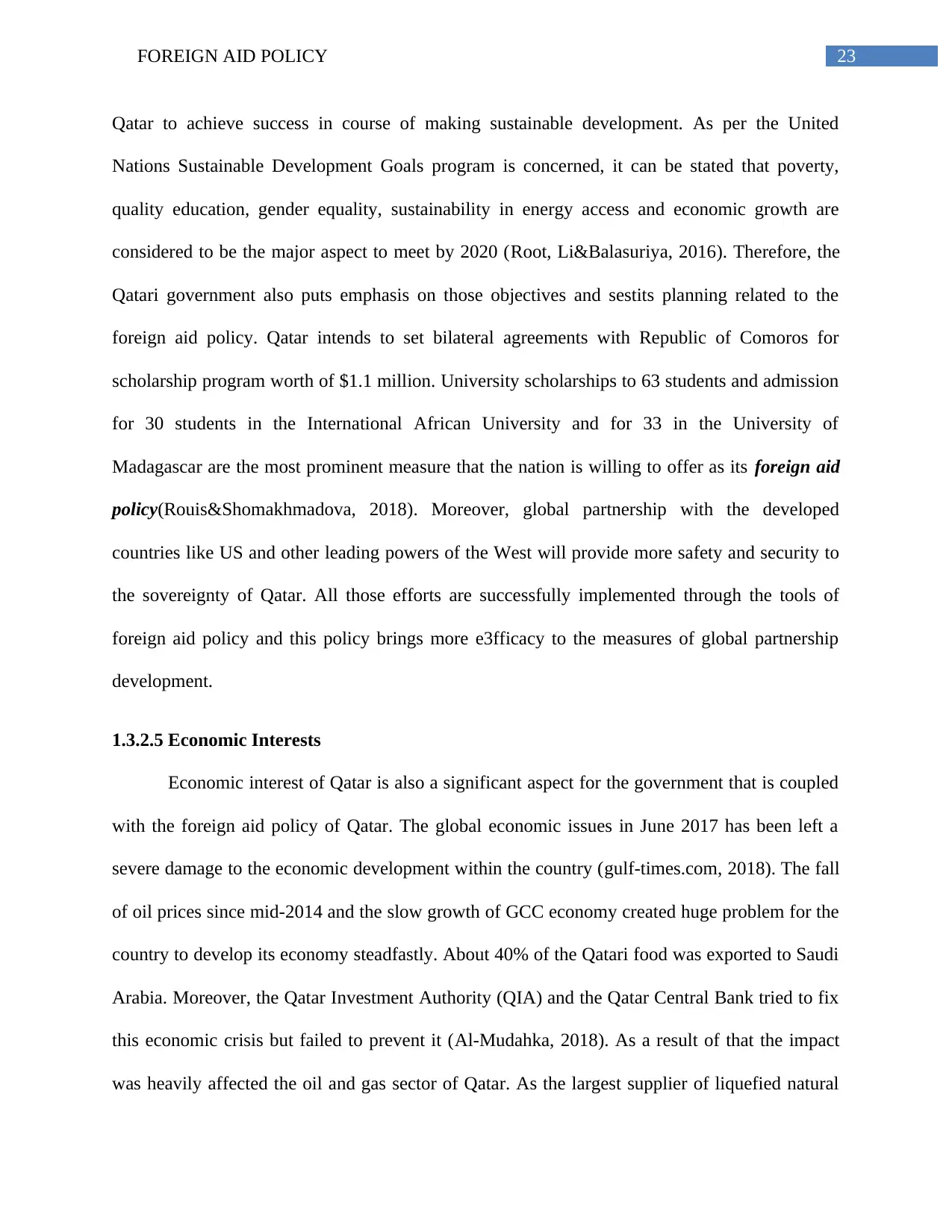
23FOREIGN AID POLICY
Qatar to achieve success in course of making sustainable development. As per the United
Nations Sustainable Development Goals program is concerned, it can be stated that poverty,
quality education, gender equality, sustainability in energy access and economic growth are
considered to be the major aspect to meet by 2020 (Root, Li&Balasuriya, 2016). Therefore, the
Qatari government also puts emphasis on those objectives and sestits planning related to the
foreign aid policy. Qatar intends to set bilateral agreements with Republic of Comoros for
scholarship program worth of $1.1 million. University scholarships to 63 students and admission
for 30 students in the International African University and for 33 in the University of
Madagascar are the most prominent measure that the nation is willing to offer as its foreign aid
policy(Rouis&Shomakhmadova, 2018). Moreover, global partnership with the developed
countries like US and other leading powers of the West will provide more safety and security to
the sovereignty of Qatar. All those efforts are successfully implemented through the tools of
foreign aid policy and this policy brings more e3fficacy to the measures of global partnership
development.
1.3.2.5 Economic Interests
Economic interest of Qatar is also a significant aspect for the government that is coupled
with the foreign aid policy of Qatar. The global economic issues in June 2017 has been left a
severe damage to the economic development within the country (gulf-times.com, 2018). The fall
of oil prices since mid-2014 and the slow growth of GCC economy created huge problem for the
country to develop its economy steadfastly. About 40% of the Qatari food was exported to Saudi
Arabia. Moreover, the Qatar Investment Authority (QIA) and the Qatar Central Bank tried to fix
this economic crisis but failed to prevent it (Al-Mudahka, 2018). As a result of that the impact
was heavily affected the oil and gas sector of Qatar. As the largest supplier of liquefied natural
Qatar to achieve success in course of making sustainable development. As per the United
Nations Sustainable Development Goals program is concerned, it can be stated that poverty,
quality education, gender equality, sustainability in energy access and economic growth are
considered to be the major aspect to meet by 2020 (Root, Li&Balasuriya, 2016). Therefore, the
Qatari government also puts emphasis on those objectives and sestits planning related to the
foreign aid policy. Qatar intends to set bilateral agreements with Republic of Comoros for
scholarship program worth of $1.1 million. University scholarships to 63 students and admission
for 30 students in the International African University and for 33 in the University of
Madagascar are the most prominent measure that the nation is willing to offer as its foreign aid
policy(Rouis&Shomakhmadova, 2018). Moreover, global partnership with the developed
countries like US and other leading powers of the West will provide more safety and security to
the sovereignty of Qatar. All those efforts are successfully implemented through the tools of
foreign aid policy and this policy brings more e3fficacy to the measures of global partnership
development.
1.3.2.5 Economic Interests
Economic interest of Qatar is also a significant aspect for the government that is coupled
with the foreign aid policy of Qatar. The global economic issues in June 2017 has been left a
severe damage to the economic development within the country (gulf-times.com, 2018). The fall
of oil prices since mid-2014 and the slow growth of GCC economy created huge problem for the
country to develop its economy steadfastly. About 40% of the Qatari food was exported to Saudi
Arabia. Moreover, the Qatar Investment Authority (QIA) and the Qatar Central Bank tried to fix
this economic crisis but failed to prevent it (Al-Mudahka, 2018). As a result of that the impact
was heavily affected the oil and gas sector of Qatar. As the largest supplier of liquefied natural
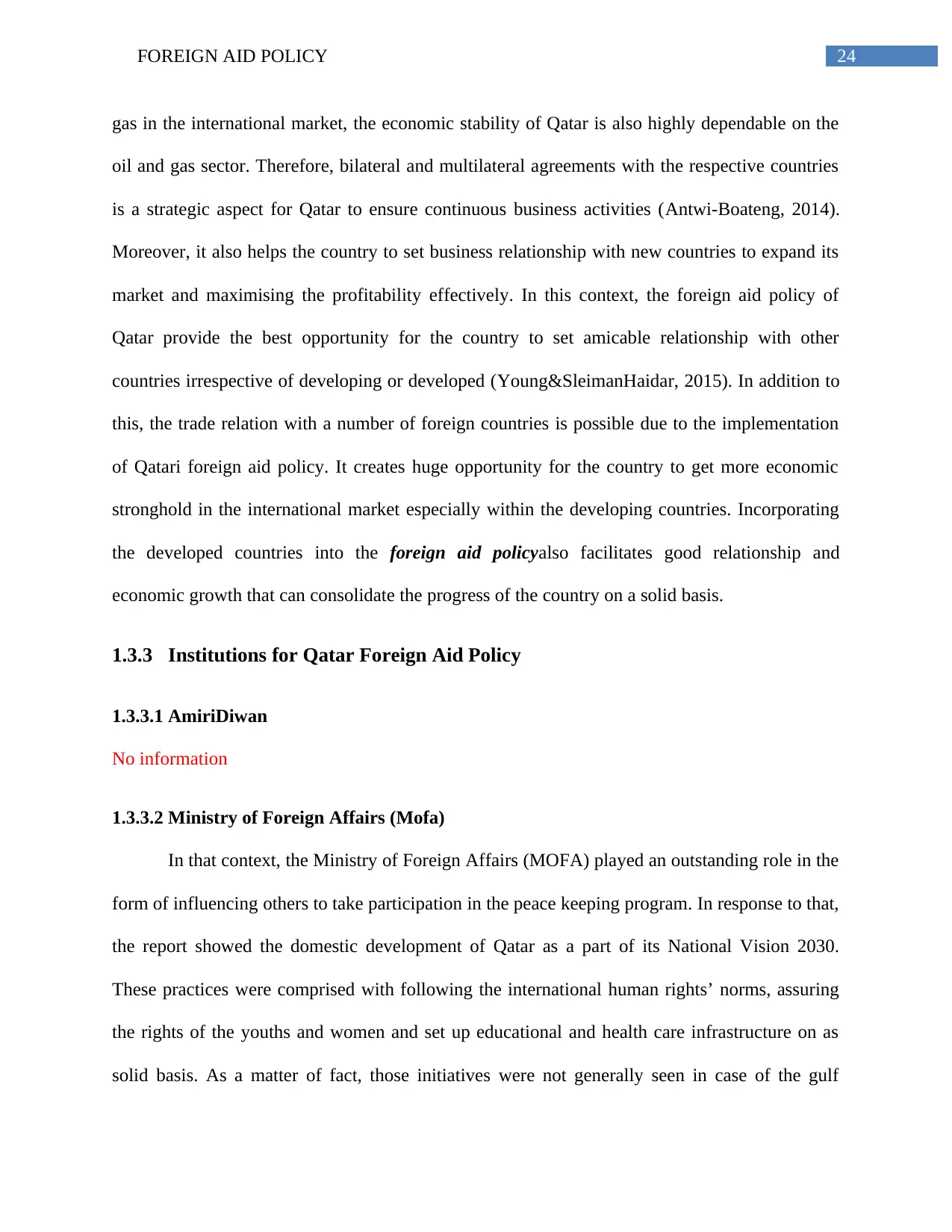
24FOREIGN AID POLICY
gas in the international market, the economic stability of Qatar is also highly dependable on the
oil and gas sector. Therefore, bilateral and multilateral agreements with the respective countries
is a strategic aspect for Qatar to ensure continuous business activities (Antwi-Boateng, 2014).
Moreover, it also helps the country to set business relationship with new countries to expand its
market and maximising the profitability effectively. In this context, the foreign aid policy of
Qatar provide the best opportunity for the country to set amicable relationship with other
countries irrespective of developing or developed (Young&SleimanHaidar, 2015). In addition to
this, the trade relation with a number of foreign countries is possible due to the implementation
of Qatari foreign aid policy. It creates huge opportunity for the country to get more economic
stronghold in the international market especially within the developing countries. Incorporating
the developed countries into the foreign aid policyalso facilitates good relationship and
economic growth that can consolidate the progress of the country on a solid basis.
1.3.3 Institutions for Qatar Foreign Aid Policy
1.3.3.1 AmiriDiwan
No information
1.3.3.2 Ministry of Foreign Affairs (Mofa)
In that context, the Ministry of Foreign Affairs (MOFA) played an outstanding role in the
form of influencing others to take participation in the peace keeping program. In response to that,
the report showed the domestic development of Qatar as a part of its National Vision 2030.
These practices were comprised with following the international human rights’ norms, assuring
the rights of the youths and women and set up educational and health care infrastructure on as
solid basis. As a matter of fact, those initiatives were not generally seen in case of the gulf
gas in the international market, the economic stability of Qatar is also highly dependable on the
oil and gas sector. Therefore, bilateral and multilateral agreements with the respective countries
is a strategic aspect for Qatar to ensure continuous business activities (Antwi-Boateng, 2014).
Moreover, it also helps the country to set business relationship with new countries to expand its
market and maximising the profitability effectively. In this context, the foreign aid policy of
Qatar provide the best opportunity for the country to set amicable relationship with other
countries irrespective of developing or developed (Young&SleimanHaidar, 2015). In addition to
this, the trade relation with a number of foreign countries is possible due to the implementation
of Qatari foreign aid policy. It creates huge opportunity for the country to get more economic
stronghold in the international market especially within the developing countries. Incorporating
the developed countries into the foreign aid policyalso facilitates good relationship and
economic growth that can consolidate the progress of the country on a solid basis.
1.3.3 Institutions for Qatar Foreign Aid Policy
1.3.3.1 AmiriDiwan
No information
1.3.3.2 Ministry of Foreign Affairs (Mofa)
In that context, the Ministry of Foreign Affairs (MOFA) played an outstanding role in the
form of influencing others to take participation in the peace keeping program. In response to that,
the report showed the domestic development of Qatar as a part of its National Vision 2030.
These practices were comprised with following the international human rights’ norms, assuring
the rights of the youths and women and set up educational and health care infrastructure on as
solid basis. As a matter of fact, those initiatives were not generally seen in case of the gulf
Paraphrase This Document
Need a fresh take? Get an instant paraphrase of this document with our AI Paraphraser
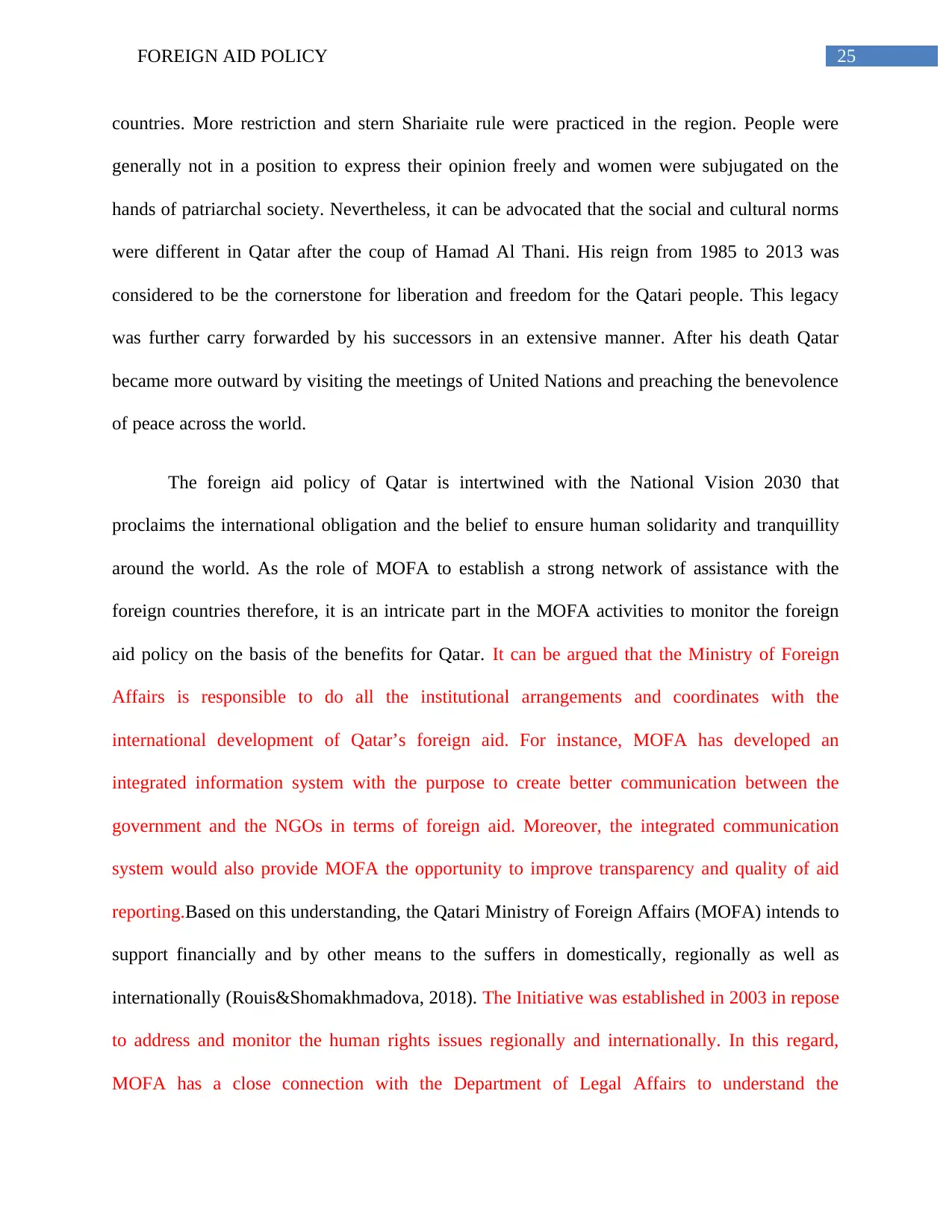
25FOREIGN AID POLICY
countries. More restriction and stern Shariaite rule were practiced in the region. People were
generally not in a position to express their opinion freely and women were subjugated on the
hands of patriarchal society. Nevertheless, it can be advocated that the social and cultural norms
were different in Qatar after the coup of Hamad Al Thani. His reign from 1985 to 2013 was
considered to be the cornerstone for liberation and freedom for the Qatari people. This legacy
was further carry forwarded by his successors in an extensive manner. After his death Qatar
became more outward by visiting the meetings of United Nations and preaching the benevolence
of peace across the world.
The foreign aid policy of Qatar is intertwined with the National Vision 2030 that
proclaims the international obligation and the belief to ensure human solidarity and tranquillity
around the world. As the role of MOFA to establish a strong network of assistance with the
foreign countries therefore, it is an intricate part in the MOFA activities to monitor the foreign
aid policy on the basis of the benefits for Qatar. It can be argued that the Ministry of Foreign
Affairs is responsible to do all the institutional arrangements and coordinates with the
international development of Qatar’s foreign aid. For instance, MOFA has developed an
integrated information system with the purpose to create better communication between the
government and the NGOs in terms of foreign aid. Moreover, the integrated communication
system would also provide MOFA the opportunity to improve transparency and quality of aid
reporting.Based on this understanding, the Qatari Ministry of Foreign Affairs (MOFA) intends to
support financially and by other means to the suffers in domestically, regionally as well as
internationally (Rouis&Shomakhmadova, 2018). The Initiative was established in 2003 in repose
to address and monitor the human rights issues regionally and internationally. In this regard,
MOFA has a close connection with the Department of Legal Affairs to understand the
countries. More restriction and stern Shariaite rule were practiced in the region. People were
generally not in a position to express their opinion freely and women were subjugated on the
hands of patriarchal society. Nevertheless, it can be advocated that the social and cultural norms
were different in Qatar after the coup of Hamad Al Thani. His reign from 1985 to 2013 was
considered to be the cornerstone for liberation and freedom for the Qatari people. This legacy
was further carry forwarded by his successors in an extensive manner. After his death Qatar
became more outward by visiting the meetings of United Nations and preaching the benevolence
of peace across the world.
The foreign aid policy of Qatar is intertwined with the National Vision 2030 that
proclaims the international obligation and the belief to ensure human solidarity and tranquillity
around the world. As the role of MOFA to establish a strong network of assistance with the
foreign countries therefore, it is an intricate part in the MOFA activities to monitor the foreign
aid policy on the basis of the benefits for Qatar. It can be argued that the Ministry of Foreign
Affairs is responsible to do all the institutional arrangements and coordinates with the
international development of Qatar’s foreign aid. For instance, MOFA has developed an
integrated information system with the purpose to create better communication between the
government and the NGOs in terms of foreign aid. Moreover, the integrated communication
system would also provide MOFA the opportunity to improve transparency and quality of aid
reporting.Based on this understanding, the Qatari Ministry of Foreign Affairs (MOFA) intends to
support financially and by other means to the suffers in domestically, regionally as well as
internationally (Rouis&Shomakhmadova, 2018). The Initiative was established in 2003 in repose
to address and monitor the human rights issues regionally and internationally. In this regard,
MOFA has a close connection with the Department of Legal Affairs to understand the
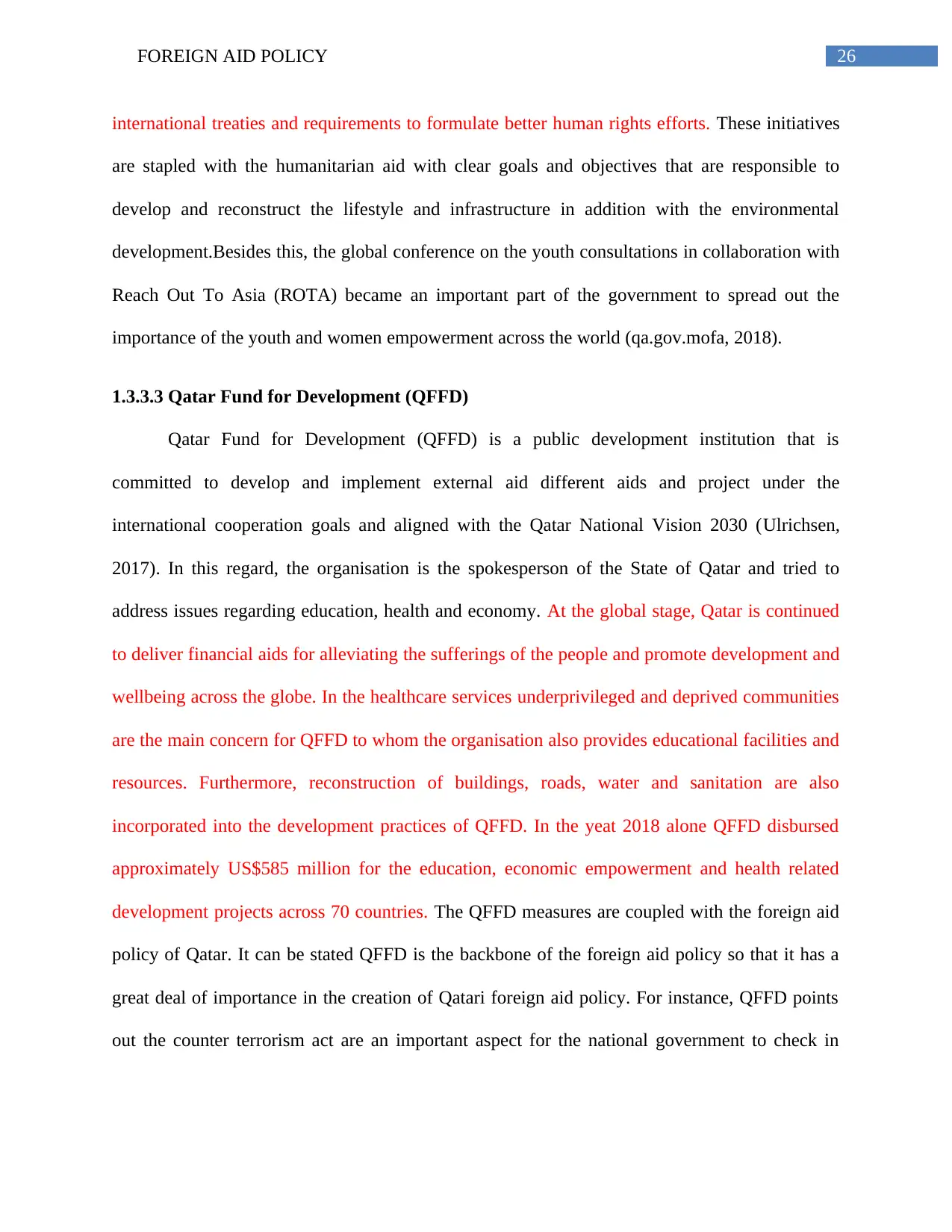
26FOREIGN AID POLICY
international treaties and requirements to formulate better human rights efforts. These initiatives
are stapled with the humanitarian aid with clear goals and objectives that are responsible to
develop and reconstruct the lifestyle and infrastructure in addition with the environmental
development.Besides this, the global conference on the youth consultations in collaboration with
Reach Out To Asia (ROTA) became an important part of the government to spread out the
importance of the youth and women empowerment across the world (qa.gov.mofa, 2018).
1.3.3.3 Qatar Fund for Development (QFFD)
Qatar Fund for Development (QFFD) is a public development institution that is
committed to develop and implement external aid different aids and project under the
international cooperation goals and aligned with the Qatar National Vision 2030 (Ulrichsen,
2017). In this regard, the organisation is the spokesperson of the State of Qatar and tried to
address issues regarding education, health and economy. At the global stage, Qatar is continued
to deliver financial aids for alleviating the sufferings of the people and promote development and
wellbeing across the globe. In the healthcare services underprivileged and deprived communities
are the main concern for QFFD to whom the organisation also provides educational facilities and
resources. Furthermore, reconstruction of buildings, roads, water and sanitation are also
incorporated into the development practices of QFFD. In the yeat 2018 alone QFFD disbursed
approximately US$585 million for the education, economic empowerment and health related
development projects across 70 countries. The QFFD measures are coupled with the foreign aid
policy of Qatar. It can be stated QFFD is the backbone of the foreign aid policy so that it has a
great deal of importance in the creation of Qatari foreign aid policy. For instance, QFFD points
out the counter terrorism act are an important aspect for the national government to check in
international treaties and requirements to formulate better human rights efforts. These initiatives
are stapled with the humanitarian aid with clear goals and objectives that are responsible to
develop and reconstruct the lifestyle and infrastructure in addition with the environmental
development.Besides this, the global conference on the youth consultations in collaboration with
Reach Out To Asia (ROTA) became an important part of the government to spread out the
importance of the youth and women empowerment across the world (qa.gov.mofa, 2018).
1.3.3.3 Qatar Fund for Development (QFFD)
Qatar Fund for Development (QFFD) is a public development institution that is
committed to develop and implement external aid different aids and project under the
international cooperation goals and aligned with the Qatar National Vision 2030 (Ulrichsen,
2017). In this regard, the organisation is the spokesperson of the State of Qatar and tried to
address issues regarding education, health and economy. At the global stage, Qatar is continued
to deliver financial aids for alleviating the sufferings of the people and promote development and
wellbeing across the globe. In the healthcare services underprivileged and deprived communities
are the main concern for QFFD to whom the organisation also provides educational facilities and
resources. Furthermore, reconstruction of buildings, roads, water and sanitation are also
incorporated into the development practices of QFFD. In the yeat 2018 alone QFFD disbursed
approximately US$585 million for the education, economic empowerment and health related
development projects across 70 countries. The QFFD measures are coupled with the foreign aid
policy of Qatar. It can be stated QFFD is the backbone of the foreign aid policy so that it has a
great deal of importance in the creation of Qatari foreign aid policy. For instance, QFFD points
out the counter terrorism act are an important aspect for the national government to check in
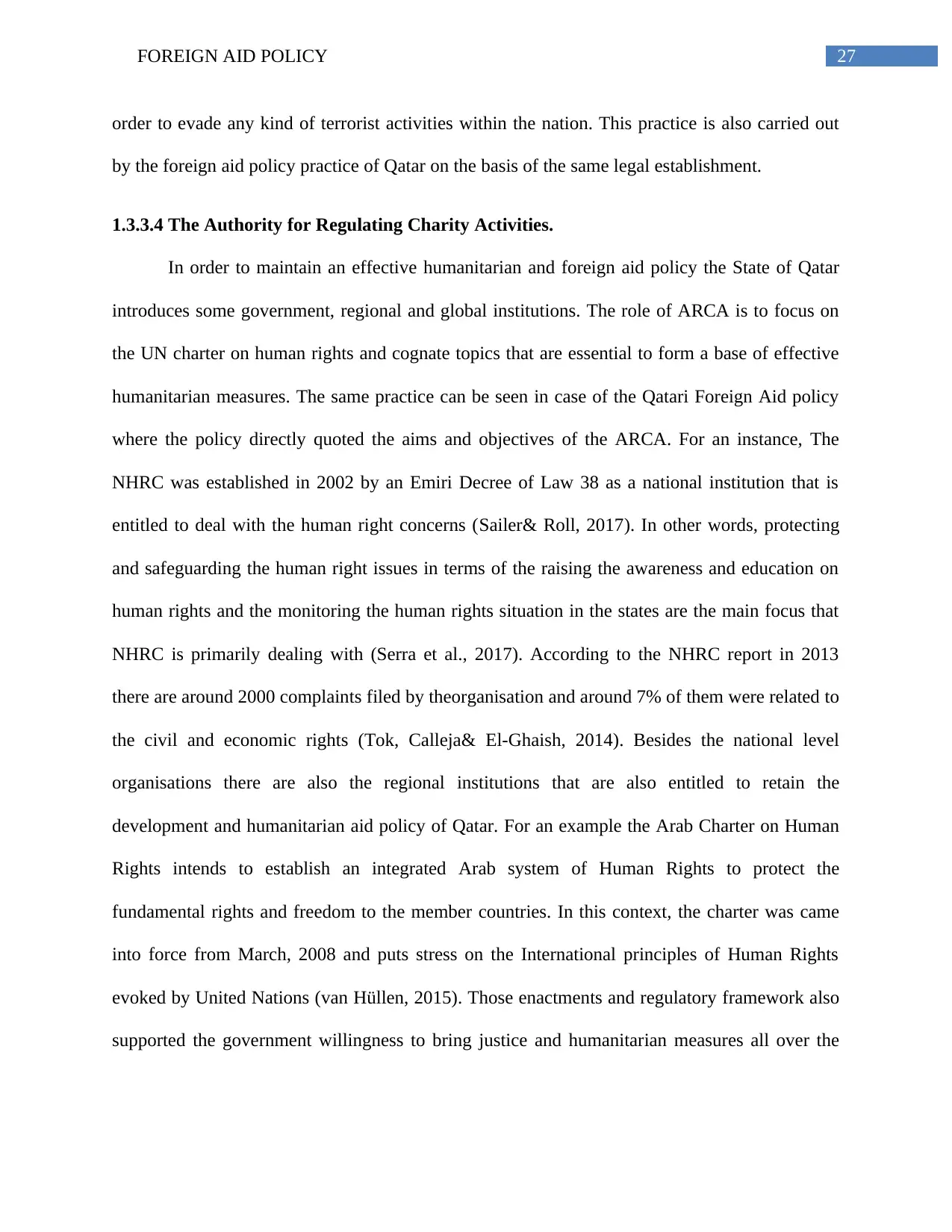
27FOREIGN AID POLICY
order to evade any kind of terrorist activities within the nation. This practice is also carried out
by the foreign aid policy practice of Qatar on the basis of the same legal establishment.
1.3.3.4 The Authority for Regulating Charity Activities.
In order to maintain an effective humanitarian and foreign aid policy the State of Qatar
introduces some government, regional and global institutions. The role of ARCA is to focus on
the UN charter on human rights and cognate topics that are essential to form a base of effective
humanitarian measures. The same practice can be seen in case of the Qatari Foreign Aid policy
where the policy directly quoted the aims and objectives of the ARCA. For an instance, The
NHRC was established in 2002 by an Emiri Decree of Law 38 as a national institution that is
entitled to deal with the human right concerns (Sailer& Roll, 2017). In other words, protecting
and safeguarding the human right issues in terms of the raising the awareness and education on
human rights and the monitoring the human rights situation in the states are the main focus that
NHRC is primarily dealing with (Serra et al., 2017). According to the NHRC report in 2013
there are around 2000 complaints filed by theorganisation and around 7% of them were related to
the civil and economic rights (Tok, Calleja& El-Ghaish, 2014). Besides the national level
organisations there are also the regional institutions that are also entitled to retain the
development and humanitarian aid policy of Qatar. For an example the Arab Charter on Human
Rights intends to establish an integrated Arab system of Human Rights to protect the
fundamental rights and freedom to the member countries. In this context, the charter was came
into force from March, 2008 and puts stress on the International principles of Human Rights
evoked by United Nations (van Hüllen, 2015). Those enactments and regulatory framework also
supported the government willingness to bring justice and humanitarian measures all over the
order to evade any kind of terrorist activities within the nation. This practice is also carried out
by the foreign aid policy practice of Qatar on the basis of the same legal establishment.
1.3.3.4 The Authority for Regulating Charity Activities.
In order to maintain an effective humanitarian and foreign aid policy the State of Qatar
introduces some government, regional and global institutions. The role of ARCA is to focus on
the UN charter on human rights and cognate topics that are essential to form a base of effective
humanitarian measures. The same practice can be seen in case of the Qatari Foreign Aid policy
where the policy directly quoted the aims and objectives of the ARCA. For an instance, The
NHRC was established in 2002 by an Emiri Decree of Law 38 as a national institution that is
entitled to deal with the human right concerns (Sailer& Roll, 2017). In other words, protecting
and safeguarding the human right issues in terms of the raising the awareness and education on
human rights and the monitoring the human rights situation in the states are the main focus that
NHRC is primarily dealing with (Serra et al., 2017). According to the NHRC report in 2013
there are around 2000 complaints filed by theorganisation and around 7% of them were related to
the civil and economic rights (Tok, Calleja& El-Ghaish, 2014). Besides the national level
organisations there are also the regional institutions that are also entitled to retain the
development and humanitarian aid policy of Qatar. For an example the Arab Charter on Human
Rights intends to establish an integrated Arab system of Human Rights to protect the
fundamental rights and freedom to the member countries. In this context, the charter was came
into force from March, 2008 and puts stress on the International principles of Human Rights
evoked by United Nations (van Hüllen, 2015). Those enactments and regulatory framework also
supported the government willingness to bring justice and humanitarian measures all over the
Secure Best Marks with AI Grader
Need help grading? Try our AI Grader for instant feedback on your assignments.
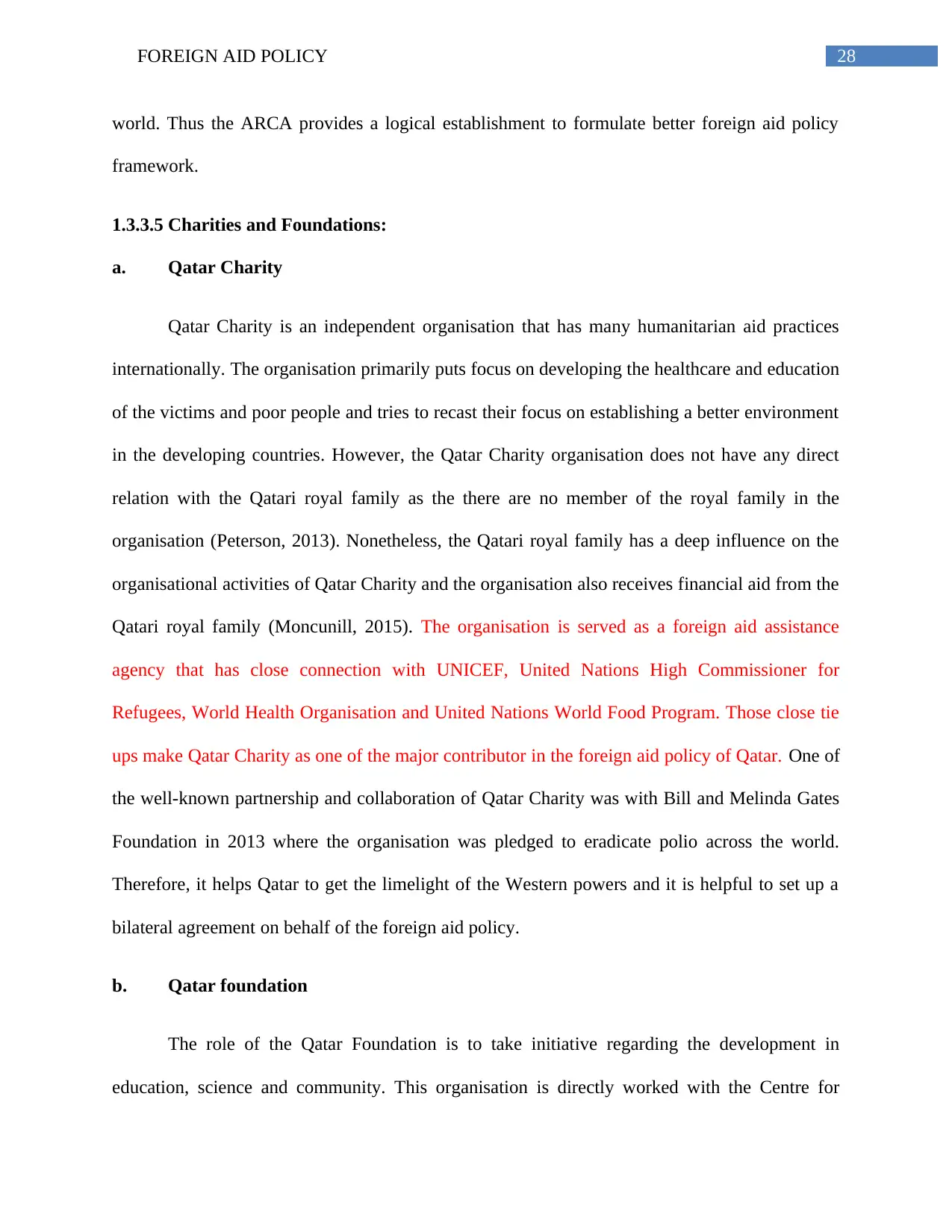
28FOREIGN AID POLICY
world. Thus the ARCA provides a logical establishment to formulate better foreign aid policy
framework.
1.3.3.5 Charities and Foundations:
a. Qatar Charity
Qatar Charity is an independent organisation that has many humanitarian aid practices
internationally. The organisation primarily puts focus on developing the healthcare and education
of the victims and poor people and tries to recast their focus on establishing a better environment
in the developing countries. However, the Qatar Charity organisation does not have any direct
relation with the Qatari royal family as the there are no member of the royal family in the
organisation (Peterson, 2013). Nonetheless, the Qatari royal family has a deep influence on the
organisational activities of Qatar Charity and the organisation also receives financial aid from the
Qatari royal family (Moncunill, 2015). The organisation is served as a foreign aid assistance
agency that has close connection with UNICEF, United Nations High Commissioner for
Refugees, World Health Organisation and United Nations World Food Program. Those close tie
ups make Qatar Charity as one of the major contributor in the foreign aid policy of Qatar. One of
the well-known partnership and collaboration of Qatar Charity was with Bill and Melinda Gates
Foundation in 2013 where the organisation was pledged to eradicate polio across the world.
Therefore, it helps Qatar to get the limelight of the Western powers and it is helpful to set up a
bilateral agreement on behalf of the foreign aid policy.
b. Qatar foundation
The role of the Qatar Foundation is to take initiative regarding the development in
education, science and community. This organisation is directly worked with the Centre for
world. Thus the ARCA provides a logical establishment to formulate better foreign aid policy
framework.
1.3.3.5 Charities and Foundations:
a. Qatar Charity
Qatar Charity is an independent organisation that has many humanitarian aid practices
internationally. The organisation primarily puts focus on developing the healthcare and education
of the victims and poor people and tries to recast their focus on establishing a better environment
in the developing countries. However, the Qatar Charity organisation does not have any direct
relation with the Qatari royal family as the there are no member of the royal family in the
organisation (Peterson, 2013). Nonetheless, the Qatari royal family has a deep influence on the
organisational activities of Qatar Charity and the organisation also receives financial aid from the
Qatari royal family (Moncunill, 2015). The organisation is served as a foreign aid assistance
agency that has close connection with UNICEF, United Nations High Commissioner for
Refugees, World Health Organisation and United Nations World Food Program. Those close tie
ups make Qatar Charity as one of the major contributor in the foreign aid policy of Qatar. One of
the well-known partnership and collaboration of Qatar Charity was with Bill and Melinda Gates
Foundation in 2013 where the organisation was pledged to eradicate polio across the world.
Therefore, it helps Qatar to get the limelight of the Western powers and it is helpful to set up a
bilateral agreement on behalf of the foreign aid policy.
b. Qatar foundation
The role of the Qatar Foundation is to take initiative regarding the development in
education, science and community. This organisation is directly worked with the Centre for
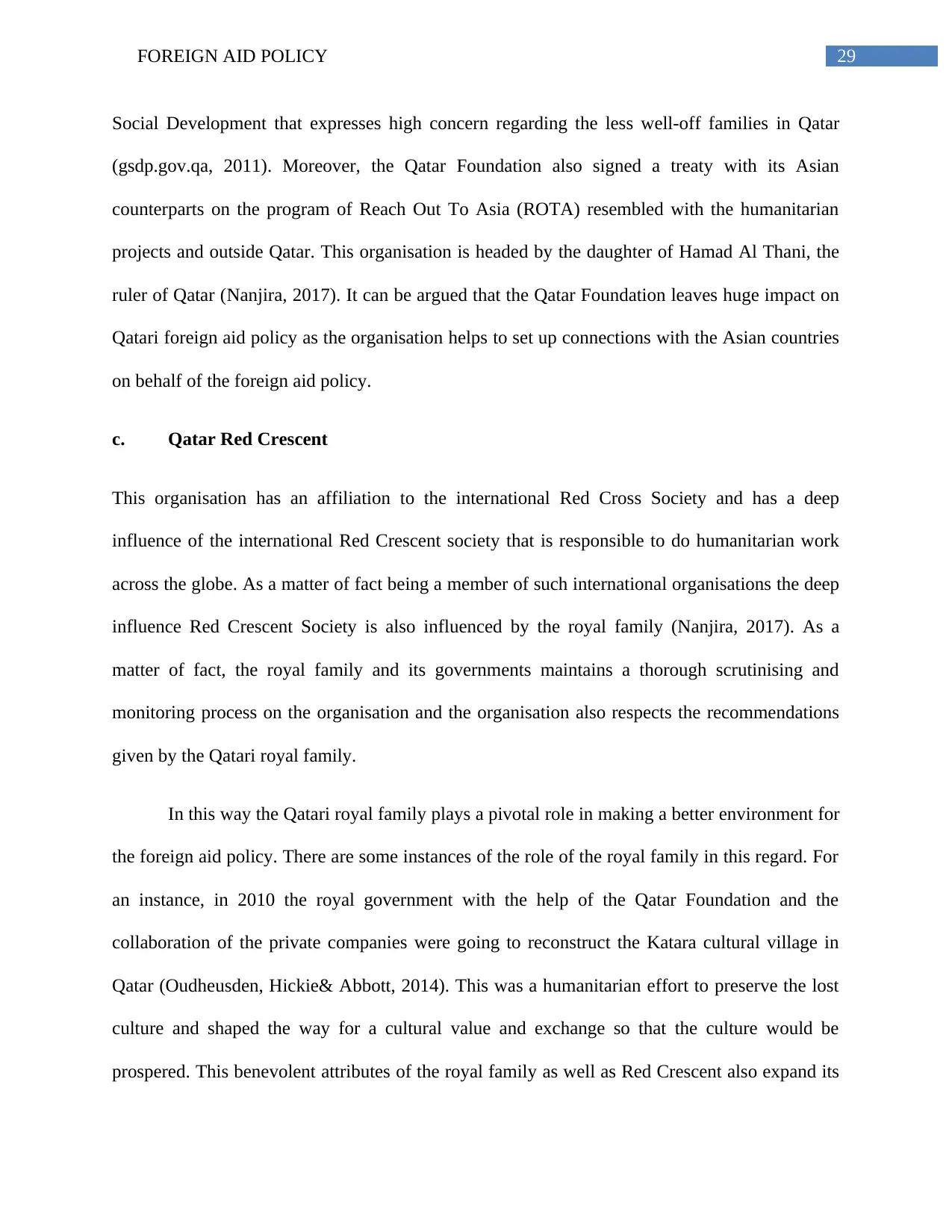
29FOREIGN AID POLICY
Social Development that expresses high concern regarding the less well-off families in Qatar
(gsdp.gov.qa, 2011). Moreover, the Qatar Foundation also signed a treaty with its Asian
counterparts on the program of Reach Out To Asia (ROTA) resembled with the humanitarian
projects and outside Qatar. This organisation is headed by the daughter of Hamad Al Thani, the
ruler of Qatar (Nanjira, 2017). It can be argued that the Qatar Foundation leaves huge impact on
Qatari foreign aid policy as the organisation helps to set up connections with the Asian countries
on behalf of the foreign aid policy.
c. Qatar Red Crescent
This organisation has an affiliation to the international Red Cross Society and has a deep
influence of the international Red Crescent society that is responsible to do humanitarian work
across the globe. As a matter of fact being a member of such international organisations the deep
influence Red Crescent Society is also influenced by the royal family (Nanjira, 2017). As a
matter of fact, the royal family and its governments maintains a thorough scrutinising and
monitoring process on the organisation and the organisation also respects the recommendations
given by the Qatari royal family.
In this way the Qatari royal family plays a pivotal role in making a better environment for
the foreign aid policy. There are some instances of the role of the royal family in this regard. For
an instance, in 2010 the royal government with the help of the Qatar Foundation and the
collaboration of the private companies were going to reconstruct the Katara cultural village in
Qatar (Oudheusden, Hickie& Abbott, 2014). This was a humanitarian effort to preserve the lost
culture and shaped the way for a cultural value and exchange so that the culture would be
prospered. This benevolent attributes of the royal family as well as Red Crescent also expand its
Social Development that expresses high concern regarding the less well-off families in Qatar
(gsdp.gov.qa, 2011). Moreover, the Qatar Foundation also signed a treaty with its Asian
counterparts on the program of Reach Out To Asia (ROTA) resembled with the humanitarian
projects and outside Qatar. This organisation is headed by the daughter of Hamad Al Thani, the
ruler of Qatar (Nanjira, 2017). It can be argued that the Qatar Foundation leaves huge impact on
Qatari foreign aid policy as the organisation helps to set up connections with the Asian countries
on behalf of the foreign aid policy.
c. Qatar Red Crescent
This organisation has an affiliation to the international Red Cross Society and has a deep
influence of the international Red Crescent society that is responsible to do humanitarian work
across the globe. As a matter of fact being a member of such international organisations the deep
influence Red Crescent Society is also influenced by the royal family (Nanjira, 2017). As a
matter of fact, the royal family and its governments maintains a thorough scrutinising and
monitoring process on the organisation and the organisation also respects the recommendations
given by the Qatari royal family.
In this way the Qatari royal family plays a pivotal role in making a better environment for
the foreign aid policy. There are some instances of the role of the royal family in this regard. For
an instance, in 2010 the royal government with the help of the Qatar Foundation and the
collaboration of the private companies were going to reconstruct the Katara cultural village in
Qatar (Oudheusden, Hickie& Abbott, 2014). This was a humanitarian effort to preserve the lost
culture and shaped the way for a cultural value and exchange so that the culture would be
prospered. This benevolent attributes of the royal family as well as Red Crescent also expand its
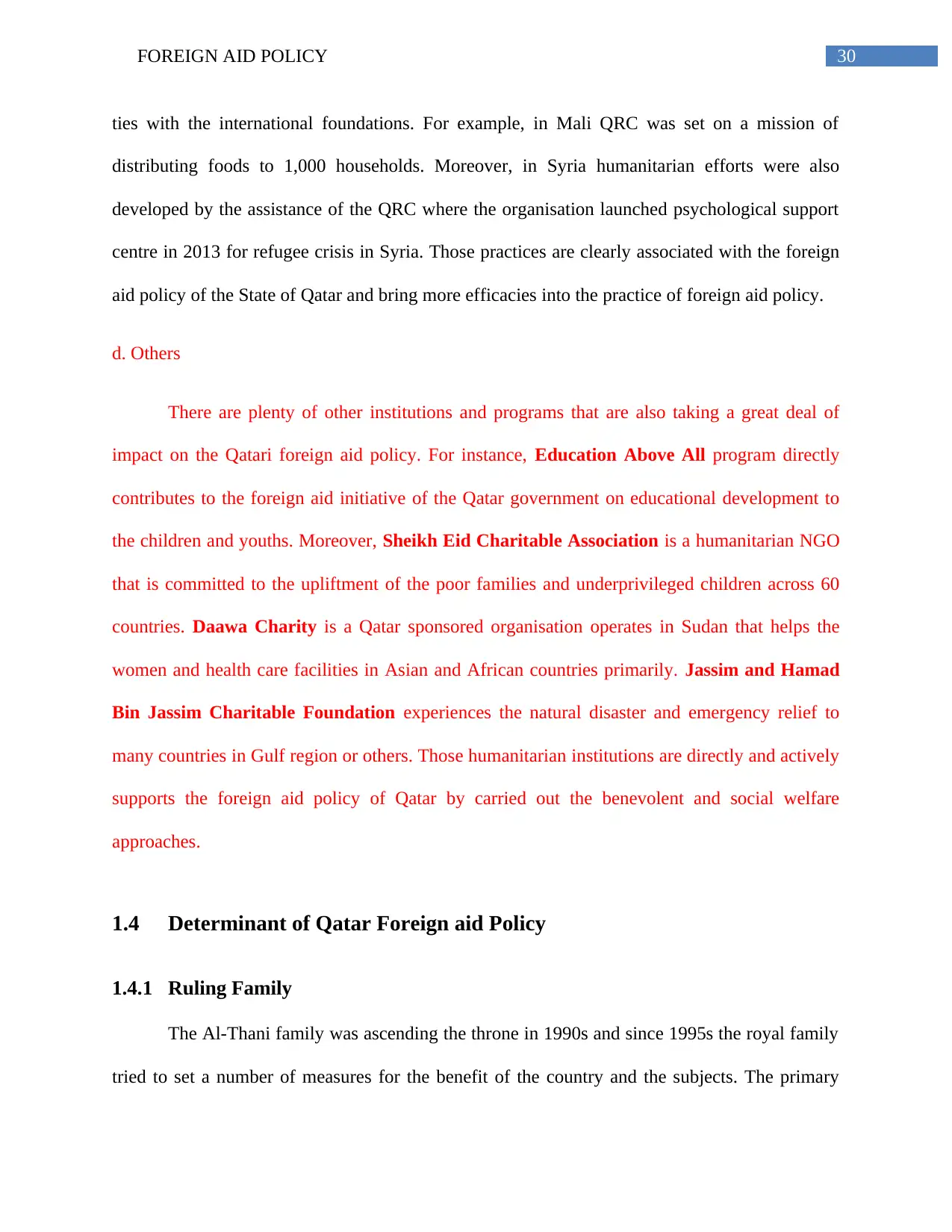
30FOREIGN AID POLICY
ties with the international foundations. For example, in Mali QRC was set on a mission of
distributing foods to 1,000 households. Moreover, in Syria humanitarian efforts were also
developed by the assistance of the QRC where the organisation launched psychological support
centre in 2013 for refugee crisis in Syria. Those practices are clearly associated with the foreign
aid policy of the State of Qatar and bring more efficacies into the practice of foreign aid policy.
d. Others
There are plenty of other institutions and programs that are also taking a great deal of
impact on the Qatari foreign aid policy. For instance, Education Above All program directly
contributes to the foreign aid initiative of the Qatar government on educational development to
the children and youths. Moreover, Sheikh Eid Charitable Association is a humanitarian NGO
that is committed to the upliftment of the poor families and underprivileged children across 60
countries. Daawa Charity is a Qatar sponsored organisation operates in Sudan that helps the
women and health care facilities in Asian and African countries primarily. Jassim and Hamad
Bin Jassim Charitable Foundation experiences the natural disaster and emergency relief to
many countries in Gulf region or others. Those humanitarian institutions are directly and actively
supports the foreign aid policy of Qatar by carried out the benevolent and social welfare
approaches.
1.4 Determinant of Qatar Foreign aid Policy
1.4.1 Ruling Family
The Al-Thani family was ascending the throne in 1990s and since 1995s the royal family
tried to set a number of measures for the benefit of the country and the subjects. The primary
ties with the international foundations. For example, in Mali QRC was set on a mission of
distributing foods to 1,000 households. Moreover, in Syria humanitarian efforts were also
developed by the assistance of the QRC where the organisation launched psychological support
centre in 2013 for refugee crisis in Syria. Those practices are clearly associated with the foreign
aid policy of the State of Qatar and bring more efficacies into the practice of foreign aid policy.
d. Others
There are plenty of other institutions and programs that are also taking a great deal of
impact on the Qatari foreign aid policy. For instance, Education Above All program directly
contributes to the foreign aid initiative of the Qatar government on educational development to
the children and youths. Moreover, Sheikh Eid Charitable Association is a humanitarian NGO
that is committed to the upliftment of the poor families and underprivileged children across 60
countries. Daawa Charity is a Qatar sponsored organisation operates in Sudan that helps the
women and health care facilities in Asian and African countries primarily. Jassim and Hamad
Bin Jassim Charitable Foundation experiences the natural disaster and emergency relief to
many countries in Gulf region or others. Those humanitarian institutions are directly and actively
supports the foreign aid policy of Qatar by carried out the benevolent and social welfare
approaches.
1.4 Determinant of Qatar Foreign aid Policy
1.4.1 Ruling Family
The Al-Thani family was ascending the throne in 1990s and since 1995s the royal family
tried to set a number of measures for the benefit of the country and the subjects. The primary
Paraphrase This Document
Need a fresh take? Get an instant paraphrase of this document with our AI Paraphraser
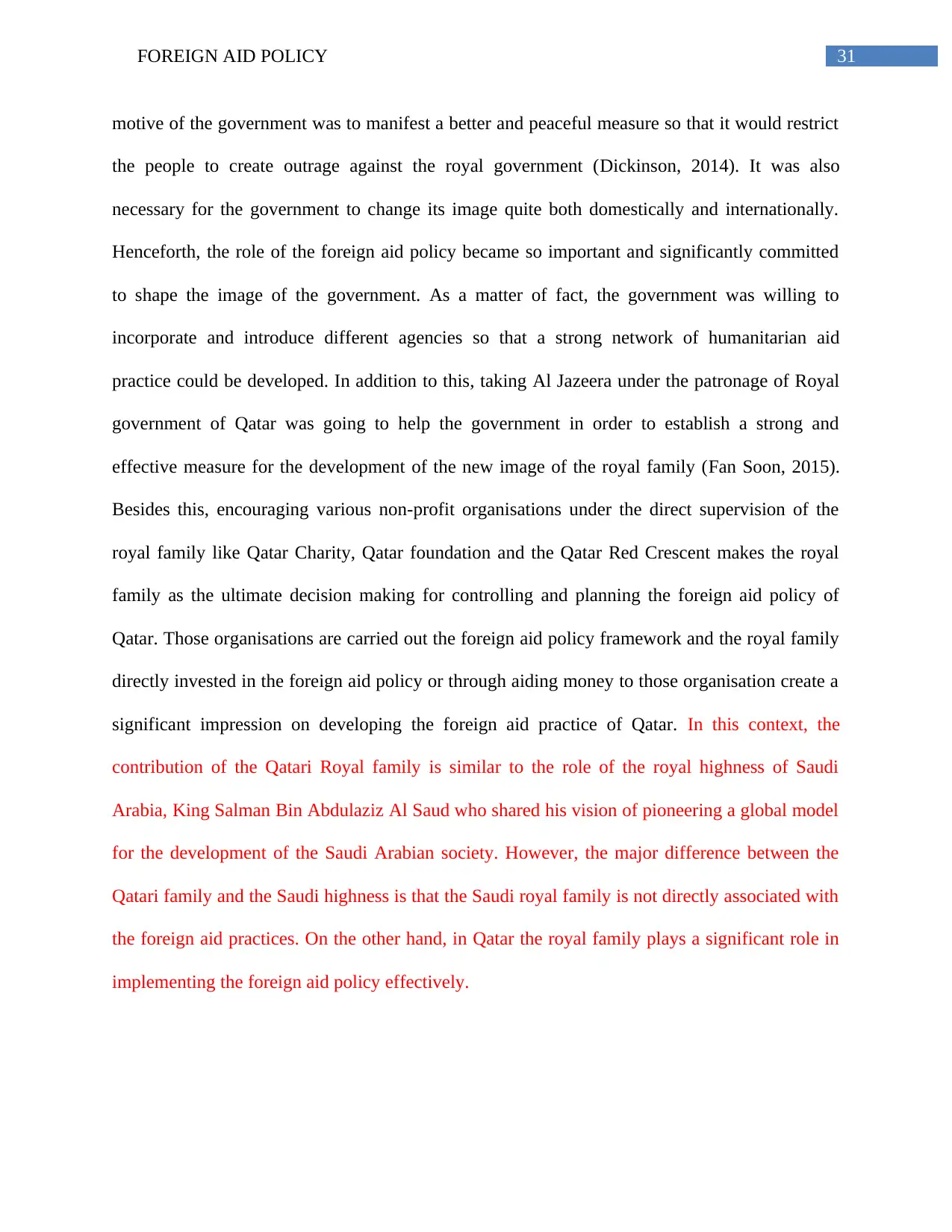
31FOREIGN AID POLICY
motive of the government was to manifest a better and peaceful measure so that it would restrict
the people to create outrage against the royal government (Dickinson, 2014). It was also
necessary for the government to change its image quite both domestically and internationally.
Henceforth, the role of the foreign aid policy became so important and significantly committed
to shape the image of the government. As a matter of fact, the government was willing to
incorporate and introduce different agencies so that a strong network of humanitarian aid
practice could be developed. In addition to this, taking Al Jazeera under the patronage of Royal
government of Qatar was going to help the government in order to establish a strong and
effective measure for the development of the new image of the royal family (Fan Soon, 2015).
Besides this, encouraging various non-profit organisations under the direct supervision of the
royal family like Qatar Charity, Qatar foundation and the Qatar Red Crescent makes the royal
family as the ultimate decision making for controlling and planning the foreign aid policy of
Qatar. Those organisations are carried out the foreign aid policy framework and the royal family
directly invested in the foreign aid policy or through aiding money to those organisation create a
significant impression on developing the foreign aid practice of Qatar. In this context, the
contribution of the Qatari Royal family is similar to the role of the royal highness of Saudi
Arabia, King Salman Bin Abdulaziz Al Saud who shared his vision of pioneering a global model
for the development of the Saudi Arabian society. However, the major difference between the
Qatari family and the Saudi highness is that the Saudi royal family is not directly associated with
the foreign aid practices. On the other hand, in Qatar the royal family plays a significant role in
implementing the foreign aid policy effectively.
motive of the government was to manifest a better and peaceful measure so that it would restrict
the people to create outrage against the royal government (Dickinson, 2014). It was also
necessary for the government to change its image quite both domestically and internationally.
Henceforth, the role of the foreign aid policy became so important and significantly committed
to shape the image of the government. As a matter of fact, the government was willing to
incorporate and introduce different agencies so that a strong network of humanitarian aid
practice could be developed. In addition to this, taking Al Jazeera under the patronage of Royal
government of Qatar was going to help the government in order to establish a strong and
effective measure for the development of the new image of the royal family (Fan Soon, 2015).
Besides this, encouraging various non-profit organisations under the direct supervision of the
royal family like Qatar Charity, Qatar foundation and the Qatar Red Crescent makes the royal
family as the ultimate decision making for controlling and planning the foreign aid policy of
Qatar. Those organisations are carried out the foreign aid policy framework and the royal family
directly invested in the foreign aid policy or through aiding money to those organisation create a
significant impression on developing the foreign aid practice of Qatar. In this context, the
contribution of the Qatari Royal family is similar to the role of the royal highness of Saudi
Arabia, King Salman Bin Abdulaziz Al Saud who shared his vision of pioneering a global model
for the development of the Saudi Arabian society. However, the major difference between the
Qatari family and the Saudi highness is that the Saudi royal family is not directly associated with
the foreign aid practices. On the other hand, in Qatar the royal family plays a significant role in
implementing the foreign aid policy effectively.
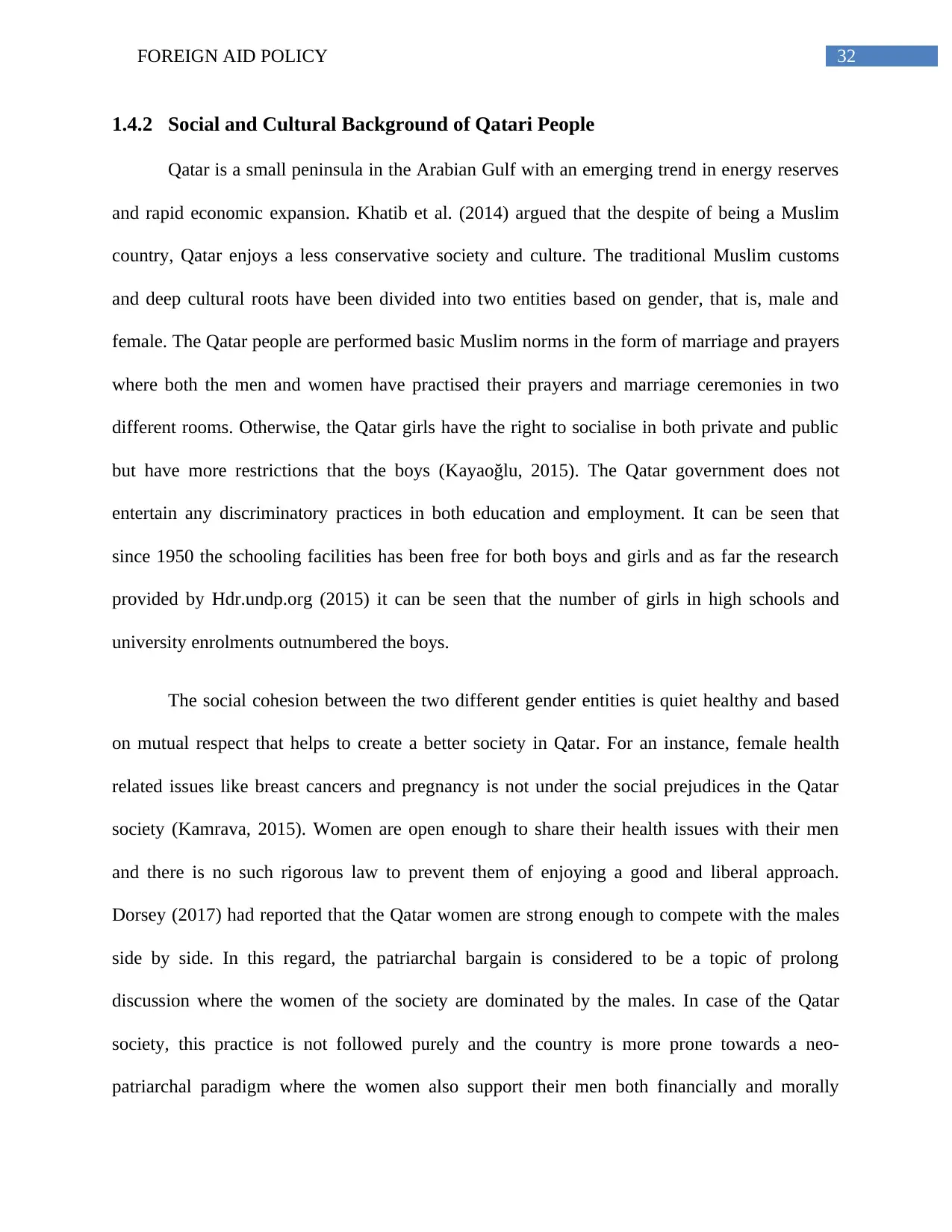
32FOREIGN AID POLICY
1.4.2 Social and Cultural Background of Qatari People
Qatar is a small peninsula in the Arabian Gulf with an emerging trend in energy reserves
and rapid economic expansion. Khatib et al. (2014) argued that the despite of being a Muslim
country, Qatar enjoys a less conservative society and culture. The traditional Muslim customs
and deep cultural roots have been divided into two entities based on gender, that is, male and
female. The Qatar people are performed basic Muslim norms in the form of marriage and prayers
where both the men and women have practised their prayers and marriage ceremonies in two
different rooms. Otherwise, the Qatar girls have the right to socialise in both private and public
but have more restrictions that the boys (Kayaoğlu, 2015). The Qatar government does not
entertain any discriminatory practices in both education and employment. It can be seen that
since 1950 the schooling facilities has been free for both boys and girls and as far the research
provided by Hdr.undp.org (2015) it can be seen that the number of girls in high schools and
university enrolments outnumbered the boys.
The social cohesion between the two different gender entities is quiet healthy and based
on mutual respect that helps to create a better society in Qatar. For an instance, female health
related issues like breast cancers and pregnancy is not under the social prejudices in the Qatar
society (Kamrava, 2015). Women are open enough to share their health issues with their men
and there is no such rigorous law to prevent them of enjoying a good and liberal approach.
Dorsey (2017) had reported that the Qatar women are strong enough to compete with the males
side by side. In this regard, the patriarchal bargain is considered to be a topic of prolong
discussion where the women of the society are dominated by the males. In case of the Qatar
society, this practice is not followed purely and the country is more prone towards a neo-
patriarchal paradigm where the women also support their men both financially and morally
1.4.2 Social and Cultural Background of Qatari People
Qatar is a small peninsula in the Arabian Gulf with an emerging trend in energy reserves
and rapid economic expansion. Khatib et al. (2014) argued that the despite of being a Muslim
country, Qatar enjoys a less conservative society and culture. The traditional Muslim customs
and deep cultural roots have been divided into two entities based on gender, that is, male and
female. The Qatar people are performed basic Muslim norms in the form of marriage and prayers
where both the men and women have practised their prayers and marriage ceremonies in two
different rooms. Otherwise, the Qatar girls have the right to socialise in both private and public
but have more restrictions that the boys (Kayaoğlu, 2015). The Qatar government does not
entertain any discriminatory practices in both education and employment. It can be seen that
since 1950 the schooling facilities has been free for both boys and girls and as far the research
provided by Hdr.undp.org (2015) it can be seen that the number of girls in high schools and
university enrolments outnumbered the boys.
The social cohesion between the two different gender entities is quiet healthy and based
on mutual respect that helps to create a better society in Qatar. For an instance, female health
related issues like breast cancers and pregnancy is not under the social prejudices in the Qatar
society (Kamrava, 2015). Women are open enough to share their health issues with their men
and there is no such rigorous law to prevent them of enjoying a good and liberal approach.
Dorsey (2017) had reported that the Qatar women are strong enough to compete with the males
side by side. In this regard, the patriarchal bargain is considered to be a topic of prolong
discussion where the women of the society are dominated by the males. In case of the Qatar
society, this practice is not followed purely and the country is more prone towards a neo-
patriarchal paradigm where the women also support their men both financially and morally
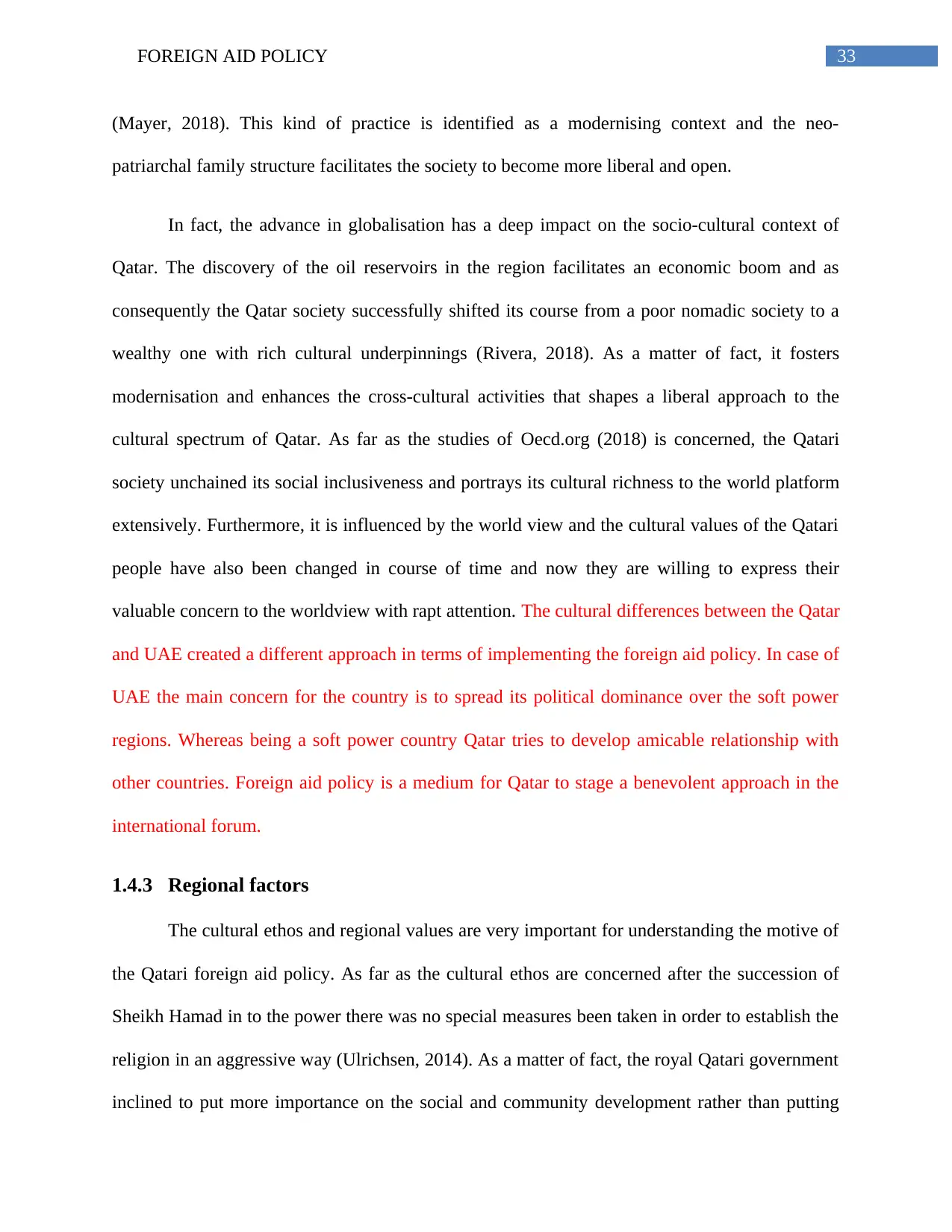
33FOREIGN AID POLICY
(Mayer, 2018). This kind of practice is identified as a modernising context and the neo-
patriarchal family structure facilitates the society to become more liberal and open.
In fact, the advance in globalisation has a deep impact on the socio-cultural context of
Qatar. The discovery of the oil reservoirs in the region facilitates an economic boom and as
consequently the Qatar society successfully shifted its course from a poor nomadic society to a
wealthy one with rich cultural underpinnings (Rivera, 2018). As a matter of fact, it fosters
modernisation and enhances the cross-cultural activities that shapes a liberal approach to the
cultural spectrum of Qatar. As far as the studies of Oecd.org (2018) is concerned, the Qatari
society unchained its social inclusiveness and portrays its cultural richness to the world platform
extensively. Furthermore, it is influenced by the world view and the cultural values of the Qatari
people have also been changed in course of time and now they are willing to express their
valuable concern to the worldview with rapt attention. The cultural differences between the Qatar
and UAE created a different approach in terms of implementing the foreign aid policy. In case of
UAE the main concern for the country is to spread its political dominance over the soft power
regions. Whereas being a soft power country Qatar tries to develop amicable relationship with
other countries. Foreign aid policy is a medium for Qatar to stage a benevolent approach in the
international forum.
1.4.3 Regional factors
The cultural ethos and regional values are very important for understanding the motive of
the Qatari foreign aid policy. As far as the cultural ethos are concerned after the succession of
Sheikh Hamad in to the power there was no special measures been taken in order to establish the
religion in an aggressive way (Ulrichsen, 2014). As a matter of fact, the royal Qatari government
inclined to put more importance on the social and community development rather than putting
(Mayer, 2018). This kind of practice is identified as a modernising context and the neo-
patriarchal family structure facilitates the society to become more liberal and open.
In fact, the advance in globalisation has a deep impact on the socio-cultural context of
Qatar. The discovery of the oil reservoirs in the region facilitates an economic boom and as
consequently the Qatar society successfully shifted its course from a poor nomadic society to a
wealthy one with rich cultural underpinnings (Rivera, 2018). As a matter of fact, it fosters
modernisation and enhances the cross-cultural activities that shapes a liberal approach to the
cultural spectrum of Qatar. As far as the studies of Oecd.org (2018) is concerned, the Qatari
society unchained its social inclusiveness and portrays its cultural richness to the world platform
extensively. Furthermore, it is influenced by the world view and the cultural values of the Qatari
people have also been changed in course of time and now they are willing to express their
valuable concern to the worldview with rapt attention. The cultural differences between the Qatar
and UAE created a different approach in terms of implementing the foreign aid policy. In case of
UAE the main concern for the country is to spread its political dominance over the soft power
regions. Whereas being a soft power country Qatar tries to develop amicable relationship with
other countries. Foreign aid policy is a medium for Qatar to stage a benevolent approach in the
international forum.
1.4.3 Regional factors
The cultural ethos and regional values are very important for understanding the motive of
the Qatari foreign aid policy. As far as the cultural ethos are concerned after the succession of
Sheikh Hamad in to the power there was no special measures been taken in order to establish the
religion in an aggressive way (Ulrichsen, 2014). As a matter of fact, the royal Qatari government
inclined to put more importance on the social and community development rather than putting
Secure Best Marks with AI Grader
Need help grading? Try our AI Grader for instant feedback on your assignments.
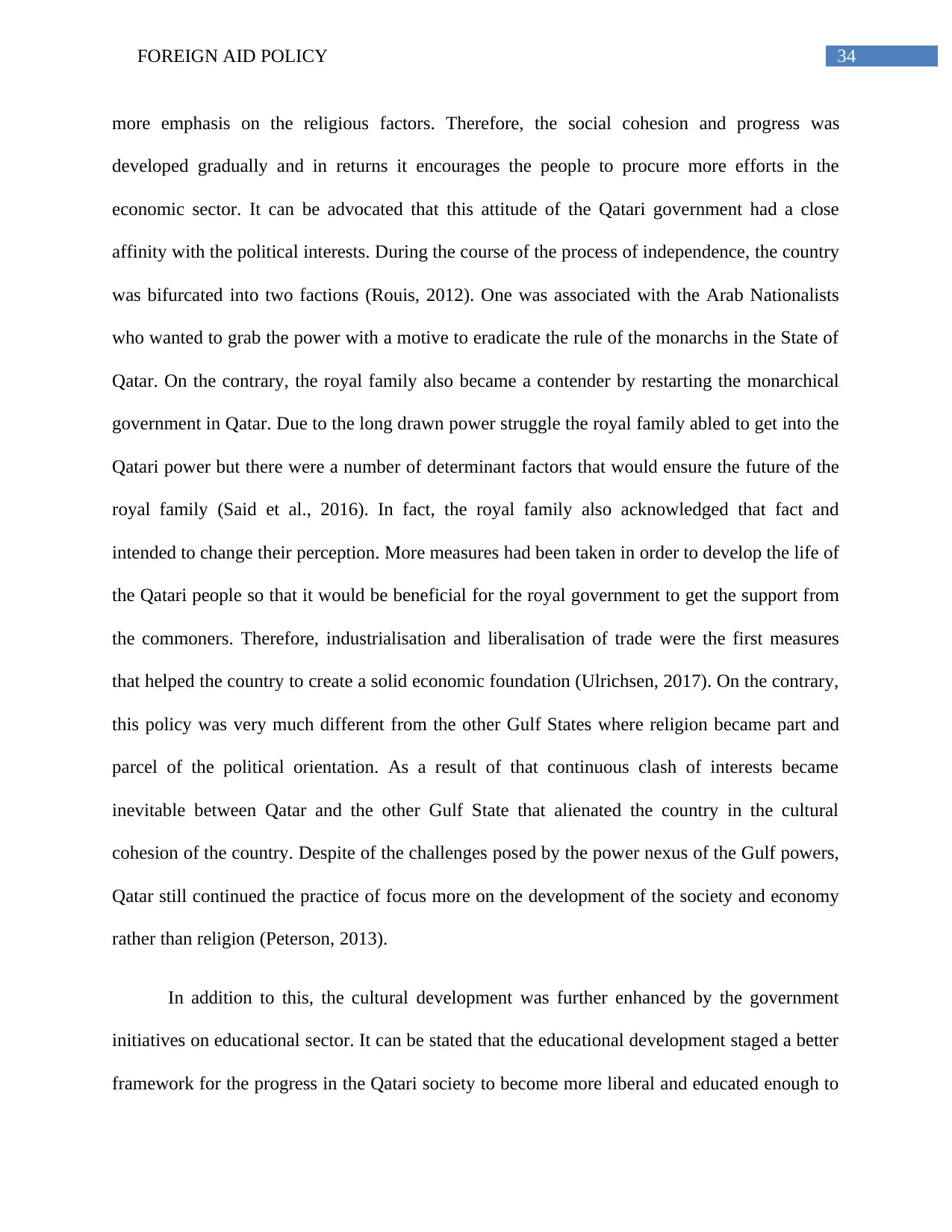
34FOREIGN AID POLICY
more emphasis on the religious factors. Therefore, the social cohesion and progress was
developed gradually and in returns it encourages the people to procure more efforts in the
economic sector. It can be advocated that this attitude of the Qatari government had a close
affinity with the political interests. During the course of the process of independence, the country
was bifurcated into two factions (Rouis, 2012). One was associated with the Arab Nationalists
who wanted to grab the power with a motive to eradicate the rule of the monarchs in the State of
Qatar. On the contrary, the royal family also became a contender by restarting the monarchical
government in Qatar. Due to the long drawn power struggle the royal family abled to get into the
Qatari power but there were a number of determinant factors that would ensure the future of the
royal family (Said et al., 2016). In fact, the royal family also acknowledged that fact and
intended to change their perception. More measures had been taken in order to develop the life of
the Qatari people so that it would be beneficial for the royal government to get the support from
the commoners. Therefore, industrialisation and liberalisation of trade were the first measures
that helped the country to create a solid economic foundation (Ulrichsen, 2017). On the contrary,
this policy was very much different from the other Gulf States where religion became part and
parcel of the political orientation. As a result of that continuous clash of interests became
inevitable between Qatar and the other Gulf State that alienated the country in the cultural
cohesion of the country. Despite of the challenges posed by the power nexus of the Gulf powers,
Qatar still continued the practice of focus more on the development of the society and economy
rather than religion (Peterson, 2013).
In addition to this, the cultural development was further enhanced by the government
initiatives on educational sector. It can be stated that the educational development staged a better
framework for the progress in the Qatari society to become more liberal and educated enough to
more emphasis on the religious factors. Therefore, the social cohesion and progress was
developed gradually and in returns it encourages the people to procure more efforts in the
economic sector. It can be advocated that this attitude of the Qatari government had a close
affinity with the political interests. During the course of the process of independence, the country
was bifurcated into two factions (Rouis, 2012). One was associated with the Arab Nationalists
who wanted to grab the power with a motive to eradicate the rule of the monarchs in the State of
Qatar. On the contrary, the royal family also became a contender by restarting the monarchical
government in Qatar. Due to the long drawn power struggle the royal family abled to get into the
Qatari power but there were a number of determinant factors that would ensure the future of the
royal family (Said et al., 2016). In fact, the royal family also acknowledged that fact and
intended to change their perception. More measures had been taken in order to develop the life of
the Qatari people so that it would be beneficial for the royal government to get the support from
the commoners. Therefore, industrialisation and liberalisation of trade were the first measures
that helped the country to create a solid economic foundation (Ulrichsen, 2017). On the contrary,
this policy was very much different from the other Gulf States where religion became part and
parcel of the political orientation. As a result of that continuous clash of interests became
inevitable between Qatar and the other Gulf State that alienated the country in the cultural
cohesion of the country. Despite of the challenges posed by the power nexus of the Gulf powers,
Qatar still continued the practice of focus more on the development of the society and economy
rather than religion (Peterson, 2013).
In addition to this, the cultural development was further enhanced by the government
initiatives on educational sector. It can be stated that the educational development staged a better
framework for the progress in the Qatari society to become more liberal and educated enough to
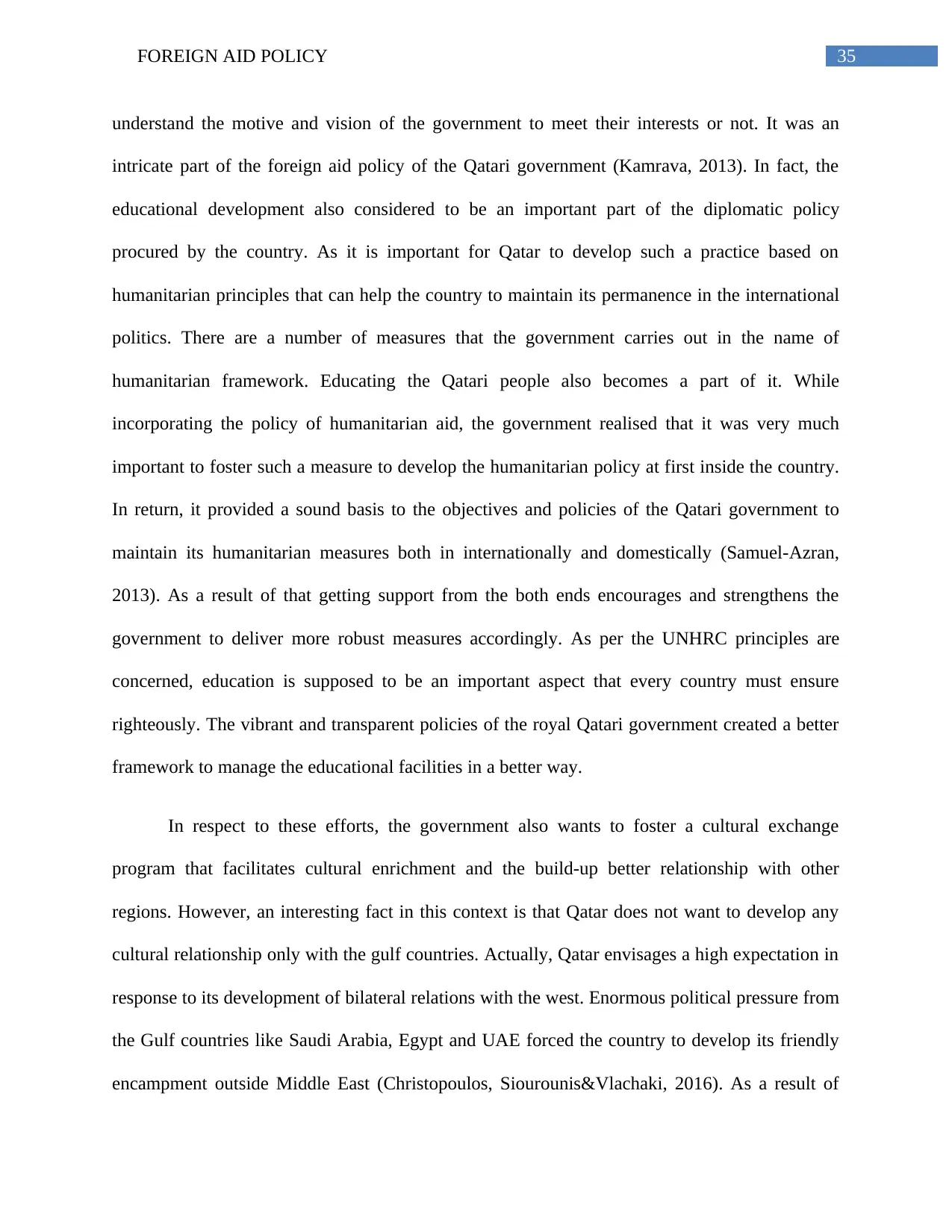
35FOREIGN AID POLICY
understand the motive and vision of the government to meet their interests or not. It was an
intricate part of the foreign aid policy of the Qatari government (Kamrava, 2013). In fact, the
educational development also considered to be an important part of the diplomatic policy
procured by the country. As it is important for Qatar to develop such a practice based on
humanitarian principles that can help the country to maintain its permanence in the international
politics. There are a number of measures that the government carries out in the name of
humanitarian framework. Educating the Qatari people also becomes a part of it. While
incorporating the policy of humanitarian aid, the government realised that it was very much
important to foster such a measure to develop the humanitarian policy at first inside the country.
In return, it provided a sound basis to the objectives and policies of the Qatari government to
maintain its humanitarian measures both in internationally and domestically (Samuel-Azran,
2013). As a result of that getting support from the both ends encourages and strengthens the
government to deliver more robust measures accordingly. As per the UNHRC principles are
concerned, education is supposed to be an important aspect that every country must ensure
righteously. The vibrant and transparent policies of the royal Qatari government created a better
framework to manage the educational facilities in a better way.
In respect to these efforts, the government also wants to foster a cultural exchange
program that facilitates cultural enrichment and the build-up better relationship with other
regions. However, an interesting fact in this context is that Qatar does not want to develop any
cultural relationship only with the gulf countries. Actually, Qatar envisages a high expectation in
response to its development of bilateral relations with the west. Enormous political pressure from
the Gulf countries like Saudi Arabia, Egypt and UAE forced the country to develop its friendly
encampment outside Middle East (Christopoulos, Siourounis&Vlachaki, 2016). As a result of
understand the motive and vision of the government to meet their interests or not. It was an
intricate part of the foreign aid policy of the Qatari government (Kamrava, 2013). In fact, the
educational development also considered to be an important part of the diplomatic policy
procured by the country. As it is important for Qatar to develop such a practice based on
humanitarian principles that can help the country to maintain its permanence in the international
politics. There are a number of measures that the government carries out in the name of
humanitarian framework. Educating the Qatari people also becomes a part of it. While
incorporating the policy of humanitarian aid, the government realised that it was very much
important to foster such a measure to develop the humanitarian policy at first inside the country.
In return, it provided a sound basis to the objectives and policies of the Qatari government to
maintain its humanitarian measures both in internationally and domestically (Samuel-Azran,
2013). As a result of that getting support from the both ends encourages and strengthens the
government to deliver more robust measures accordingly. As per the UNHRC principles are
concerned, education is supposed to be an important aspect that every country must ensure
righteously. The vibrant and transparent policies of the royal Qatari government created a better
framework to manage the educational facilities in a better way.
In respect to these efforts, the government also wants to foster a cultural exchange
program that facilitates cultural enrichment and the build-up better relationship with other
regions. However, an interesting fact in this context is that Qatar does not want to develop any
cultural relationship only with the gulf countries. Actually, Qatar envisages a high expectation in
response to its development of bilateral relations with the west. Enormous political pressure from
the Gulf countries like Saudi Arabia, Egypt and UAE forced the country to develop its friendly
encampment outside Middle East (Christopoulos, Siourounis&Vlachaki, 2016). As a result of
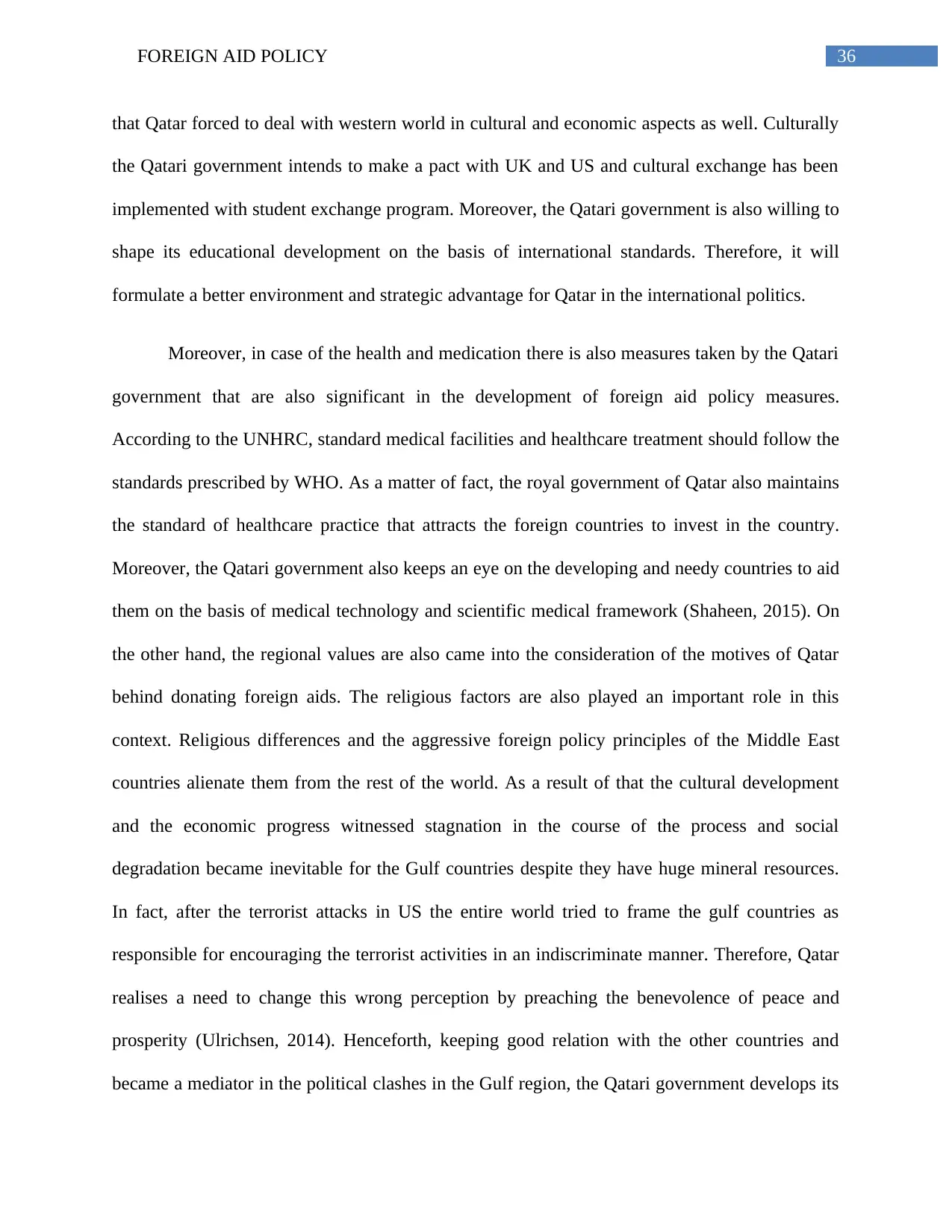
36FOREIGN AID POLICY
that Qatar forced to deal with western world in cultural and economic aspects as well. Culturally
the Qatari government intends to make a pact with UK and US and cultural exchange has been
implemented with student exchange program. Moreover, the Qatari government is also willing to
shape its educational development on the basis of international standards. Therefore, it will
formulate a better environment and strategic advantage for Qatar in the international politics.
Moreover, in case of the health and medication there is also measures taken by the Qatari
government that are also significant in the development of foreign aid policy measures.
According to the UNHRC, standard medical facilities and healthcare treatment should follow the
standards prescribed by WHO. As a matter of fact, the royal government of Qatar also maintains
the standard of healthcare practice that attracts the foreign countries to invest in the country.
Moreover, the Qatari government also keeps an eye on the developing and needy countries to aid
them on the basis of medical technology and scientific medical framework (Shaheen, 2015). On
the other hand, the regional values are also came into the consideration of the motives of Qatar
behind donating foreign aids. The religious factors are also played an important role in this
context. Religious differences and the aggressive foreign policy principles of the Middle East
countries alienate them from the rest of the world. As a result of that the cultural development
and the economic progress witnessed stagnation in the course of the process and social
degradation became inevitable for the Gulf countries despite they have huge mineral resources.
In fact, after the terrorist attacks in US the entire world tried to frame the gulf countries as
responsible for encouraging the terrorist activities in an indiscriminate manner. Therefore, Qatar
realises a need to change this wrong perception by preaching the benevolence of peace and
prosperity (Ulrichsen, 2014). Henceforth, keeping good relation with the other countries and
became a mediator in the political clashes in the Gulf region, the Qatari government develops its
that Qatar forced to deal with western world in cultural and economic aspects as well. Culturally
the Qatari government intends to make a pact with UK and US and cultural exchange has been
implemented with student exchange program. Moreover, the Qatari government is also willing to
shape its educational development on the basis of international standards. Therefore, it will
formulate a better environment and strategic advantage for Qatar in the international politics.
Moreover, in case of the health and medication there is also measures taken by the Qatari
government that are also significant in the development of foreign aid policy measures.
According to the UNHRC, standard medical facilities and healthcare treatment should follow the
standards prescribed by WHO. As a matter of fact, the royal government of Qatar also maintains
the standard of healthcare practice that attracts the foreign countries to invest in the country.
Moreover, the Qatari government also keeps an eye on the developing and needy countries to aid
them on the basis of medical technology and scientific medical framework (Shaheen, 2015). On
the other hand, the regional values are also came into the consideration of the motives of Qatar
behind donating foreign aids. The religious factors are also played an important role in this
context. Religious differences and the aggressive foreign policy principles of the Middle East
countries alienate them from the rest of the world. As a result of that the cultural development
and the economic progress witnessed stagnation in the course of the process and social
degradation became inevitable for the Gulf countries despite they have huge mineral resources.
In fact, after the terrorist attacks in US the entire world tried to frame the gulf countries as
responsible for encouraging the terrorist activities in an indiscriminate manner. Therefore, Qatar
realises a need to change this wrong perception by preaching the benevolence of peace and
prosperity (Ulrichsen, 2014). Henceforth, keeping good relation with the other countries and
became a mediator in the political clashes in the Gulf region, the Qatari government develops its
Paraphrase This Document
Need a fresh take? Get an instant paraphrase of this document with our AI Paraphraser
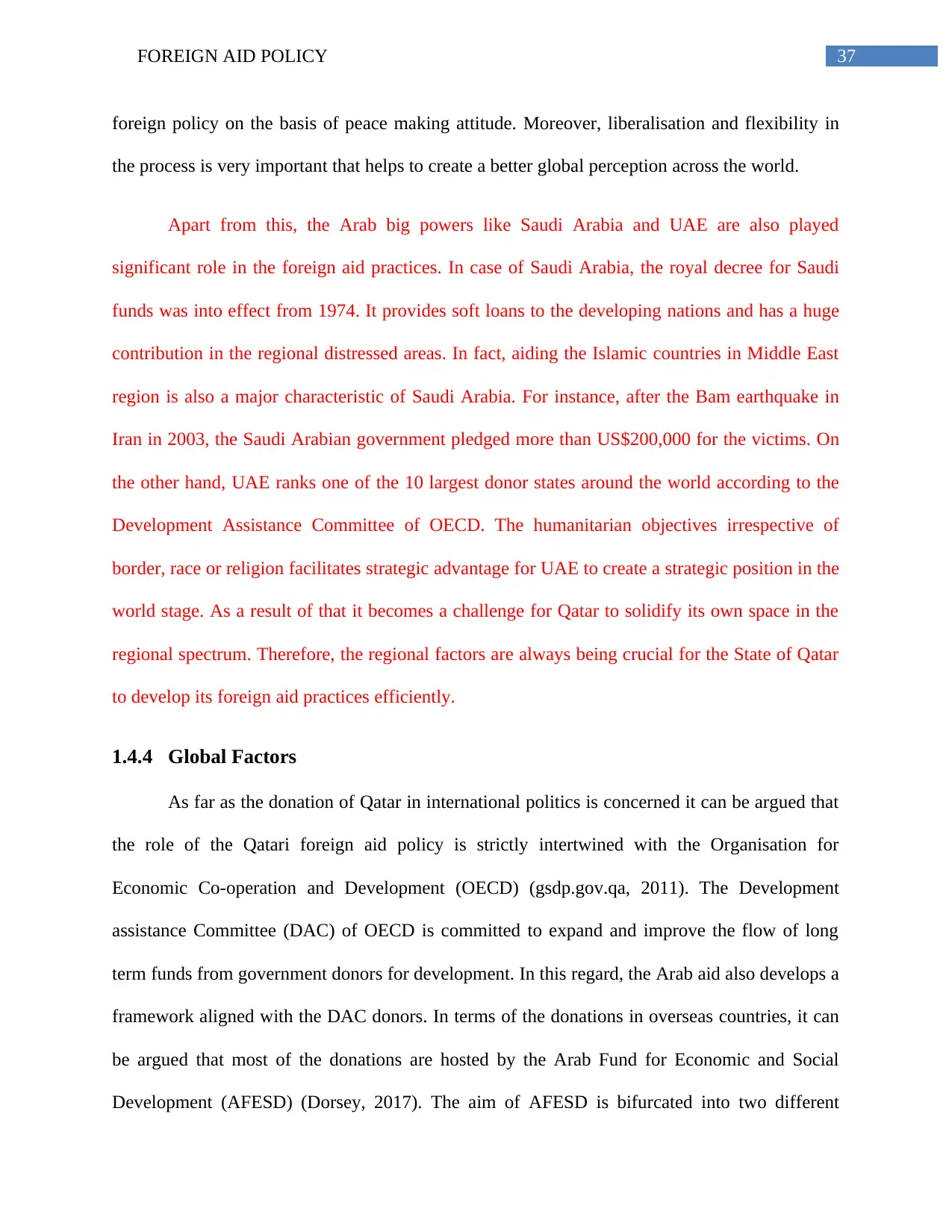
37FOREIGN AID POLICY
foreign policy on the basis of peace making attitude. Moreover, liberalisation and flexibility in
the process is very important that helps to create a better global perception across the world.
Apart from this, the Arab big powers like Saudi Arabia and UAE are also played
significant role in the foreign aid practices. In case of Saudi Arabia, the royal decree for Saudi
funds was into effect from 1974. It provides soft loans to the developing nations and has a huge
contribution in the regional distressed areas. In fact, aiding the Islamic countries in Middle East
region is also a major characteristic of Saudi Arabia. For instance, after the Bam earthquake in
Iran in 2003, the Saudi Arabian government pledged more than US$200,000 for the victims. On
the other hand, UAE ranks one of the 10 largest donor states around the world according to the
Development Assistance Committee of OECD. The humanitarian objectives irrespective of
border, race or religion facilitates strategic advantage for UAE to create a strategic position in the
world stage. As a result of that it becomes a challenge for Qatar to solidify its own space in the
regional spectrum. Therefore, the regional factors are always being crucial for the State of Qatar
to develop its foreign aid practices efficiently.
1.4.4 Global Factors
As far as the donation of Qatar in international politics is concerned it can be argued that
the role of the Qatari foreign aid policy is strictly intertwined with the Organisation for
Economic Co-operation and Development (OECD) (gsdp.gov.qa, 2011). The Development
assistance Committee (DAC) of OECD is committed to expand and improve the flow of long
term funds from government donors for development. In this regard, the Arab aid also develops a
framework aligned with the DAC donors. In terms of the donations in overseas countries, it can
be argued that most of the donations are hosted by the Arab Fund for Economic and Social
Development (AFESD) (Dorsey, 2017). The aim of AFESD is bifurcated into two different
foreign policy on the basis of peace making attitude. Moreover, liberalisation and flexibility in
the process is very important that helps to create a better global perception across the world.
Apart from this, the Arab big powers like Saudi Arabia and UAE are also played
significant role in the foreign aid practices. In case of Saudi Arabia, the royal decree for Saudi
funds was into effect from 1974. It provides soft loans to the developing nations and has a huge
contribution in the regional distressed areas. In fact, aiding the Islamic countries in Middle East
region is also a major characteristic of Saudi Arabia. For instance, after the Bam earthquake in
Iran in 2003, the Saudi Arabian government pledged more than US$200,000 for the victims. On
the other hand, UAE ranks one of the 10 largest donor states around the world according to the
Development Assistance Committee of OECD. The humanitarian objectives irrespective of
border, race or religion facilitates strategic advantage for UAE to create a strategic position in the
world stage. As a result of that it becomes a challenge for Qatar to solidify its own space in the
regional spectrum. Therefore, the regional factors are always being crucial for the State of Qatar
to develop its foreign aid practices efficiently.
1.4.4 Global Factors
As far as the donation of Qatar in international politics is concerned it can be argued that
the role of the Qatari foreign aid policy is strictly intertwined with the Organisation for
Economic Co-operation and Development (OECD) (gsdp.gov.qa, 2011). The Development
assistance Committee (DAC) of OECD is committed to expand and improve the flow of long
term funds from government donors for development. In this regard, the Arab aid also develops a
framework aligned with the DAC donors. In terms of the donations in overseas countries, it can
be argued that most of the donations are hosted by the Arab Fund for Economic and Social
Development (AFESD) (Dorsey, 2017). The aim of AFESD is bifurcated into two different
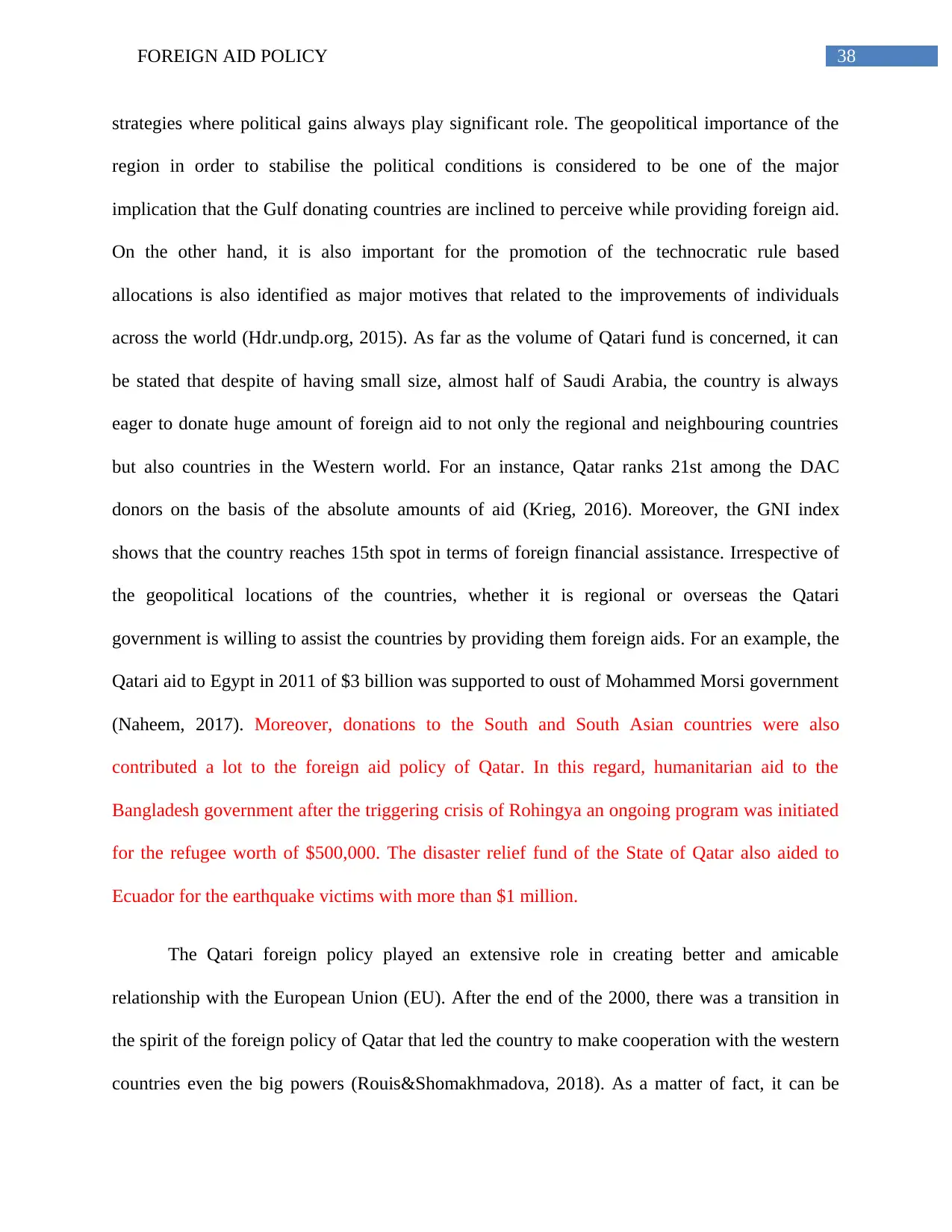
38FOREIGN AID POLICY
strategies where political gains always play significant role. The geopolitical importance of the
region in order to stabilise the political conditions is considered to be one of the major
implication that the Gulf donating countries are inclined to perceive while providing foreign aid.
On the other hand, it is also important for the promotion of the technocratic rule based
allocations is also identified as major motives that related to the improvements of individuals
across the world (Hdr.undp.org, 2015). As far as the volume of Qatari fund is concerned, it can
be stated that despite of having small size, almost half of Saudi Arabia, the country is always
eager to donate huge amount of foreign aid to not only the regional and neighbouring countries
but also countries in the Western world. For an instance, Qatar ranks 21st among the DAC
donors on the basis of the absolute amounts of aid (Krieg, 2016). Moreover, the GNI index
shows that the country reaches 15th spot in terms of foreign financial assistance. Irrespective of
the geopolitical locations of the countries, whether it is regional or overseas the Qatari
government is willing to assist the countries by providing them foreign aids. For an example, the
Qatari aid to Egypt in 2011 of $3 billion was supported to oust of Mohammed Morsi government
(Naheem, 2017). Moreover, donations to the South and South Asian countries were also
contributed a lot to the foreign aid policy of Qatar. In this regard, humanitarian aid to the
Bangladesh government after the triggering crisis of Rohingya an ongoing program was initiated
for the refugee worth of $500,000. The disaster relief fund of the State of Qatar also aided to
Ecuador for the earthquake victims with more than $1 million.
The Qatari foreign policy played an extensive role in creating better and amicable
relationship with the European Union (EU). After the end of the 2000, there was a transition in
the spirit of the foreign policy of Qatar that led the country to make cooperation with the western
countries even the big powers (Rouis&Shomakhmadova, 2018). As a matter of fact, it can be
strategies where political gains always play significant role. The geopolitical importance of the
region in order to stabilise the political conditions is considered to be one of the major
implication that the Gulf donating countries are inclined to perceive while providing foreign aid.
On the other hand, it is also important for the promotion of the technocratic rule based
allocations is also identified as major motives that related to the improvements of individuals
across the world (Hdr.undp.org, 2015). As far as the volume of Qatari fund is concerned, it can
be stated that despite of having small size, almost half of Saudi Arabia, the country is always
eager to donate huge amount of foreign aid to not only the regional and neighbouring countries
but also countries in the Western world. For an instance, Qatar ranks 21st among the DAC
donors on the basis of the absolute amounts of aid (Krieg, 2016). Moreover, the GNI index
shows that the country reaches 15th spot in terms of foreign financial assistance. Irrespective of
the geopolitical locations of the countries, whether it is regional or overseas the Qatari
government is willing to assist the countries by providing them foreign aids. For an example, the
Qatari aid to Egypt in 2011 of $3 billion was supported to oust of Mohammed Morsi government
(Naheem, 2017). Moreover, donations to the South and South Asian countries were also
contributed a lot to the foreign aid policy of Qatar. In this regard, humanitarian aid to the
Bangladesh government after the triggering crisis of Rohingya an ongoing program was initiated
for the refugee worth of $500,000. The disaster relief fund of the State of Qatar also aided to
Ecuador for the earthquake victims with more than $1 million.
The Qatari foreign policy played an extensive role in creating better and amicable
relationship with the European Union (EU). After the end of the 2000, there was a transition in
the spirit of the foreign policy of Qatar that led the country to make cooperation with the western
countries even the big powers (Rouis&Shomakhmadova, 2018). As a matter of fact, it can be
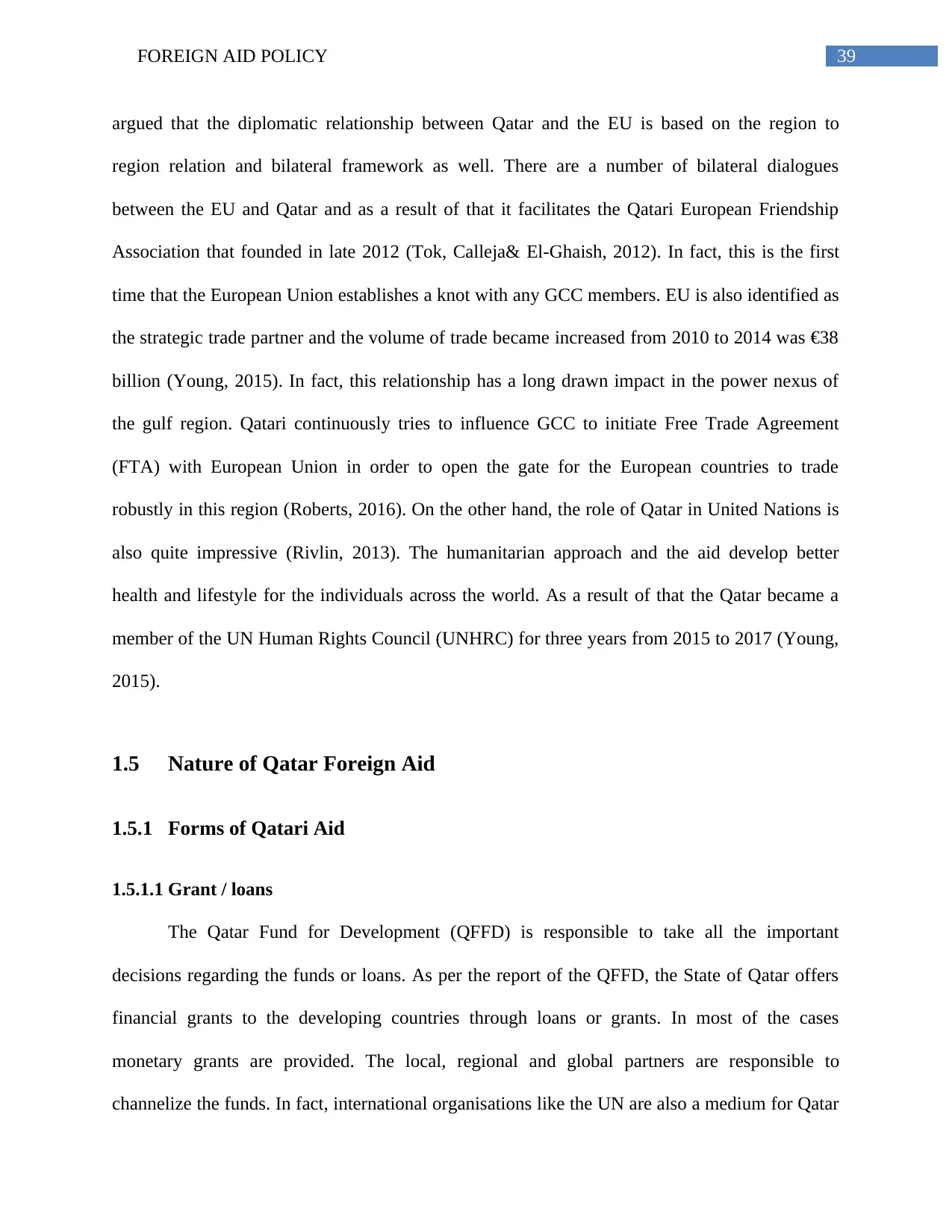
39FOREIGN AID POLICY
argued that the diplomatic relationship between Qatar and the EU is based on the region to
region relation and bilateral framework as well. There are a number of bilateral dialogues
between the EU and Qatar and as a result of that it facilitates the Qatari European Friendship
Association that founded in late 2012 (Tok, Calleja& El-Ghaish, 2012). In fact, this is the first
time that the European Union establishes a knot with any GCC members. EU is also identified as
the strategic trade partner and the volume of trade became increased from 2010 to 2014 was €38
billion (Young, 2015). In fact, this relationship has a long drawn impact in the power nexus of
the gulf region. Qatari continuously tries to influence GCC to initiate Free Trade Agreement
(FTA) with European Union in order to open the gate for the European countries to trade
robustly in this region (Roberts, 2016). On the other hand, the role of Qatar in United Nations is
also quite impressive (Rivlin, 2013). The humanitarian approach and the aid develop better
health and lifestyle for the individuals across the world. As a result of that the Qatar became a
member of the UN Human Rights Council (UNHRC) for three years from 2015 to 2017 (Young,
2015).
1.5 Nature of Qatar Foreign Aid
1.5.1 Forms of Qatari Aid
1.5.1.1 Grant / loans
The Qatar Fund for Development (QFFD) is responsible to take all the important
decisions regarding the funds or loans. As per the report of the QFFD, the State of Qatar offers
financial grants to the developing countries through loans or grants. In most of the cases
monetary grants are provided. The local, regional and global partners are responsible to
channelize the funds. In fact, international organisations like the UN are also a medium for Qatar
argued that the diplomatic relationship between Qatar and the EU is based on the region to
region relation and bilateral framework as well. There are a number of bilateral dialogues
between the EU and Qatar and as a result of that it facilitates the Qatari European Friendship
Association that founded in late 2012 (Tok, Calleja& El-Ghaish, 2012). In fact, this is the first
time that the European Union establishes a knot with any GCC members. EU is also identified as
the strategic trade partner and the volume of trade became increased from 2010 to 2014 was €38
billion (Young, 2015). In fact, this relationship has a long drawn impact in the power nexus of
the gulf region. Qatari continuously tries to influence GCC to initiate Free Trade Agreement
(FTA) with European Union in order to open the gate for the European countries to trade
robustly in this region (Roberts, 2016). On the other hand, the role of Qatar in United Nations is
also quite impressive (Rivlin, 2013). The humanitarian approach and the aid develop better
health and lifestyle for the individuals across the world. As a result of that the Qatar became a
member of the UN Human Rights Council (UNHRC) for three years from 2015 to 2017 (Young,
2015).
1.5 Nature of Qatar Foreign Aid
1.5.1 Forms of Qatari Aid
1.5.1.1 Grant / loans
The Qatar Fund for Development (QFFD) is responsible to take all the important
decisions regarding the funds or loans. As per the report of the QFFD, the State of Qatar offers
financial grants to the developing countries through loans or grants. In most of the cases
monetary grants are provided. The local, regional and global partners are responsible to
channelize the funds. In fact, international organisations like the UN are also a medium for Qatar
Secure Best Marks with AI Grader
Need help grading? Try our AI Grader for instant feedback on your assignments.
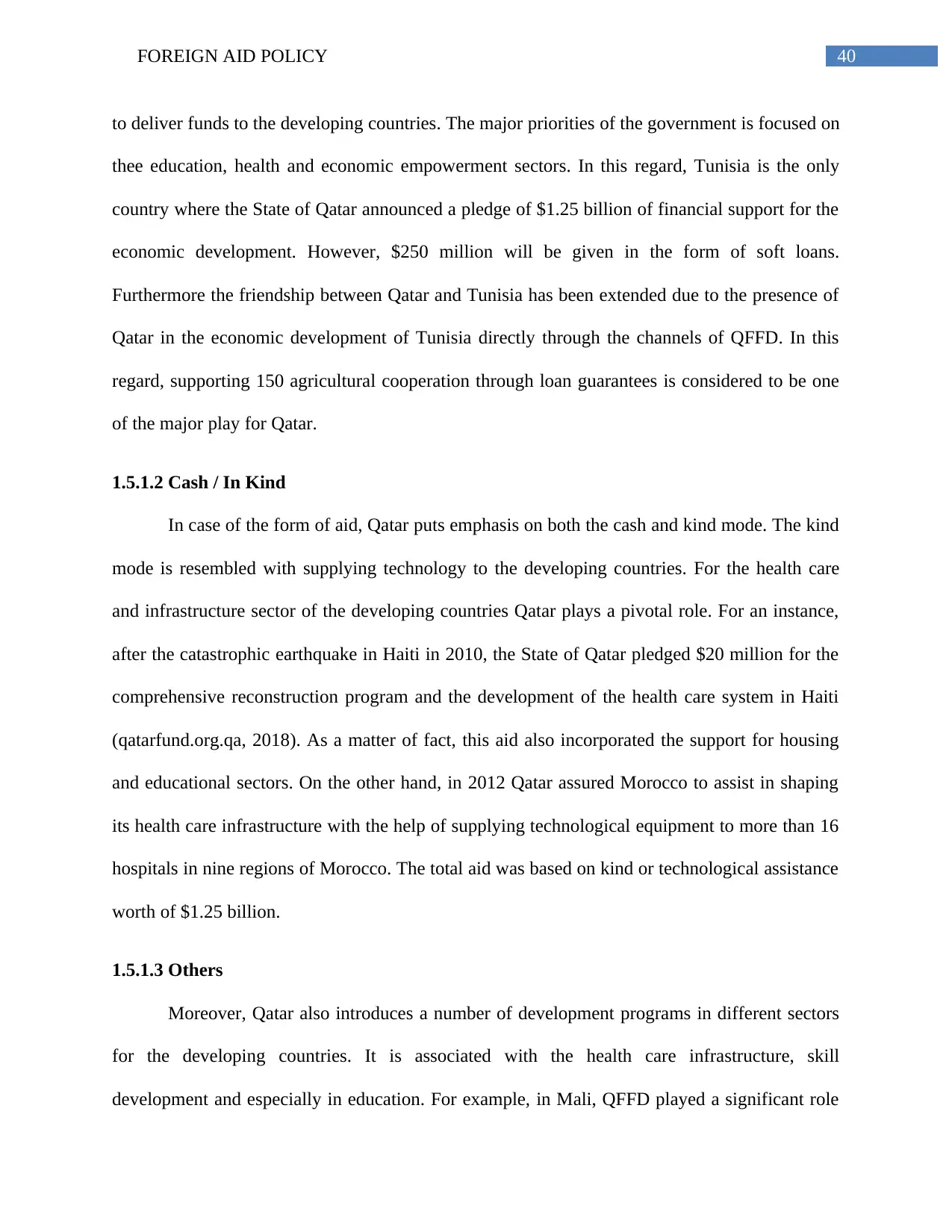
40FOREIGN AID POLICY
to deliver funds to the developing countries. The major priorities of the government is focused on
thee education, health and economic empowerment sectors. In this regard, Tunisia is the only
country where the State of Qatar announced a pledge of $1.25 billion of financial support for the
economic development. However, $250 million will be given in the form of soft loans.
Furthermore the friendship between Qatar and Tunisia has been extended due to the presence of
Qatar in the economic development of Tunisia directly through the channels of QFFD. In this
regard, supporting 150 agricultural cooperation through loan guarantees is considered to be one
of the major play for Qatar.
1.5.1.2 Cash / In Kind
In case of the form of aid, Qatar puts emphasis on both the cash and kind mode. The kind
mode is resembled with supplying technology to the developing countries. For the health care
and infrastructure sector of the developing countries Qatar plays a pivotal role. For an instance,
after the catastrophic earthquake in Haiti in 2010, the State of Qatar pledged $20 million for the
comprehensive reconstruction program and the development of the health care system in Haiti
(qatarfund.org.qa, 2018). As a matter of fact, this aid also incorporated the support for housing
and educational sectors. On the other hand, in 2012 Qatar assured Morocco to assist in shaping
its health care infrastructure with the help of supplying technological equipment to more than 16
hospitals in nine regions of Morocco. The total aid was based on kind or technological assistance
worth of $1.25 billion.
1.5.1.3 Others
Moreover, Qatar also introduces a number of development programs in different sectors
for the developing countries. It is associated with the health care infrastructure, skill
development and especially in education. For example, in Mali, QFFD played a significant role
to deliver funds to the developing countries. The major priorities of the government is focused on
thee education, health and economic empowerment sectors. In this regard, Tunisia is the only
country where the State of Qatar announced a pledge of $1.25 billion of financial support for the
economic development. However, $250 million will be given in the form of soft loans.
Furthermore the friendship between Qatar and Tunisia has been extended due to the presence of
Qatar in the economic development of Tunisia directly through the channels of QFFD. In this
regard, supporting 150 agricultural cooperation through loan guarantees is considered to be one
of the major play for Qatar.
1.5.1.2 Cash / In Kind
In case of the form of aid, Qatar puts emphasis on both the cash and kind mode. The kind
mode is resembled with supplying technology to the developing countries. For the health care
and infrastructure sector of the developing countries Qatar plays a pivotal role. For an instance,
after the catastrophic earthquake in Haiti in 2010, the State of Qatar pledged $20 million for the
comprehensive reconstruction program and the development of the health care system in Haiti
(qatarfund.org.qa, 2018). As a matter of fact, this aid also incorporated the support for housing
and educational sectors. On the other hand, in 2012 Qatar assured Morocco to assist in shaping
its health care infrastructure with the help of supplying technological equipment to more than 16
hospitals in nine regions of Morocco. The total aid was based on kind or technological assistance
worth of $1.25 billion.
1.5.1.3 Others
Moreover, Qatar also introduces a number of development programs in different sectors
for the developing countries. It is associated with the health care infrastructure, skill
development and especially in education. For example, in Mali, QFFD played a significant role
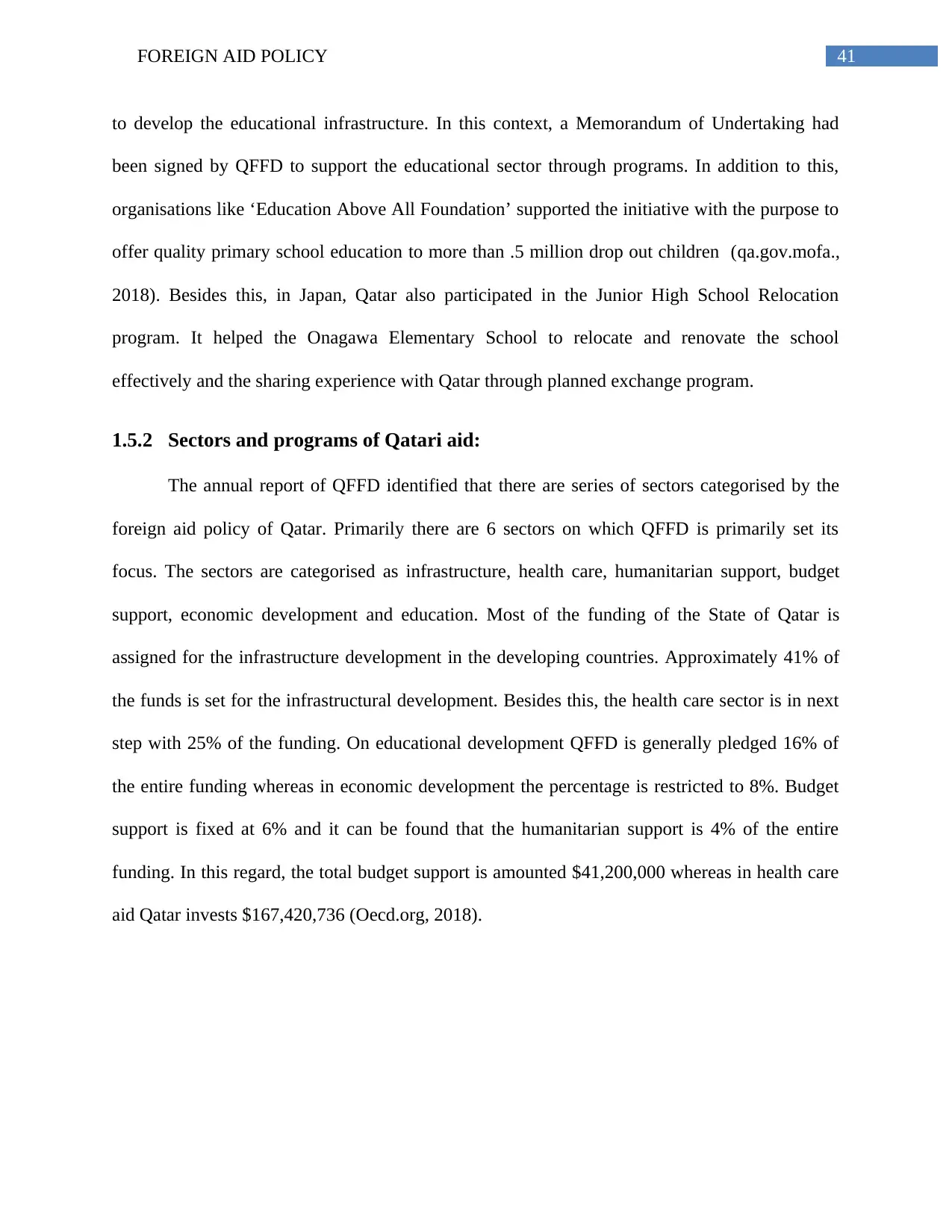
41FOREIGN AID POLICY
to develop the educational infrastructure. In this context, a Memorandum of Undertaking had
been signed by QFFD to support the educational sector through programs. In addition to this,
organisations like ‘Education Above All Foundation’ supported the initiative with the purpose to
offer quality primary school education to more than .5 million drop out children (qa.gov.mofa.,
2018). Besides this, in Japan, Qatar also participated in the Junior High School Relocation
program. It helped the Onagawa Elementary School to relocate and renovate the school
effectively and the sharing experience with Qatar through planned exchange program.
1.5.2 Sectors and programs of Qatari aid:
The annual report of QFFD identified that there are series of sectors categorised by the
foreign aid policy of Qatar. Primarily there are 6 sectors on which QFFD is primarily set its
focus. The sectors are categorised as infrastructure, health care, humanitarian support, budget
support, economic development and education. Most of the funding of the State of Qatar is
assigned for the infrastructure development in the developing countries. Approximately 41% of
the funds is set for the infrastructural development. Besides this, the health care sector is in next
step with 25% of the funding. On educational development QFFD is generally pledged 16% of
the entire funding whereas in economic development the percentage is restricted to 8%. Budget
support is fixed at 6% and it can be found that the humanitarian support is 4% of the entire
funding. In this regard, the total budget support is amounted $41,200,000 whereas in health care
aid Qatar invests $167,420,736 (Oecd.org, 2018).
to develop the educational infrastructure. In this context, a Memorandum of Undertaking had
been signed by QFFD to support the educational sector through programs. In addition to this,
organisations like ‘Education Above All Foundation’ supported the initiative with the purpose to
offer quality primary school education to more than .5 million drop out children (qa.gov.mofa.,
2018). Besides this, in Japan, Qatar also participated in the Junior High School Relocation
program. It helped the Onagawa Elementary School to relocate and renovate the school
effectively and the sharing experience with Qatar through planned exchange program.
1.5.2 Sectors and programs of Qatari aid:
The annual report of QFFD identified that there are series of sectors categorised by the
foreign aid policy of Qatar. Primarily there are 6 sectors on which QFFD is primarily set its
focus. The sectors are categorised as infrastructure, health care, humanitarian support, budget
support, economic development and education. Most of the funding of the State of Qatar is
assigned for the infrastructure development in the developing countries. Approximately 41% of
the funds is set for the infrastructural development. Besides this, the health care sector is in next
step with 25% of the funding. On educational development QFFD is generally pledged 16% of
the entire funding whereas in economic development the percentage is restricted to 8%. Budget
support is fixed at 6% and it can be found that the humanitarian support is 4% of the entire
funding. In this regard, the total budget support is amounted $41,200,000 whereas in health care
aid Qatar invests $167,420,736 (Oecd.org, 2018).
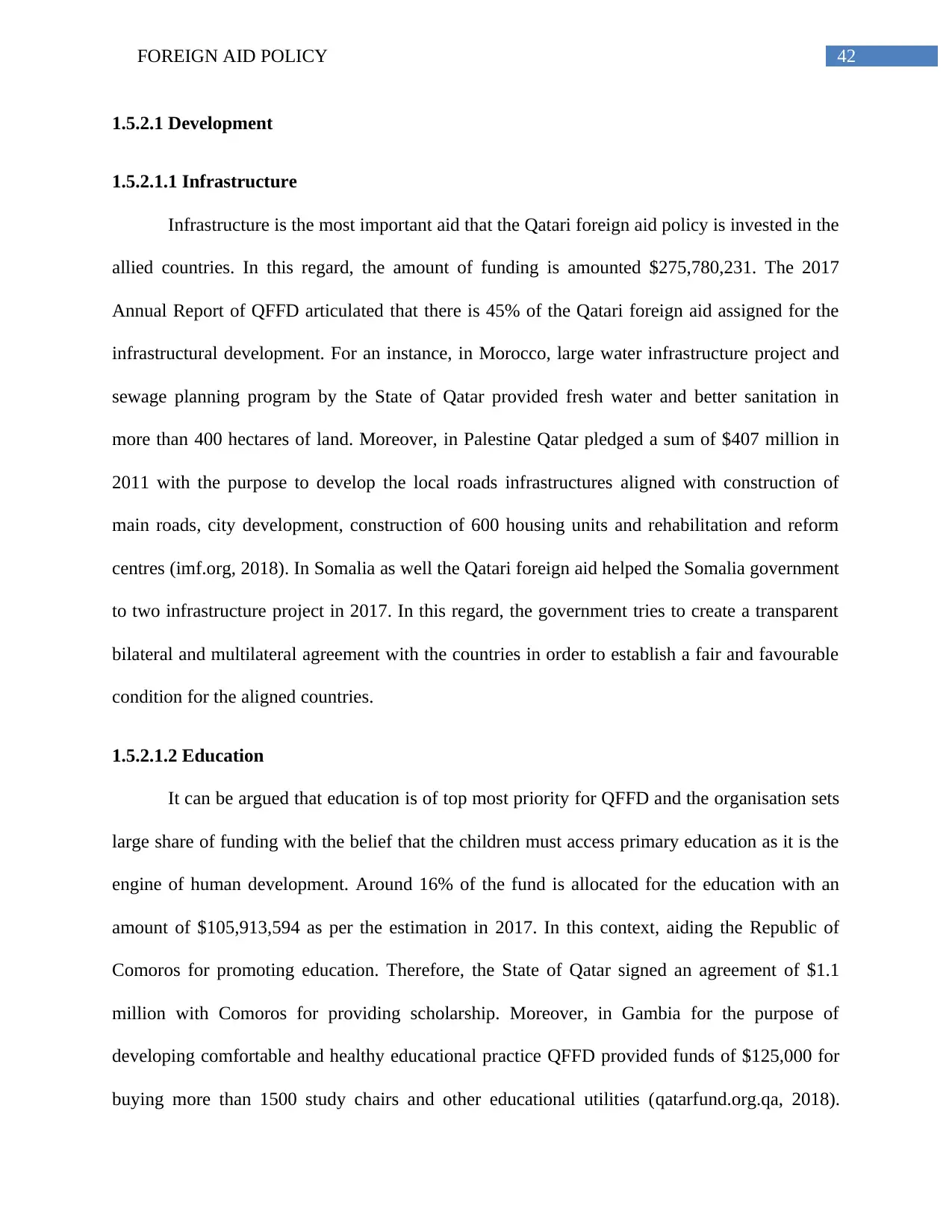
42FOREIGN AID POLICY
1.5.2.1 Development
1.5.2.1.1 Infrastructure
Infrastructure is the most important aid that the Qatari foreign aid policy is invested in the
allied countries. In this regard, the amount of funding is amounted $275,780,231. The 2017
Annual Report of QFFD articulated that there is 45% of the Qatari foreign aid assigned for the
infrastructural development. For an instance, in Morocco, large water infrastructure project and
sewage planning program by the State of Qatar provided fresh water and better sanitation in
more than 400 hectares of land. Moreover, in Palestine Qatar pledged a sum of $407 million in
2011 with the purpose to develop the local roads infrastructures aligned with construction of
main roads, city development, construction of 600 housing units and rehabilitation and reform
centres (imf.org, 2018). In Somalia as well the Qatari foreign aid helped the Somalia government
to two infrastructure project in 2017. In this regard, the government tries to create a transparent
bilateral and multilateral agreement with the countries in order to establish a fair and favourable
condition for the aligned countries.
1.5.2.1.2 Education
It can be argued that education is of top most priority for QFFD and the organisation sets
large share of funding with the belief that the children must access primary education as it is the
engine of human development. Around 16% of the fund is allocated for the education with an
amount of $105,913,594 as per the estimation in 2017. In this context, aiding the Republic of
Comoros for promoting education. Therefore, the State of Qatar signed an agreement of $1.1
million with Comoros for providing scholarship. Moreover, in Gambia for the purpose of
developing comfortable and healthy educational practice QFFD provided funds of $125,000 for
buying more than 1500 study chairs and other educational utilities (qatarfund.org.qa, 2018).
1.5.2.1 Development
1.5.2.1.1 Infrastructure
Infrastructure is the most important aid that the Qatari foreign aid policy is invested in the
allied countries. In this regard, the amount of funding is amounted $275,780,231. The 2017
Annual Report of QFFD articulated that there is 45% of the Qatari foreign aid assigned for the
infrastructural development. For an instance, in Morocco, large water infrastructure project and
sewage planning program by the State of Qatar provided fresh water and better sanitation in
more than 400 hectares of land. Moreover, in Palestine Qatar pledged a sum of $407 million in
2011 with the purpose to develop the local roads infrastructures aligned with construction of
main roads, city development, construction of 600 housing units and rehabilitation and reform
centres (imf.org, 2018). In Somalia as well the Qatari foreign aid helped the Somalia government
to two infrastructure project in 2017. In this regard, the government tries to create a transparent
bilateral and multilateral agreement with the countries in order to establish a fair and favourable
condition for the aligned countries.
1.5.2.1.2 Education
It can be argued that education is of top most priority for QFFD and the organisation sets
large share of funding with the belief that the children must access primary education as it is the
engine of human development. Around 16% of the fund is allocated for the education with an
amount of $105,913,594 as per the estimation in 2017. In this context, aiding the Republic of
Comoros for promoting education. Therefore, the State of Qatar signed an agreement of $1.1
million with Comoros for providing scholarship. Moreover, in Gambia for the purpose of
developing comfortable and healthy educational practice QFFD provided funds of $125,000 for
buying more than 1500 study chairs and other educational utilities (qatarfund.org.qa, 2018).
Paraphrase This Document
Need a fresh take? Get an instant paraphrase of this document with our AI Paraphraser
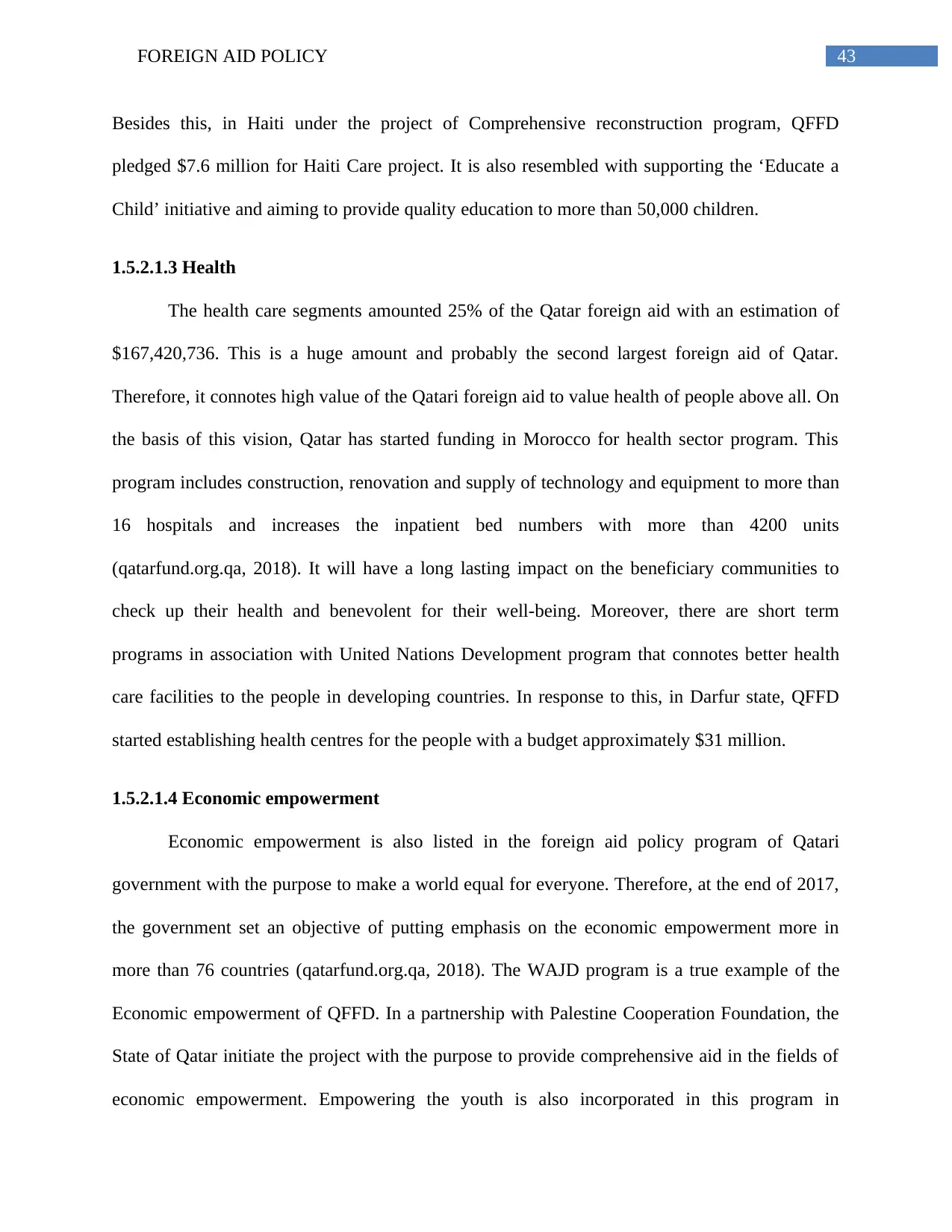
43FOREIGN AID POLICY
Besides this, in Haiti under the project of Comprehensive reconstruction program, QFFD
pledged $7.6 million for Haiti Care project. It is also resembled with supporting the ‘Educate a
Child’ initiative and aiming to provide quality education to more than 50,000 children.
1.5.2.1.3 Health
The health care segments amounted 25% of the Qatar foreign aid with an estimation of
$167,420,736. This is a huge amount and probably the second largest foreign aid of Qatar.
Therefore, it connotes high value of the Qatari foreign aid to value health of people above all. On
the basis of this vision, Qatar has started funding in Morocco for health sector program. This
program includes construction, renovation and supply of technology and equipment to more than
16 hospitals and increases the inpatient bed numbers with more than 4200 units
(qatarfund.org.qa, 2018). It will have a long lasting impact on the beneficiary communities to
check up their health and benevolent for their well-being. Moreover, there are short term
programs in association with United Nations Development program that connotes better health
care facilities to the people in developing countries. In response to this, in Darfur state, QFFD
started establishing health centres for the people with a budget approximately $31 million.
1.5.2.1.4 Economic empowerment
Economic empowerment is also listed in the foreign aid policy program of Qatari
government with the purpose to make a world equal for everyone. Therefore, at the end of 2017,
the government set an objective of putting emphasis on the economic empowerment more in
more than 76 countries (qatarfund.org.qa, 2018). The WAJD program is a true example of the
Economic empowerment of QFFD. In a partnership with Palestine Cooperation Foundation, the
State of Qatar initiate the project with the purpose to provide comprehensive aid in the fields of
economic empowerment. Empowering the youth is also incorporated in this program in
Besides this, in Haiti under the project of Comprehensive reconstruction program, QFFD
pledged $7.6 million for Haiti Care project. It is also resembled with supporting the ‘Educate a
Child’ initiative and aiming to provide quality education to more than 50,000 children.
1.5.2.1.3 Health
The health care segments amounted 25% of the Qatar foreign aid with an estimation of
$167,420,736. This is a huge amount and probably the second largest foreign aid of Qatar.
Therefore, it connotes high value of the Qatari foreign aid to value health of people above all. On
the basis of this vision, Qatar has started funding in Morocco for health sector program. This
program includes construction, renovation and supply of technology and equipment to more than
16 hospitals and increases the inpatient bed numbers with more than 4200 units
(qatarfund.org.qa, 2018). It will have a long lasting impact on the beneficiary communities to
check up their health and benevolent for their well-being. Moreover, there are short term
programs in association with United Nations Development program that connotes better health
care facilities to the people in developing countries. In response to this, in Darfur state, QFFD
started establishing health centres for the people with a budget approximately $31 million.
1.5.2.1.4 Economic empowerment
Economic empowerment is also listed in the foreign aid policy program of Qatari
government with the purpose to make a world equal for everyone. Therefore, at the end of 2017,
the government set an objective of putting emphasis on the economic empowerment more in
more than 76 countries (qatarfund.org.qa, 2018). The WAJD program is a true example of the
Economic empowerment of QFFD. In a partnership with Palestine Cooperation Foundation, the
State of Qatar initiate the project with the purpose to provide comprehensive aid in the fields of
economic empowerment. Empowering the youth is also incorporated in this program in
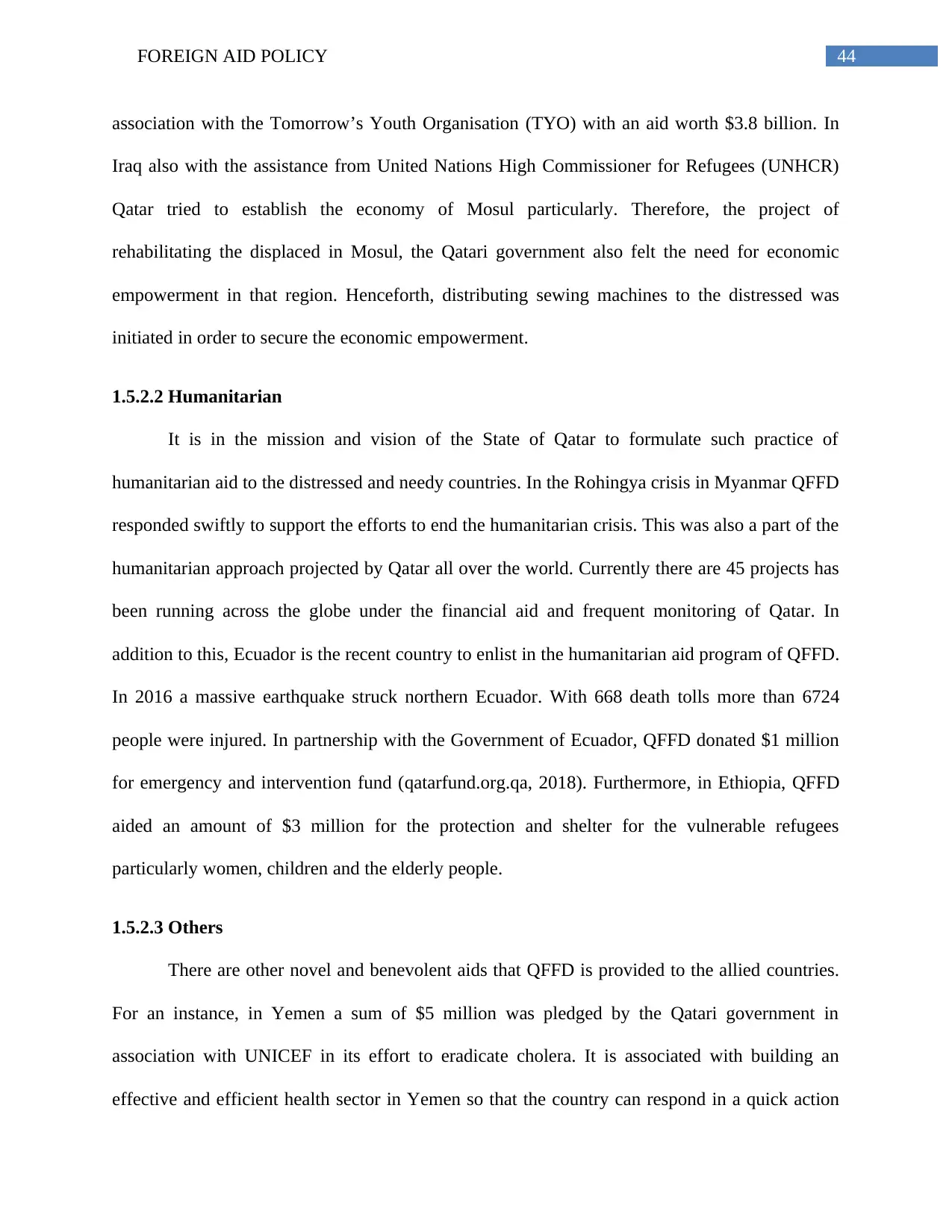
44FOREIGN AID POLICY
association with the Tomorrow’s Youth Organisation (TYO) with an aid worth $3.8 billion. In
Iraq also with the assistance from United Nations High Commissioner for Refugees (UNHCR)
Qatar tried to establish the economy of Mosul particularly. Therefore, the project of
rehabilitating the displaced in Mosul, the Qatari government also felt the need for economic
empowerment in that region. Henceforth, distributing sewing machines to the distressed was
initiated in order to secure the economic empowerment.
1.5.2.2 Humanitarian
It is in the mission and vision of the State of Qatar to formulate such practice of
humanitarian aid to the distressed and needy countries. In the Rohingya crisis in Myanmar QFFD
responded swiftly to support the efforts to end the humanitarian crisis. This was also a part of the
humanitarian approach projected by Qatar all over the world. Currently there are 45 projects has
been running across the globe under the financial aid and frequent monitoring of Qatar. In
addition to this, Ecuador is the recent country to enlist in the humanitarian aid program of QFFD.
In 2016 a massive earthquake struck northern Ecuador. With 668 death tolls more than 6724
people were injured. In partnership with the Government of Ecuador, QFFD donated $1 million
for emergency and intervention fund (qatarfund.org.qa, 2018). Furthermore, in Ethiopia, QFFD
aided an amount of $3 million for the protection and shelter for the vulnerable refugees
particularly women, children and the elderly people.
1.5.2.3 Others
There are other novel and benevolent aids that QFFD is provided to the allied countries.
For an instance, in Yemen a sum of $5 million was pledged by the Qatari government in
association with UNICEF in its effort to eradicate cholera. It is associated with building an
effective and efficient health sector in Yemen so that the country can respond in a quick action
association with the Tomorrow’s Youth Organisation (TYO) with an aid worth $3.8 billion. In
Iraq also with the assistance from United Nations High Commissioner for Refugees (UNHCR)
Qatar tried to establish the economy of Mosul particularly. Therefore, the project of
rehabilitating the displaced in Mosul, the Qatari government also felt the need for economic
empowerment in that region. Henceforth, distributing sewing machines to the distressed was
initiated in order to secure the economic empowerment.
1.5.2.2 Humanitarian
It is in the mission and vision of the State of Qatar to formulate such practice of
humanitarian aid to the distressed and needy countries. In the Rohingya crisis in Myanmar QFFD
responded swiftly to support the efforts to end the humanitarian crisis. This was also a part of the
humanitarian approach projected by Qatar all over the world. Currently there are 45 projects has
been running across the globe under the financial aid and frequent monitoring of Qatar. In
addition to this, Ecuador is the recent country to enlist in the humanitarian aid program of QFFD.
In 2016 a massive earthquake struck northern Ecuador. With 668 death tolls more than 6724
people were injured. In partnership with the Government of Ecuador, QFFD donated $1 million
for emergency and intervention fund (qatarfund.org.qa, 2018). Furthermore, in Ethiopia, QFFD
aided an amount of $3 million for the protection and shelter for the vulnerable refugees
particularly women, children and the elderly people.
1.5.2.3 Others
There are other novel and benevolent aids that QFFD is provided to the allied countries.
For an instance, in Yemen a sum of $5 million was pledged by the Qatari government in
association with UNICEF in its effort to eradicate cholera. It is associated with building an
effective and efficient health sector in Yemen so that the country can respond in a quick action
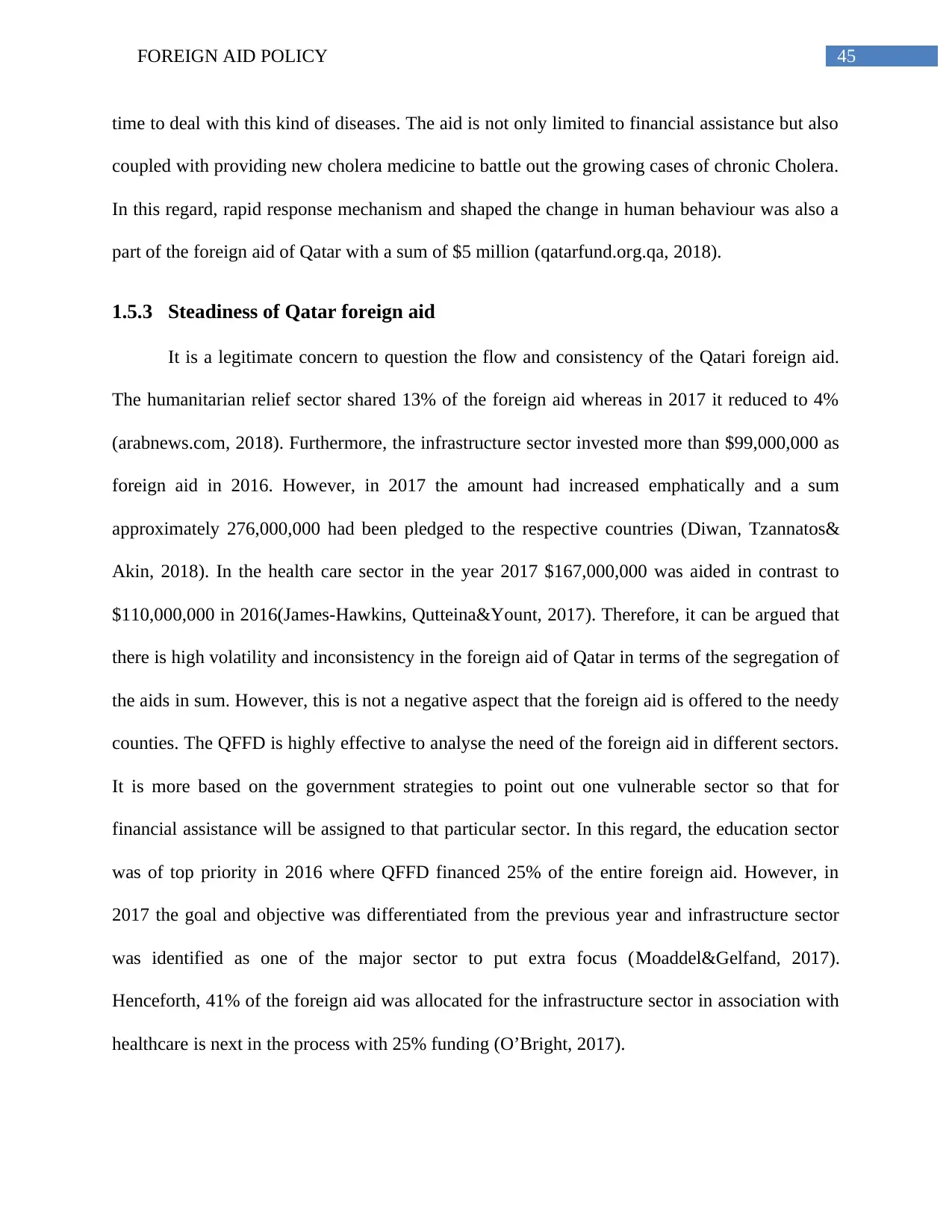
45FOREIGN AID POLICY
time to deal with this kind of diseases. The aid is not only limited to financial assistance but also
coupled with providing new cholera medicine to battle out the growing cases of chronic Cholera.
In this regard, rapid response mechanism and shaped the change in human behaviour was also a
part of the foreign aid of Qatar with a sum of $5 million (qatarfund.org.qa, 2018).
1.5.3 Steadiness of Qatar foreign aid
It is a legitimate concern to question the flow and consistency of the Qatari foreign aid.
The humanitarian relief sector shared 13% of the foreign aid whereas in 2017 it reduced to 4%
(arabnews.com, 2018). Furthermore, the infrastructure sector invested more than $99,000,000 as
foreign aid in 2016. However, in 2017 the amount had increased emphatically and a sum
approximately 276,000,000 had been pledged to the respective countries (Diwan, Tzannatos&
Akin, 2018). In the health care sector in the year 2017 $167,000,000 was aided in contrast to
$110,000,000 in 2016(James-Hawkins, Qutteina&Yount, 2017). Therefore, it can be argued that
there is high volatility and inconsistency in the foreign aid of Qatar in terms of the segregation of
the aids in sum. However, this is not a negative aspect that the foreign aid is offered to the needy
counties. The QFFD is highly effective to analyse the need of the foreign aid in different sectors.
It is more based on the government strategies to point out one vulnerable sector so that for
financial assistance will be assigned to that particular sector. In this regard, the education sector
was of top priority in 2016 where QFFD financed 25% of the entire foreign aid. However, in
2017 the goal and objective was differentiated from the previous year and infrastructure sector
was identified as one of the major sector to put extra focus (Moaddel&Gelfand, 2017).
Henceforth, 41% of the foreign aid was allocated for the infrastructure sector in association with
healthcare is next in the process with 25% funding (O’Bright, 2017).
time to deal with this kind of diseases. The aid is not only limited to financial assistance but also
coupled with providing new cholera medicine to battle out the growing cases of chronic Cholera.
In this regard, rapid response mechanism and shaped the change in human behaviour was also a
part of the foreign aid of Qatar with a sum of $5 million (qatarfund.org.qa, 2018).
1.5.3 Steadiness of Qatar foreign aid
It is a legitimate concern to question the flow and consistency of the Qatari foreign aid.
The humanitarian relief sector shared 13% of the foreign aid whereas in 2017 it reduced to 4%
(arabnews.com, 2018). Furthermore, the infrastructure sector invested more than $99,000,000 as
foreign aid in 2016. However, in 2017 the amount had increased emphatically and a sum
approximately 276,000,000 had been pledged to the respective countries (Diwan, Tzannatos&
Akin, 2018). In the health care sector in the year 2017 $167,000,000 was aided in contrast to
$110,000,000 in 2016(James-Hawkins, Qutteina&Yount, 2017). Therefore, it can be argued that
there is high volatility and inconsistency in the foreign aid of Qatar in terms of the segregation of
the aids in sum. However, this is not a negative aspect that the foreign aid is offered to the needy
counties. The QFFD is highly effective to analyse the need of the foreign aid in different sectors.
It is more based on the government strategies to point out one vulnerable sector so that for
financial assistance will be assigned to that particular sector. In this regard, the education sector
was of top priority in 2016 where QFFD financed 25% of the entire foreign aid. However, in
2017 the goal and objective was differentiated from the previous year and infrastructure sector
was identified as one of the major sector to put extra focus (Moaddel&Gelfand, 2017).
Henceforth, 41% of the foreign aid was allocated for the infrastructure sector in association with
healthcare is next in the process with 25% funding (O’Bright, 2017).
Secure Best Marks with AI Grader
Need help grading? Try our AI Grader for instant feedback on your assignments.
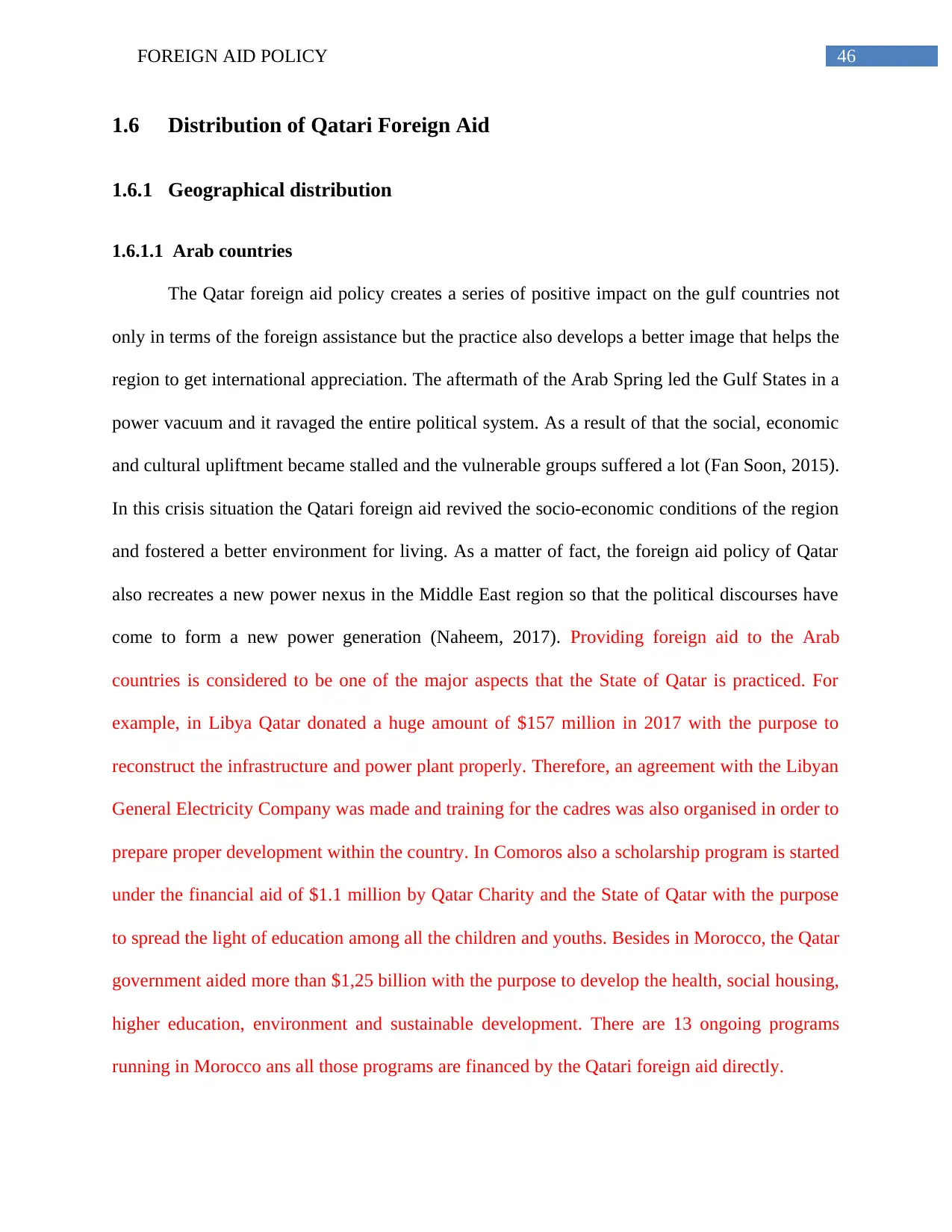
46FOREIGN AID POLICY
1.6 Distribution of Qatari Foreign Aid
1.6.1 Geographical distribution
1.6.1.1 Arab countries
The Qatar foreign aid policy creates a series of positive impact on the gulf countries not
only in terms of the foreign assistance but the practice also develops a better image that helps the
region to get international appreciation. The aftermath of the Arab Spring led the Gulf States in a
power vacuum and it ravaged the entire political system. As a result of that the social, economic
and cultural upliftment became stalled and the vulnerable groups suffered a lot (Fan Soon, 2015).
In this crisis situation the Qatari foreign aid revived the socio-economic conditions of the region
and fostered a better environment for living. As a matter of fact, the foreign aid policy of Qatar
also recreates a new power nexus in the Middle East region so that the political discourses have
come to form a new power generation (Naheem, 2017). Providing foreign aid to the Arab
countries is considered to be one of the major aspects that the State of Qatar is practiced. For
example, in Libya Qatar donated a huge amount of $157 million in 2017 with the purpose to
reconstruct the infrastructure and power plant properly. Therefore, an agreement with the Libyan
General Electricity Company was made and training for the cadres was also organised in order to
prepare proper development within the country. In Comoros also a scholarship program is started
under the financial aid of $1.1 million by Qatar Charity and the State of Qatar with the purpose
to spread the light of education among all the children and youths. Besides in Morocco, the Qatar
government aided more than $1,25 billion with the purpose to develop the health, social housing,
higher education, environment and sustainable development. There are 13 ongoing programs
running in Morocco ans all those programs are financed by the Qatari foreign aid directly.
1.6 Distribution of Qatari Foreign Aid
1.6.1 Geographical distribution
1.6.1.1 Arab countries
The Qatar foreign aid policy creates a series of positive impact on the gulf countries not
only in terms of the foreign assistance but the practice also develops a better image that helps the
region to get international appreciation. The aftermath of the Arab Spring led the Gulf States in a
power vacuum and it ravaged the entire political system. As a result of that the social, economic
and cultural upliftment became stalled and the vulnerable groups suffered a lot (Fan Soon, 2015).
In this crisis situation the Qatari foreign aid revived the socio-economic conditions of the region
and fostered a better environment for living. As a matter of fact, the foreign aid policy of Qatar
also recreates a new power nexus in the Middle East region so that the political discourses have
come to form a new power generation (Naheem, 2017). Providing foreign aid to the Arab
countries is considered to be one of the major aspects that the State of Qatar is practiced. For
example, in Libya Qatar donated a huge amount of $157 million in 2017 with the purpose to
reconstruct the infrastructure and power plant properly. Therefore, an agreement with the Libyan
General Electricity Company was made and training for the cadres was also organised in order to
prepare proper development within the country. In Comoros also a scholarship program is started
under the financial aid of $1.1 million by Qatar Charity and the State of Qatar with the purpose
to spread the light of education among all the children and youths. Besides in Morocco, the Qatar
government aided more than $1,25 billion with the purpose to develop the health, social housing,
higher education, environment and sustainable development. There are 13 ongoing programs
running in Morocco ans all those programs are financed by the Qatari foreign aid directly.
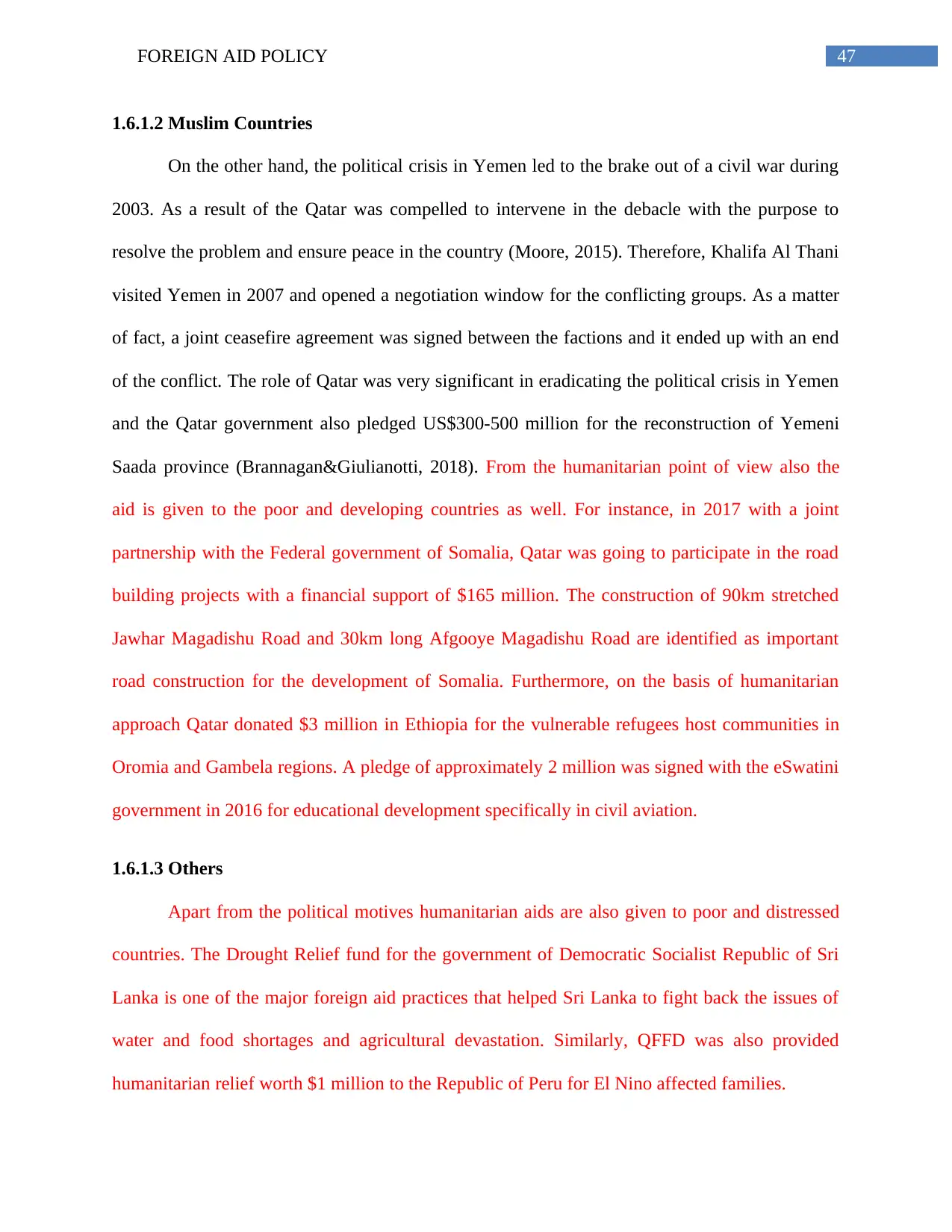
47FOREIGN AID POLICY
1.6.1.2 Muslim Countries
On the other hand, the political crisis in Yemen led to the brake out of a civil war during
2003. As a result of the Qatar was compelled to intervene in the debacle with the purpose to
resolve the problem and ensure peace in the country (Moore, 2015). Therefore, Khalifa Al Thani
visited Yemen in 2007 and opened a negotiation window for the conflicting groups. As a matter
of fact, a joint ceasefire agreement was signed between the factions and it ended up with an end
of the conflict. The role of Qatar was very significant in eradicating the political crisis in Yemen
and the Qatar government also pledged US$300-500 million for the reconstruction of Yemeni
Saada province (Brannagan&Giulianotti, 2018). From the humanitarian point of view also the
aid is given to the poor and developing countries as well. For instance, in 2017 with a joint
partnership with the Federal government of Somalia, Qatar was going to participate in the road
building projects with a financial support of $165 million. The construction of 90km stretched
Jawhar Magadishu Road and 30km long Afgooye Magadishu Road are identified as important
road construction for the development of Somalia. Furthermore, on the basis of humanitarian
approach Qatar donated $3 million in Ethiopia for the vulnerable refugees host communities in
Oromia and Gambela regions. A pledge of approximately 2 million was signed with the eSwatini
government in 2016 for educational development specifically in civil aviation.
1.6.1.3 Others
Apart from the political motives humanitarian aids are also given to poor and distressed
countries. The Drought Relief fund for the government of Democratic Socialist Republic of Sri
Lanka is one of the major foreign aid practices that helped Sri Lanka to fight back the issues of
water and food shortages and agricultural devastation. Similarly, QFFD was also provided
humanitarian relief worth $1 million to the Republic of Peru for El Nino affected families.
1.6.1.2 Muslim Countries
On the other hand, the political crisis in Yemen led to the brake out of a civil war during
2003. As a result of the Qatar was compelled to intervene in the debacle with the purpose to
resolve the problem and ensure peace in the country (Moore, 2015). Therefore, Khalifa Al Thani
visited Yemen in 2007 and opened a negotiation window for the conflicting groups. As a matter
of fact, a joint ceasefire agreement was signed between the factions and it ended up with an end
of the conflict. The role of Qatar was very significant in eradicating the political crisis in Yemen
and the Qatar government also pledged US$300-500 million for the reconstruction of Yemeni
Saada province (Brannagan&Giulianotti, 2018). From the humanitarian point of view also the
aid is given to the poor and developing countries as well. For instance, in 2017 with a joint
partnership with the Federal government of Somalia, Qatar was going to participate in the road
building projects with a financial support of $165 million. The construction of 90km stretched
Jawhar Magadishu Road and 30km long Afgooye Magadishu Road are identified as important
road construction for the development of Somalia. Furthermore, on the basis of humanitarian
approach Qatar donated $3 million in Ethiopia for the vulnerable refugees host communities in
Oromia and Gambela regions. A pledge of approximately 2 million was signed with the eSwatini
government in 2016 for educational development specifically in civil aviation.
1.6.1.3 Others
Apart from the political motives humanitarian aids are also given to poor and distressed
countries. The Drought Relief fund for the government of Democratic Socialist Republic of Sri
Lanka is one of the major foreign aid practices that helped Sri Lanka to fight back the issues of
water and food shortages and agricultural devastation. Similarly, QFFD was also provided
humanitarian relief worth $1 million to the Republic of Peru for El Nino affected families.
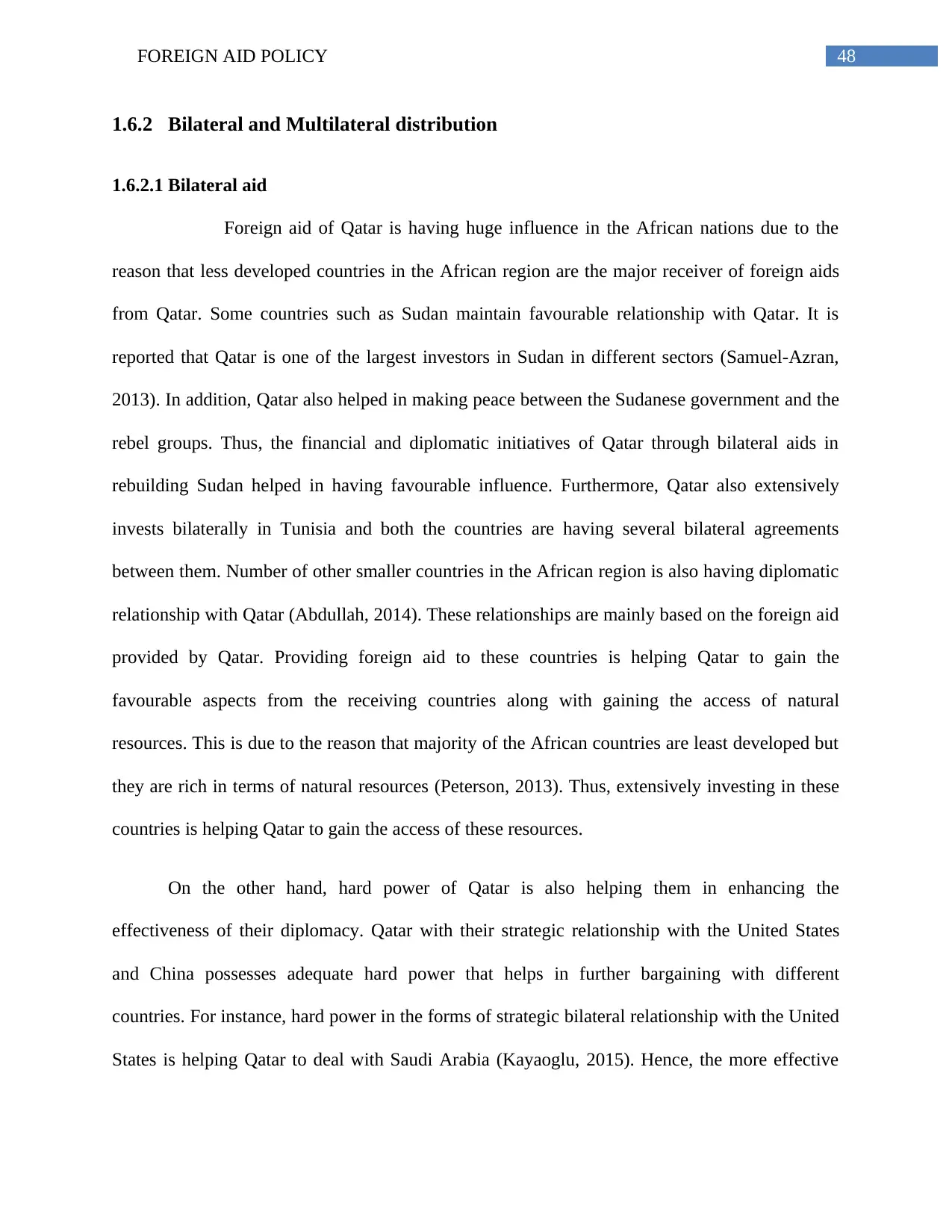
48FOREIGN AID POLICY
1.6.2 Bilateral and Multilateral distribution
1.6.2.1 Bilateral aid
Foreign aid of Qatar is having huge influence in the African nations due to the
reason that less developed countries in the African region are the major receiver of foreign aids
from Qatar. Some countries such as Sudan maintain favourable relationship with Qatar. It is
reported that Qatar is one of the largest investors in Sudan in different sectors (Samuel-Azran,
2013). In addition, Qatar also helped in making peace between the Sudanese government and the
rebel groups. Thus, the financial and diplomatic initiatives of Qatar through bilateral aids in
rebuilding Sudan helped in having favourable influence. Furthermore, Qatar also extensively
invests bilaterally in Tunisia and both the countries are having several bilateral agreements
between them. Number of other smaller countries in the African region is also having diplomatic
relationship with Qatar (Abdullah, 2014). These relationships are mainly based on the foreign aid
provided by Qatar. Providing foreign aid to these countries is helping Qatar to gain the
favourable aspects from the receiving countries along with gaining the access of natural
resources. This is due to the reason that majority of the African countries are least developed but
they are rich in terms of natural resources (Peterson, 2013). Thus, extensively investing in these
countries is helping Qatar to gain the access of these resources.
On the other hand, hard power of Qatar is also helping them in enhancing the
effectiveness of their diplomacy. Qatar with their strategic relationship with the United States
and China possesses adequate hard power that helps in further bargaining with different
countries. For instance, hard power in the forms of strategic bilateral relationship with the United
States is helping Qatar to deal with Saudi Arabia (Kayaoglu, 2015). Hence, the more effective
1.6.2 Bilateral and Multilateral distribution
1.6.2.1 Bilateral aid
Foreign aid of Qatar is having huge influence in the African nations due to the
reason that less developed countries in the African region are the major receiver of foreign aids
from Qatar. Some countries such as Sudan maintain favourable relationship with Qatar. It is
reported that Qatar is one of the largest investors in Sudan in different sectors (Samuel-Azran,
2013). In addition, Qatar also helped in making peace between the Sudanese government and the
rebel groups. Thus, the financial and diplomatic initiatives of Qatar through bilateral aids in
rebuilding Sudan helped in having favourable influence. Furthermore, Qatar also extensively
invests bilaterally in Tunisia and both the countries are having several bilateral agreements
between them. Number of other smaller countries in the African region is also having diplomatic
relationship with Qatar (Abdullah, 2014). These relationships are mainly based on the foreign aid
provided by Qatar. Providing foreign aid to these countries is helping Qatar to gain the
favourable aspects from the receiving countries along with gaining the access of natural
resources. This is due to the reason that majority of the African countries are least developed but
they are rich in terms of natural resources (Peterson, 2013). Thus, extensively investing in these
countries is helping Qatar to gain the access of these resources.
On the other hand, hard power of Qatar is also helping them in enhancing the
effectiveness of their diplomacy. Qatar with their strategic relationship with the United States
and China possesses adequate hard power that helps in further bargaining with different
countries. For instance, hard power in the forms of strategic bilateral relationship with the United
States is helping Qatar to deal with Saudi Arabia (Kayaoglu, 2015). Hence, the more effective
Paraphrase This Document
Need a fresh take? Get an instant paraphrase of this document with our AI Paraphraser
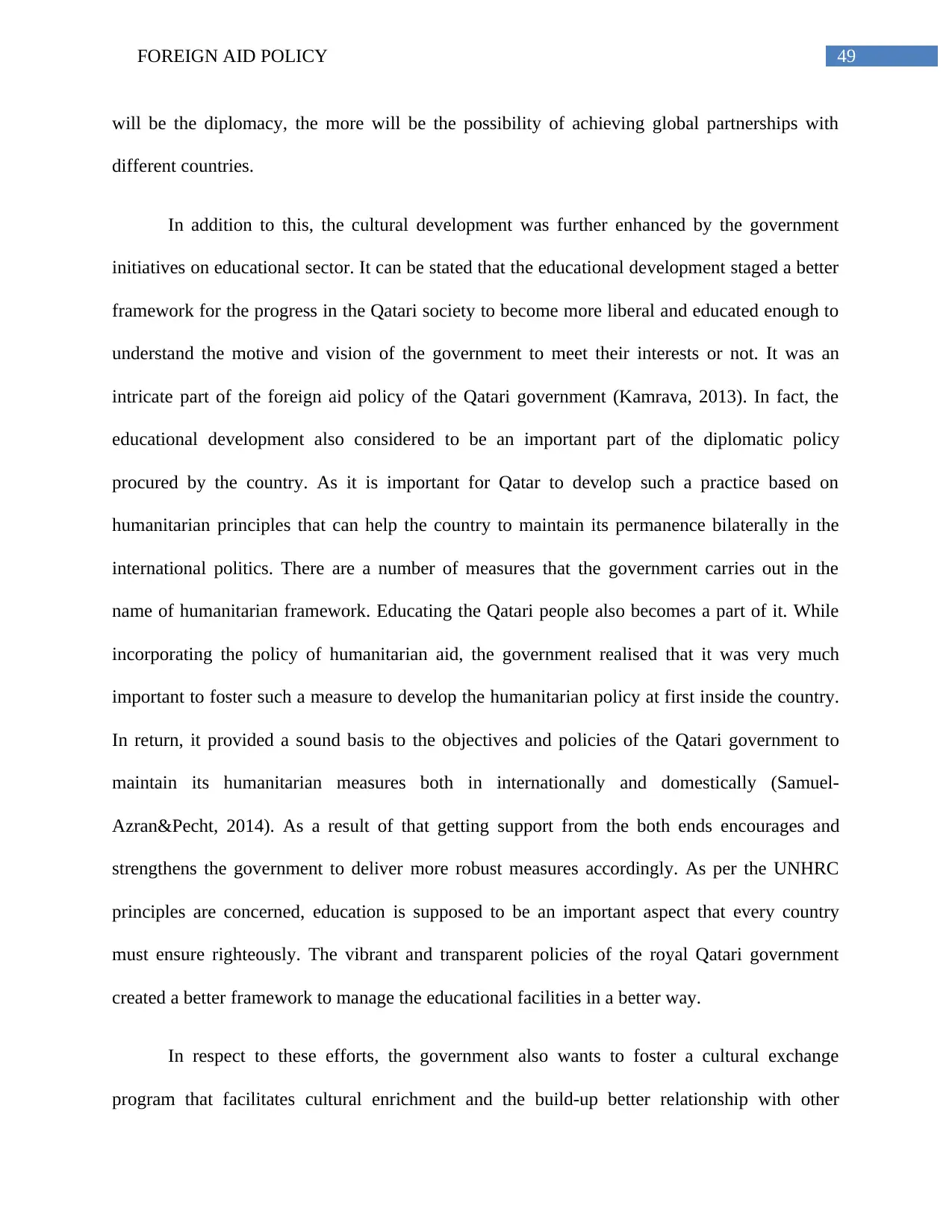
49FOREIGN AID POLICY
will be the diplomacy, the more will be the possibility of achieving global partnerships with
different countries.
In addition to this, the cultural development was further enhanced by the government
initiatives on educational sector. It can be stated that the educational development staged a better
framework for the progress in the Qatari society to become more liberal and educated enough to
understand the motive and vision of the government to meet their interests or not. It was an
intricate part of the foreign aid policy of the Qatari government (Kamrava, 2013). In fact, the
educational development also considered to be an important part of the diplomatic policy
procured by the country. As it is important for Qatar to develop such a practice based on
humanitarian principles that can help the country to maintain its permanence bilaterally in the
international politics. There are a number of measures that the government carries out in the
name of humanitarian framework. Educating the Qatari people also becomes a part of it. While
incorporating the policy of humanitarian aid, the government realised that it was very much
important to foster such a measure to develop the humanitarian policy at first inside the country.
In return, it provided a sound basis to the objectives and policies of the Qatari government to
maintain its humanitarian measures both in internationally and domestically (Samuel-
Azran&Pecht, 2014). As a result of that getting support from the both ends encourages and
strengthens the government to deliver more robust measures accordingly. As per the UNHRC
principles are concerned, education is supposed to be an important aspect that every country
must ensure righteously. The vibrant and transparent policies of the royal Qatari government
created a better framework to manage the educational facilities in a better way.
In respect to these efforts, the government also wants to foster a cultural exchange
program that facilitates cultural enrichment and the build-up better relationship with other
will be the diplomacy, the more will be the possibility of achieving global partnerships with
different countries.
In addition to this, the cultural development was further enhanced by the government
initiatives on educational sector. It can be stated that the educational development staged a better
framework for the progress in the Qatari society to become more liberal and educated enough to
understand the motive and vision of the government to meet their interests or not. It was an
intricate part of the foreign aid policy of the Qatari government (Kamrava, 2013). In fact, the
educational development also considered to be an important part of the diplomatic policy
procured by the country. As it is important for Qatar to develop such a practice based on
humanitarian principles that can help the country to maintain its permanence bilaterally in the
international politics. There are a number of measures that the government carries out in the
name of humanitarian framework. Educating the Qatari people also becomes a part of it. While
incorporating the policy of humanitarian aid, the government realised that it was very much
important to foster such a measure to develop the humanitarian policy at first inside the country.
In return, it provided a sound basis to the objectives and policies of the Qatari government to
maintain its humanitarian measures both in internationally and domestically (Samuel-
Azran&Pecht, 2014). As a result of that getting support from the both ends encourages and
strengthens the government to deliver more robust measures accordingly. As per the UNHRC
principles are concerned, education is supposed to be an important aspect that every country
must ensure righteously. The vibrant and transparent policies of the royal Qatari government
created a better framework to manage the educational facilities in a better way.
In respect to these efforts, the government also wants to foster a cultural exchange
program that facilitates cultural enrichment and the build-up better relationship with other
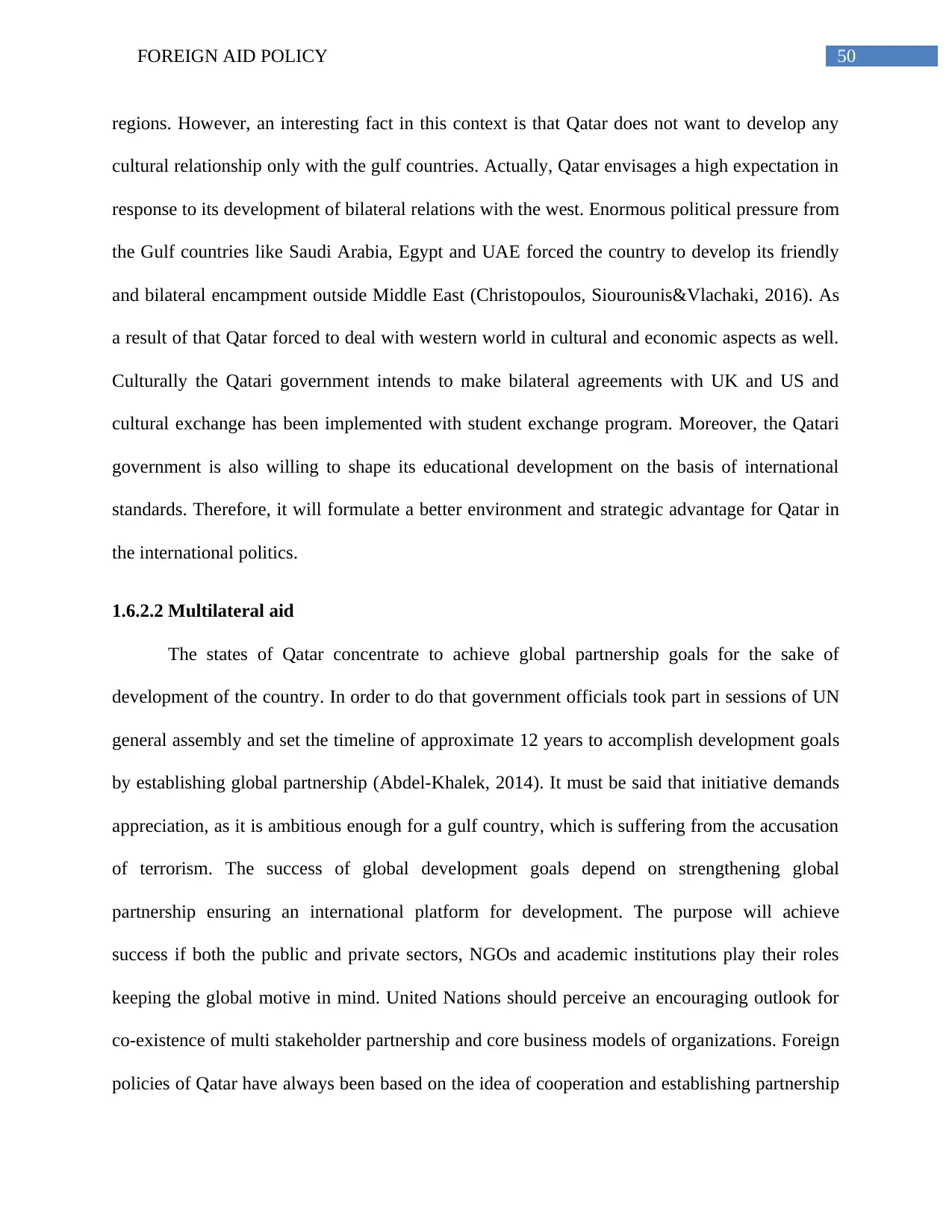
50FOREIGN AID POLICY
regions. However, an interesting fact in this context is that Qatar does not want to develop any
cultural relationship only with the gulf countries. Actually, Qatar envisages a high expectation in
response to its development of bilateral relations with the west. Enormous political pressure from
the Gulf countries like Saudi Arabia, Egypt and UAE forced the country to develop its friendly
and bilateral encampment outside Middle East (Christopoulos, Siourounis&Vlachaki, 2016). As
a result of that Qatar forced to deal with western world in cultural and economic aspects as well.
Culturally the Qatari government intends to make bilateral agreements with UK and US and
cultural exchange has been implemented with student exchange program. Moreover, the Qatari
government is also willing to shape its educational development on the basis of international
standards. Therefore, it will formulate a better environment and strategic advantage for Qatar in
the international politics.
1.6.2.2 Multilateral aid
The states of Qatar concentrate to achieve global partnership goals for the sake of
development of the country. In order to do that government officials took part in sessions of UN
general assembly and set the timeline of approximate 12 years to accomplish development goals
by establishing global partnership (Abdel-Khalek, 2014). It must be said that initiative demands
appreciation, as it is ambitious enough for a gulf country, which is suffering from the accusation
of terrorism. The success of global development goals depend on strengthening global
partnership ensuring an international platform for development. The purpose will achieve
success if both the public and private sectors, NGOs and academic institutions play their roles
keeping the global motive in mind. United Nations should perceive an encouraging outlook for
co-existence of multi stakeholder partnership and core business models of organizations. Foreign
policies of Qatar have always been based on the idea of cooperation and establishing partnership
regions. However, an interesting fact in this context is that Qatar does not want to develop any
cultural relationship only with the gulf countries. Actually, Qatar envisages a high expectation in
response to its development of bilateral relations with the west. Enormous political pressure from
the Gulf countries like Saudi Arabia, Egypt and UAE forced the country to develop its friendly
and bilateral encampment outside Middle East (Christopoulos, Siourounis&Vlachaki, 2016). As
a result of that Qatar forced to deal with western world in cultural and economic aspects as well.
Culturally the Qatari government intends to make bilateral agreements with UK and US and
cultural exchange has been implemented with student exchange program. Moreover, the Qatari
government is also willing to shape its educational development on the basis of international
standards. Therefore, it will formulate a better environment and strategic advantage for Qatar in
the international politics.
1.6.2.2 Multilateral aid
The states of Qatar concentrate to achieve global partnership goals for the sake of
development of the country. In order to do that government officials took part in sessions of UN
general assembly and set the timeline of approximate 12 years to accomplish development goals
by establishing global partnership (Abdel-Khalek, 2014). It must be said that initiative demands
appreciation, as it is ambitious enough for a gulf country, which is suffering from the accusation
of terrorism. The success of global development goals depend on strengthening global
partnership ensuring an international platform for development. The purpose will achieve
success if both the public and private sectors, NGOs and academic institutions play their roles
keeping the global motive in mind. United Nations should perceive an encouraging outlook for
co-existence of multi stakeholder partnership and core business models of organizations. Foreign
policies of Qatar have always been based on the idea of cooperation and establishing partnership
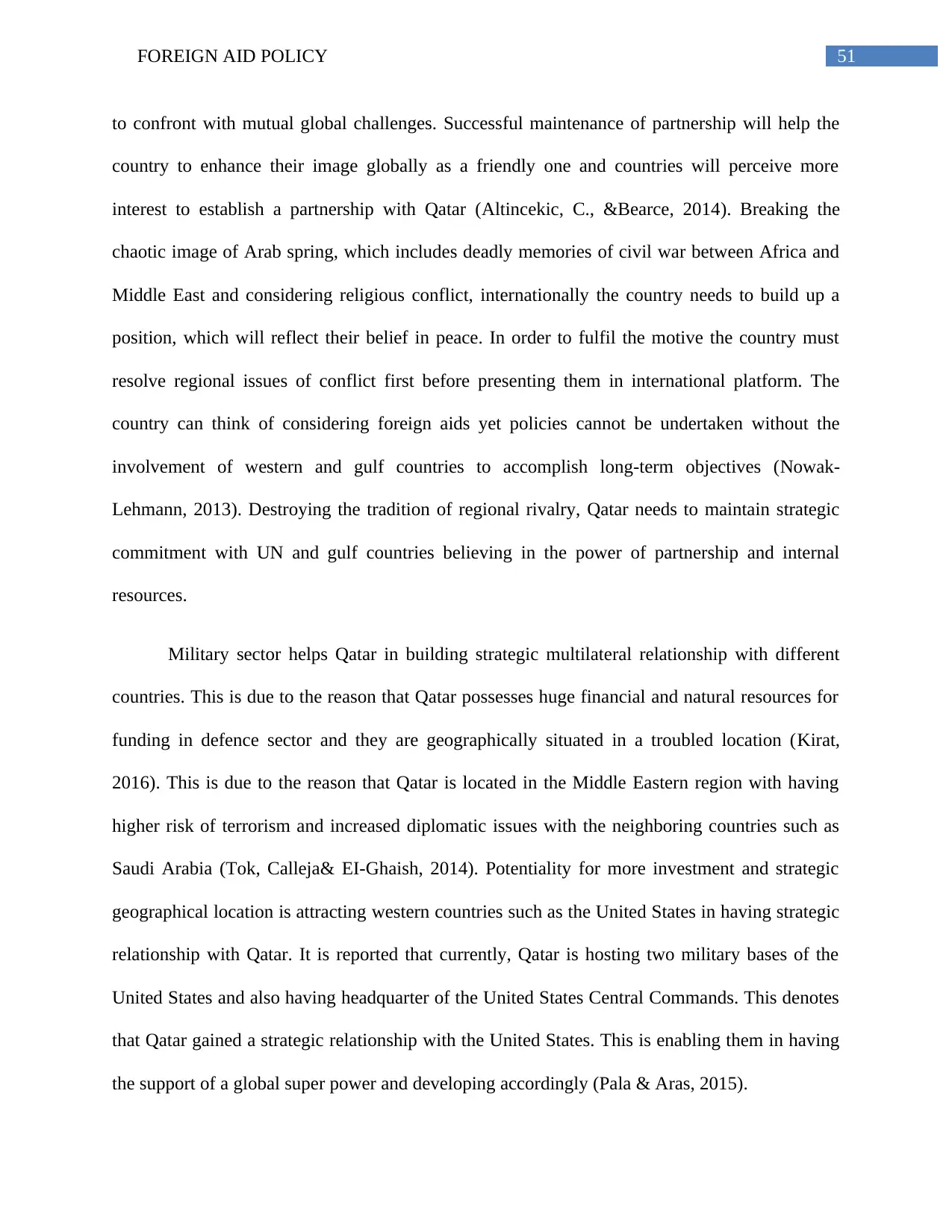
51FOREIGN AID POLICY
to confront with mutual global challenges. Successful maintenance of partnership will help the
country to enhance their image globally as a friendly one and countries will perceive more
interest to establish a partnership with Qatar (Altincekic, C., &Bearce, 2014). Breaking the
chaotic image of Arab spring, which includes deadly memories of civil war between Africa and
Middle East and considering religious conflict, internationally the country needs to build up a
position, which will reflect their belief in peace. In order to fulfil the motive the country must
resolve regional issues of conflict first before presenting them in international platform. The
country can think of considering foreign aids yet policies cannot be undertaken without the
involvement of western and gulf countries to accomplish long-term objectives (Nowak-
Lehmann, 2013). Destroying the tradition of regional rivalry, Qatar needs to maintain strategic
commitment with UN and gulf countries believing in the power of partnership and internal
resources.
Military sector helps Qatar in building strategic multilateral relationship with different
countries. This is due to the reason that Qatar possesses huge financial and natural resources for
funding in defence sector and they are geographically situated in a troubled location (Kirat,
2016). This is due to the reason that Qatar is located in the Middle Eastern region with having
higher risk of terrorism and increased diplomatic issues with the neighboring countries such as
Saudi Arabia (Tok, Calleja& EI-Ghaish, 2014). Potentiality for more investment and strategic
geographical location is attracting western countries such as the United States in having strategic
relationship with Qatar. It is reported that currently, Qatar is hosting two military bases of the
United States and also having headquarter of the United States Central Commands. This denotes
that Qatar gained a strategic relationship with the United States. This is enabling them in having
the support of a global super power and developing accordingly (Pala & Aras, 2015).
to confront with mutual global challenges. Successful maintenance of partnership will help the
country to enhance their image globally as a friendly one and countries will perceive more
interest to establish a partnership with Qatar (Altincekic, C., &Bearce, 2014). Breaking the
chaotic image of Arab spring, which includes deadly memories of civil war between Africa and
Middle East and considering religious conflict, internationally the country needs to build up a
position, which will reflect their belief in peace. In order to fulfil the motive the country must
resolve regional issues of conflict first before presenting them in international platform. The
country can think of considering foreign aids yet policies cannot be undertaken without the
involvement of western and gulf countries to accomplish long-term objectives (Nowak-
Lehmann, 2013). Destroying the tradition of regional rivalry, Qatar needs to maintain strategic
commitment with UN and gulf countries believing in the power of partnership and internal
resources.
Military sector helps Qatar in building strategic multilateral relationship with different
countries. This is due to the reason that Qatar possesses huge financial and natural resources for
funding in defence sector and they are geographically situated in a troubled location (Kirat,
2016). This is due to the reason that Qatar is located in the Middle Eastern region with having
higher risk of terrorism and increased diplomatic issues with the neighboring countries such as
Saudi Arabia (Tok, Calleja& EI-Ghaish, 2014). Potentiality for more investment and strategic
geographical location is attracting western countries such as the United States in having strategic
relationship with Qatar. It is reported that currently, Qatar is hosting two military bases of the
United States and also having headquarter of the United States Central Commands. This denotes
that Qatar gained a strategic relationship with the United States. This is enabling them in having
the support of a global super power and developing accordingly (Pala & Aras, 2015).
Secure Best Marks with AI Grader
Need help grading? Try our AI Grader for instant feedback on your assignments.
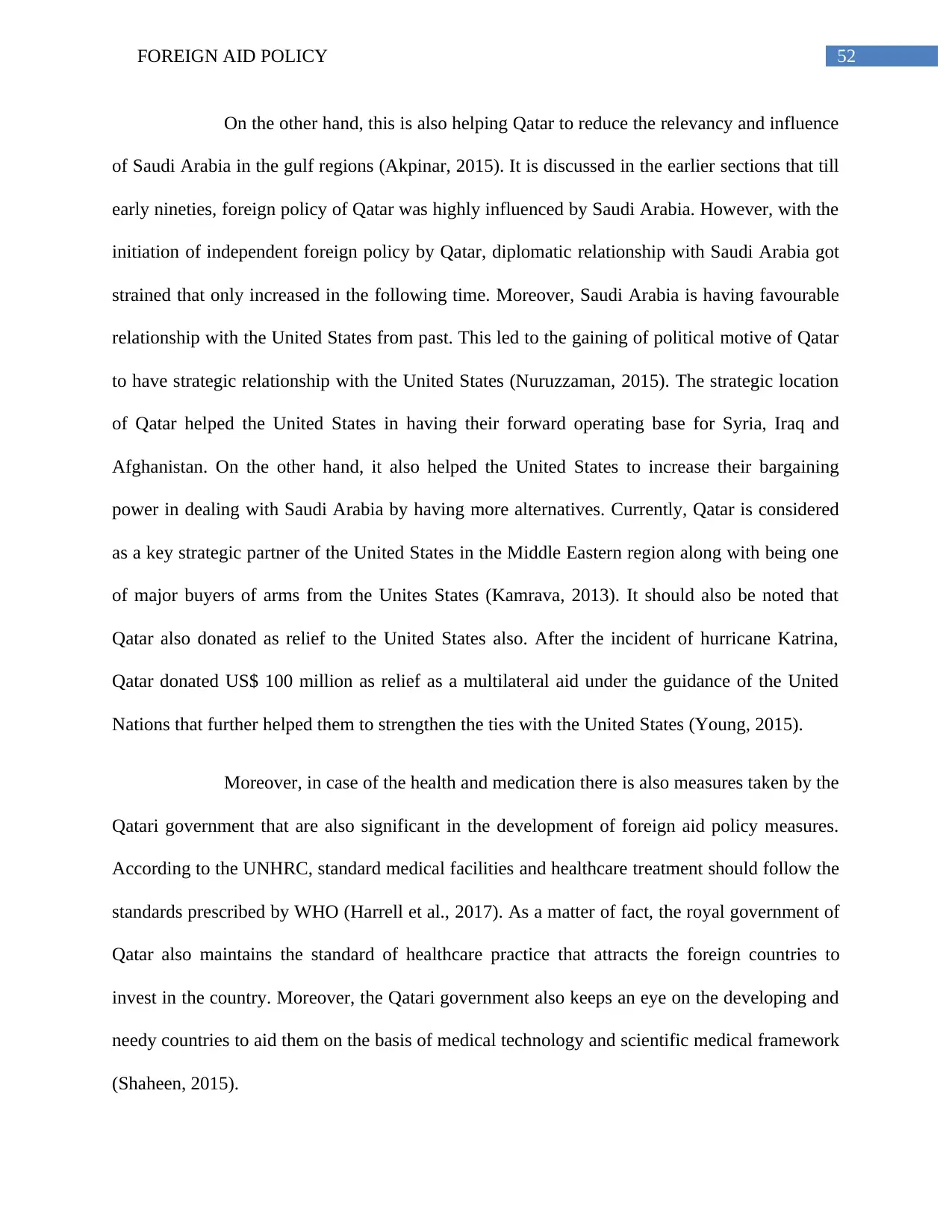
52FOREIGN AID POLICY
On the other hand, this is also helping Qatar to reduce the relevancy and influence
of Saudi Arabia in the gulf regions (Akpinar, 2015). It is discussed in the earlier sections that till
early nineties, foreign policy of Qatar was highly influenced by Saudi Arabia. However, with the
initiation of independent foreign policy by Qatar, diplomatic relationship with Saudi Arabia got
strained that only increased in the following time. Moreover, Saudi Arabia is having favourable
relationship with the United States from past. This led to the gaining of political motive of Qatar
to have strategic relationship with the United States (Nuruzzaman, 2015). The strategic location
of Qatar helped the United States in having their forward operating base for Syria, Iraq and
Afghanistan. On the other hand, it also helped the United States to increase their bargaining
power in dealing with Saudi Arabia by having more alternatives. Currently, Qatar is considered
as a key strategic partner of the United States in the Middle Eastern region along with being one
of major buyers of arms from the Unites States (Kamrava, 2013). It should also be noted that
Qatar also donated as relief to the United States also. After the incident of hurricane Katrina,
Qatar donated US$ 100 million as relief as a multilateral aid under the guidance of the United
Nations that further helped them to strengthen the ties with the United States (Young, 2015).
Moreover, in case of the health and medication there is also measures taken by the
Qatari government that are also significant in the development of foreign aid policy measures.
According to the UNHRC, standard medical facilities and healthcare treatment should follow the
standards prescribed by WHO (Harrell et al., 2017). As a matter of fact, the royal government of
Qatar also maintains the standard of healthcare practice that attracts the foreign countries to
invest in the country. Moreover, the Qatari government also keeps an eye on the developing and
needy countries to aid them on the basis of medical technology and scientific medical framework
(Shaheen, 2015).
On the other hand, this is also helping Qatar to reduce the relevancy and influence
of Saudi Arabia in the gulf regions (Akpinar, 2015). It is discussed in the earlier sections that till
early nineties, foreign policy of Qatar was highly influenced by Saudi Arabia. However, with the
initiation of independent foreign policy by Qatar, diplomatic relationship with Saudi Arabia got
strained that only increased in the following time. Moreover, Saudi Arabia is having favourable
relationship with the United States from past. This led to the gaining of political motive of Qatar
to have strategic relationship with the United States (Nuruzzaman, 2015). The strategic location
of Qatar helped the United States in having their forward operating base for Syria, Iraq and
Afghanistan. On the other hand, it also helped the United States to increase their bargaining
power in dealing with Saudi Arabia by having more alternatives. Currently, Qatar is considered
as a key strategic partner of the United States in the Middle Eastern region along with being one
of major buyers of arms from the Unites States (Kamrava, 2013). It should also be noted that
Qatar also donated as relief to the United States also. After the incident of hurricane Katrina,
Qatar donated US$ 100 million as relief as a multilateral aid under the guidance of the United
Nations that further helped them to strengthen the ties with the United States (Young, 2015).
Moreover, in case of the health and medication there is also measures taken by the
Qatari government that are also significant in the development of foreign aid policy measures.
According to the UNHRC, standard medical facilities and healthcare treatment should follow the
standards prescribed by WHO (Harrell et al., 2017). As a matter of fact, the royal government of
Qatar also maintains the standard of healthcare practice that attracts the foreign countries to
invest in the country. Moreover, the Qatari government also keeps an eye on the developing and
needy countries to aid them on the basis of medical technology and scientific medical framework
(Shaheen, 2015).
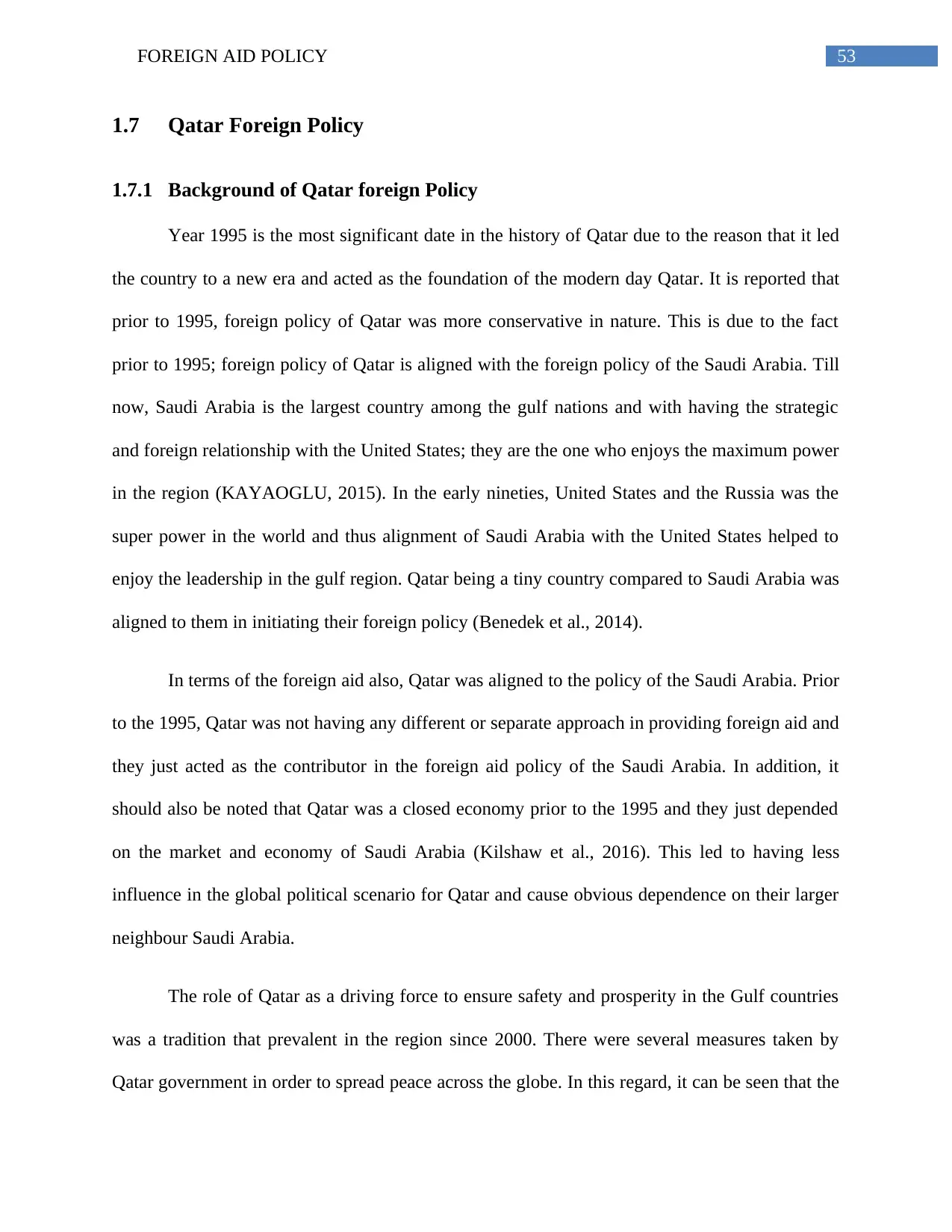
53FOREIGN AID POLICY
1.7 Qatar Foreign Policy
1.7.1 Background of Qatar foreign Policy
Year 1995 is the most significant date in the history of Qatar due to the reason that it led
the country to a new era and acted as the foundation of the modern day Qatar. It is reported that
prior to 1995, foreign policy of Qatar was more conservative in nature. This is due to the fact
prior to 1995; foreign policy of Qatar is aligned with the foreign policy of the Saudi Arabia. Till
now, Saudi Arabia is the largest country among the gulf nations and with having the strategic
and foreign relationship with the United States; they are the one who enjoys the maximum power
in the region (KAYAOGLU, 2015). In the early nineties, United States and the Russia was the
super power in the world and thus alignment of Saudi Arabia with the United States helped to
enjoy the leadership in the gulf region. Qatar being a tiny country compared to Saudi Arabia was
aligned to them in initiating their foreign policy (Benedek et al., 2014).
In terms of the foreign aid also, Qatar was aligned to the policy of the Saudi Arabia. Prior
to the 1995, Qatar was not having any different or separate approach in providing foreign aid and
they just acted as the contributor in the foreign aid policy of the Saudi Arabia. In addition, it
should also be noted that Qatar was a closed economy prior to the 1995 and they just depended
on the market and economy of Saudi Arabia (Kilshaw et al., 2016). This led to having less
influence in the global political scenario for Qatar and cause obvious dependence on their larger
neighbour Saudi Arabia.
The role of Qatar as a driving force to ensure safety and prosperity in the Gulf countries
was a tradition that prevalent in the region since 2000. There were several measures taken by
Qatar government in order to spread peace across the globe. In this regard, it can be seen that the
1.7 Qatar Foreign Policy
1.7.1 Background of Qatar foreign Policy
Year 1995 is the most significant date in the history of Qatar due to the reason that it led
the country to a new era and acted as the foundation of the modern day Qatar. It is reported that
prior to 1995, foreign policy of Qatar was more conservative in nature. This is due to the fact
prior to 1995; foreign policy of Qatar is aligned with the foreign policy of the Saudi Arabia. Till
now, Saudi Arabia is the largest country among the gulf nations and with having the strategic
and foreign relationship with the United States; they are the one who enjoys the maximum power
in the region (KAYAOGLU, 2015). In the early nineties, United States and the Russia was the
super power in the world and thus alignment of Saudi Arabia with the United States helped to
enjoy the leadership in the gulf region. Qatar being a tiny country compared to Saudi Arabia was
aligned to them in initiating their foreign policy (Benedek et al., 2014).
In terms of the foreign aid also, Qatar was aligned to the policy of the Saudi Arabia. Prior
to the 1995, Qatar was not having any different or separate approach in providing foreign aid and
they just acted as the contributor in the foreign aid policy of the Saudi Arabia. In addition, it
should also be noted that Qatar was a closed economy prior to the 1995 and they just depended
on the market and economy of Saudi Arabia (Kilshaw et al., 2016). This led to having less
influence in the global political scenario for Qatar and cause obvious dependence on their larger
neighbour Saudi Arabia.
The role of Qatar as a driving force to ensure safety and prosperity in the Gulf countries
was a tradition that prevalent in the region since 2000. There were several measures taken by
Qatar government in order to spread peace across the globe. In this regard, it can be seen that the
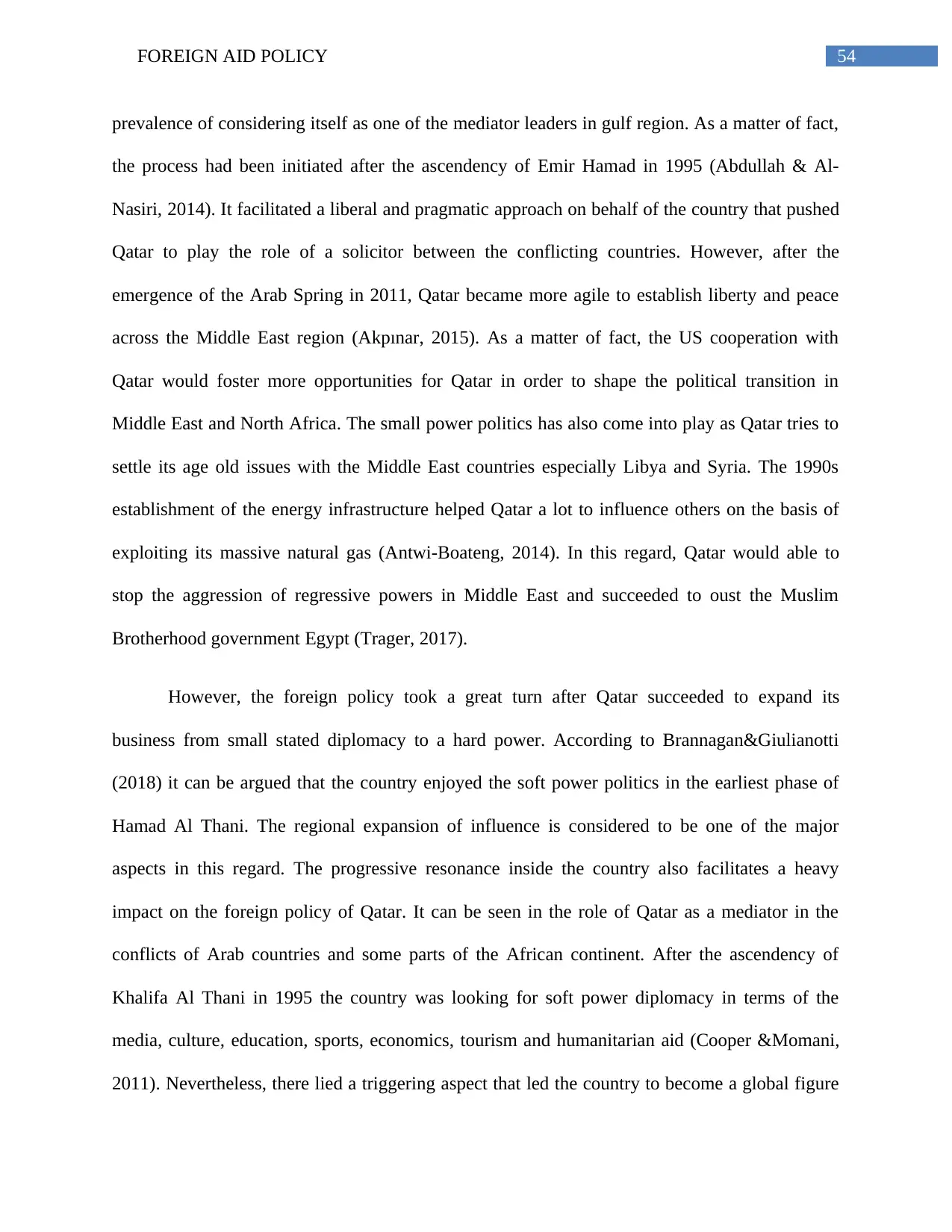
54FOREIGN AID POLICY
prevalence of considering itself as one of the mediator leaders in gulf region. As a matter of fact,
the process had been initiated after the ascendency of Emir Hamad in 1995 (Abdullah & Al-
Nasiri, 2014). It facilitated a liberal and pragmatic approach on behalf of the country that pushed
Qatar to play the role of a solicitor between the conflicting countries. However, after the
emergence of the Arab Spring in 2011, Qatar became more agile to establish liberty and peace
across the Middle East region (Akpınar, 2015). As a matter of fact, the US cooperation with
Qatar would foster more opportunities for Qatar in order to shape the political transition in
Middle East and North Africa. The small power politics has also come into play as Qatar tries to
settle its age old issues with the Middle East countries especially Libya and Syria. The 1990s
establishment of the energy infrastructure helped Qatar a lot to influence others on the basis of
exploiting its massive natural gas (Antwi-Boateng, 2014). In this regard, Qatar would able to
stop the aggression of regressive powers in Middle East and succeeded to oust the Muslim
Brotherhood government Egypt (Trager, 2017).
However, the foreign policy took a great turn after Qatar succeeded to expand its
business from small stated diplomacy to a hard power. According to Brannagan&Giulianotti
(2018) it can be argued that the country enjoyed the soft power politics in the earliest phase of
Hamad Al Thani. The regional expansion of influence is considered to be one of the major
aspects in this regard. The progressive resonance inside the country also facilitates a heavy
impact on the foreign policy of Qatar. It can be seen in the role of Qatar as a mediator in the
conflicts of Arab countries and some parts of the African continent. After the ascendency of
Khalifa Al Thani in 1995 the country was looking for soft power diplomacy in terms of the
media, culture, education, sports, economics, tourism and humanitarian aid (Cooper &Momani,
2011). Nevertheless, there lied a triggering aspect that led the country to become a global figure
prevalence of considering itself as one of the mediator leaders in gulf region. As a matter of fact,
the process had been initiated after the ascendency of Emir Hamad in 1995 (Abdullah & Al-
Nasiri, 2014). It facilitated a liberal and pragmatic approach on behalf of the country that pushed
Qatar to play the role of a solicitor between the conflicting countries. However, after the
emergence of the Arab Spring in 2011, Qatar became more agile to establish liberty and peace
across the Middle East region (Akpınar, 2015). As a matter of fact, the US cooperation with
Qatar would foster more opportunities for Qatar in order to shape the political transition in
Middle East and North Africa. The small power politics has also come into play as Qatar tries to
settle its age old issues with the Middle East countries especially Libya and Syria. The 1990s
establishment of the energy infrastructure helped Qatar a lot to influence others on the basis of
exploiting its massive natural gas (Antwi-Boateng, 2014). In this regard, Qatar would able to
stop the aggression of regressive powers in Middle East and succeeded to oust the Muslim
Brotherhood government Egypt (Trager, 2017).
However, the foreign policy took a great turn after Qatar succeeded to expand its
business from small stated diplomacy to a hard power. According to Brannagan&Giulianotti
(2018) it can be argued that the country enjoyed the soft power politics in the earliest phase of
Hamad Al Thani. The regional expansion of influence is considered to be one of the major
aspects in this regard. The progressive resonance inside the country also facilitates a heavy
impact on the foreign policy of Qatar. It can be seen in the role of Qatar as a mediator in the
conflicts of Arab countries and some parts of the African continent. After the ascendency of
Khalifa Al Thani in 1995 the country was looking for soft power diplomacy in terms of the
media, culture, education, sports, economics, tourism and humanitarian aid (Cooper &Momani,
2011). Nevertheless, there lied a triggering aspect that led the country to become a global figure
Paraphrase This Document
Need a fresh take? Get an instant paraphrase of this document with our AI Paraphraser
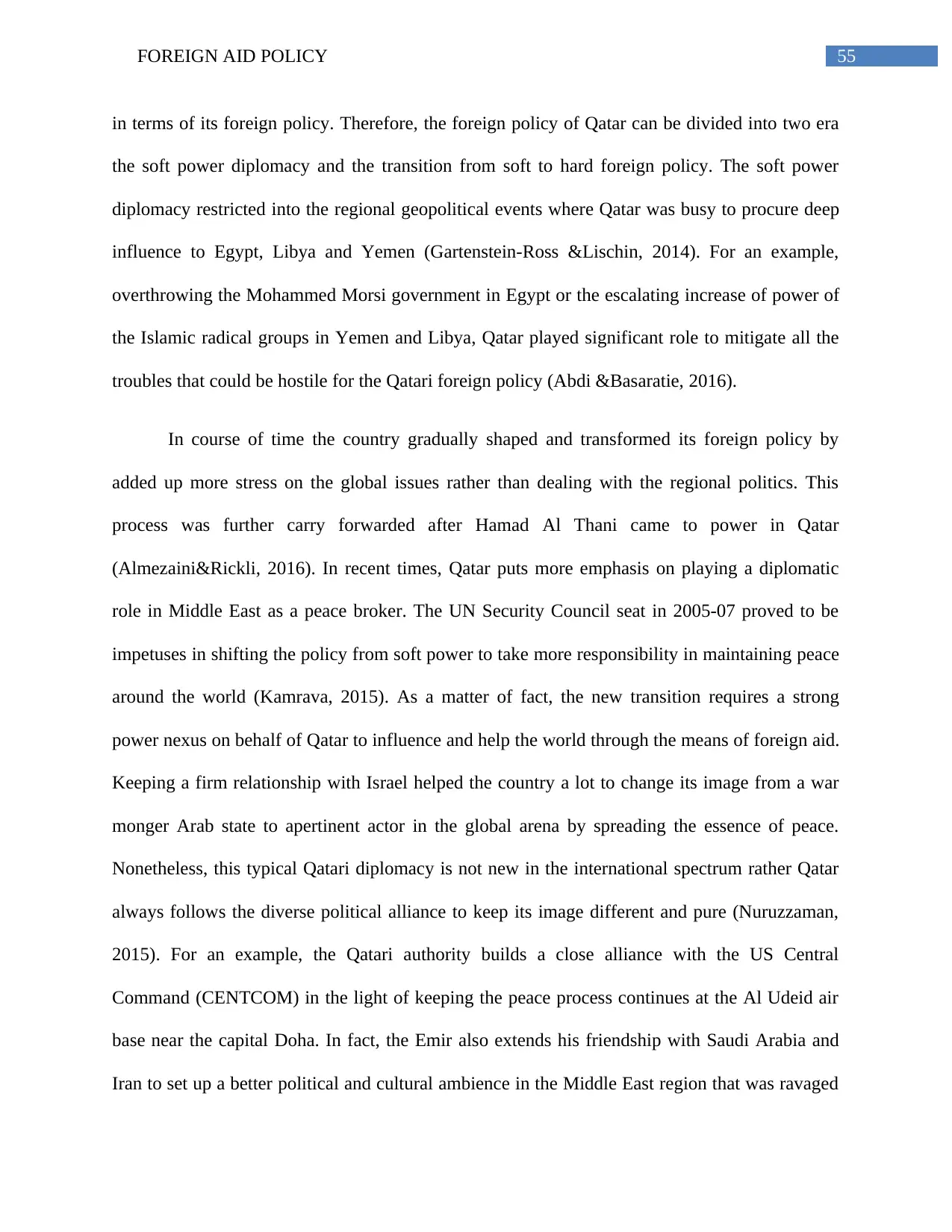
55FOREIGN AID POLICY
in terms of its foreign policy. Therefore, the foreign policy of Qatar can be divided into two era
the soft power diplomacy and the transition from soft to hard foreign policy. The soft power
diplomacy restricted into the regional geopolitical events where Qatar was busy to procure deep
influence to Egypt, Libya and Yemen (Gartenstein-Ross &Lischin, 2014). For an example,
overthrowing the Mohammed Morsi government in Egypt or the escalating increase of power of
the Islamic radical groups in Yemen and Libya, Qatar played significant role to mitigate all the
troubles that could be hostile for the Qatari foreign policy (Abdi &Basaratie, 2016).
In course of time the country gradually shaped and transformed its foreign policy by
added up more stress on the global issues rather than dealing with the regional politics. This
process was further carry forwarded after Hamad Al Thani came to power in Qatar
(Almezaini&Rickli, 2016). In recent times, Qatar puts more emphasis on playing a diplomatic
role in Middle East as a peace broker. The UN Security Council seat in 2005-07 proved to be
impetuses in shifting the policy from soft power to take more responsibility in maintaining peace
around the world (Kamrava, 2015). As a matter of fact, the new transition requires a strong
power nexus on behalf of Qatar to influence and help the world through the means of foreign aid.
Keeping a firm relationship with Israel helped the country a lot to change its image from a war
monger Arab state to apertinent actor in the global arena by spreading the essence of peace.
Nonetheless, this typical Qatari diplomacy is not new in the international spectrum rather Qatar
always follows the diverse political alliance to keep its image different and pure (Nuruzzaman,
2015). For an example, the Qatari authority builds a close alliance with the US Central
Command (CENTCOM) in the light of keeping the peace process continues at the Al Udeid air
base near the capital Doha. In fact, the Emir also extends his friendship with Saudi Arabia and
Iran to set up a better political and cultural ambience in the Middle East region that was ravaged
in terms of its foreign policy. Therefore, the foreign policy of Qatar can be divided into two era
the soft power diplomacy and the transition from soft to hard foreign policy. The soft power
diplomacy restricted into the regional geopolitical events where Qatar was busy to procure deep
influence to Egypt, Libya and Yemen (Gartenstein-Ross &Lischin, 2014). For an example,
overthrowing the Mohammed Morsi government in Egypt or the escalating increase of power of
the Islamic radical groups in Yemen and Libya, Qatar played significant role to mitigate all the
troubles that could be hostile for the Qatari foreign policy (Abdi &Basaratie, 2016).
In course of time the country gradually shaped and transformed its foreign policy by
added up more stress on the global issues rather than dealing with the regional politics. This
process was further carry forwarded after Hamad Al Thani came to power in Qatar
(Almezaini&Rickli, 2016). In recent times, Qatar puts more emphasis on playing a diplomatic
role in Middle East as a peace broker. The UN Security Council seat in 2005-07 proved to be
impetuses in shifting the policy from soft power to take more responsibility in maintaining peace
around the world (Kamrava, 2015). As a matter of fact, the new transition requires a strong
power nexus on behalf of Qatar to influence and help the world through the means of foreign aid.
Keeping a firm relationship with Israel helped the country a lot to change its image from a war
monger Arab state to apertinent actor in the global arena by spreading the essence of peace.
Nonetheless, this typical Qatari diplomacy is not new in the international spectrum rather Qatar
always follows the diverse political alliance to keep its image different and pure (Nuruzzaman,
2015). For an example, the Qatari authority builds a close alliance with the US Central
Command (CENTCOM) in the light of keeping the peace process continues at the Al Udeid air
base near the capital Doha. In fact, the Emir also extends his friendship with Saudi Arabia and
Iran to set up a better political and cultural ambience in the Middle East region that was ravaged
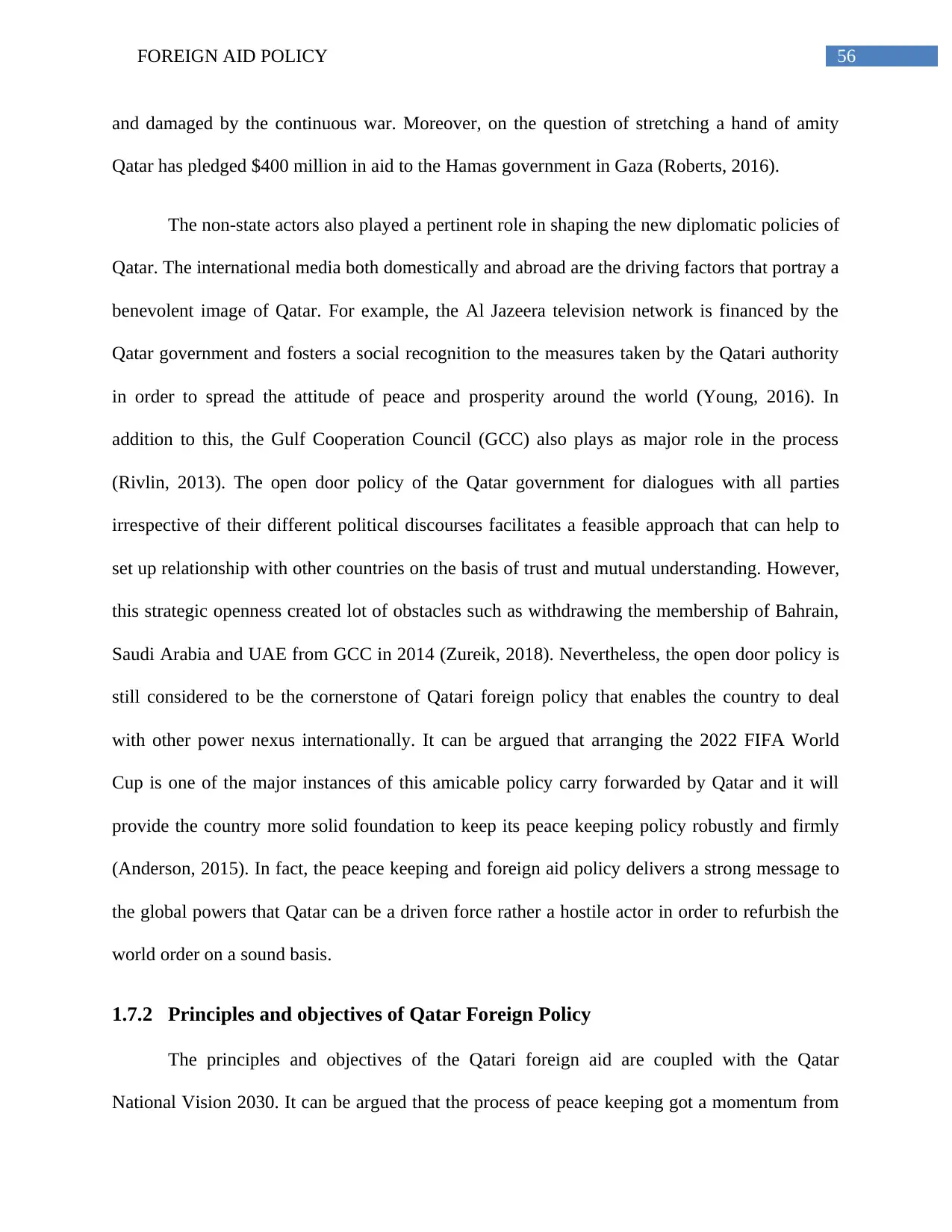
56FOREIGN AID POLICY
and damaged by the continuous war. Moreover, on the question of stretching a hand of amity
Qatar has pledged $400 million in aid to the Hamas government in Gaza (Roberts, 2016).
The non-state actors also played a pertinent role in shaping the new diplomatic policies of
Qatar. The international media both domestically and abroad are the driving factors that portray a
benevolent image of Qatar. For example, the Al Jazeera television network is financed by the
Qatar government and fosters a social recognition to the measures taken by the Qatari authority
in order to spread the attitude of peace and prosperity around the world (Young, 2016). In
addition to this, the Gulf Cooperation Council (GCC) also plays as major role in the process
(Rivlin, 2013). The open door policy of the Qatar government for dialogues with all parties
irrespective of their different political discourses facilitates a feasible approach that can help to
set up relationship with other countries on the basis of trust and mutual understanding. However,
this strategic openness created lot of obstacles such as withdrawing the membership of Bahrain,
Saudi Arabia and UAE from GCC in 2014 (Zureik, 2018). Nevertheless, the open door policy is
still considered to be the cornerstone of Qatari foreign policy that enables the country to deal
with other power nexus internationally. It can be argued that arranging the 2022 FIFA World
Cup is one of the major instances of this amicable policy carry forwarded by Qatar and it will
provide the country more solid foundation to keep its peace keeping policy robustly and firmly
(Anderson, 2015). In fact, the peace keeping and foreign aid policy delivers a strong message to
the global powers that Qatar can be a driven force rather a hostile actor in order to refurbish the
world order on a sound basis.
1.7.2 Principles and objectives of Qatar Foreign Policy
The principles and objectives of the Qatari foreign aid are coupled with the Qatar
National Vision 2030. It can be argued that the process of peace keeping got a momentum from
and damaged by the continuous war. Moreover, on the question of stretching a hand of amity
Qatar has pledged $400 million in aid to the Hamas government in Gaza (Roberts, 2016).
The non-state actors also played a pertinent role in shaping the new diplomatic policies of
Qatar. The international media both domestically and abroad are the driving factors that portray a
benevolent image of Qatar. For example, the Al Jazeera television network is financed by the
Qatar government and fosters a social recognition to the measures taken by the Qatari authority
in order to spread the attitude of peace and prosperity around the world (Young, 2016). In
addition to this, the Gulf Cooperation Council (GCC) also plays as major role in the process
(Rivlin, 2013). The open door policy of the Qatar government for dialogues with all parties
irrespective of their different political discourses facilitates a feasible approach that can help to
set up relationship with other countries on the basis of trust and mutual understanding. However,
this strategic openness created lot of obstacles such as withdrawing the membership of Bahrain,
Saudi Arabia and UAE from GCC in 2014 (Zureik, 2018). Nevertheless, the open door policy is
still considered to be the cornerstone of Qatari foreign policy that enables the country to deal
with other power nexus internationally. It can be argued that arranging the 2022 FIFA World
Cup is one of the major instances of this amicable policy carry forwarded by Qatar and it will
provide the country more solid foundation to keep its peace keeping policy robustly and firmly
(Anderson, 2015). In fact, the peace keeping and foreign aid policy delivers a strong message to
the global powers that Qatar can be a driven force rather a hostile actor in order to refurbish the
world order on a sound basis.
1.7.2 Principles and objectives of Qatar Foreign Policy
The principles and objectives of the Qatari foreign aid are coupled with the Qatar
National Vision 2030. It can be argued that the process of peace keeping got a momentum from
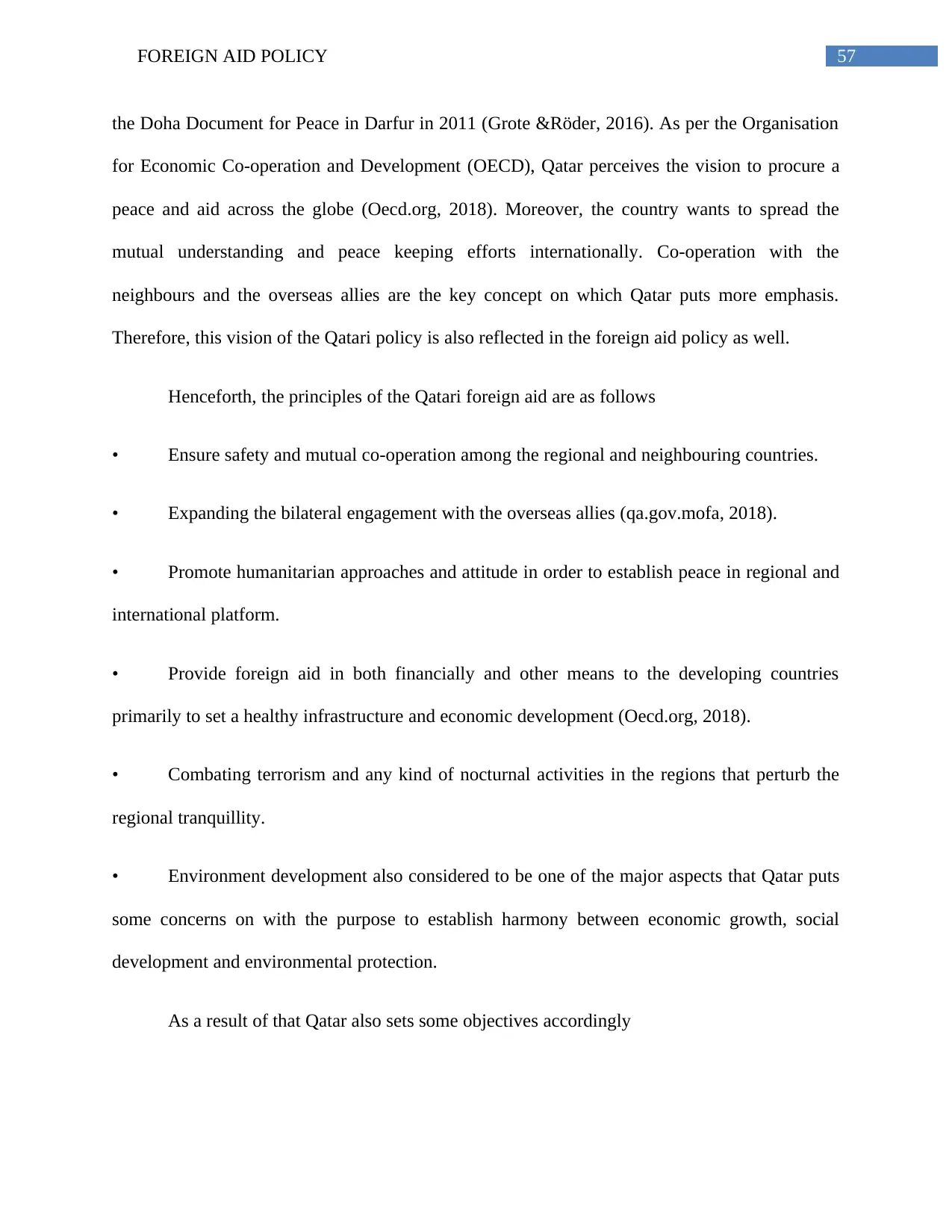
57FOREIGN AID POLICY
the Doha Document for Peace in Darfur in 2011 (Grote &Röder, 2016). As per the Organisation
for Economic Co-operation and Development (OECD), Qatar perceives the vision to procure a
peace and aid across the globe (Oecd.org, 2018). Moreover, the country wants to spread the
mutual understanding and peace keeping efforts internationally. Co-operation with the
neighbours and the overseas allies are the key concept on which Qatar puts more emphasis.
Therefore, this vision of the Qatari policy is also reflected in the foreign aid policy as well.
Henceforth, the principles of the Qatari foreign aid are as follows
• Ensure safety and mutual co-operation among the regional and neighbouring countries.
• Expanding the bilateral engagement with the overseas allies (qa.gov.mofa, 2018).
• Promote humanitarian approaches and attitude in order to establish peace in regional and
international platform.
• Provide foreign aid in both financially and other means to the developing countries
primarily to set a healthy infrastructure and economic development (Oecd.org, 2018).
• Combating terrorism and any kind of nocturnal activities in the regions that perturb the
regional tranquillity.
• Environment development also considered to be one of the major aspects that Qatar puts
some concerns on with the purpose to establish harmony between economic growth, social
development and environmental protection.
As a result of that Qatar also sets some objectives accordingly
the Doha Document for Peace in Darfur in 2011 (Grote &Röder, 2016). As per the Organisation
for Economic Co-operation and Development (OECD), Qatar perceives the vision to procure a
peace and aid across the globe (Oecd.org, 2018). Moreover, the country wants to spread the
mutual understanding and peace keeping efforts internationally. Co-operation with the
neighbours and the overseas allies are the key concept on which Qatar puts more emphasis.
Therefore, this vision of the Qatari policy is also reflected in the foreign aid policy as well.
Henceforth, the principles of the Qatari foreign aid are as follows
• Ensure safety and mutual co-operation among the regional and neighbouring countries.
• Expanding the bilateral engagement with the overseas allies (qa.gov.mofa, 2018).
• Promote humanitarian approaches and attitude in order to establish peace in regional and
international platform.
• Provide foreign aid in both financially and other means to the developing countries
primarily to set a healthy infrastructure and economic development (Oecd.org, 2018).
• Combating terrorism and any kind of nocturnal activities in the regions that perturb the
regional tranquillity.
• Environment development also considered to be one of the major aspects that Qatar puts
some concerns on with the purpose to establish harmony between economic growth, social
development and environmental protection.
As a result of that Qatar also sets some objectives accordingly
Secure Best Marks with AI Grader
Need help grading? Try our AI Grader for instant feedback on your assignments.
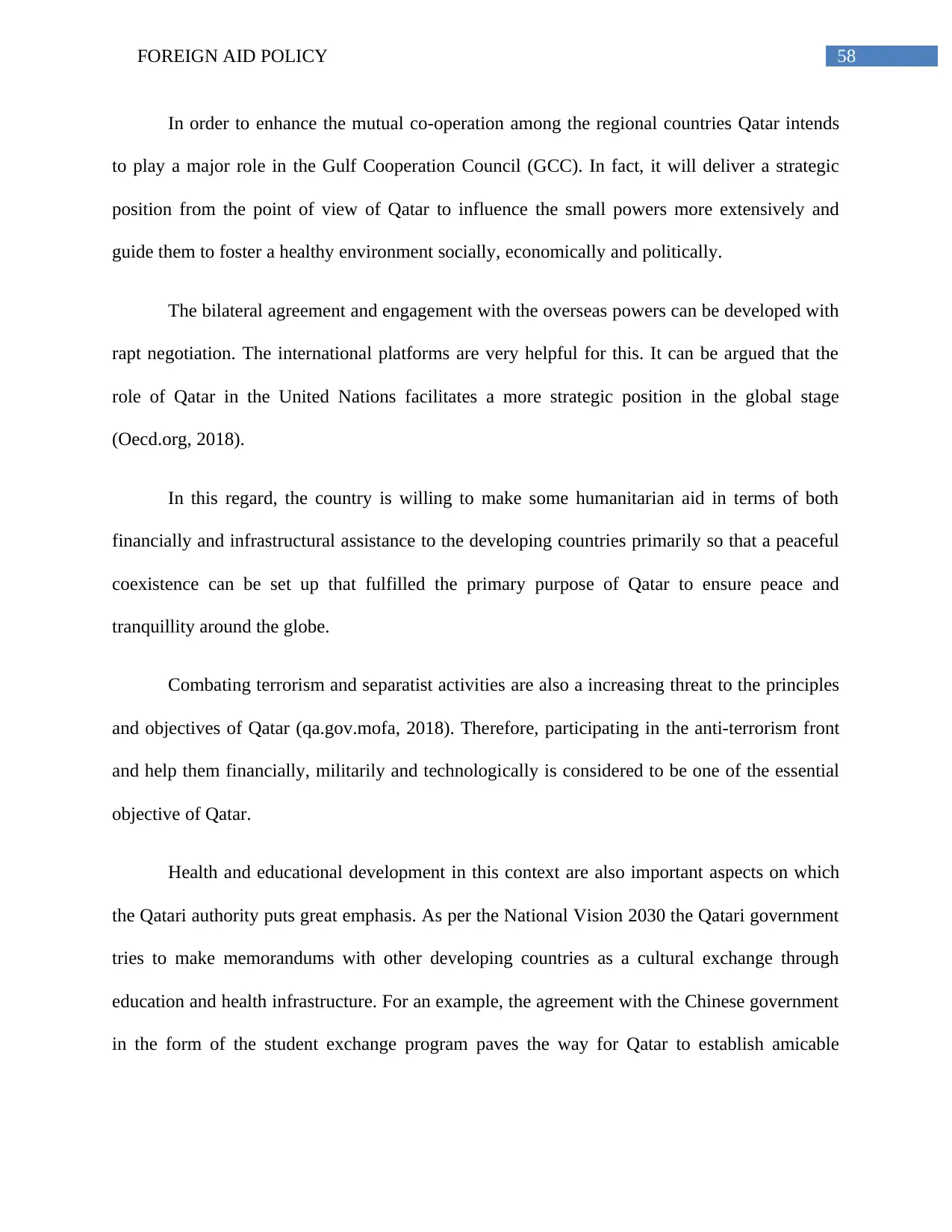
58FOREIGN AID POLICY
In order to enhance the mutual co-operation among the regional countries Qatar intends
to play a major role in the Gulf Cooperation Council (GCC). In fact, it will deliver a strategic
position from the point of view of Qatar to influence the small powers more extensively and
guide them to foster a healthy environment socially, economically and politically.
The bilateral agreement and engagement with the overseas powers can be developed with
rapt negotiation. The international platforms are very helpful for this. It can be argued that the
role of Qatar in the United Nations facilitates a more strategic position in the global stage
(Oecd.org, 2018).
In this regard, the country is willing to make some humanitarian aid in terms of both
financially and infrastructural assistance to the developing countries primarily so that a peaceful
coexistence can be set up that fulfilled the primary purpose of Qatar to ensure peace and
tranquillity around the globe.
Combating terrorism and separatist activities are also a increasing threat to the principles
and objectives of Qatar (qa.gov.mofa, 2018). Therefore, participating in the anti-terrorism front
and help them financially, militarily and technologically is considered to be one of the essential
objective of Qatar.
Health and educational development in this context are also important aspects on which
the Qatari authority puts great emphasis. As per the National Vision 2030 the Qatari government
tries to make memorandums with other developing countries as a cultural exchange through
education and health infrastructure. For an example, the agreement with the Chinese government
in the form of the student exchange program paves the way for Qatar to establish amicable
In order to enhance the mutual co-operation among the regional countries Qatar intends
to play a major role in the Gulf Cooperation Council (GCC). In fact, it will deliver a strategic
position from the point of view of Qatar to influence the small powers more extensively and
guide them to foster a healthy environment socially, economically and politically.
The bilateral agreement and engagement with the overseas powers can be developed with
rapt negotiation. The international platforms are very helpful for this. It can be argued that the
role of Qatar in the United Nations facilitates a more strategic position in the global stage
(Oecd.org, 2018).
In this regard, the country is willing to make some humanitarian aid in terms of both
financially and infrastructural assistance to the developing countries primarily so that a peaceful
coexistence can be set up that fulfilled the primary purpose of Qatar to ensure peace and
tranquillity around the globe.
Combating terrorism and separatist activities are also a increasing threat to the principles
and objectives of Qatar (qa.gov.mofa, 2018). Therefore, participating in the anti-terrorism front
and help them financially, militarily and technologically is considered to be one of the essential
objective of Qatar.
Health and educational development in this context are also important aspects on which
the Qatari authority puts great emphasis. As per the National Vision 2030 the Qatari government
tries to make memorandums with other developing countries as a cultural exchange through
education and health infrastructure. For an example, the agreement with the Chinese government
in the form of the student exchange program paves the way for Qatar to establish amicable
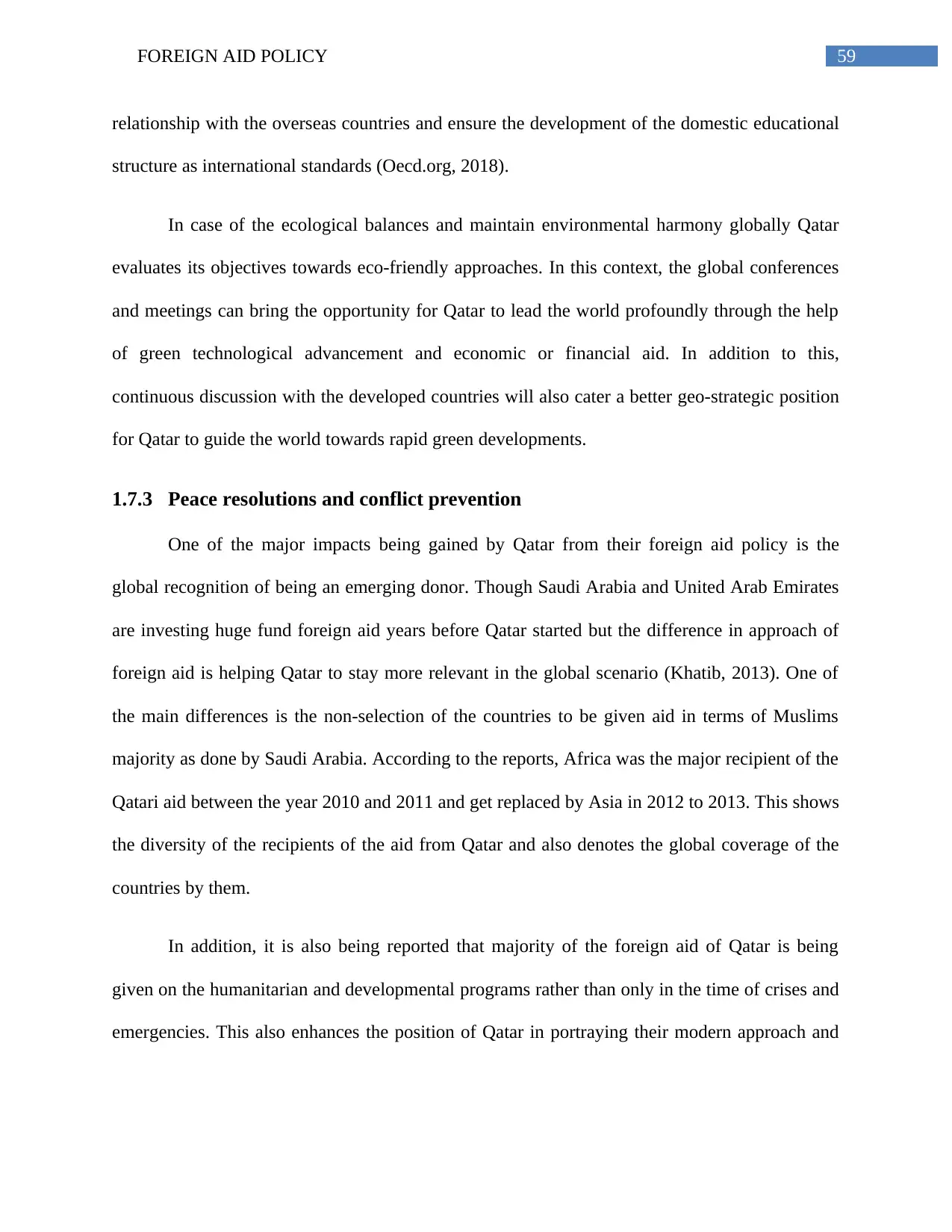
59FOREIGN AID POLICY
relationship with the overseas countries and ensure the development of the domestic educational
structure as international standards (Oecd.org, 2018).
In case of the ecological balances and maintain environmental harmony globally Qatar
evaluates its objectives towards eco-friendly approaches. In this context, the global conferences
and meetings can bring the opportunity for Qatar to lead the world profoundly through the help
of green technological advancement and economic or financial aid. In addition to this,
continuous discussion with the developed countries will also cater a better geo-strategic position
for Qatar to guide the world towards rapid green developments.
1.7.3 Peace resolutions and conflict prevention
One of the major impacts being gained by Qatar from their foreign aid policy is the
global recognition of being an emerging donor. Though Saudi Arabia and United Arab Emirates
are investing huge fund foreign aid years before Qatar started but the difference in approach of
foreign aid is helping Qatar to stay more relevant in the global scenario (Khatib, 2013). One of
the main differences is the non-selection of the countries to be given aid in terms of Muslims
majority as done by Saudi Arabia. According to the reports, Africa was the major recipient of the
Qatari aid between the year 2010 and 2011 and get replaced by Asia in 2012 to 2013. This shows
the diversity of the recipients of the aid from Qatar and also denotes the global coverage of the
countries by them.
In addition, it is also being reported that majority of the foreign aid of Qatar is being
given on the humanitarian and developmental programs rather than only in the time of crises and
emergencies. This also enhances the position of Qatar in portraying their modern approach and
relationship with the overseas countries and ensure the development of the domestic educational
structure as international standards (Oecd.org, 2018).
In case of the ecological balances and maintain environmental harmony globally Qatar
evaluates its objectives towards eco-friendly approaches. In this context, the global conferences
and meetings can bring the opportunity for Qatar to lead the world profoundly through the help
of green technological advancement and economic or financial aid. In addition to this,
continuous discussion with the developed countries will also cater a better geo-strategic position
for Qatar to guide the world towards rapid green developments.
1.7.3 Peace resolutions and conflict prevention
One of the major impacts being gained by Qatar from their foreign aid policy is the
global recognition of being an emerging donor. Though Saudi Arabia and United Arab Emirates
are investing huge fund foreign aid years before Qatar started but the difference in approach of
foreign aid is helping Qatar to stay more relevant in the global scenario (Khatib, 2013). One of
the main differences is the non-selection of the countries to be given aid in terms of Muslims
majority as done by Saudi Arabia. According to the reports, Africa was the major recipient of the
Qatari aid between the year 2010 and 2011 and get replaced by Asia in 2012 to 2013. This shows
the diversity of the recipients of the aid from Qatar and also denotes the global coverage of the
countries by them.
In addition, it is also being reported that majority of the foreign aid of Qatar is being
given on the humanitarian and developmental programs rather than only in the time of crises and
emergencies. This also enhances the position of Qatar in portraying their modern approach and
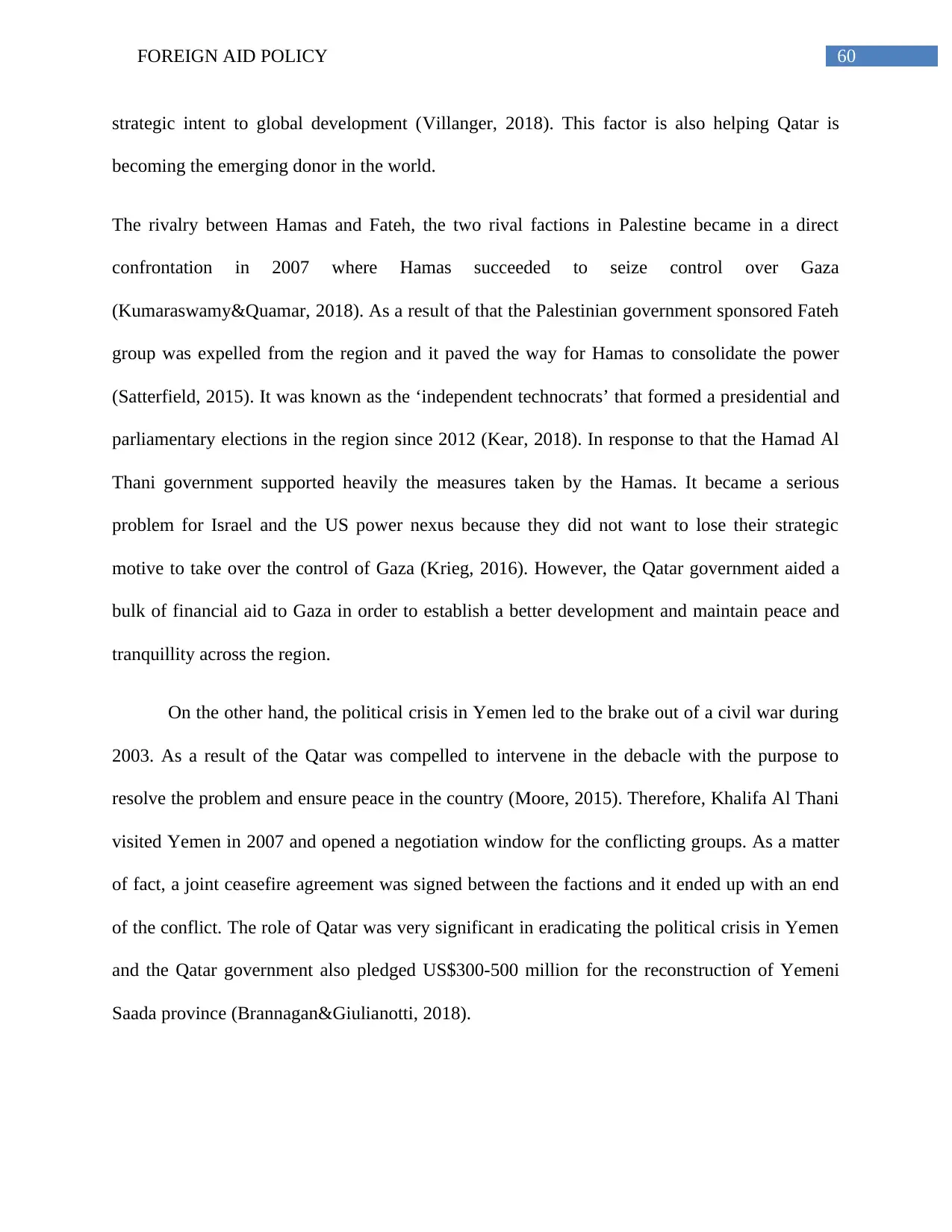
60FOREIGN AID POLICY
strategic intent to global development (Villanger, 2018). This factor is also helping Qatar is
becoming the emerging donor in the world.
The rivalry between Hamas and Fateh, the two rival factions in Palestine became in a direct
confrontation in 2007 where Hamas succeeded to seize control over Gaza
(Kumaraswamy&Quamar, 2018). As a result of that the Palestinian government sponsored Fateh
group was expelled from the region and it paved the way for Hamas to consolidate the power
(Satterfield, 2015). It was known as the ‘independent technocrats’ that formed a presidential and
parliamentary elections in the region since 2012 (Kear, 2018). In response to that the Hamad Al
Thani government supported heavily the measures taken by the Hamas. It became a serious
problem for Israel and the US power nexus because they did not want to lose their strategic
motive to take over the control of Gaza (Krieg, 2016). However, the Qatar government aided a
bulk of financial aid to Gaza in order to establish a better development and maintain peace and
tranquillity across the region.
On the other hand, the political crisis in Yemen led to the brake out of a civil war during
2003. As a result of the Qatar was compelled to intervene in the debacle with the purpose to
resolve the problem and ensure peace in the country (Moore, 2015). Therefore, Khalifa Al Thani
visited Yemen in 2007 and opened a negotiation window for the conflicting groups. As a matter
of fact, a joint ceasefire agreement was signed between the factions and it ended up with an end
of the conflict. The role of Qatar was very significant in eradicating the political crisis in Yemen
and the Qatar government also pledged US$300-500 million for the reconstruction of Yemeni
Saada province (Brannagan&Giulianotti, 2018).
strategic intent to global development (Villanger, 2018). This factor is also helping Qatar is
becoming the emerging donor in the world.
The rivalry between Hamas and Fateh, the two rival factions in Palestine became in a direct
confrontation in 2007 where Hamas succeeded to seize control over Gaza
(Kumaraswamy&Quamar, 2018). As a result of that the Palestinian government sponsored Fateh
group was expelled from the region and it paved the way for Hamas to consolidate the power
(Satterfield, 2015). It was known as the ‘independent technocrats’ that formed a presidential and
parliamentary elections in the region since 2012 (Kear, 2018). In response to that the Hamad Al
Thani government supported heavily the measures taken by the Hamas. It became a serious
problem for Israel and the US power nexus because they did not want to lose their strategic
motive to take over the control of Gaza (Krieg, 2016). However, the Qatar government aided a
bulk of financial aid to Gaza in order to establish a better development and maintain peace and
tranquillity across the region.
On the other hand, the political crisis in Yemen led to the brake out of a civil war during
2003. As a result of the Qatar was compelled to intervene in the debacle with the purpose to
resolve the problem and ensure peace in the country (Moore, 2015). Therefore, Khalifa Al Thani
visited Yemen in 2007 and opened a negotiation window for the conflicting groups. As a matter
of fact, a joint ceasefire agreement was signed between the factions and it ended up with an end
of the conflict. The role of Qatar was very significant in eradicating the political crisis in Yemen
and the Qatar government also pledged US$300-500 million for the reconstruction of Yemeni
Saada province (Brannagan&Giulianotti, 2018).
Paraphrase This Document
Need a fresh take? Get an instant paraphrase of this document with our AI Paraphraser
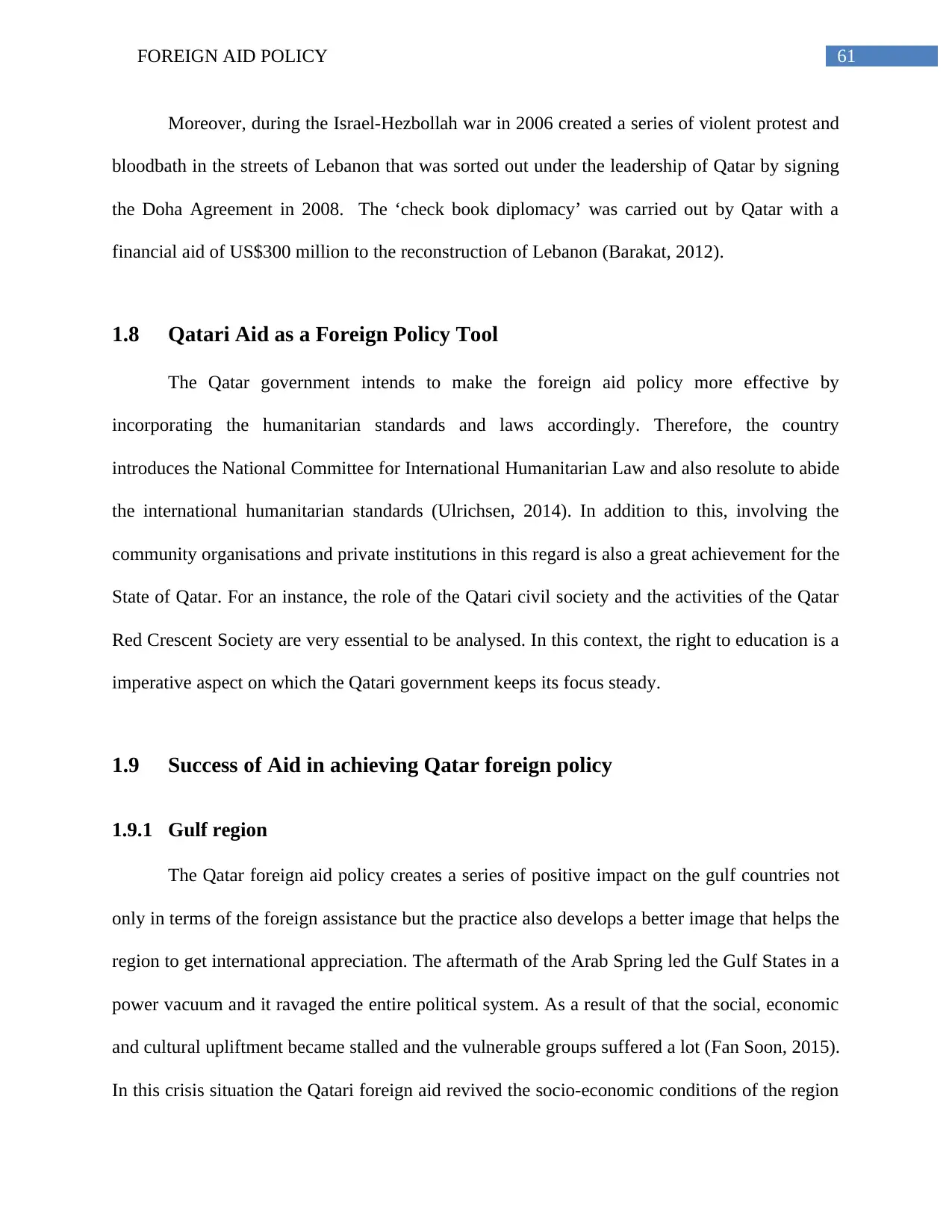
61FOREIGN AID POLICY
Moreover, during the Israel-Hezbollah war in 2006 created a series of violent protest and
bloodbath in the streets of Lebanon that was sorted out under the leadership of Qatar by signing
the Doha Agreement in 2008. The ‘check book diplomacy’ was carried out by Qatar with a
financial aid of US$300 million to the reconstruction of Lebanon (Barakat, 2012).
1.8 Qatari Aid as a Foreign Policy Tool
The Qatar government intends to make the foreign aid policy more effective by
incorporating the humanitarian standards and laws accordingly. Therefore, the country
introduces the National Committee for International Humanitarian Law and also resolute to abide
the international humanitarian standards (Ulrichsen, 2014). In addition to this, involving the
community organisations and private institutions in this regard is also a great achievement for the
State of Qatar. For an instance, the role of the Qatari civil society and the activities of the Qatar
Red Crescent Society are very essential to be analysed. In this context, the right to education is a
imperative aspect on which the Qatari government keeps its focus steady.
1.9 Success of Aid in achieving Qatar foreign policy
1.9.1 Gulf region
The Qatar foreign aid policy creates a series of positive impact on the gulf countries not
only in terms of the foreign assistance but the practice also develops a better image that helps the
region to get international appreciation. The aftermath of the Arab Spring led the Gulf States in a
power vacuum and it ravaged the entire political system. As a result of that the social, economic
and cultural upliftment became stalled and the vulnerable groups suffered a lot (Fan Soon, 2015).
In this crisis situation the Qatari foreign aid revived the socio-economic conditions of the region
Moreover, during the Israel-Hezbollah war in 2006 created a series of violent protest and
bloodbath in the streets of Lebanon that was sorted out under the leadership of Qatar by signing
the Doha Agreement in 2008. The ‘check book diplomacy’ was carried out by Qatar with a
financial aid of US$300 million to the reconstruction of Lebanon (Barakat, 2012).
1.8 Qatari Aid as a Foreign Policy Tool
The Qatar government intends to make the foreign aid policy more effective by
incorporating the humanitarian standards and laws accordingly. Therefore, the country
introduces the National Committee for International Humanitarian Law and also resolute to abide
the international humanitarian standards (Ulrichsen, 2014). In addition to this, involving the
community organisations and private institutions in this regard is also a great achievement for the
State of Qatar. For an instance, the role of the Qatari civil society and the activities of the Qatar
Red Crescent Society are very essential to be analysed. In this context, the right to education is a
imperative aspect on which the Qatari government keeps its focus steady.
1.9 Success of Aid in achieving Qatar foreign policy
1.9.1 Gulf region
The Qatar foreign aid policy creates a series of positive impact on the gulf countries not
only in terms of the foreign assistance but the practice also develops a better image that helps the
region to get international appreciation. The aftermath of the Arab Spring led the Gulf States in a
power vacuum and it ravaged the entire political system. As a result of that the social, economic
and cultural upliftment became stalled and the vulnerable groups suffered a lot (Fan Soon, 2015).
In this crisis situation the Qatari foreign aid revived the socio-economic conditions of the region
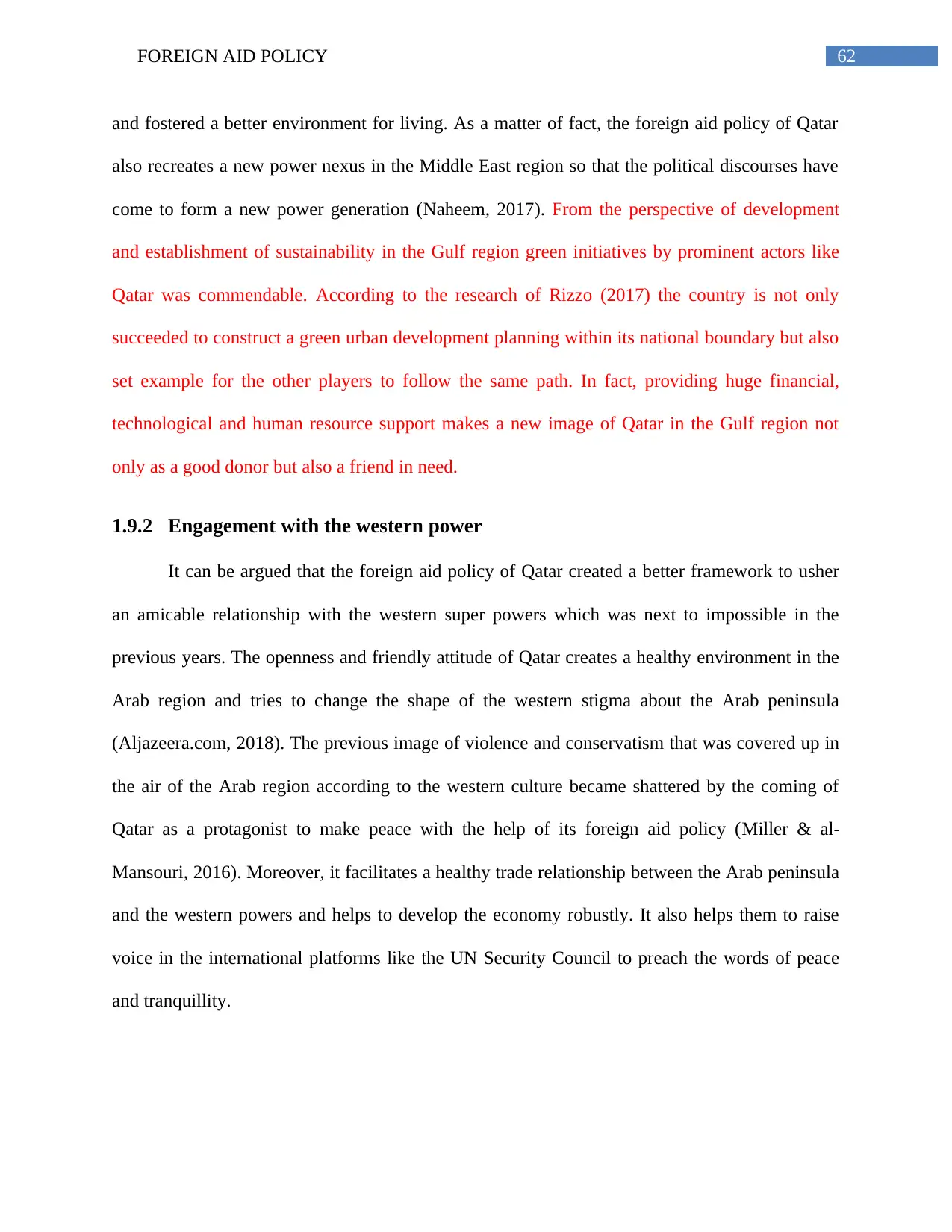
62FOREIGN AID POLICY
and fostered a better environment for living. As a matter of fact, the foreign aid policy of Qatar
also recreates a new power nexus in the Middle East region so that the political discourses have
come to form a new power generation (Naheem, 2017). From the perspective of development
and establishment of sustainability in the Gulf region green initiatives by prominent actors like
Qatar was commendable. According to the research of Rizzo (2017) the country is not only
succeeded to construct a green urban development planning within its national boundary but also
set example for the other players to follow the same path. In fact, providing huge financial,
technological and human resource support makes a new image of Qatar in the Gulf region not
only as a good donor but also a friend in need.
1.9.2 Engagement with the western power
It can be argued that the foreign aid policy of Qatar created a better framework to usher
an amicable relationship with the western super powers which was next to impossible in the
previous years. The openness and friendly attitude of Qatar creates a healthy environment in the
Arab region and tries to change the shape of the western stigma about the Arab peninsula
(Aljazeera.com, 2018). The previous image of violence and conservatism that was covered up in
the air of the Arab region according to the western culture became shattered by the coming of
Qatar as a protagonist to make peace with the help of its foreign aid policy (Miller & al-
Mansouri, 2016). Moreover, it facilitates a healthy trade relationship between the Arab peninsula
and the western powers and helps to develop the economy robustly. It also helps them to raise
voice in the international platforms like the UN Security Council to preach the words of peace
and tranquillity.
and fostered a better environment for living. As a matter of fact, the foreign aid policy of Qatar
also recreates a new power nexus in the Middle East region so that the political discourses have
come to form a new power generation (Naheem, 2017). From the perspective of development
and establishment of sustainability in the Gulf region green initiatives by prominent actors like
Qatar was commendable. According to the research of Rizzo (2017) the country is not only
succeeded to construct a green urban development planning within its national boundary but also
set example for the other players to follow the same path. In fact, providing huge financial,
technological and human resource support makes a new image of Qatar in the Gulf region not
only as a good donor but also a friend in need.
1.9.2 Engagement with the western power
It can be argued that the foreign aid policy of Qatar created a better framework to usher
an amicable relationship with the western super powers which was next to impossible in the
previous years. The openness and friendly attitude of Qatar creates a healthy environment in the
Arab region and tries to change the shape of the western stigma about the Arab peninsula
(Aljazeera.com, 2018). The previous image of violence and conservatism that was covered up in
the air of the Arab region according to the western culture became shattered by the coming of
Qatar as a protagonist to make peace with the help of its foreign aid policy (Miller & al-
Mansouri, 2016). Moreover, it facilitates a healthy trade relationship between the Arab peninsula
and the western powers and helps to develop the economy robustly. It also helps them to raise
voice in the international platforms like the UN Security Council to preach the words of peace
and tranquillity.
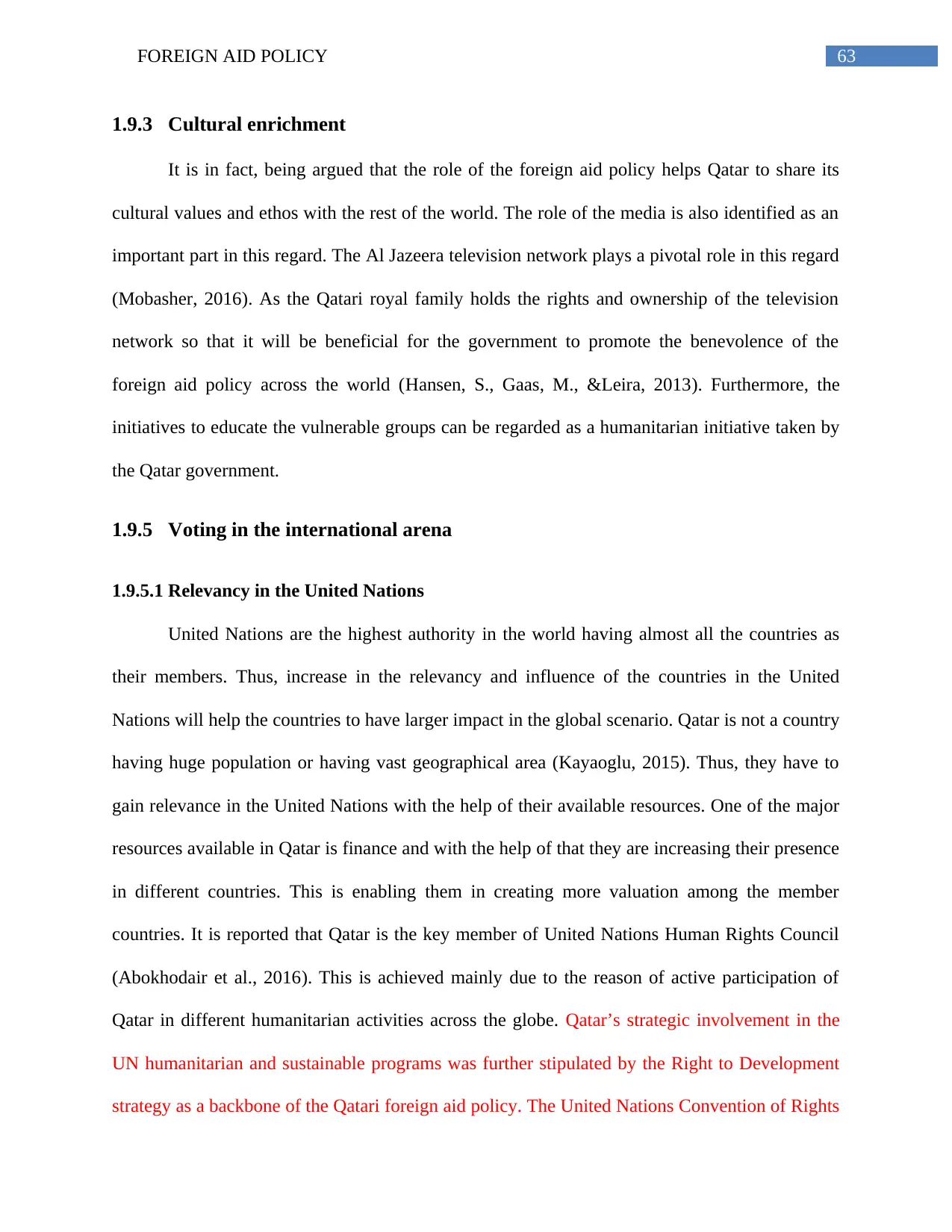
63FOREIGN AID POLICY
1.9.3 Cultural enrichment
It is in fact, being argued that the role of the foreign aid policy helps Qatar to share its
cultural values and ethos with the rest of the world. The role of the media is also identified as an
important part in this regard. The Al Jazeera television network plays a pivotal role in this regard
(Mobasher, 2016). As the Qatari royal family holds the rights and ownership of the television
network so that it will be beneficial for the government to promote the benevolence of the
foreign aid policy across the world (Hansen, S., Gaas, M., &Leira, 2013). Furthermore, the
initiatives to educate the vulnerable groups can be regarded as a humanitarian initiative taken by
the Qatar government.
1.9.5 Voting in the international arena
1.9.5.1 Relevancy in the United Nations
United Nations are the highest authority in the world having almost all the countries as
their members. Thus, increase in the relevancy and influence of the countries in the United
Nations will help the countries to have larger impact in the global scenario. Qatar is not a country
having huge population or having vast geographical area (Kayaoglu, 2015). Thus, they have to
gain relevance in the United Nations with the help of their available resources. One of the major
resources available in Qatar is finance and with the help of that they are increasing their presence
in different countries. This is enabling them in creating more valuation among the member
countries. It is reported that Qatar is the key member of United Nations Human Rights Council
(Abokhodair et al., 2016). This is achieved mainly due to the reason of active participation of
Qatar in different humanitarian activities across the globe. Qatar’s strategic involvement in the
UN humanitarian and sustainable programs was further stipulated by the Right to Development
strategy as a backbone of the Qatari foreign aid policy. The United Nations Convention of Rights
1.9.3 Cultural enrichment
It is in fact, being argued that the role of the foreign aid policy helps Qatar to share its
cultural values and ethos with the rest of the world. The role of the media is also identified as an
important part in this regard. The Al Jazeera television network plays a pivotal role in this regard
(Mobasher, 2016). As the Qatari royal family holds the rights and ownership of the television
network so that it will be beneficial for the government to promote the benevolence of the
foreign aid policy across the world (Hansen, S., Gaas, M., &Leira, 2013). Furthermore, the
initiatives to educate the vulnerable groups can be regarded as a humanitarian initiative taken by
the Qatar government.
1.9.5 Voting in the international arena
1.9.5.1 Relevancy in the United Nations
United Nations are the highest authority in the world having almost all the countries as
their members. Thus, increase in the relevancy and influence of the countries in the United
Nations will help the countries to have larger impact in the global scenario. Qatar is not a country
having huge population or having vast geographical area (Kayaoglu, 2015). Thus, they have to
gain relevance in the United Nations with the help of their available resources. One of the major
resources available in Qatar is finance and with the help of that they are increasing their presence
in different countries. This is enabling them in creating more valuation among the member
countries. It is reported that Qatar is the key member of United Nations Human Rights Council
(Abokhodair et al., 2016). This is achieved mainly due to the reason of active participation of
Qatar in different humanitarian activities across the globe. Qatar’s strategic involvement in the
UN humanitarian and sustainable programs was further stipulated by the Right to Development
strategy as a backbone of the Qatari foreign aid policy. The United Nations Convention of Rights
Secure Best Marks with AI Grader
Need help grading? Try our AI Grader for instant feedback on your assignments.
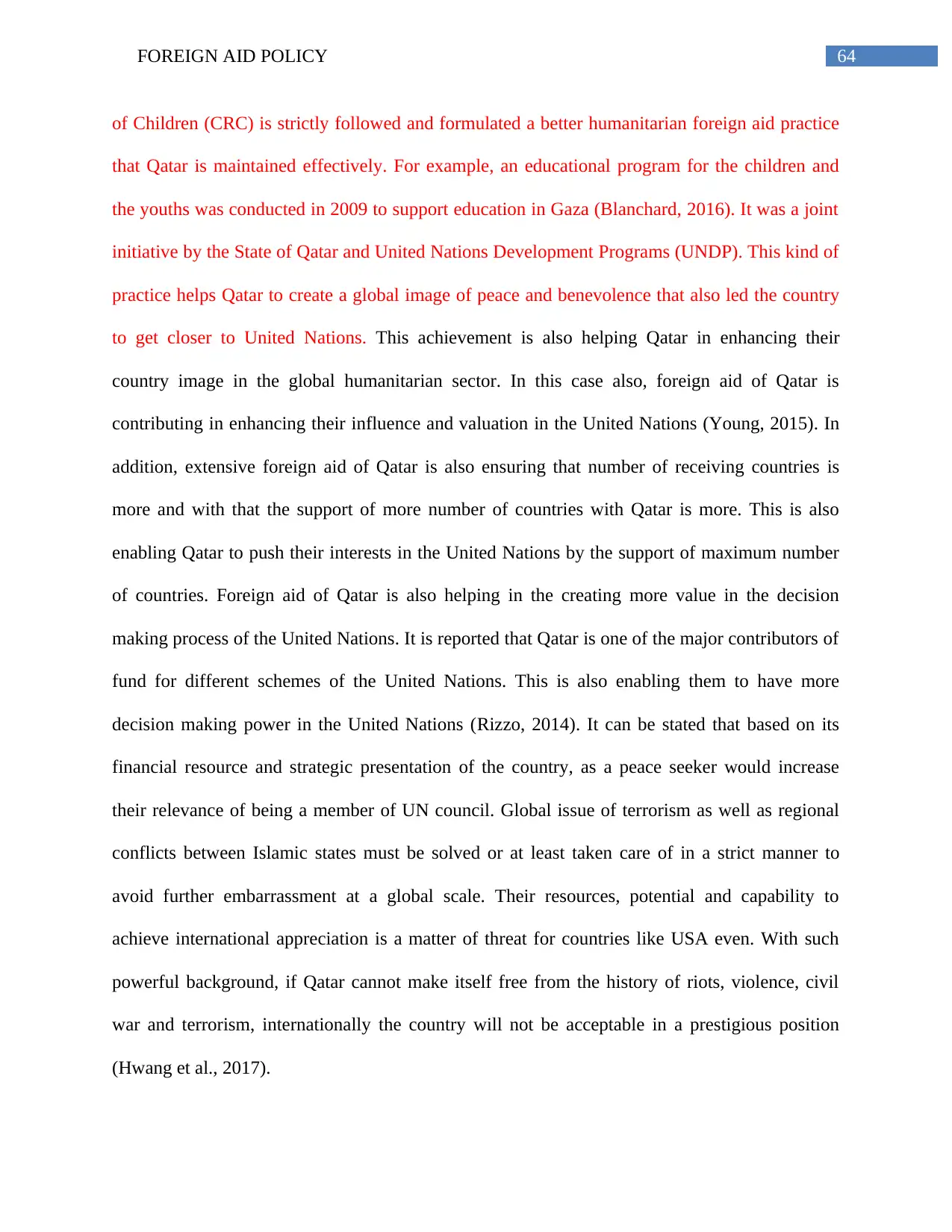
64FOREIGN AID POLICY
of Children (CRC) is strictly followed and formulated a better humanitarian foreign aid practice
that Qatar is maintained effectively. For example, an educational program for the children and
the youths was conducted in 2009 to support education in Gaza (Blanchard, 2016). It was a joint
initiative by the State of Qatar and United Nations Development Programs (UNDP). This kind of
practice helps Qatar to create a global image of peace and benevolence that also led the country
to get closer to United Nations. This achievement is also helping Qatar in enhancing their
country image in the global humanitarian sector. In this case also, foreign aid of Qatar is
contributing in enhancing their influence and valuation in the United Nations (Young, 2015). In
addition, extensive foreign aid of Qatar is also ensuring that number of receiving countries is
more and with that the support of more number of countries with Qatar is more. This is also
enabling Qatar to push their interests in the United Nations by the support of maximum number
of countries. Foreign aid of Qatar is also helping in the creating more value in the decision
making process of the United Nations. It is reported that Qatar is one of the major contributors of
fund for different schemes of the United Nations. This is also enabling them to have more
decision making power in the United Nations (Rizzo, 2014). It can be stated that based on its
financial resource and strategic presentation of the country, as a peace seeker would increase
their relevance of being a member of UN council. Global issue of terrorism as well as regional
conflicts between Islamic states must be solved or at least taken care of in a strict manner to
avoid further embarrassment at a global scale. Their resources, potential and capability to
achieve international appreciation is a matter of threat for countries like USA even. With such
powerful background, if Qatar cannot make itself free from the history of riots, violence, civil
war and terrorism, internationally the country will not be acceptable in a prestigious position
(Hwang et al., 2017).
of Children (CRC) is strictly followed and formulated a better humanitarian foreign aid practice
that Qatar is maintained effectively. For example, an educational program for the children and
the youths was conducted in 2009 to support education in Gaza (Blanchard, 2016). It was a joint
initiative by the State of Qatar and United Nations Development Programs (UNDP). This kind of
practice helps Qatar to create a global image of peace and benevolence that also led the country
to get closer to United Nations. This achievement is also helping Qatar in enhancing their
country image in the global humanitarian sector. In this case also, foreign aid of Qatar is
contributing in enhancing their influence and valuation in the United Nations (Young, 2015). In
addition, extensive foreign aid of Qatar is also ensuring that number of receiving countries is
more and with that the support of more number of countries with Qatar is more. This is also
enabling Qatar to push their interests in the United Nations by the support of maximum number
of countries. Foreign aid of Qatar is also helping in the creating more value in the decision
making process of the United Nations. It is reported that Qatar is one of the major contributors of
fund for different schemes of the United Nations. This is also enabling them to have more
decision making power in the United Nations (Rizzo, 2014). It can be stated that based on its
financial resource and strategic presentation of the country, as a peace seeker would increase
their relevance of being a member of UN council. Global issue of terrorism as well as regional
conflicts between Islamic states must be solved or at least taken care of in a strict manner to
avoid further embarrassment at a global scale. Their resources, potential and capability to
achieve international appreciation is a matter of threat for countries like USA even. With such
powerful background, if Qatar cannot make itself free from the history of riots, violence, civil
war and terrorism, internationally the country will not be acceptable in a prestigious position
(Hwang et al., 2017).
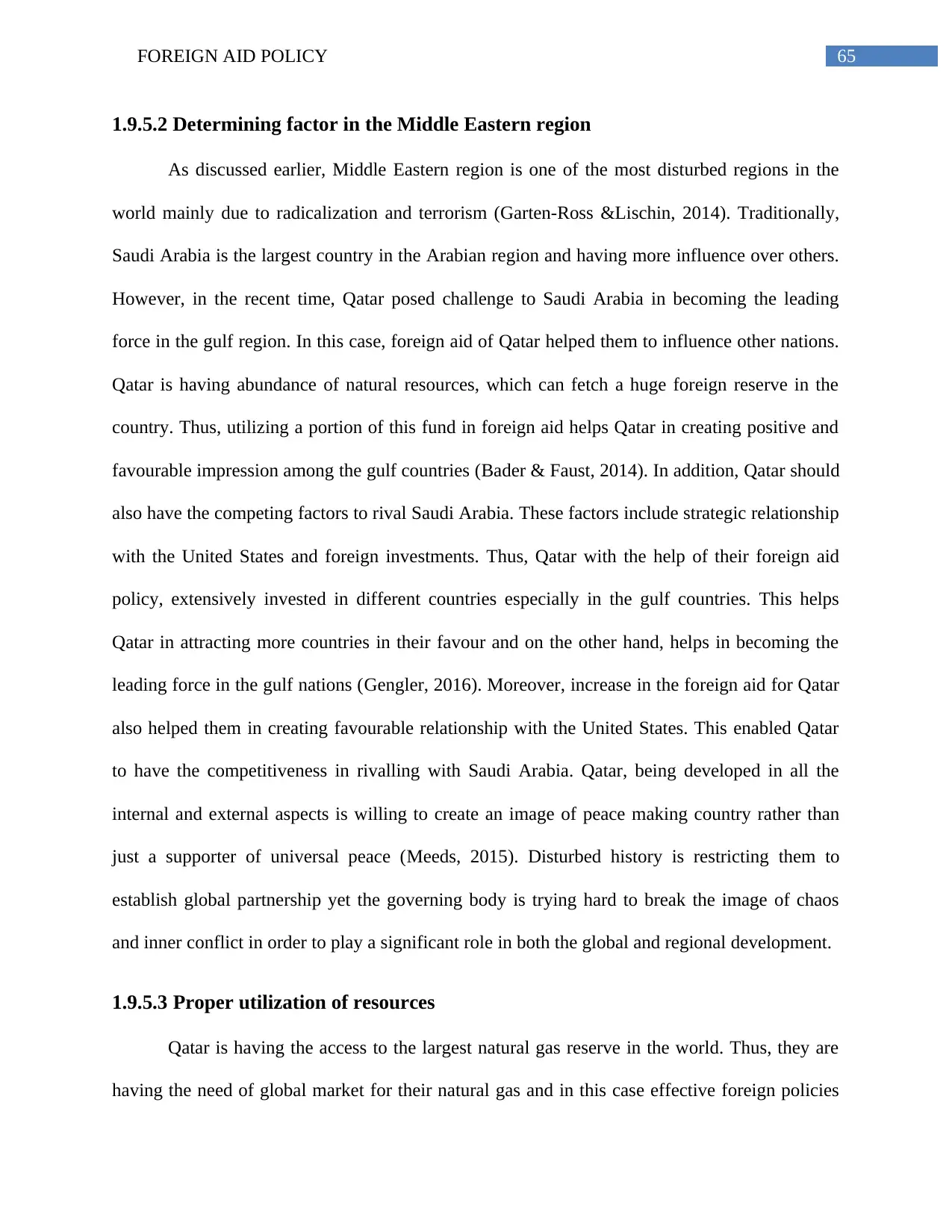
65FOREIGN AID POLICY
1.9.5.2 Determining factor in the Middle Eastern region
As discussed earlier, Middle Eastern region is one of the most disturbed regions in the
world mainly due to radicalization and terrorism (Garten-Ross &Lischin, 2014). Traditionally,
Saudi Arabia is the largest country in the Arabian region and having more influence over others.
However, in the recent time, Qatar posed challenge to Saudi Arabia in becoming the leading
force in the gulf region. In this case, foreign aid of Qatar helped them to influence other nations.
Qatar is having abundance of natural resources, which can fetch a huge foreign reserve in the
country. Thus, utilizing a portion of this fund in foreign aid helps Qatar in creating positive and
favourable impression among the gulf countries (Bader & Faust, 2014). In addition, Qatar should
also have the competing factors to rival Saudi Arabia. These factors include strategic relationship
with the United States and foreign investments. Thus, Qatar with the help of their foreign aid
policy, extensively invested in different countries especially in the gulf countries. This helps
Qatar in attracting more countries in their favour and on the other hand, helps in becoming the
leading force in the gulf nations (Gengler, 2016). Moreover, increase in the foreign aid for Qatar
also helped them in creating favourable relationship with the United States. This enabled Qatar
to have the competitiveness in rivalling with Saudi Arabia. Qatar, being developed in all the
internal and external aspects is willing to create an image of peace making country rather than
just a supporter of universal peace (Meeds, 2015). Disturbed history is restricting them to
establish global partnership yet the governing body is trying hard to break the image of chaos
and inner conflict in order to play a significant role in both the global and regional development.
1.9.5.3 Proper utilization of resources
Qatar is having the access to the largest natural gas reserve in the world. Thus, they are
having the need of global market for their natural gas and in this case effective foreign policies
1.9.5.2 Determining factor in the Middle Eastern region
As discussed earlier, Middle Eastern region is one of the most disturbed regions in the
world mainly due to radicalization and terrorism (Garten-Ross &Lischin, 2014). Traditionally,
Saudi Arabia is the largest country in the Arabian region and having more influence over others.
However, in the recent time, Qatar posed challenge to Saudi Arabia in becoming the leading
force in the gulf region. In this case, foreign aid of Qatar helped them to influence other nations.
Qatar is having abundance of natural resources, which can fetch a huge foreign reserve in the
country. Thus, utilizing a portion of this fund in foreign aid helps Qatar in creating positive and
favourable impression among the gulf countries (Bader & Faust, 2014). In addition, Qatar should
also have the competing factors to rival Saudi Arabia. These factors include strategic relationship
with the United States and foreign investments. Thus, Qatar with the help of their foreign aid
policy, extensively invested in different countries especially in the gulf countries. This helps
Qatar in attracting more countries in their favour and on the other hand, helps in becoming the
leading force in the gulf nations (Gengler, 2016). Moreover, increase in the foreign aid for Qatar
also helped them in creating favourable relationship with the United States. This enabled Qatar
to have the competitiveness in rivalling with Saudi Arabia. Qatar, being developed in all the
internal and external aspects is willing to create an image of peace making country rather than
just a supporter of universal peace (Meeds, 2015). Disturbed history is restricting them to
establish global partnership yet the governing body is trying hard to break the image of chaos
and inner conflict in order to play a significant role in both the global and regional development.
1.9.5.3 Proper utilization of resources
Qatar is having the access to the largest natural gas reserve in the world. Thus, they are
having the need of global market for their natural gas and in this case effective foreign policies
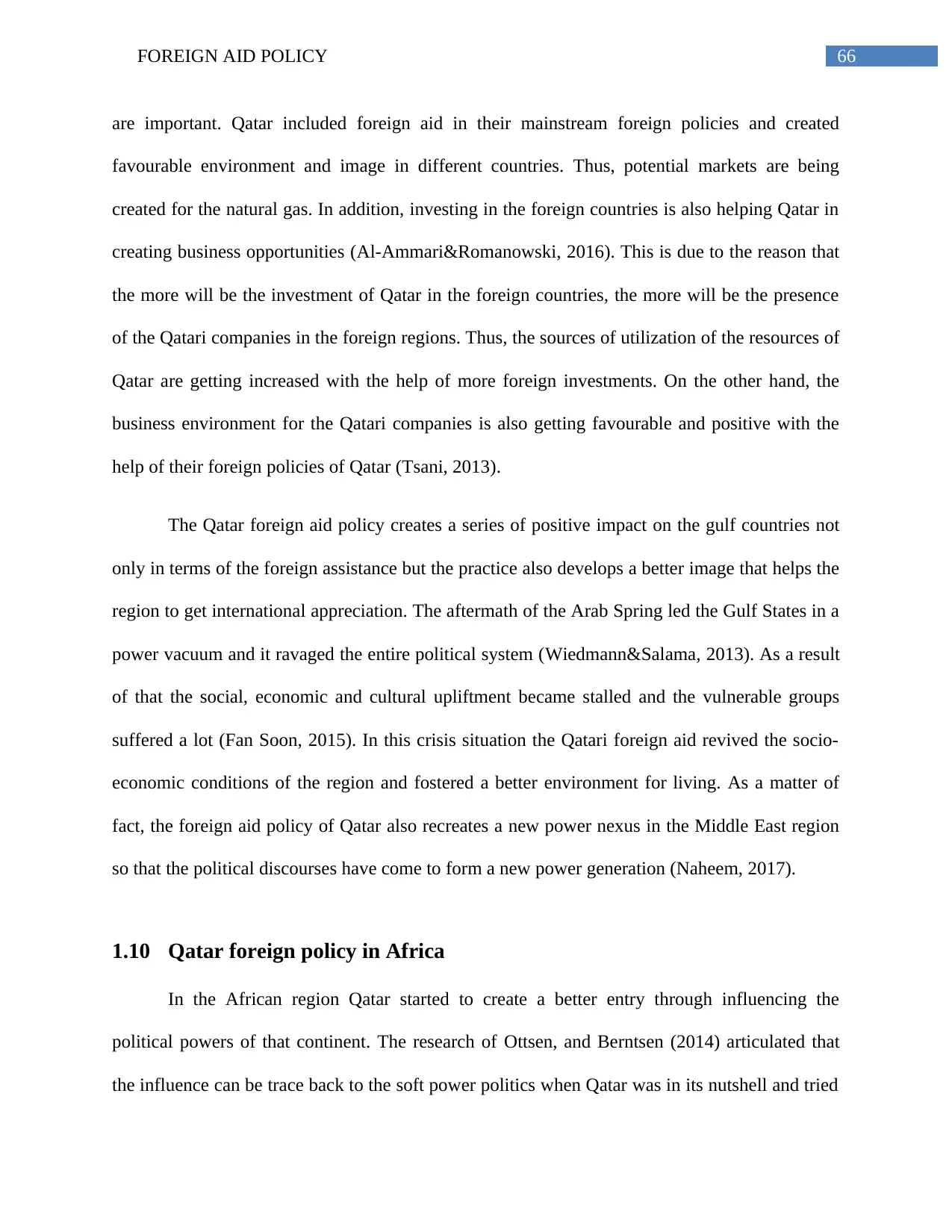
66FOREIGN AID POLICY
are important. Qatar included foreign aid in their mainstream foreign policies and created
favourable environment and image in different countries. Thus, potential markets are being
created for the natural gas. In addition, investing in the foreign countries is also helping Qatar in
creating business opportunities (Al-Ammari&Romanowski, 2016). This is due to the reason that
the more will be the investment of Qatar in the foreign countries, the more will be the presence
of the Qatari companies in the foreign regions. Thus, the sources of utilization of the resources of
Qatar are getting increased with the help of more foreign investments. On the other hand, the
business environment for the Qatari companies is also getting favourable and positive with the
help of their foreign policies of Qatar (Tsani, 2013).
The Qatar foreign aid policy creates a series of positive impact on the gulf countries not
only in terms of the foreign assistance but the practice also develops a better image that helps the
region to get international appreciation. The aftermath of the Arab Spring led the Gulf States in a
power vacuum and it ravaged the entire political system (Wiedmann&Salama, 2013). As a result
of that the social, economic and cultural upliftment became stalled and the vulnerable groups
suffered a lot (Fan Soon, 2015). In this crisis situation the Qatari foreign aid revived the socio-
economic conditions of the region and fostered a better environment for living. As a matter of
fact, the foreign aid policy of Qatar also recreates a new power nexus in the Middle East region
so that the political discourses have come to form a new power generation (Naheem, 2017).
1.10 Qatar foreign policy in Africa
In the African region Qatar started to create a better entry through influencing the
political powers of that continent. The research of Ottsen, and Berntsen (2014) articulated that
the influence can be trace back to the soft power politics when Qatar was in its nutshell and tried
are important. Qatar included foreign aid in their mainstream foreign policies and created
favourable environment and image in different countries. Thus, potential markets are being
created for the natural gas. In addition, investing in the foreign countries is also helping Qatar in
creating business opportunities (Al-Ammari&Romanowski, 2016). This is due to the reason that
the more will be the investment of Qatar in the foreign countries, the more will be the presence
of the Qatari companies in the foreign regions. Thus, the sources of utilization of the resources of
Qatar are getting increased with the help of more foreign investments. On the other hand, the
business environment for the Qatari companies is also getting favourable and positive with the
help of their foreign policies of Qatar (Tsani, 2013).
The Qatar foreign aid policy creates a series of positive impact on the gulf countries not
only in terms of the foreign assistance but the practice also develops a better image that helps the
region to get international appreciation. The aftermath of the Arab Spring led the Gulf States in a
power vacuum and it ravaged the entire political system (Wiedmann&Salama, 2013). As a result
of that the social, economic and cultural upliftment became stalled and the vulnerable groups
suffered a lot (Fan Soon, 2015). In this crisis situation the Qatari foreign aid revived the socio-
economic conditions of the region and fostered a better environment for living. As a matter of
fact, the foreign aid policy of Qatar also recreates a new power nexus in the Middle East region
so that the political discourses have come to form a new power generation (Naheem, 2017).
1.10 Qatar foreign policy in Africa
In the African region Qatar started to create a better entry through influencing the
political powers of that continent. The research of Ottsen, and Berntsen (2014) articulated that
the influence can be trace back to the soft power politics when Qatar was in its nutshell and tried
Paraphrase This Document
Need a fresh take? Get an instant paraphrase of this document with our AI Paraphraser
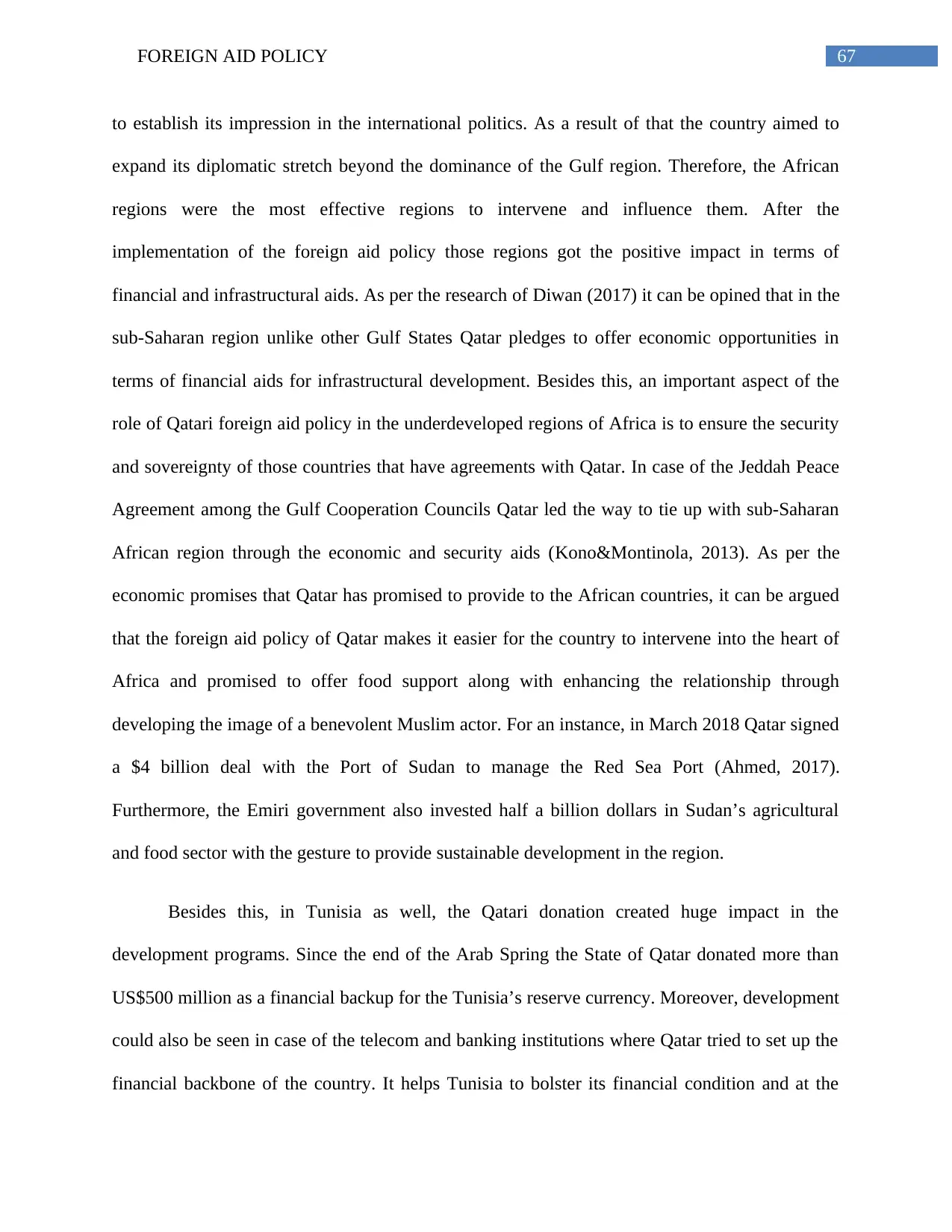
67FOREIGN AID POLICY
to establish its impression in the international politics. As a result of that the country aimed to
expand its diplomatic stretch beyond the dominance of the Gulf region. Therefore, the African
regions were the most effective regions to intervene and influence them. After the
implementation of the foreign aid policy those regions got the positive impact in terms of
financial and infrastructural aids. As per the research of Diwan (2017) it can be opined that in the
sub-Saharan region unlike other Gulf States Qatar pledges to offer economic opportunities in
terms of financial aids for infrastructural development. Besides this, an important aspect of the
role of Qatari foreign aid policy in the underdeveloped regions of Africa is to ensure the security
and sovereignty of those countries that have agreements with Qatar. In case of the Jeddah Peace
Agreement among the Gulf Cooperation Councils Qatar led the way to tie up with sub-Saharan
African region through the economic and security aids (Kono&Montinola, 2013). As per the
economic promises that Qatar has promised to provide to the African countries, it can be argued
that the foreign aid policy of Qatar makes it easier for the country to intervene into the heart of
Africa and promised to offer food support along with enhancing the relationship through
developing the image of a benevolent Muslim actor. For an instance, in March 2018 Qatar signed
a $4 billion deal with the Port of Sudan to manage the Red Sea Port (Ahmed, 2017).
Furthermore, the Emiri government also invested half a billion dollars in Sudan’s agricultural
and food sector with the gesture to provide sustainable development in the region.
Besides this, in Tunisia as well, the Qatari donation created huge impact in the
development programs. Since the end of the Arab Spring the State of Qatar donated more than
US$500 million as a financial backup for the Tunisia’s reserve currency. Moreover, development
could also be seen in case of the telecom and banking institutions where Qatar tried to set up the
financial backbone of the country. It helps Tunisia to bolster its financial condition and at the
to establish its impression in the international politics. As a result of that the country aimed to
expand its diplomatic stretch beyond the dominance of the Gulf region. Therefore, the African
regions were the most effective regions to intervene and influence them. After the
implementation of the foreign aid policy those regions got the positive impact in terms of
financial and infrastructural aids. As per the research of Diwan (2017) it can be opined that in the
sub-Saharan region unlike other Gulf States Qatar pledges to offer economic opportunities in
terms of financial aids for infrastructural development. Besides this, an important aspect of the
role of Qatari foreign aid policy in the underdeveloped regions of Africa is to ensure the security
and sovereignty of those countries that have agreements with Qatar. In case of the Jeddah Peace
Agreement among the Gulf Cooperation Councils Qatar led the way to tie up with sub-Saharan
African region through the economic and security aids (Kono&Montinola, 2013). As per the
economic promises that Qatar has promised to provide to the African countries, it can be argued
that the foreign aid policy of Qatar makes it easier for the country to intervene into the heart of
Africa and promised to offer food support along with enhancing the relationship through
developing the image of a benevolent Muslim actor. For an instance, in March 2018 Qatar signed
a $4 billion deal with the Port of Sudan to manage the Red Sea Port (Ahmed, 2017).
Furthermore, the Emiri government also invested half a billion dollars in Sudan’s agricultural
and food sector with the gesture to provide sustainable development in the region.
Besides this, in Tunisia as well, the Qatari donation created huge impact in the
development programs. Since the end of the Arab Spring the State of Qatar donated more than
US$500 million as a financial backup for the Tunisia’s reserve currency. Moreover, development
could also be seen in case of the telecom and banking institutions where Qatar tried to set up the
financial backbone of the country. It helps Tunisia to bolster its financial condition and at the
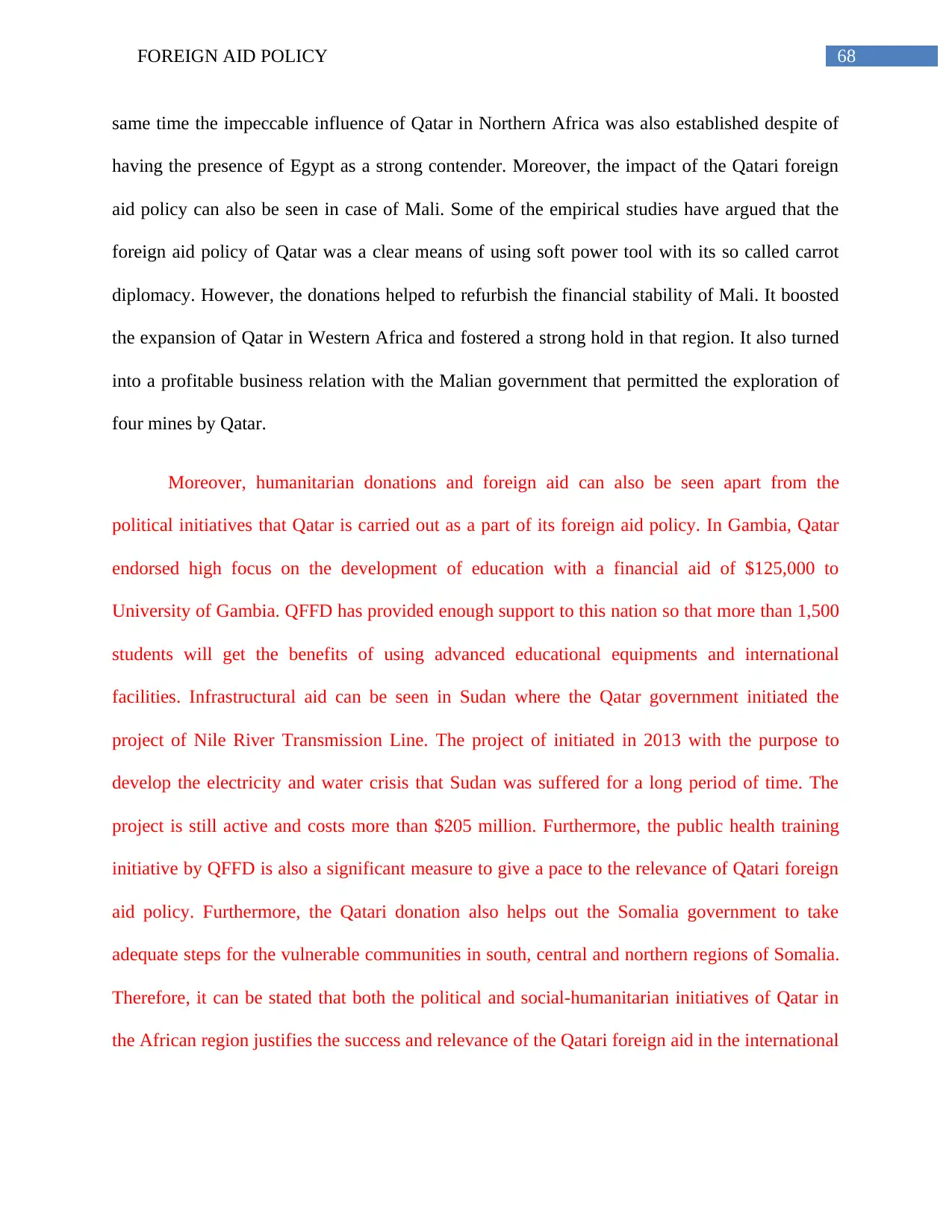
68FOREIGN AID POLICY
same time the impeccable influence of Qatar in Northern Africa was also established despite of
having the presence of Egypt as a strong contender. Moreover, the impact of the Qatari foreign
aid policy can also be seen in case of Mali. Some of the empirical studies have argued that the
foreign aid policy of Qatar was a clear means of using soft power tool with its so called carrot
diplomacy. However, the donations helped to refurbish the financial stability of Mali. It boosted
the expansion of Qatar in Western Africa and fostered a strong hold in that region. It also turned
into a profitable business relation with the Malian government that permitted the exploration of
four mines by Qatar.
Moreover, humanitarian donations and foreign aid can also be seen apart from the
political initiatives that Qatar is carried out as a part of its foreign aid policy. In Gambia, Qatar
endorsed high focus on the development of education with a financial aid of $125,000 to
University of Gambia. QFFD has provided enough support to this nation so that more than 1,500
students will get the benefits of using advanced educational equipments and international
facilities. Infrastructural aid can be seen in Sudan where the Qatar government initiated the
project of Nile River Transmission Line. The project of initiated in 2013 with the purpose to
develop the electricity and water crisis that Sudan was suffered for a long period of time. The
project is still active and costs more than $205 million. Furthermore, the public health training
initiative by QFFD is also a significant measure to give a pace to the relevance of Qatari foreign
aid policy. Furthermore, the Qatari donation also helps out the Somalia government to take
adequate steps for the vulnerable communities in south, central and northern regions of Somalia.
Therefore, it can be stated that both the political and social-humanitarian initiatives of Qatar in
the African region justifies the success and relevance of the Qatari foreign aid in the international
same time the impeccable influence of Qatar in Northern Africa was also established despite of
having the presence of Egypt as a strong contender. Moreover, the impact of the Qatari foreign
aid policy can also be seen in case of Mali. Some of the empirical studies have argued that the
foreign aid policy of Qatar was a clear means of using soft power tool with its so called carrot
diplomacy. However, the donations helped to refurbish the financial stability of Mali. It boosted
the expansion of Qatar in Western Africa and fostered a strong hold in that region. It also turned
into a profitable business relation with the Malian government that permitted the exploration of
four mines by Qatar.
Moreover, humanitarian donations and foreign aid can also be seen apart from the
political initiatives that Qatar is carried out as a part of its foreign aid policy. In Gambia, Qatar
endorsed high focus on the development of education with a financial aid of $125,000 to
University of Gambia. QFFD has provided enough support to this nation so that more than 1,500
students will get the benefits of using advanced educational equipments and international
facilities. Infrastructural aid can be seen in Sudan where the Qatar government initiated the
project of Nile River Transmission Line. The project of initiated in 2013 with the purpose to
develop the electricity and water crisis that Sudan was suffered for a long period of time. The
project is still active and costs more than $205 million. Furthermore, the public health training
initiative by QFFD is also a significant measure to give a pace to the relevance of Qatari foreign
aid policy. Furthermore, the Qatari donation also helps out the Somalia government to take
adequate steps for the vulnerable communities in south, central and northern regions of Somalia.
Therefore, it can be stated that both the political and social-humanitarian initiatives of Qatar in
the African region justifies the success and relevance of the Qatari foreign aid in the international
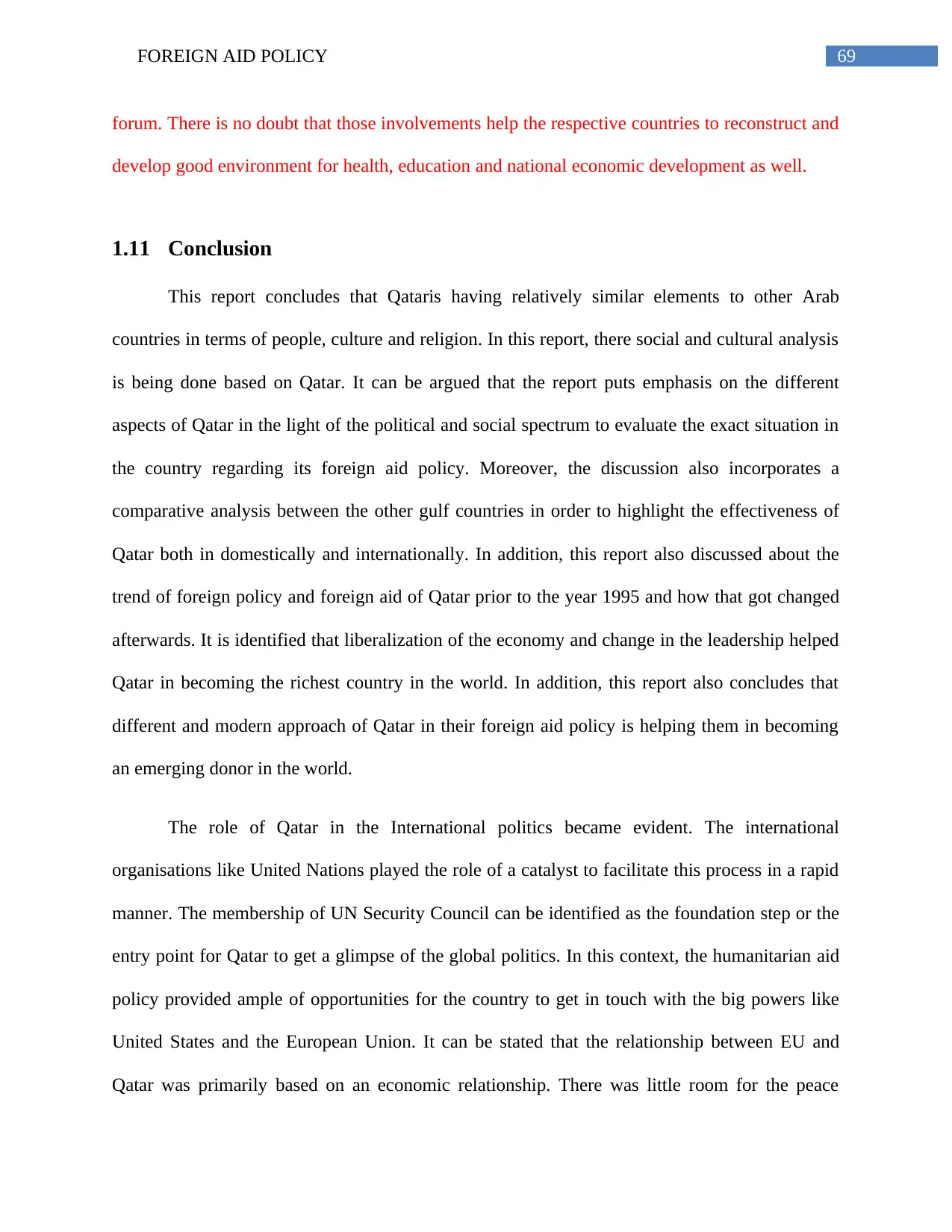
69FOREIGN AID POLICY
forum. There is no doubt that those involvements help the respective countries to reconstruct and
develop good environment for health, education and national economic development as well.
1.11 Conclusion
This report concludes that Qataris having relatively similar elements to other Arab
countries in terms of people, culture and religion. In this report, there social and cultural analysis
is being done based on Qatar. It can be argued that the report puts emphasis on the different
aspects of Qatar in the light of the political and social spectrum to evaluate the exact situation in
the country regarding its foreign aid policy. Moreover, the discussion also incorporates a
comparative analysis between the other gulf countries in order to highlight the effectiveness of
Qatar both in domestically and internationally. In addition, this report also discussed about the
trend of foreign policy and foreign aid of Qatar prior to the year 1995 and how that got changed
afterwards. It is identified that liberalization of the economy and change in the leadership helped
Qatar in becoming the richest country in the world. In addition, this report also concludes that
different and modern approach of Qatar in their foreign aid policy is helping them in becoming
an emerging donor in the world.
The role of Qatar in the International politics became evident. The international
organisations like United Nations played the role of a catalyst to facilitate this process in a rapid
manner. The membership of UN Security Council can be identified as the foundation step or the
entry point for Qatar to get a glimpse of the global politics. In this context, the humanitarian aid
policy provided ample of opportunities for the country to get in touch with the big powers like
United States and the European Union. It can be stated that the relationship between EU and
Qatar was primarily based on an economic relationship. There was little room for the peace
forum. There is no doubt that those involvements help the respective countries to reconstruct and
develop good environment for health, education and national economic development as well.
1.11 Conclusion
This report concludes that Qataris having relatively similar elements to other Arab
countries in terms of people, culture and religion. In this report, there social and cultural analysis
is being done based on Qatar. It can be argued that the report puts emphasis on the different
aspects of Qatar in the light of the political and social spectrum to evaluate the exact situation in
the country regarding its foreign aid policy. Moreover, the discussion also incorporates a
comparative analysis between the other gulf countries in order to highlight the effectiveness of
Qatar both in domestically and internationally. In addition, this report also discussed about the
trend of foreign policy and foreign aid of Qatar prior to the year 1995 and how that got changed
afterwards. It is identified that liberalization of the economy and change in the leadership helped
Qatar in becoming the richest country in the world. In addition, this report also concludes that
different and modern approach of Qatar in their foreign aid policy is helping them in becoming
an emerging donor in the world.
The role of Qatar in the International politics became evident. The international
organisations like United Nations played the role of a catalyst to facilitate this process in a rapid
manner. The membership of UN Security Council can be identified as the foundation step or the
entry point for Qatar to get a glimpse of the global politics. In this context, the humanitarian aid
policy provided ample of opportunities for the country to get in touch with the big powers like
United States and the European Union. It can be stated that the relationship between EU and
Qatar was primarily based on an economic relationship. There was little room for the peace
Secure Best Marks with AI Grader
Need help grading? Try our AI Grader for instant feedback on your assignments.
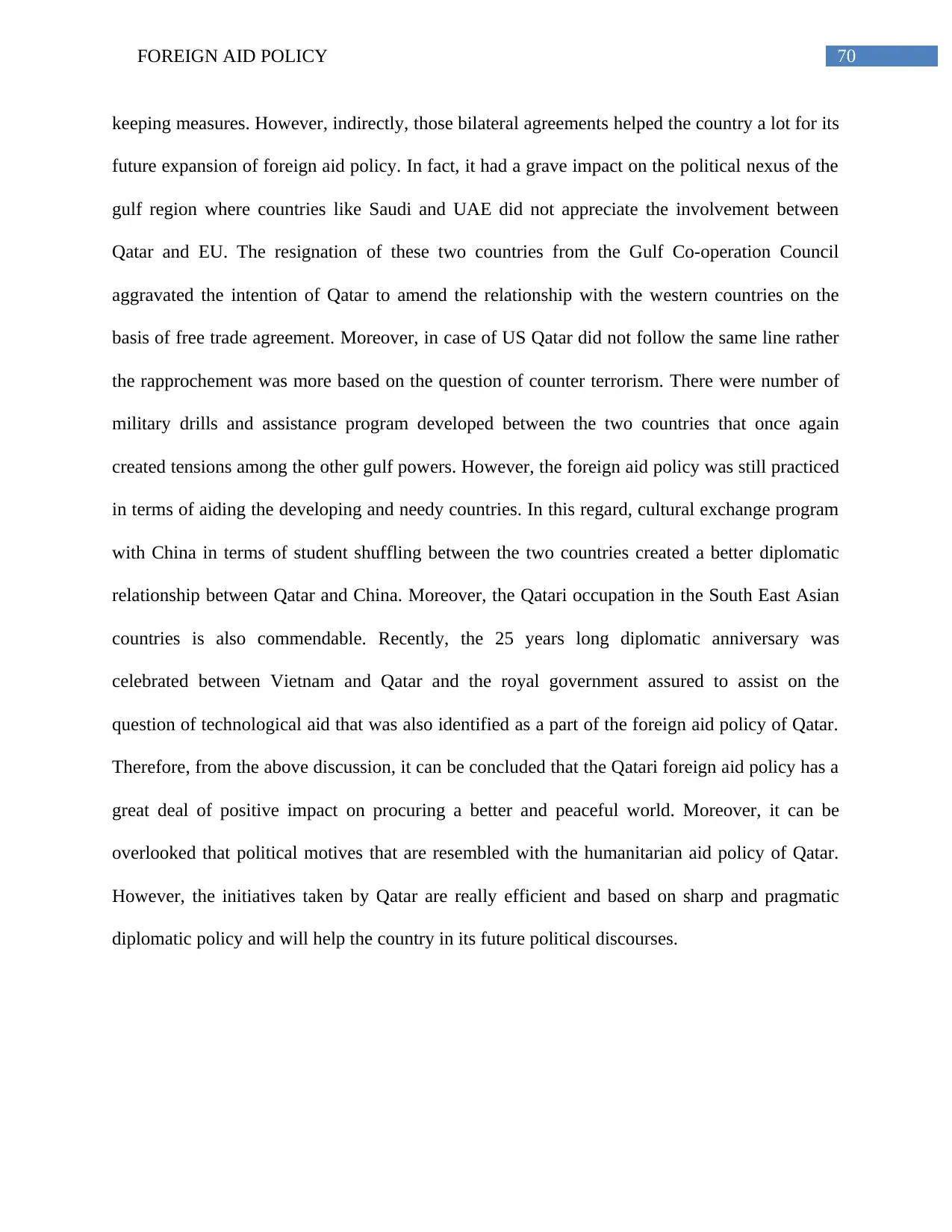
70FOREIGN AID POLICY
keeping measures. However, indirectly, those bilateral agreements helped the country a lot for its
future expansion of foreign aid policy. In fact, it had a grave impact on the political nexus of the
gulf region where countries like Saudi and UAE did not appreciate the involvement between
Qatar and EU. The resignation of these two countries from the Gulf Co-operation Council
aggravated the intention of Qatar to amend the relationship with the western countries on the
basis of free trade agreement. Moreover, in case of US Qatar did not follow the same line rather
the rapprochement was more based on the question of counter terrorism. There were number of
military drills and assistance program developed between the two countries that once again
created tensions among the other gulf powers. However, the foreign aid policy was still practiced
in terms of aiding the developing and needy countries. In this regard, cultural exchange program
with China in terms of student shuffling between the two countries created a better diplomatic
relationship between Qatar and China. Moreover, the Qatari occupation in the South East Asian
countries is also commendable. Recently, the 25 years long diplomatic anniversary was
celebrated between Vietnam and Qatar and the royal government assured to assist on the
question of technological aid that was also identified as a part of the foreign aid policy of Qatar.
Therefore, from the above discussion, it can be concluded that the Qatari foreign aid policy has a
great deal of positive impact on procuring a better and peaceful world. Moreover, it can be
overlooked that political motives that are resembled with the humanitarian aid policy of Qatar.
However, the initiatives taken by Qatar are really efficient and based on sharp and pragmatic
diplomatic policy and will help the country in its future political discourses.
keeping measures. However, indirectly, those bilateral agreements helped the country a lot for its
future expansion of foreign aid policy. In fact, it had a grave impact on the political nexus of the
gulf region where countries like Saudi and UAE did not appreciate the involvement between
Qatar and EU. The resignation of these two countries from the Gulf Co-operation Council
aggravated the intention of Qatar to amend the relationship with the western countries on the
basis of free trade agreement. Moreover, in case of US Qatar did not follow the same line rather
the rapprochement was more based on the question of counter terrorism. There were number of
military drills and assistance program developed between the two countries that once again
created tensions among the other gulf powers. However, the foreign aid policy was still practiced
in terms of aiding the developing and needy countries. In this regard, cultural exchange program
with China in terms of student shuffling between the two countries created a better diplomatic
relationship between Qatar and China. Moreover, the Qatari occupation in the South East Asian
countries is also commendable. Recently, the 25 years long diplomatic anniversary was
celebrated between Vietnam and Qatar and the royal government assured to assist on the
question of technological aid that was also identified as a part of the foreign aid policy of Qatar.
Therefore, from the above discussion, it can be concluded that the Qatari foreign aid policy has a
great deal of positive impact on procuring a better and peaceful world. Moreover, it can be
overlooked that political motives that are resembled with the humanitarian aid policy of Qatar.
However, the initiatives taken by Qatar are really efficient and based on sharp and pragmatic
diplomatic policy and will help the country in its future political discourses.
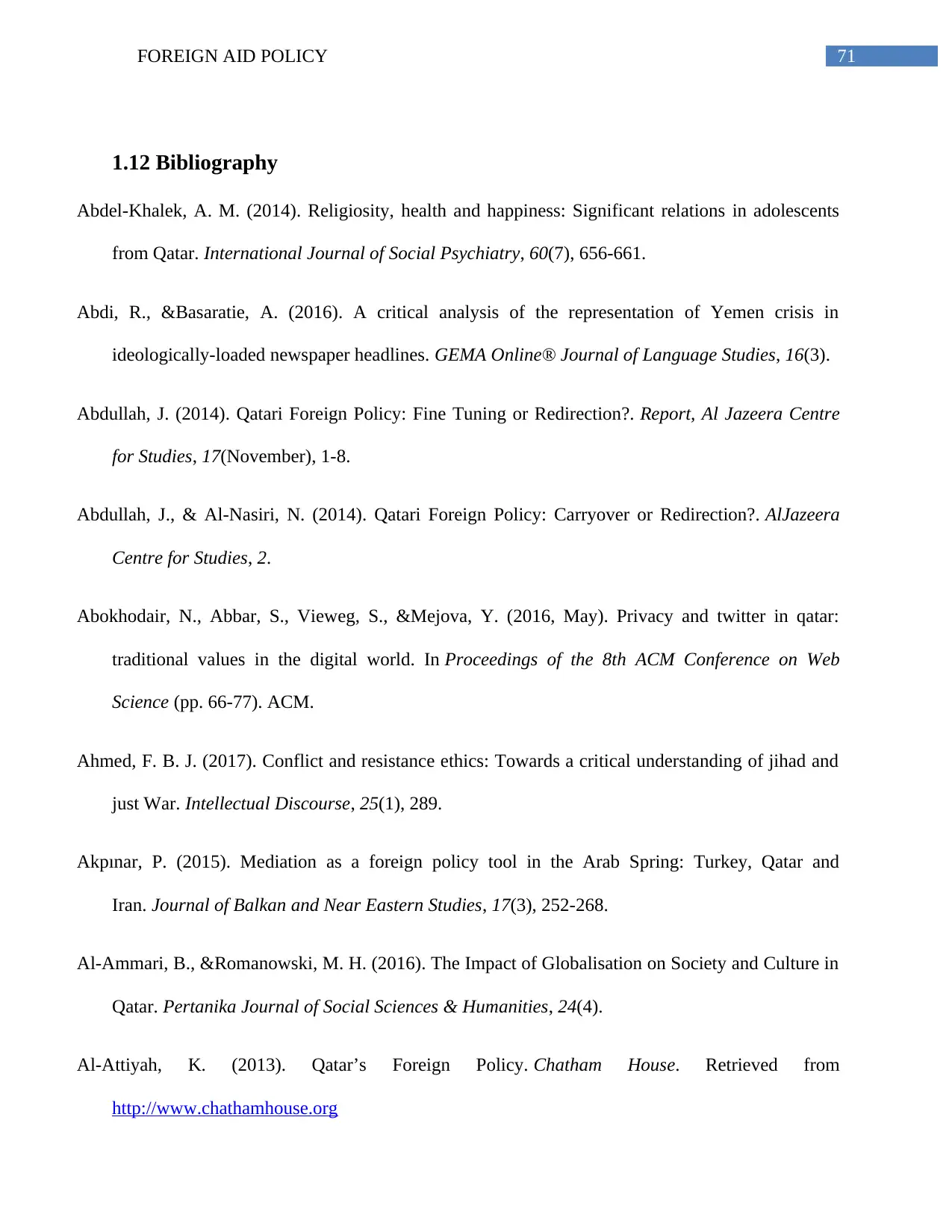
71FOREIGN AID POLICY
1.12 Bibliography
Abdel-Khalek, A. M. (2014). Religiosity, health and happiness: Significant relations in adolescents
from Qatar. International Journal of Social Psychiatry, 60(7), 656-661.
Abdi, R., &Basaratie, A. (2016). A critical analysis of the representation of Yemen crisis in
ideologically-loaded newspaper headlines. GEMA Online® Journal of Language Studies, 16(3).
Abdullah, J. (2014). Qatari Foreign Policy: Fine Tuning or Redirection?. Report, Al Jazeera Centre
for Studies, 17(November), 1-8.
Abdullah, J., & Al-Nasiri, N. (2014). Qatari Foreign Policy: Carryover or Redirection?. AlJazeera
Centre for Studies, 2.
Abokhodair, N., Abbar, S., Vieweg, S., &Mejova, Y. (2016, May). Privacy and twitter in qatar:
traditional values in the digital world. In Proceedings of the 8th ACM Conference on Web
Science (pp. 66-77). ACM.
Ahmed, F. B. J. (2017). Conflict and resistance ethics: Towards a critical understanding of jihad and
just War. Intellectual Discourse, 25(1), 289.
Akpınar, P. (2015). Mediation as a foreign policy tool in the Arab Spring: Turkey, Qatar and
Iran. Journal of Balkan and Near Eastern Studies, 17(3), 252-268.
Al-Ammari, B., &Romanowski, M. H. (2016). The Impact of Globalisation on Society and Culture in
Qatar. Pertanika Journal of Social Sciences & Humanities, 24(4).
Al-Attiyah, K. (2013). Qatar’s Foreign Policy. Chatham House. Retrieved from
http://www.chathamhouse.org
1.12 Bibliography
Abdel-Khalek, A. M. (2014). Religiosity, health and happiness: Significant relations in adolescents
from Qatar. International Journal of Social Psychiatry, 60(7), 656-661.
Abdi, R., &Basaratie, A. (2016). A critical analysis of the representation of Yemen crisis in
ideologically-loaded newspaper headlines. GEMA Online® Journal of Language Studies, 16(3).
Abdullah, J. (2014). Qatari Foreign Policy: Fine Tuning or Redirection?. Report, Al Jazeera Centre
for Studies, 17(November), 1-8.
Abdullah, J., & Al-Nasiri, N. (2014). Qatari Foreign Policy: Carryover or Redirection?. AlJazeera
Centre for Studies, 2.
Abokhodair, N., Abbar, S., Vieweg, S., &Mejova, Y. (2016, May). Privacy and twitter in qatar:
traditional values in the digital world. In Proceedings of the 8th ACM Conference on Web
Science (pp. 66-77). ACM.
Ahmed, F. B. J. (2017). Conflict and resistance ethics: Towards a critical understanding of jihad and
just War. Intellectual Discourse, 25(1), 289.
Akpınar, P. (2015). Mediation as a foreign policy tool in the Arab Spring: Turkey, Qatar and
Iran. Journal of Balkan and Near Eastern Studies, 17(3), 252-268.
Al-Ammari, B., &Romanowski, M. H. (2016). The Impact of Globalisation on Society and Culture in
Qatar. Pertanika Journal of Social Sciences & Humanities, 24(4).
Al-Attiyah, K. (2013). Qatar’s Foreign Policy. Chatham House. Retrieved from
http://www.chathamhouse.org
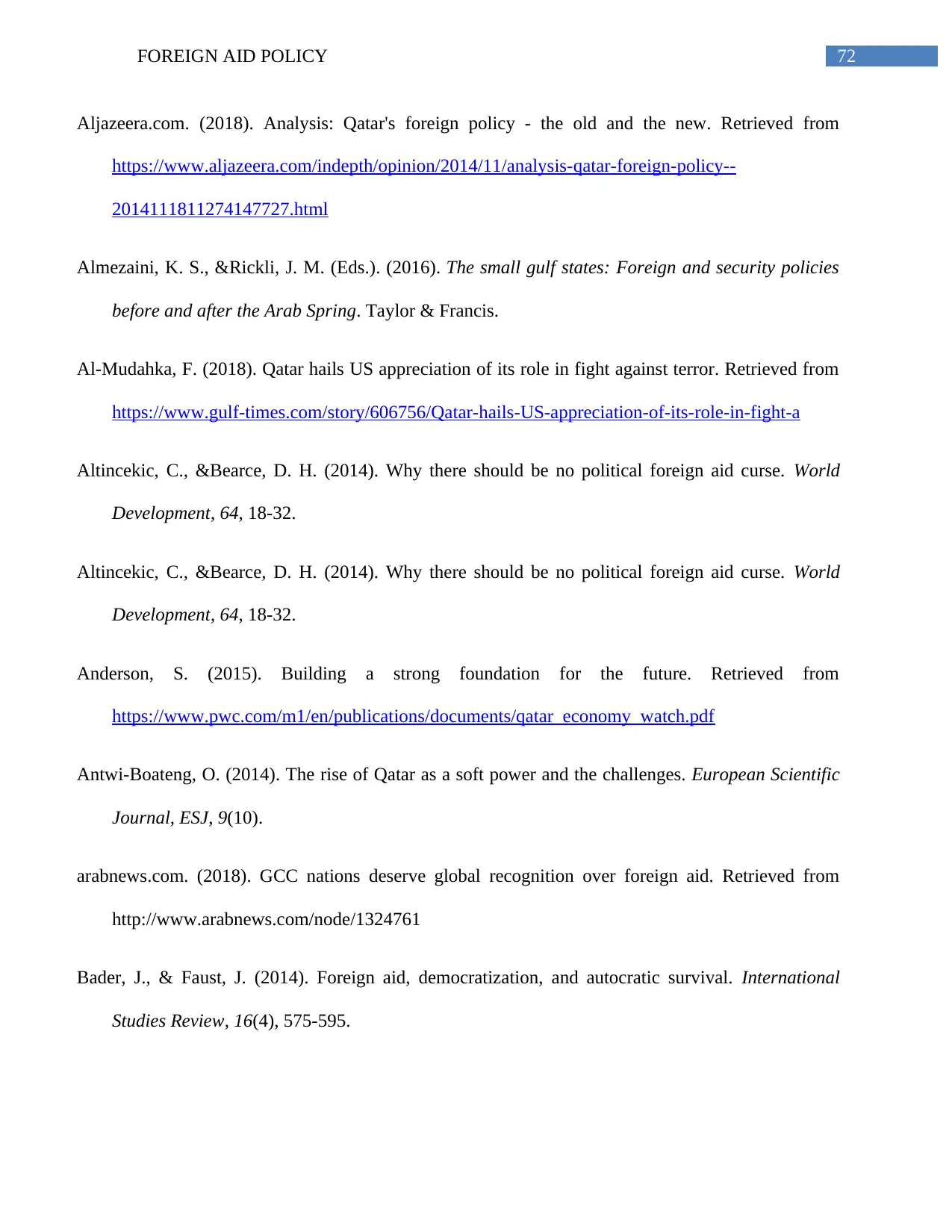
72FOREIGN AID POLICY
Aljazeera.com. (2018). Analysis: Qatar's foreign policy - the old and the new. Retrieved from
https://www.aljazeera.com/indepth/opinion/2014/11/analysis-qatar-foreign-policy--
2014111811274147727.html
Almezaini, K. S., &Rickli, J. M. (Eds.). (2016). The small gulf states: Foreign and security policies
before and after the Arab Spring. Taylor & Francis.
Al-Mudahka, F. (2018). Qatar hails US appreciation of its role in fight against terror. Retrieved from
https://www.gulf-times.com/story/606756/Qatar-hails-US-appreciation-of-its-role-in-fight-a
Altincekic, C., &Bearce, D. H. (2014). Why there should be no political foreign aid curse. World
Development, 64, 18-32.
Altincekic, C., &Bearce, D. H. (2014). Why there should be no political foreign aid curse. World
Development, 64, 18-32.
Anderson, S. (2015). Building a strong foundation for the future. Retrieved from
https://www.pwc.com/m1/en/publications/documents/qatar_economy_watch.pdf
Antwi-Boateng, O. (2014). The rise of Qatar as a soft power and the challenges. European Scientific
Journal, ESJ, 9(10).
arabnews.com. (2018). GCC nations deserve global recognition over foreign aid. Retrieved from
http://www.arabnews.com/node/1324761
Bader, J., & Faust, J. (2014). Foreign aid, democratization, and autocratic survival. International
Studies Review, 16(4), 575-595.
Aljazeera.com. (2018). Analysis: Qatar's foreign policy - the old and the new. Retrieved from
https://www.aljazeera.com/indepth/opinion/2014/11/analysis-qatar-foreign-policy--
2014111811274147727.html
Almezaini, K. S., &Rickli, J. M. (Eds.). (2016). The small gulf states: Foreign and security policies
before and after the Arab Spring. Taylor & Francis.
Al-Mudahka, F. (2018). Qatar hails US appreciation of its role in fight against terror. Retrieved from
https://www.gulf-times.com/story/606756/Qatar-hails-US-appreciation-of-its-role-in-fight-a
Altincekic, C., &Bearce, D. H. (2014). Why there should be no political foreign aid curse. World
Development, 64, 18-32.
Altincekic, C., &Bearce, D. H. (2014). Why there should be no political foreign aid curse. World
Development, 64, 18-32.
Anderson, S. (2015). Building a strong foundation for the future. Retrieved from
https://www.pwc.com/m1/en/publications/documents/qatar_economy_watch.pdf
Antwi-Boateng, O. (2014). The rise of Qatar as a soft power and the challenges. European Scientific
Journal, ESJ, 9(10).
arabnews.com. (2018). GCC nations deserve global recognition over foreign aid. Retrieved from
http://www.arabnews.com/node/1324761
Bader, J., & Faust, J. (2014). Foreign aid, democratization, and autocratic survival. International
Studies Review, 16(4), 575-595.
Paraphrase This Document
Need a fresh take? Get an instant paraphrase of this document with our AI Paraphraser
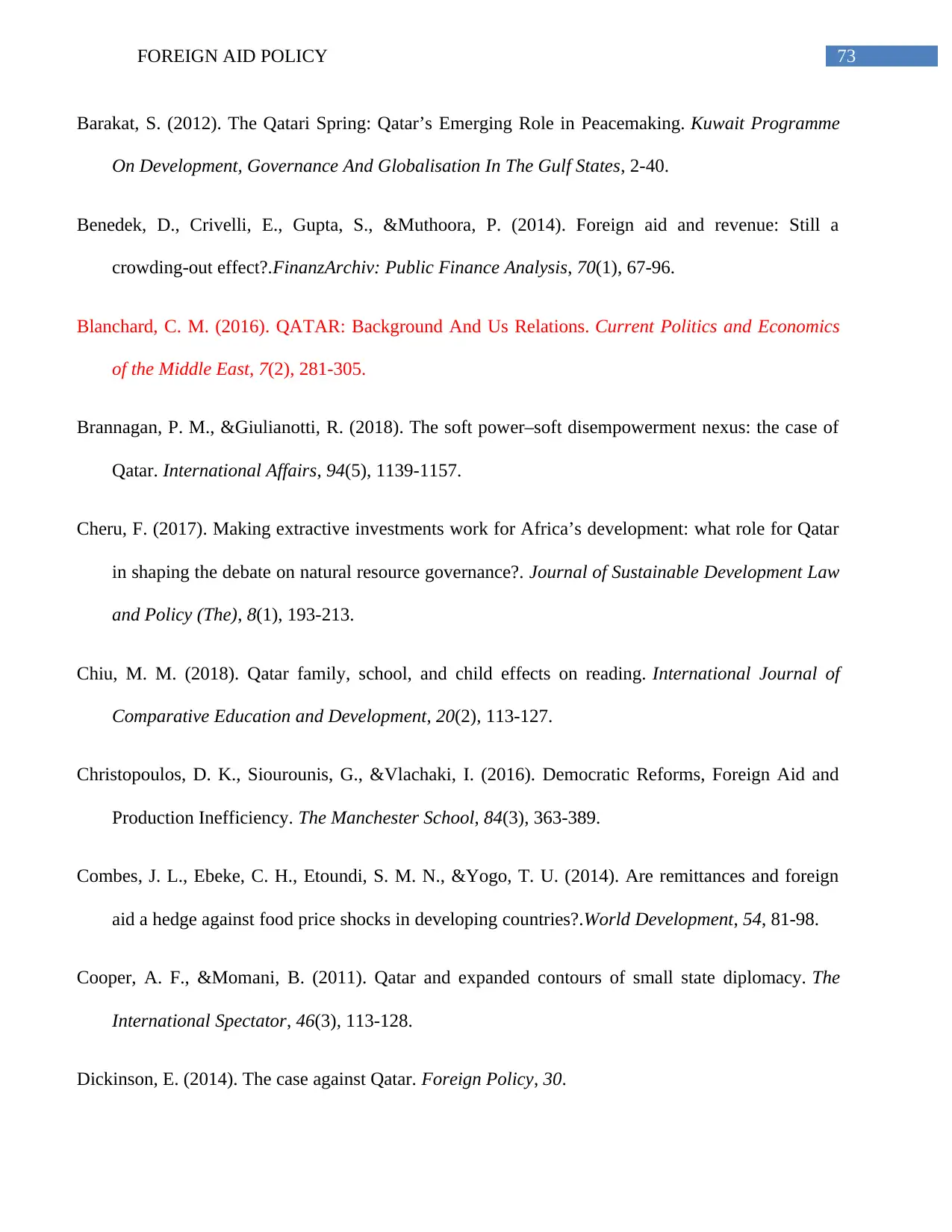
73FOREIGN AID POLICY
Barakat, S. (2012). The Qatari Spring: Qatar’s Emerging Role in Peacemaking. Kuwait Programme
On Development, Governance And Globalisation In The Gulf States, 2-40.
Benedek, D., Crivelli, E., Gupta, S., &Muthoora, P. (2014). Foreign aid and revenue: Still a
crowding-out effect?.FinanzArchiv: Public Finance Analysis, 70(1), 67-96.
Blanchard, C. M. (2016). QATAR: Background And Us Relations. Current Politics and Economics
of the Middle East, 7(2), 281-305.
Brannagan, P. M., &Giulianotti, R. (2018). The soft power–soft disempowerment nexus: the case of
Qatar. International Affairs, 94(5), 1139-1157.
Cheru, F. (2017). Making extractive investments work for Africa’s development: what role for Qatar
in shaping the debate on natural resource governance?. Journal of Sustainable Development Law
and Policy (The), 8(1), 193-213.
Chiu, M. M. (2018). Qatar family, school, and child effects on reading. International Journal of
Comparative Education and Development, 20(2), 113-127.
Christopoulos, D. K., Siourounis, G., &Vlachaki, I. (2016). Democratic Reforms, Foreign Aid and
Production Inefficiency. The Manchester School, 84(3), 363-389.
Combes, J. L., Ebeke, C. H., Etoundi, S. M. N., &Yogo, T. U. (2014). Are remittances and foreign
aid a hedge against food price shocks in developing countries?.World Development, 54, 81-98.
Cooper, A. F., &Momani, B. (2011). Qatar and expanded contours of small state diplomacy. The
International Spectator, 46(3), 113-128.
Dickinson, E. (2014). The case against Qatar. Foreign Policy, 30.
Barakat, S. (2012). The Qatari Spring: Qatar’s Emerging Role in Peacemaking. Kuwait Programme
On Development, Governance And Globalisation In The Gulf States, 2-40.
Benedek, D., Crivelli, E., Gupta, S., &Muthoora, P. (2014). Foreign aid and revenue: Still a
crowding-out effect?.FinanzArchiv: Public Finance Analysis, 70(1), 67-96.
Blanchard, C. M. (2016). QATAR: Background And Us Relations. Current Politics and Economics
of the Middle East, 7(2), 281-305.
Brannagan, P. M., &Giulianotti, R. (2018). The soft power–soft disempowerment nexus: the case of
Qatar. International Affairs, 94(5), 1139-1157.
Cheru, F. (2017). Making extractive investments work for Africa’s development: what role for Qatar
in shaping the debate on natural resource governance?. Journal of Sustainable Development Law
and Policy (The), 8(1), 193-213.
Chiu, M. M. (2018). Qatar family, school, and child effects on reading. International Journal of
Comparative Education and Development, 20(2), 113-127.
Christopoulos, D. K., Siourounis, G., &Vlachaki, I. (2016). Democratic Reforms, Foreign Aid and
Production Inefficiency. The Manchester School, 84(3), 363-389.
Combes, J. L., Ebeke, C. H., Etoundi, S. M. N., &Yogo, T. U. (2014). Are remittances and foreign
aid a hedge against food price shocks in developing countries?.World Development, 54, 81-98.
Cooper, A. F., &Momani, B. (2011). Qatar and expanded contours of small state diplomacy. The
International Spectator, 46(3), 113-128.
Dickinson, E. (2014). The case against Qatar. Foreign Policy, 30.
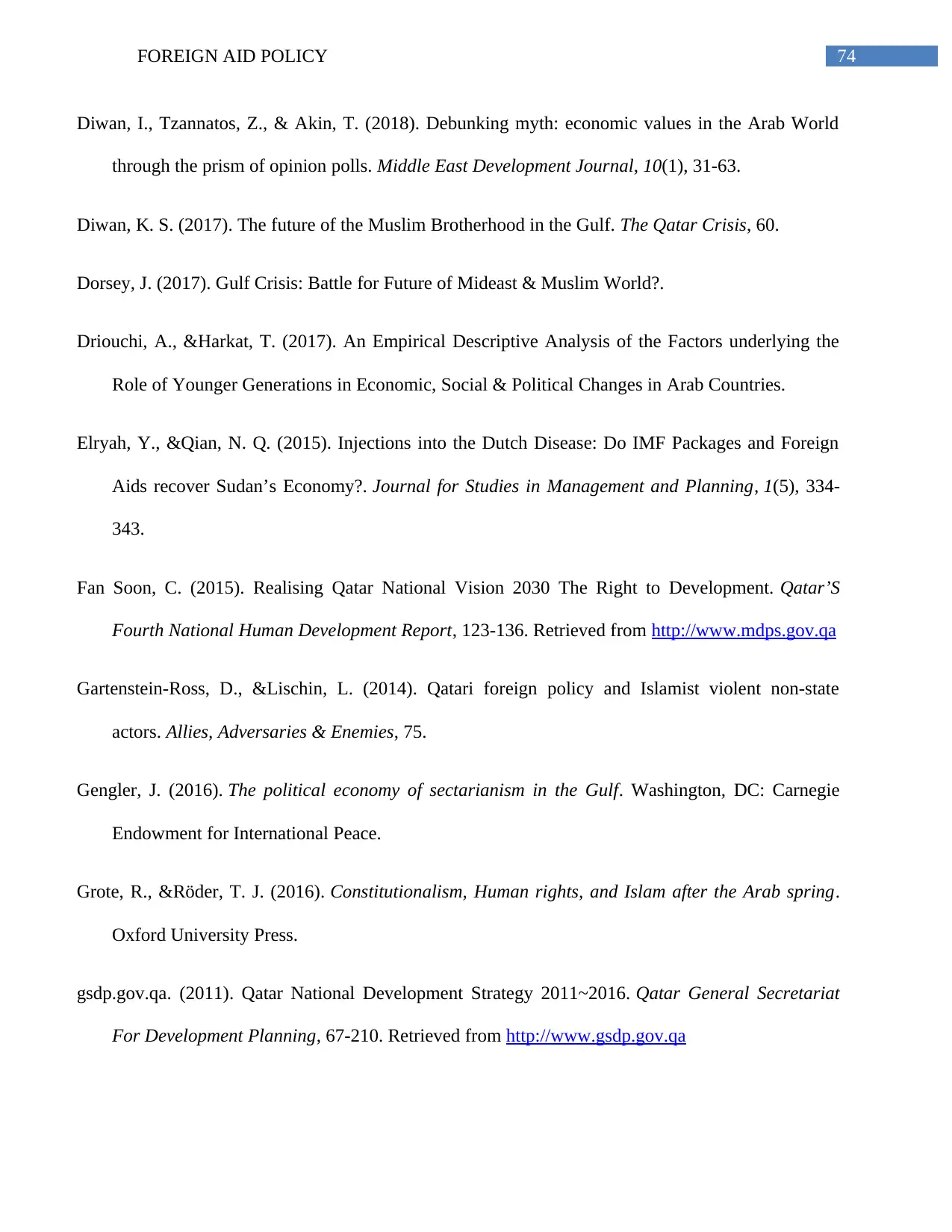
74FOREIGN AID POLICY
Diwan, I., Tzannatos, Z., & Akin, T. (2018). Debunking myth: economic values in the Arab World
through the prism of opinion polls. Middle East Development Journal, 10(1), 31-63.
Diwan, K. S. (2017). The future of the Muslim Brotherhood in the Gulf. The Qatar Crisis, 60.
Dorsey, J. (2017). Gulf Crisis: Battle for Future of Mideast & Muslim World?.
Driouchi, A., &Harkat, T. (2017). An Empirical Descriptive Analysis of the Factors underlying the
Role of Younger Generations in Economic, Social & Political Changes in Arab Countries.
Elryah, Y., &Qian, N. Q. (2015). Injections into the Dutch Disease: Do IMF Packages and Foreign
Aids recover Sudan’s Economy?. Journal for Studies in Management and Planning, 1(5), 334-
343.
Fan Soon, C. (2015). Realising Qatar National Vision 2030 The Right to Development. Qatar’S
Fourth National Human Development Report, 123-136. Retrieved from http://www.mdps.gov.qa
Gartenstein-Ross, D., &Lischin, L. (2014). Qatari foreign policy and Islamist violent non-state
actors. Allies, Adversaries & Enemies, 75.
Gengler, J. (2016). The political economy of sectarianism in the Gulf. Washington, DC: Carnegie
Endowment for International Peace.
Grote, R., &Röder, T. J. (2016). Constitutionalism, Human rights, and Islam after the Arab spring.
Oxford University Press.
gsdp.gov.qa. (2011). Qatar National Development Strategy 2011~2016. Qatar General Secretariat
For Development Planning, 67-210. Retrieved from http://www.gsdp.gov.qa
Diwan, I., Tzannatos, Z., & Akin, T. (2018). Debunking myth: economic values in the Arab World
through the prism of opinion polls. Middle East Development Journal, 10(1), 31-63.
Diwan, K. S. (2017). The future of the Muslim Brotherhood in the Gulf. The Qatar Crisis, 60.
Dorsey, J. (2017). Gulf Crisis: Battle for Future of Mideast & Muslim World?.
Driouchi, A., &Harkat, T. (2017). An Empirical Descriptive Analysis of the Factors underlying the
Role of Younger Generations in Economic, Social & Political Changes in Arab Countries.
Elryah, Y., &Qian, N. Q. (2015). Injections into the Dutch Disease: Do IMF Packages and Foreign
Aids recover Sudan’s Economy?. Journal for Studies in Management and Planning, 1(5), 334-
343.
Fan Soon, C. (2015). Realising Qatar National Vision 2030 The Right to Development. Qatar’S
Fourth National Human Development Report, 123-136. Retrieved from http://www.mdps.gov.qa
Gartenstein-Ross, D., &Lischin, L. (2014). Qatari foreign policy and Islamist violent non-state
actors. Allies, Adversaries & Enemies, 75.
Gengler, J. (2016). The political economy of sectarianism in the Gulf. Washington, DC: Carnegie
Endowment for International Peace.
Grote, R., &Röder, T. J. (2016). Constitutionalism, Human rights, and Islam after the Arab spring.
Oxford University Press.
gsdp.gov.qa. (2011). Qatar National Development Strategy 2011~2016. Qatar General Secretariat
For Development Planning, 67-210. Retrieved from http://www.gsdp.gov.qa
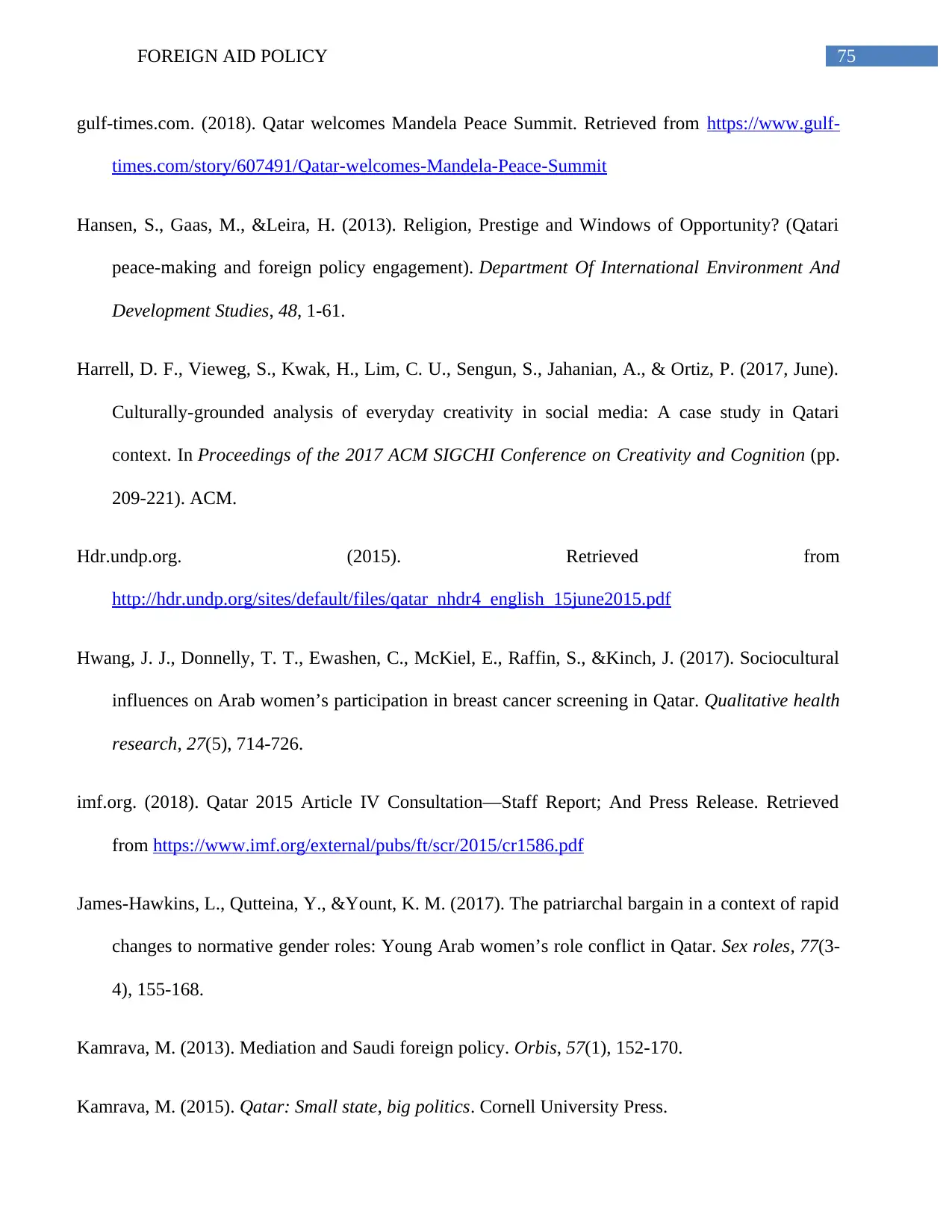
75FOREIGN AID POLICY
gulf-times.com. (2018). Qatar welcomes Mandela Peace Summit. Retrieved from https://www.gulf-
times.com/story/607491/Qatar-welcomes-Mandela-Peace-Summit
Hansen, S., Gaas, M., &Leira, H. (2013). Religion, Prestige and Windows of Opportunity? (Qatari
peace-making and foreign policy engagement). Department Of International Environment And
Development Studies, 48, 1-61.
Harrell, D. F., Vieweg, S., Kwak, H., Lim, C. U., Sengun, S., Jahanian, A., & Ortiz, P. (2017, June).
Culturally-grounded analysis of everyday creativity in social media: A case study in Qatari
context. In Proceedings of the 2017 ACM SIGCHI Conference on Creativity and Cognition (pp.
209-221). ACM.
Hdr.undp.org. (2015). Retrieved from
http://hdr.undp.org/sites/default/files/qatar_nhdr4_english_15june2015.pdf
Hwang, J. J., Donnelly, T. T., Ewashen, C., McKiel, E., Raffin, S., &Kinch, J. (2017). Sociocultural
influences on Arab women’s participation in breast cancer screening in Qatar. Qualitative health
research, 27(5), 714-726.
imf.org. (2018). Qatar 2015 Article IV Consultation—Staff Report; And Press Release. Retrieved
from https://www.imf.org/external/pubs/ft/scr/2015/cr1586.pdf
James-Hawkins, L., Qutteina, Y., &Yount, K. M. (2017). The patriarchal bargain in a context of rapid
changes to normative gender roles: Young Arab women’s role conflict in Qatar. Sex roles, 77(3-
4), 155-168.
Kamrava, M. (2013). Mediation and Saudi foreign policy. Orbis, 57(1), 152-170.
Kamrava, M. (2015). Qatar: Small state, big politics. Cornell University Press.
gulf-times.com. (2018). Qatar welcomes Mandela Peace Summit. Retrieved from https://www.gulf-
times.com/story/607491/Qatar-welcomes-Mandela-Peace-Summit
Hansen, S., Gaas, M., &Leira, H. (2013). Religion, Prestige and Windows of Opportunity? (Qatari
peace-making and foreign policy engagement). Department Of International Environment And
Development Studies, 48, 1-61.
Harrell, D. F., Vieweg, S., Kwak, H., Lim, C. U., Sengun, S., Jahanian, A., & Ortiz, P. (2017, June).
Culturally-grounded analysis of everyday creativity in social media: A case study in Qatari
context. In Proceedings of the 2017 ACM SIGCHI Conference on Creativity and Cognition (pp.
209-221). ACM.
Hdr.undp.org. (2015). Retrieved from
http://hdr.undp.org/sites/default/files/qatar_nhdr4_english_15june2015.pdf
Hwang, J. J., Donnelly, T. T., Ewashen, C., McKiel, E., Raffin, S., &Kinch, J. (2017). Sociocultural
influences on Arab women’s participation in breast cancer screening in Qatar. Qualitative health
research, 27(5), 714-726.
imf.org. (2018). Qatar 2015 Article IV Consultation—Staff Report; And Press Release. Retrieved
from https://www.imf.org/external/pubs/ft/scr/2015/cr1586.pdf
James-Hawkins, L., Qutteina, Y., &Yount, K. M. (2017). The patriarchal bargain in a context of rapid
changes to normative gender roles: Young Arab women’s role conflict in Qatar. Sex roles, 77(3-
4), 155-168.
Kamrava, M. (2013). Mediation and Saudi foreign policy. Orbis, 57(1), 152-170.
Kamrava, M. (2015). Qatar: Small state, big politics. Cornell University Press.
Secure Best Marks with AI Grader
Need help grading? Try our AI Grader for instant feedback on your assignments.
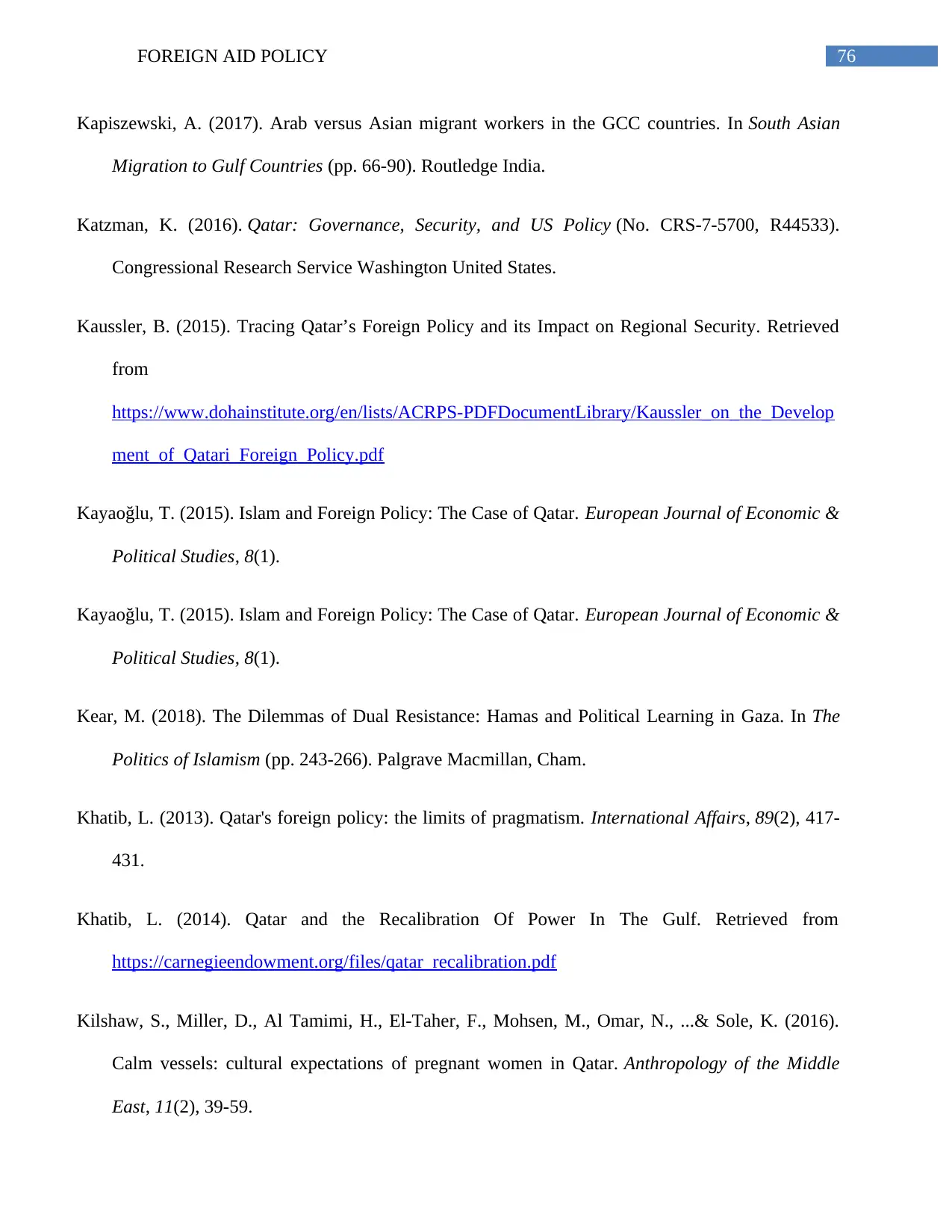
76FOREIGN AID POLICY
Kapiszewski, A. (2017). Arab versus Asian migrant workers in the GCC countries. In South Asian
Migration to Gulf Countries (pp. 66-90). Routledge India.
Katzman, K. (2016). Qatar: Governance, Security, and US Policy (No. CRS-7-5700, R44533).
Congressional Research Service Washington United States.
Kaussler, B. (2015). Tracing Qatar’s Foreign Policy and its Impact on Regional Security. Retrieved
from
https://www.dohainstitute.org/en/lists/ACRPS-PDFDocumentLibrary/Kaussler_on_the_Develop
ment_of_Qatari_Foreign_Policy.pdf
Kayaoğlu, T. (2015). Islam and Foreign Policy: The Case of Qatar. European Journal of Economic &
Political Studies, 8(1).
Kayaoğlu, T. (2015). Islam and Foreign Policy: The Case of Qatar. European Journal of Economic &
Political Studies, 8(1).
Kear, M. (2018). The Dilemmas of Dual Resistance: Hamas and Political Learning in Gaza. In The
Politics of Islamism (pp. 243-266). Palgrave Macmillan, Cham.
Khatib, L. (2013). Qatar's foreign policy: the limits of pragmatism. International Affairs, 89(2), 417-
431.
Khatib, L. (2014). Qatar and the Recalibration Of Power In The Gulf. Retrieved from
https://carnegieendowment.org/files/qatar_recalibration.pdf
Kilshaw, S., Miller, D., Al Tamimi, H., El-Taher, F., Mohsen, M., Omar, N., ...& Sole, K. (2016).
Calm vessels: cultural expectations of pregnant women in Qatar. Anthropology of the Middle
East, 11(2), 39-59.
Kapiszewski, A. (2017). Arab versus Asian migrant workers in the GCC countries. In South Asian
Migration to Gulf Countries (pp. 66-90). Routledge India.
Katzman, K. (2016). Qatar: Governance, Security, and US Policy (No. CRS-7-5700, R44533).
Congressional Research Service Washington United States.
Kaussler, B. (2015). Tracing Qatar’s Foreign Policy and its Impact on Regional Security. Retrieved
from
https://www.dohainstitute.org/en/lists/ACRPS-PDFDocumentLibrary/Kaussler_on_the_Develop
ment_of_Qatari_Foreign_Policy.pdf
Kayaoğlu, T. (2015). Islam and Foreign Policy: The Case of Qatar. European Journal of Economic &
Political Studies, 8(1).
Kayaoğlu, T. (2015). Islam and Foreign Policy: The Case of Qatar. European Journal of Economic &
Political Studies, 8(1).
Kear, M. (2018). The Dilemmas of Dual Resistance: Hamas and Political Learning in Gaza. In The
Politics of Islamism (pp. 243-266). Palgrave Macmillan, Cham.
Khatib, L. (2013). Qatar's foreign policy: the limits of pragmatism. International Affairs, 89(2), 417-
431.
Khatib, L. (2014). Qatar and the Recalibration Of Power In The Gulf. Retrieved from
https://carnegieendowment.org/files/qatar_recalibration.pdf
Kilshaw, S., Miller, D., Al Tamimi, H., El-Taher, F., Mohsen, M., Omar, N., ...& Sole, K. (2016).
Calm vessels: cultural expectations of pregnant women in Qatar. Anthropology of the Middle
East, 11(2), 39-59.
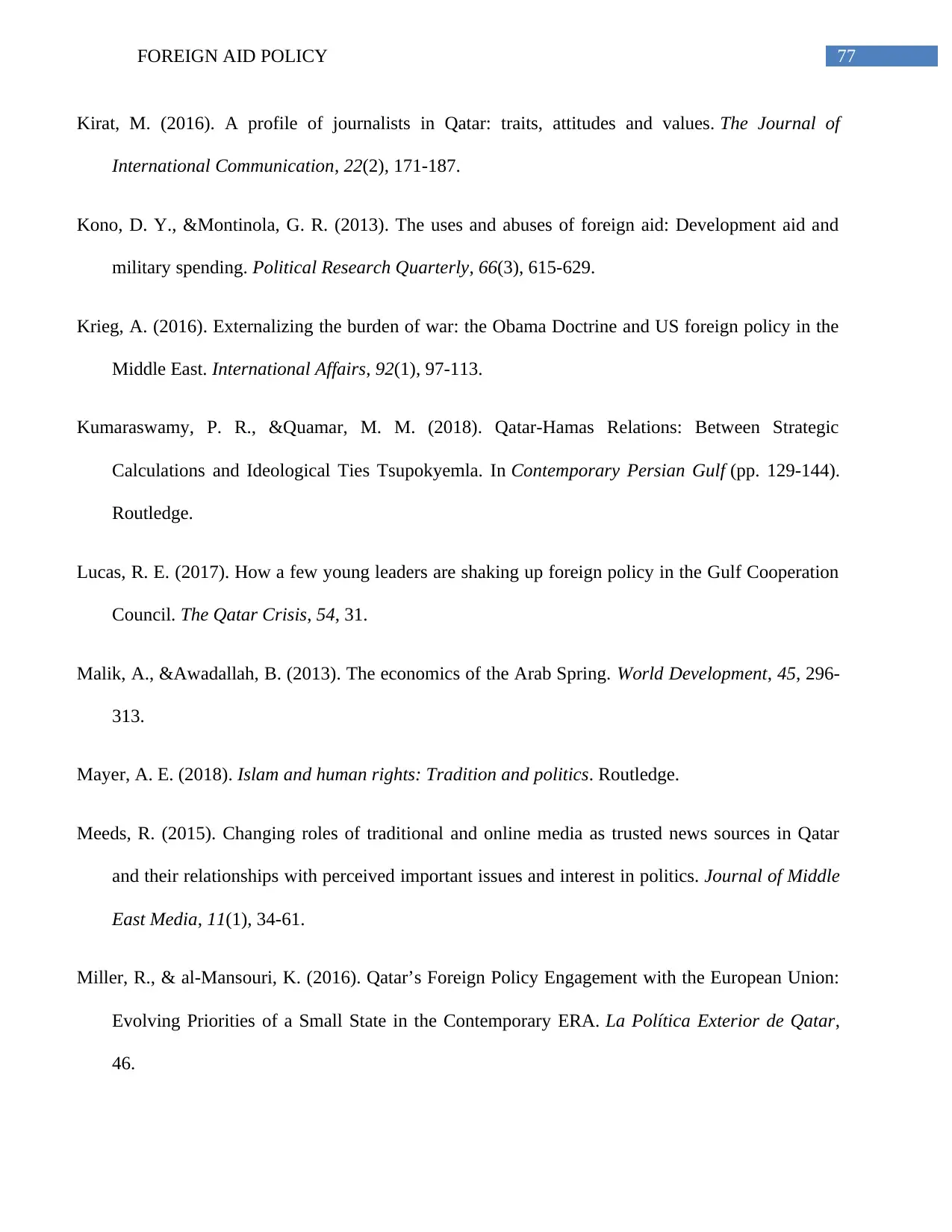
77FOREIGN AID POLICY
Kirat, M. (2016). A profile of journalists in Qatar: traits, attitudes and values. The Journal of
International Communication, 22(2), 171-187.
Kono, D. Y., &Montinola, G. R. (2013). The uses and abuses of foreign aid: Development aid and
military spending. Political Research Quarterly, 66(3), 615-629.
Krieg, A. (2016). Externalizing the burden of war: the Obama Doctrine and US foreign policy in the
Middle East. International Affairs, 92(1), 97-113.
Kumaraswamy, P. R., &Quamar, M. M. (2018). Qatar-Hamas Relations: Between Strategic
Calculations and Ideological Ties Tsupokyemla. In Contemporary Persian Gulf (pp. 129-144).
Routledge.
Lucas, R. E. (2017). How a few young leaders are shaking up foreign policy in the Gulf Cooperation
Council. The Qatar Crisis, 54, 31.
Malik, A., &Awadallah, B. (2013). The economics of the Arab Spring. World Development, 45, 296-
313.
Mayer, A. E. (2018). Islam and human rights: Tradition and politics. Routledge.
Meeds, R. (2015). Changing roles of traditional and online media as trusted news sources in Qatar
and their relationships with perceived important issues and interest in politics. Journal of Middle
East Media, 11(1), 34-61.
Miller, R., & al-Mansouri, K. (2016). Qatar’s Foreign Policy Engagement with the European Union:
Evolving Priorities of a Small State in the Contemporary ERA. La Política Exterior de Qatar,
46.
Kirat, M. (2016). A profile of journalists in Qatar: traits, attitudes and values. The Journal of
International Communication, 22(2), 171-187.
Kono, D. Y., &Montinola, G. R. (2013). The uses and abuses of foreign aid: Development aid and
military spending. Political Research Quarterly, 66(3), 615-629.
Krieg, A. (2016). Externalizing the burden of war: the Obama Doctrine and US foreign policy in the
Middle East. International Affairs, 92(1), 97-113.
Kumaraswamy, P. R., &Quamar, M. M. (2018). Qatar-Hamas Relations: Between Strategic
Calculations and Ideological Ties Tsupokyemla. In Contemporary Persian Gulf (pp. 129-144).
Routledge.
Lucas, R. E. (2017). How a few young leaders are shaking up foreign policy in the Gulf Cooperation
Council. The Qatar Crisis, 54, 31.
Malik, A., &Awadallah, B. (2013). The economics of the Arab Spring. World Development, 45, 296-
313.
Mayer, A. E. (2018). Islam and human rights: Tradition and politics. Routledge.
Meeds, R. (2015). Changing roles of traditional and online media as trusted news sources in Qatar
and their relationships with perceived important issues and interest in politics. Journal of Middle
East Media, 11(1), 34-61.
Miller, R., & al-Mansouri, K. (2016). Qatar’s Foreign Policy Engagement with the European Union:
Evolving Priorities of a Small State in the Contemporary ERA. La Política Exterior de Qatar,
46.
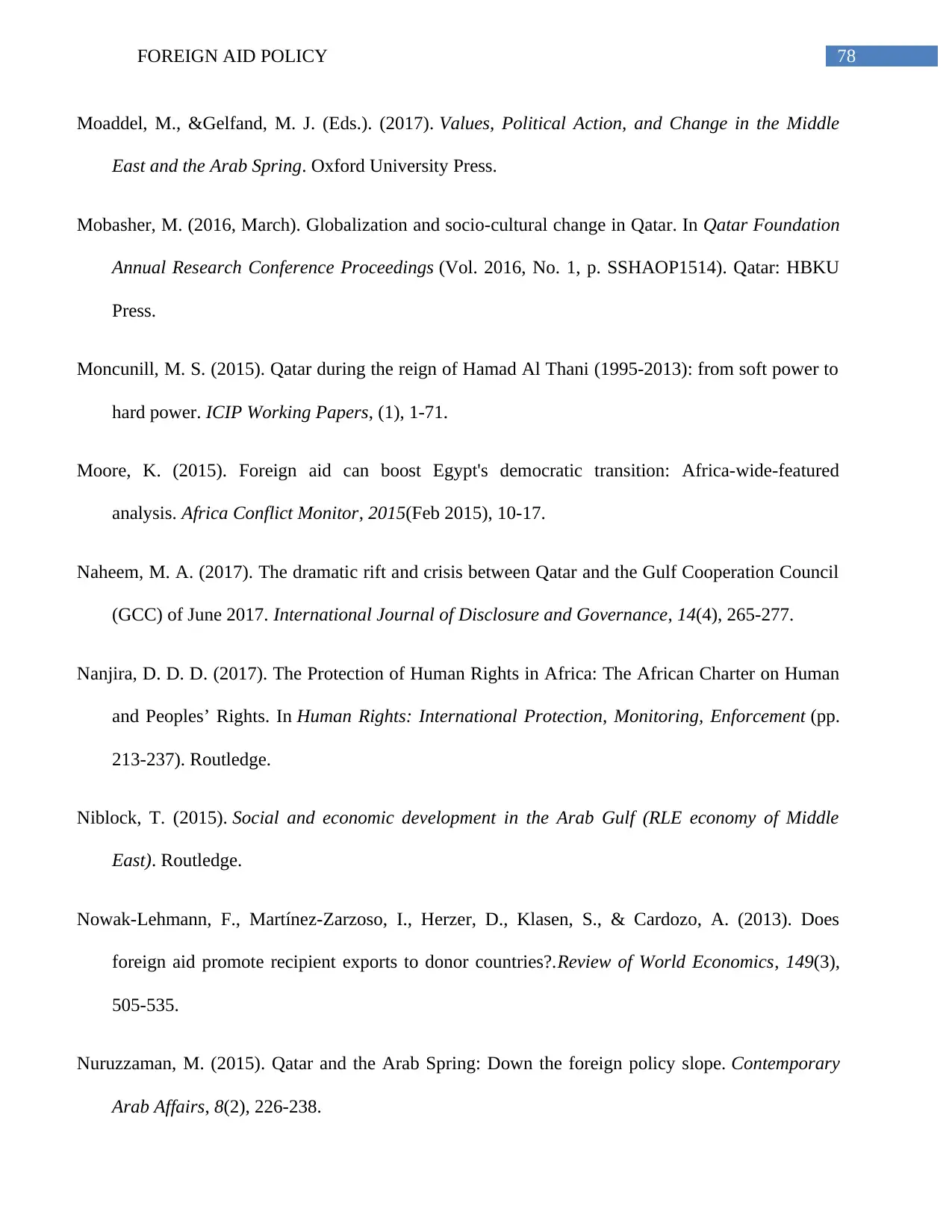
78FOREIGN AID POLICY
Moaddel, M., &Gelfand, M. J. (Eds.). (2017). Values, Political Action, and Change in the Middle
East and the Arab Spring. Oxford University Press.
Mobasher, M. (2016, March). Globalization and socio-cultural change in Qatar. In Qatar Foundation
Annual Research Conference Proceedings (Vol. 2016, No. 1, p. SSHAOP1514). Qatar: HBKU
Press.
Moncunill, M. S. (2015). Qatar during the reign of Hamad Al Thani (1995-2013): from soft power to
hard power. ICIP Working Papers, (1), 1-71.
Moore, K. (2015). Foreign aid can boost Egypt's democratic transition: Africa-wide-featured
analysis. Africa Conflict Monitor, 2015(Feb 2015), 10-17.
Naheem, M. A. (2017). The dramatic rift and crisis between Qatar and the Gulf Cooperation Council
(GCC) of June 2017. International Journal of Disclosure and Governance, 14(4), 265-277.
Nanjira, D. D. D. (2017). The Protection of Human Rights in Africa: The African Charter on Human
and Peoples’ Rights. In Human Rights: International Protection, Monitoring, Enforcement (pp.
213-237). Routledge.
Niblock, T. (2015). Social and economic development in the Arab Gulf (RLE economy of Middle
East). Routledge.
Nowak-Lehmann, F., Martínez-Zarzoso, I., Herzer, D., Klasen, S., & Cardozo, A. (2013). Does
foreign aid promote recipient exports to donor countries?.Review of World Economics, 149(3),
505-535.
Nuruzzaman, M. (2015). Qatar and the Arab Spring: Down the foreign policy slope. Contemporary
Arab Affairs, 8(2), 226-238.
Moaddel, M., &Gelfand, M. J. (Eds.). (2017). Values, Political Action, and Change in the Middle
East and the Arab Spring. Oxford University Press.
Mobasher, M. (2016, March). Globalization and socio-cultural change in Qatar. In Qatar Foundation
Annual Research Conference Proceedings (Vol. 2016, No. 1, p. SSHAOP1514). Qatar: HBKU
Press.
Moncunill, M. S. (2015). Qatar during the reign of Hamad Al Thani (1995-2013): from soft power to
hard power. ICIP Working Papers, (1), 1-71.
Moore, K. (2015). Foreign aid can boost Egypt's democratic transition: Africa-wide-featured
analysis. Africa Conflict Monitor, 2015(Feb 2015), 10-17.
Naheem, M. A. (2017). The dramatic rift and crisis between Qatar and the Gulf Cooperation Council
(GCC) of June 2017. International Journal of Disclosure and Governance, 14(4), 265-277.
Nanjira, D. D. D. (2017). The Protection of Human Rights in Africa: The African Charter on Human
and Peoples’ Rights. In Human Rights: International Protection, Monitoring, Enforcement (pp.
213-237). Routledge.
Niblock, T. (2015). Social and economic development in the Arab Gulf (RLE economy of Middle
East). Routledge.
Nowak-Lehmann, F., Martínez-Zarzoso, I., Herzer, D., Klasen, S., & Cardozo, A. (2013). Does
foreign aid promote recipient exports to donor countries?.Review of World Economics, 149(3),
505-535.
Nuruzzaman, M. (2015). Qatar and the Arab Spring: Down the foreign policy slope. Contemporary
Arab Affairs, 8(2), 226-238.
Paraphrase This Document
Need a fresh take? Get an instant paraphrase of this document with our AI Paraphraser
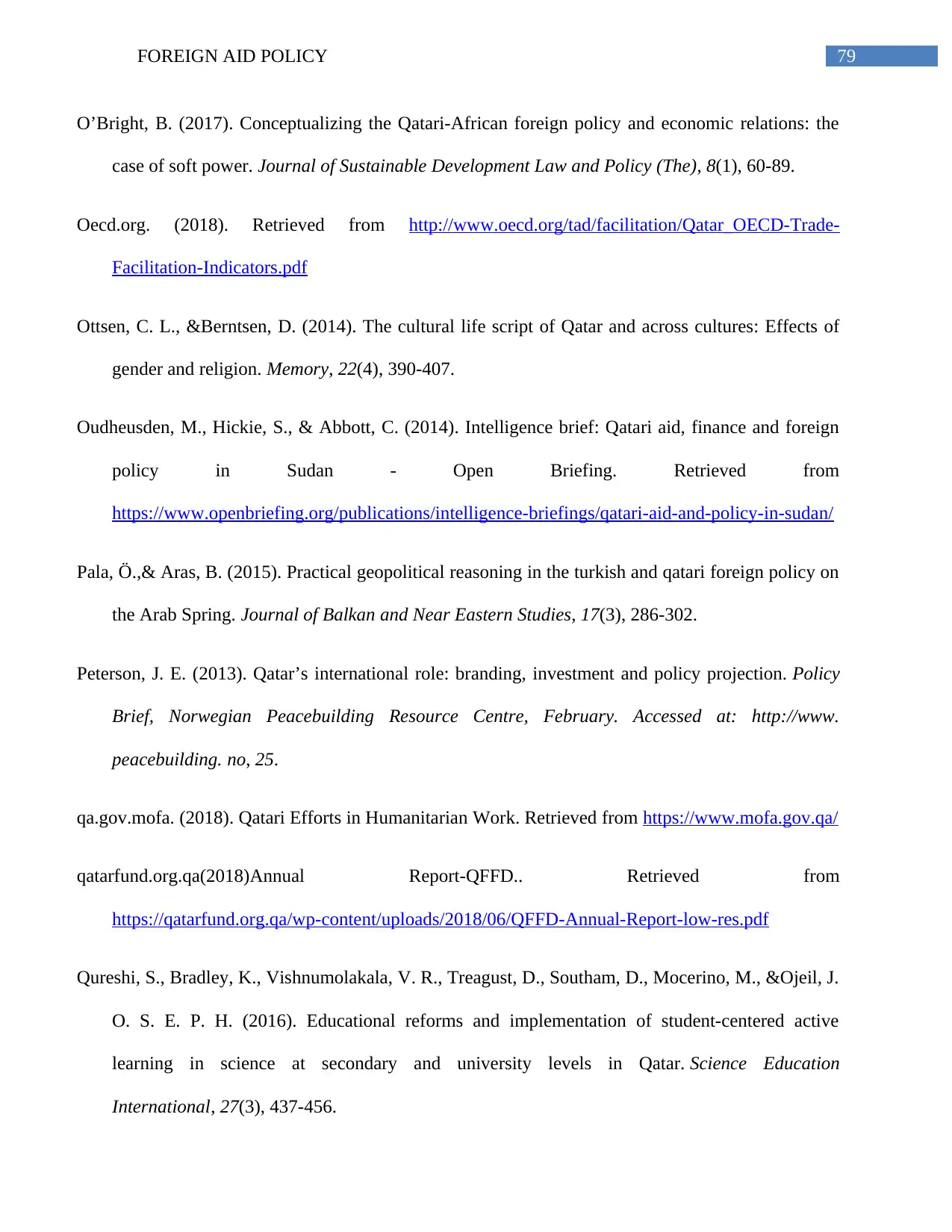
79FOREIGN AID POLICY
O’Bright, B. (2017). Conceptualizing the Qatari-African foreign policy and economic relations: the
case of soft power. Journal of Sustainable Development Law and Policy (The), 8(1), 60-89.
Oecd.org. (2018). Retrieved from http://www.oecd.org/tad/facilitation/Qatar_OECD-Trade-
Facilitation-Indicators.pdf
Ottsen, C. L., &Berntsen, D. (2014). The cultural life script of Qatar and across cultures: Effects of
gender and religion. Memory, 22(4), 390-407.
Oudheusden, M., Hickie, S., & Abbott, C. (2014). Intelligence brief: Qatari aid, finance and foreign
policy in Sudan - Open Briefing. Retrieved from
https://www.openbriefing.org/publications/intelligence-briefings/qatari-aid-and-policy-in-sudan/
Pala, Ö.,& Aras, B. (2015). Practical geopolitical reasoning in the turkish and qatari foreign policy on
the Arab Spring. Journal of Balkan and Near Eastern Studies, 17(3), 286-302.
Peterson, J. E. (2013). Qatar’s international role: branding, investment and policy projection. Policy
Brief, Norwegian Peacebuilding Resource Centre, February. Accessed at: http://www.
peacebuilding. no, 25.
qa.gov.mofa. (2018). Qatari Efforts in Humanitarian Work. Retrieved from https://www.mofa.gov.qa/
qatarfund.org.qa(2018)Annual Report-QFFD.. Retrieved from
https://qatarfund.org.qa/wp-content/uploads/2018/06/QFFD-Annual-Report-low-res.pdf
Qureshi, S., Bradley, K., Vishnumolakala, V. R., Treagust, D., Southam, D., Mocerino, M., &Ojeil, J.
O. S. E. P. H. (2016). Educational reforms and implementation of student-centered active
learning in science at secondary and university levels in Qatar. Science Education
International, 27(3), 437-456.
O’Bright, B. (2017). Conceptualizing the Qatari-African foreign policy and economic relations: the
case of soft power. Journal of Sustainable Development Law and Policy (The), 8(1), 60-89.
Oecd.org. (2018). Retrieved from http://www.oecd.org/tad/facilitation/Qatar_OECD-Trade-
Facilitation-Indicators.pdf
Ottsen, C. L., &Berntsen, D. (2014). The cultural life script of Qatar and across cultures: Effects of
gender and religion. Memory, 22(4), 390-407.
Oudheusden, M., Hickie, S., & Abbott, C. (2014). Intelligence brief: Qatari aid, finance and foreign
policy in Sudan - Open Briefing. Retrieved from
https://www.openbriefing.org/publications/intelligence-briefings/qatari-aid-and-policy-in-sudan/
Pala, Ö.,& Aras, B. (2015). Practical geopolitical reasoning in the turkish and qatari foreign policy on
the Arab Spring. Journal of Balkan and Near Eastern Studies, 17(3), 286-302.
Peterson, J. E. (2013). Qatar’s international role: branding, investment and policy projection. Policy
Brief, Norwegian Peacebuilding Resource Centre, February. Accessed at: http://www.
peacebuilding. no, 25.
qa.gov.mofa. (2018). Qatari Efforts in Humanitarian Work. Retrieved from https://www.mofa.gov.qa/
qatarfund.org.qa(2018)Annual Report-QFFD.. Retrieved from
https://qatarfund.org.qa/wp-content/uploads/2018/06/QFFD-Annual-Report-low-res.pdf
Qureshi, S., Bradley, K., Vishnumolakala, V. R., Treagust, D., Southam, D., Mocerino, M., &Ojeil, J.
O. S. E. P. H. (2016). Educational reforms and implementation of student-centered active
learning in science at secondary and university levels in Qatar. Science Education
International, 27(3), 437-456.
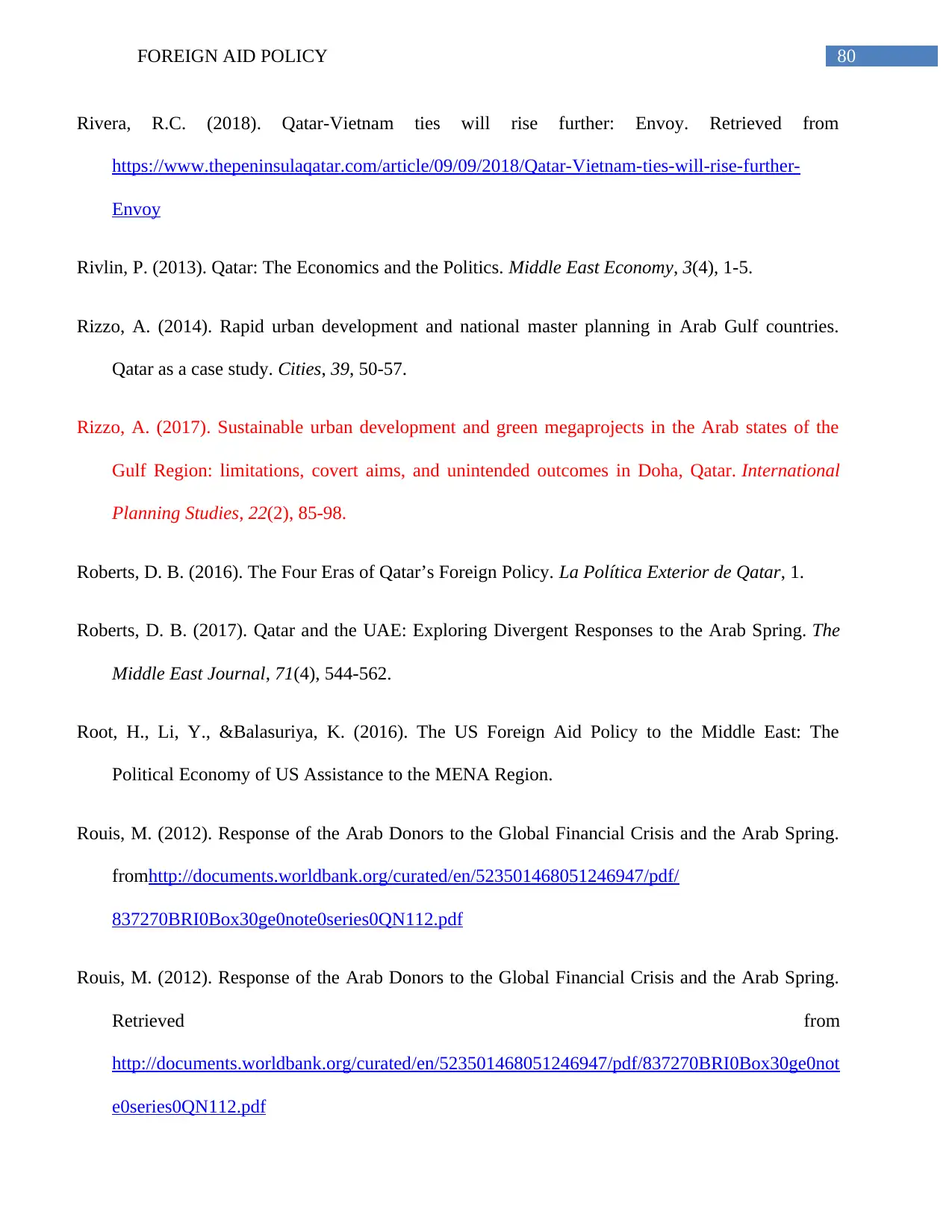
80FOREIGN AID POLICY
Rivera, R.C. (2018). Qatar-Vietnam ties will rise further: Envoy. Retrieved from
https://www.thepeninsulaqatar.com/article/09/09/2018/Qatar-Vietnam-ties-will-rise-further-
Envoy
Rivlin, P. (2013). Qatar: The Economics and the Politics. Middle East Economy, 3(4), 1-5.
Rizzo, A. (2014). Rapid urban development and national master planning in Arab Gulf countries.
Qatar as a case study. Cities, 39, 50-57.
Rizzo, A. (2017). Sustainable urban development and green megaprojects in the Arab states of the
Gulf Region: limitations, covert aims, and unintended outcomes in Doha, Qatar. International
Planning Studies, 22(2), 85-98.
Roberts, D. B. (2016). The Four Eras of Qatar’s Foreign Policy. La Política Exterior de Qatar, 1.
Roberts, D. B. (2017). Qatar and the UAE: Exploring Divergent Responses to the Arab Spring. The
Middle East Journal, 71(4), 544-562.
Root, H., Li, Y., &Balasuriya, K. (2016). The US Foreign Aid Policy to the Middle East: The
Political Economy of US Assistance to the MENA Region.
Rouis, M. (2012). Response of the Arab Donors to the Global Financial Crisis and the Arab Spring.
fromhttp://documents.worldbank.org/curated/en/523501468051246947/pdf/
837270BRI0Box30ge0note0series0QN112.pdf
Rouis, M. (2012). Response of the Arab Donors to the Global Financial Crisis and the Arab Spring.
Retrieved from
http://documents.worldbank.org/curated/en/523501468051246947/pdf/837270BRI0Box30ge0not
e0series0QN112.pdf
Rivera, R.C. (2018). Qatar-Vietnam ties will rise further: Envoy. Retrieved from
https://www.thepeninsulaqatar.com/article/09/09/2018/Qatar-Vietnam-ties-will-rise-further-
Envoy
Rivlin, P. (2013). Qatar: The Economics and the Politics. Middle East Economy, 3(4), 1-5.
Rizzo, A. (2014). Rapid urban development and national master planning in Arab Gulf countries.
Qatar as a case study. Cities, 39, 50-57.
Rizzo, A. (2017). Sustainable urban development and green megaprojects in the Arab states of the
Gulf Region: limitations, covert aims, and unintended outcomes in Doha, Qatar. International
Planning Studies, 22(2), 85-98.
Roberts, D. B. (2016). The Four Eras of Qatar’s Foreign Policy. La Política Exterior de Qatar, 1.
Roberts, D. B. (2017). Qatar and the UAE: Exploring Divergent Responses to the Arab Spring. The
Middle East Journal, 71(4), 544-562.
Root, H., Li, Y., &Balasuriya, K. (2016). The US Foreign Aid Policy to the Middle East: The
Political Economy of US Assistance to the MENA Region.
Rouis, M. (2012). Response of the Arab Donors to the Global Financial Crisis and the Arab Spring.
fromhttp://documents.worldbank.org/curated/en/523501468051246947/pdf/
837270BRI0Box30ge0note0series0QN112.pdf
Rouis, M. (2012). Response of the Arab Donors to the Global Financial Crisis and the Arab Spring.
Retrieved from
http://documents.worldbank.org/curated/en/523501468051246947/pdf/837270BRI0Box30ge0not
e0series0QN112.pdf
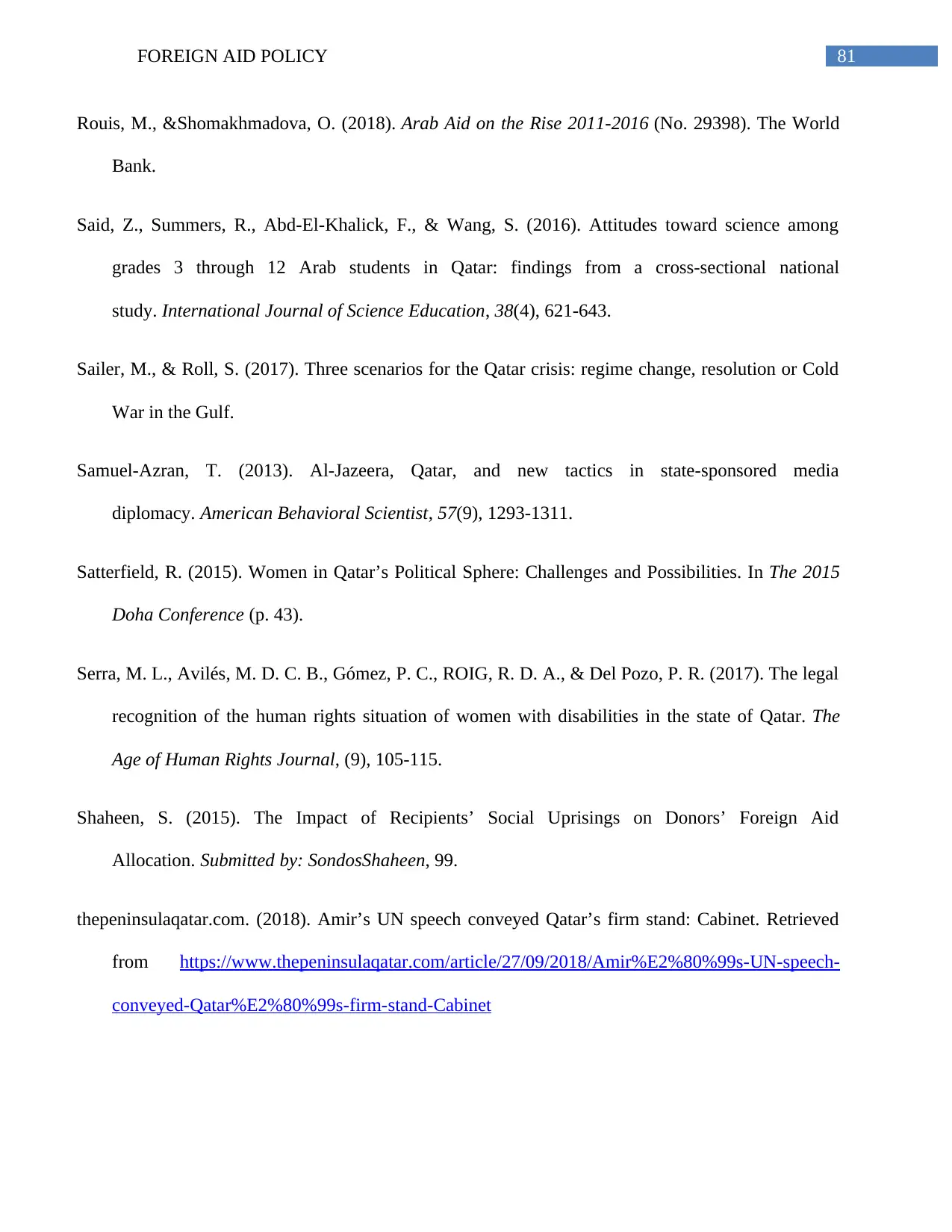
81FOREIGN AID POLICY
Rouis, M., &Shomakhmadova, O. (2018). Arab Aid on the Rise 2011-2016 (No. 29398). The World
Bank.
Said, Z., Summers, R., Abd-El-Khalick, F., & Wang, S. (2016). Attitudes toward science among
grades 3 through 12 Arab students in Qatar: findings from a cross-sectional national
study. International Journal of Science Education, 38(4), 621-643.
Sailer, M., & Roll, S. (2017). Three scenarios for the Qatar crisis: regime change, resolution or Cold
War in the Gulf.
Samuel-Azran, T. (2013). Al-Jazeera, Qatar, and new tactics in state-sponsored media
diplomacy. American Behavioral Scientist, 57(9), 1293-1311.
Satterfield, R. (2015). Women in Qatar’s Political Sphere: Challenges and Possibilities. In The 2015
Doha Conference (p. 43).
Serra, M. L., Avilés, M. D. C. B., Gómez, P. C., ROIG, R. D. A., & Del Pozo, P. R. (2017). The legal
recognition of the human rights situation of women with disabilities in the state of Qatar. The
Age of Human Rights Journal, (9), 105-115.
Shaheen, S. (2015). The Impact of Recipients’ Social Uprisings on Donors’ Foreign Aid
Allocation. Submitted by: SondosShaheen, 99.
thepeninsulaqatar.com. (2018). Amir’s UN speech conveyed Qatar’s firm stand: Cabinet. Retrieved
from https://www.thepeninsulaqatar.com/article/27/09/2018/Amir%E2%80%99s-UN-speech-
conveyed-Qatar%E2%80%99s-firm-stand-Cabinet
Rouis, M., &Shomakhmadova, O. (2018). Arab Aid on the Rise 2011-2016 (No. 29398). The World
Bank.
Said, Z., Summers, R., Abd-El-Khalick, F., & Wang, S. (2016). Attitudes toward science among
grades 3 through 12 Arab students in Qatar: findings from a cross-sectional national
study. International Journal of Science Education, 38(4), 621-643.
Sailer, M., & Roll, S. (2017). Three scenarios for the Qatar crisis: regime change, resolution or Cold
War in the Gulf.
Samuel-Azran, T. (2013). Al-Jazeera, Qatar, and new tactics in state-sponsored media
diplomacy. American Behavioral Scientist, 57(9), 1293-1311.
Satterfield, R. (2015). Women in Qatar’s Political Sphere: Challenges and Possibilities. In The 2015
Doha Conference (p. 43).
Serra, M. L., Avilés, M. D. C. B., Gómez, P. C., ROIG, R. D. A., & Del Pozo, P. R. (2017). The legal
recognition of the human rights situation of women with disabilities in the state of Qatar. The
Age of Human Rights Journal, (9), 105-115.
Shaheen, S. (2015). The Impact of Recipients’ Social Uprisings on Donors’ Foreign Aid
Allocation. Submitted by: SondosShaheen, 99.
thepeninsulaqatar.com. (2018). Amir’s UN speech conveyed Qatar’s firm stand: Cabinet. Retrieved
from https://www.thepeninsulaqatar.com/article/27/09/2018/Amir%E2%80%99s-UN-speech-
conveyed-Qatar%E2%80%99s-firm-stand-Cabinet
Secure Best Marks with AI Grader
Need help grading? Try our AI Grader for instant feedback on your assignments.
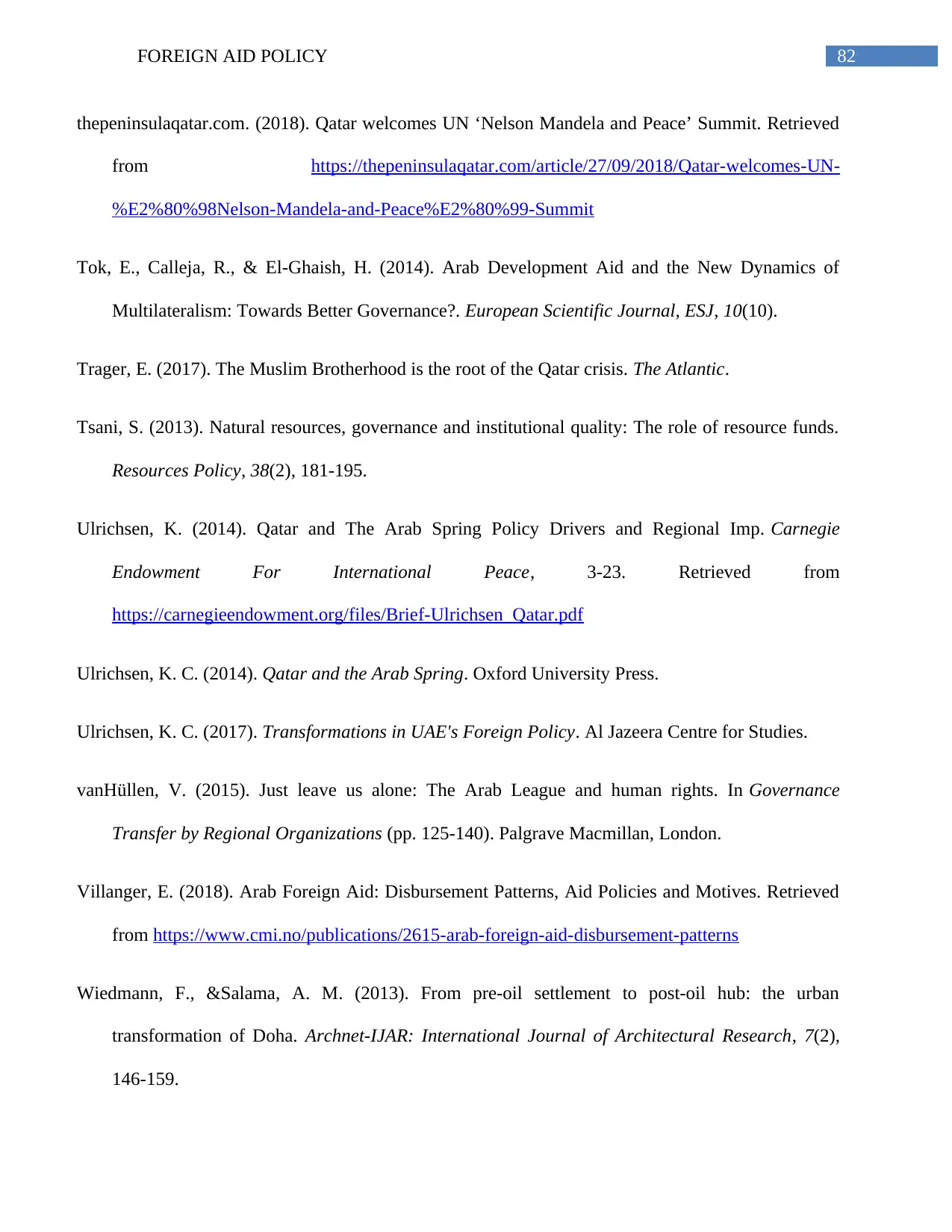
82FOREIGN AID POLICY
thepeninsulaqatar.com. (2018). Qatar welcomes UN ‘Nelson Mandela and Peace’ Summit. Retrieved
from https://thepeninsulaqatar.com/article/27/09/2018/Qatar-welcomes-UN-
%E2%80%98Nelson-Mandela-and-Peace%E2%80%99-Summit
Tok, E., Calleja, R., & El-Ghaish, H. (2014). Arab Development Aid and the New Dynamics of
Multilateralism: Towards Better Governance?. European Scientific Journal, ESJ, 10(10).
Trager, E. (2017). The Muslim Brotherhood is the root of the Qatar crisis. The Atlantic.
Tsani, S. (2013). Natural resources, governance and institutional quality: The role of resource funds.
Resources Policy, 38(2), 181-195.
Ulrichsen, K. (2014). Qatar and The Arab Spring Policy Drivers and Regional Imp. Carnegie
Endowment For International Peace, 3-23. Retrieved from
https://carnegieendowment.org/files/Brief-Ulrichsen_Qatar.pdf
Ulrichsen, K. C. (2014). Qatar and the Arab Spring. Oxford University Press.
Ulrichsen, K. C. (2017). Transformations in UAE's Foreign Policy. Al Jazeera Centre for Studies.
vanHüllen, V. (2015). Just leave us alone: The Arab League and human rights. In Governance
Transfer by Regional Organizations (pp. 125-140). Palgrave Macmillan, London.
Villanger, E. (2018). Arab Foreign Aid: Disbursement Patterns, Aid Policies and Motives. Retrieved
from https://www.cmi.no/publications/2615-arab-foreign-aid-disbursement-patterns
Wiedmann, F., &Salama, A. M. (2013). From pre-oil settlement to post-oil hub: the urban
transformation of Doha. Archnet-IJAR: International Journal of Architectural Research, 7(2),
146-159.
thepeninsulaqatar.com. (2018). Qatar welcomes UN ‘Nelson Mandela and Peace’ Summit. Retrieved
from https://thepeninsulaqatar.com/article/27/09/2018/Qatar-welcomes-UN-
%E2%80%98Nelson-Mandela-and-Peace%E2%80%99-Summit
Tok, E., Calleja, R., & El-Ghaish, H. (2014). Arab Development Aid and the New Dynamics of
Multilateralism: Towards Better Governance?. European Scientific Journal, ESJ, 10(10).
Trager, E. (2017). The Muslim Brotherhood is the root of the Qatar crisis. The Atlantic.
Tsani, S. (2013). Natural resources, governance and institutional quality: The role of resource funds.
Resources Policy, 38(2), 181-195.
Ulrichsen, K. (2014). Qatar and The Arab Spring Policy Drivers and Regional Imp. Carnegie
Endowment For International Peace, 3-23. Retrieved from
https://carnegieendowment.org/files/Brief-Ulrichsen_Qatar.pdf
Ulrichsen, K. C. (2014). Qatar and the Arab Spring. Oxford University Press.
Ulrichsen, K. C. (2017). Transformations in UAE's Foreign Policy. Al Jazeera Centre for Studies.
vanHüllen, V. (2015). Just leave us alone: The Arab League and human rights. In Governance
Transfer by Regional Organizations (pp. 125-140). Palgrave Macmillan, London.
Villanger, E. (2018). Arab Foreign Aid: Disbursement Patterns, Aid Policies and Motives. Retrieved
from https://www.cmi.no/publications/2615-arab-foreign-aid-disbursement-patterns
Wiedmann, F., &Salama, A. M. (2013). From pre-oil settlement to post-oil hub: the urban
transformation of Doha. Archnet-IJAR: International Journal of Architectural Research, 7(2),
146-159.
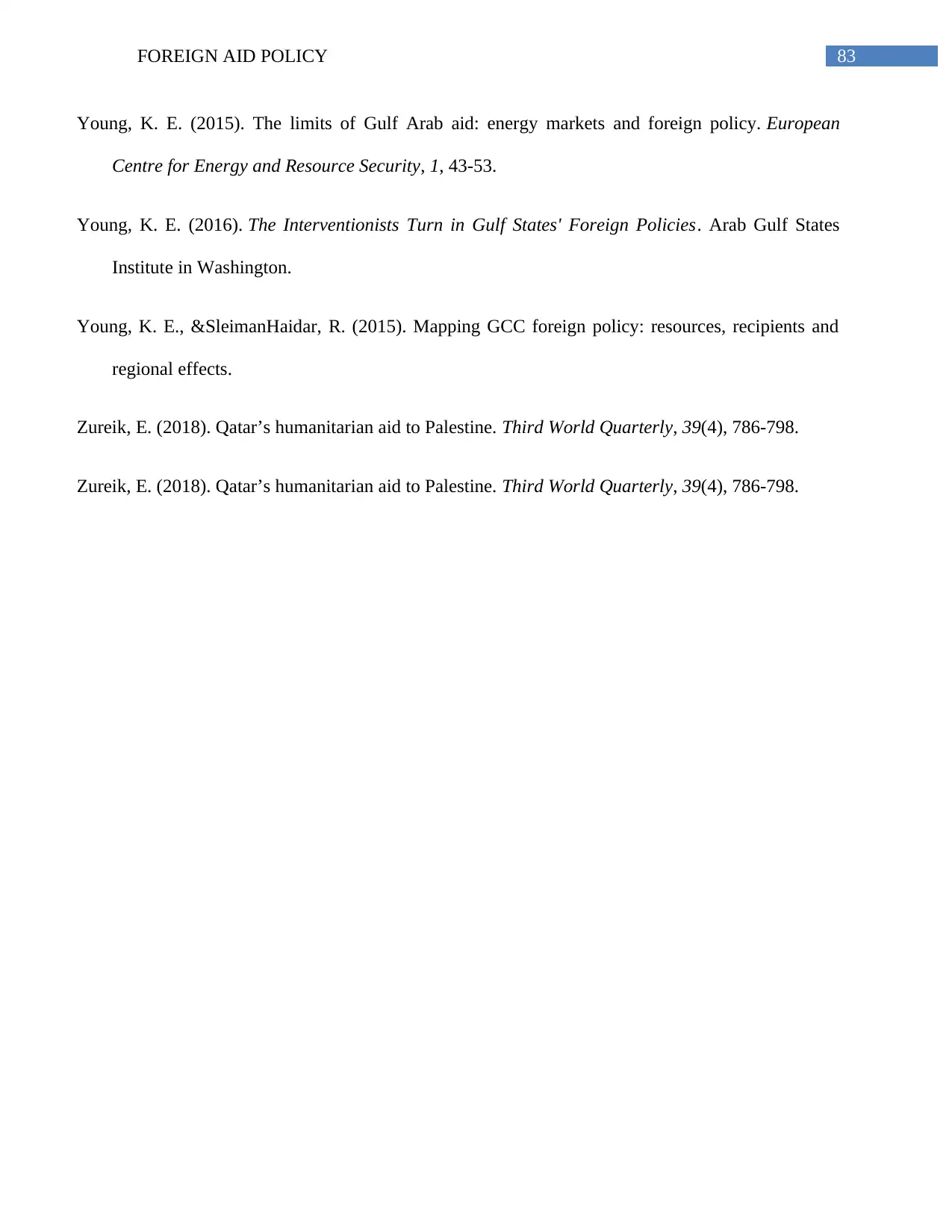
83FOREIGN AID POLICY
Young, K. E. (2015). The limits of Gulf Arab aid: energy markets and foreign policy. European
Centre for Energy and Resource Security, 1, 43-53.
Young, K. E. (2016). The Interventionists Turn in Gulf States' Foreign Policies. Arab Gulf States
Institute in Washington.
Young, K. E., &SleimanHaidar, R. (2015). Mapping GCC foreign policy: resources, recipients and
regional effects.
Zureik, E. (2018). Qatar’s humanitarian aid to Palestine. Third World Quarterly, 39(4), 786-798.
Zureik, E. (2018). Qatar’s humanitarian aid to Palestine. Third World Quarterly, 39(4), 786-798.
Young, K. E. (2015). The limits of Gulf Arab aid: energy markets and foreign policy. European
Centre for Energy and Resource Security, 1, 43-53.
Young, K. E. (2016). The Interventionists Turn in Gulf States' Foreign Policies. Arab Gulf States
Institute in Washington.
Young, K. E., &SleimanHaidar, R. (2015). Mapping GCC foreign policy: resources, recipients and
regional effects.
Zureik, E. (2018). Qatar’s humanitarian aid to Palestine. Third World Quarterly, 39(4), 786-798.
Zureik, E. (2018). Qatar’s humanitarian aid to Palestine. Third World Quarterly, 39(4), 786-798.
1 out of 84
Related Documents
Your All-in-One AI-Powered Toolkit for Academic Success.
+13062052269
info@desklib.com
Available 24*7 on WhatsApp / Email
![[object Object]](/_next/static/media/star-bottom.7253800d.svg)
Unlock your academic potential
© 2024 | Zucol Services PVT LTD | All rights reserved.





